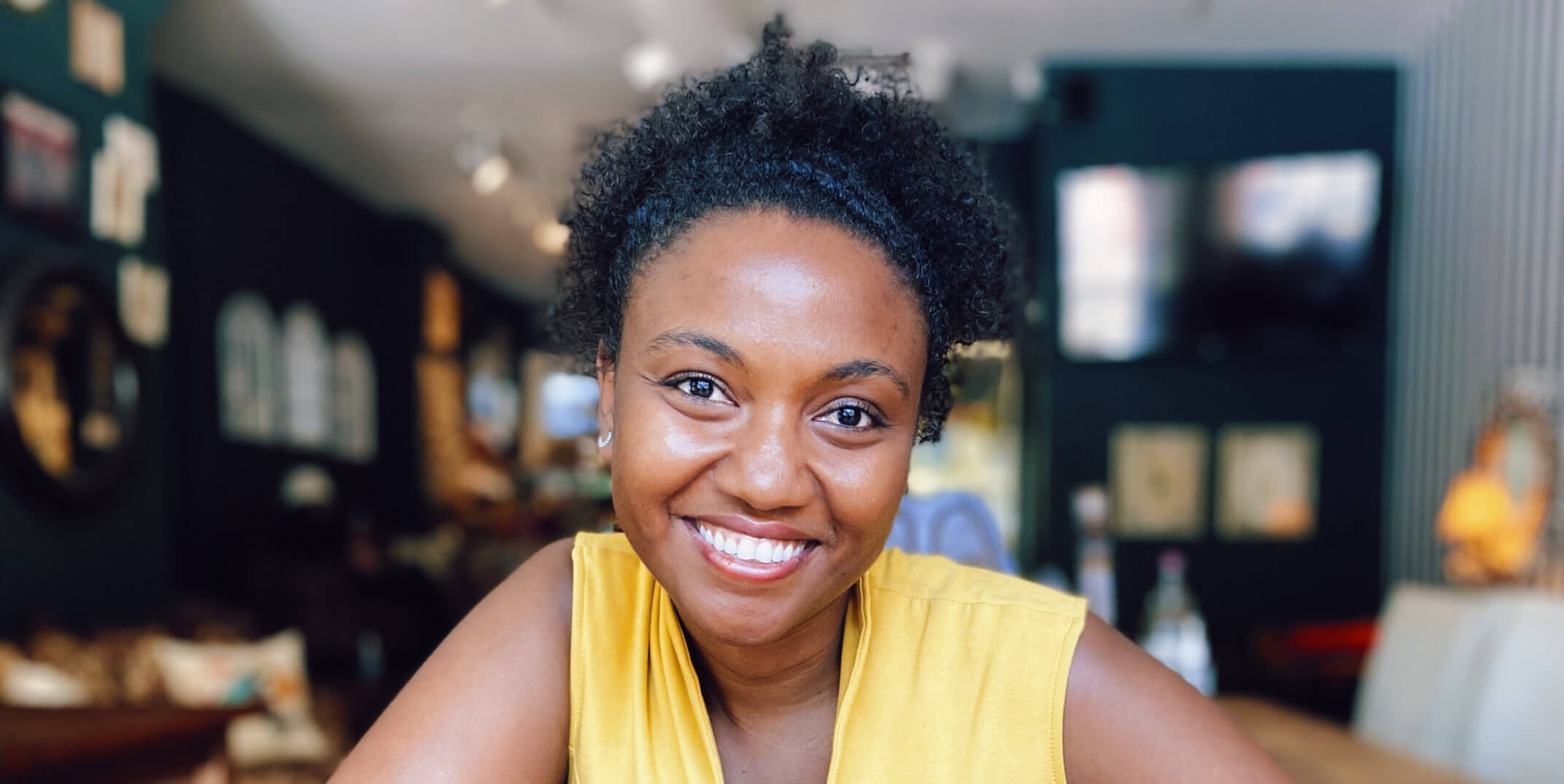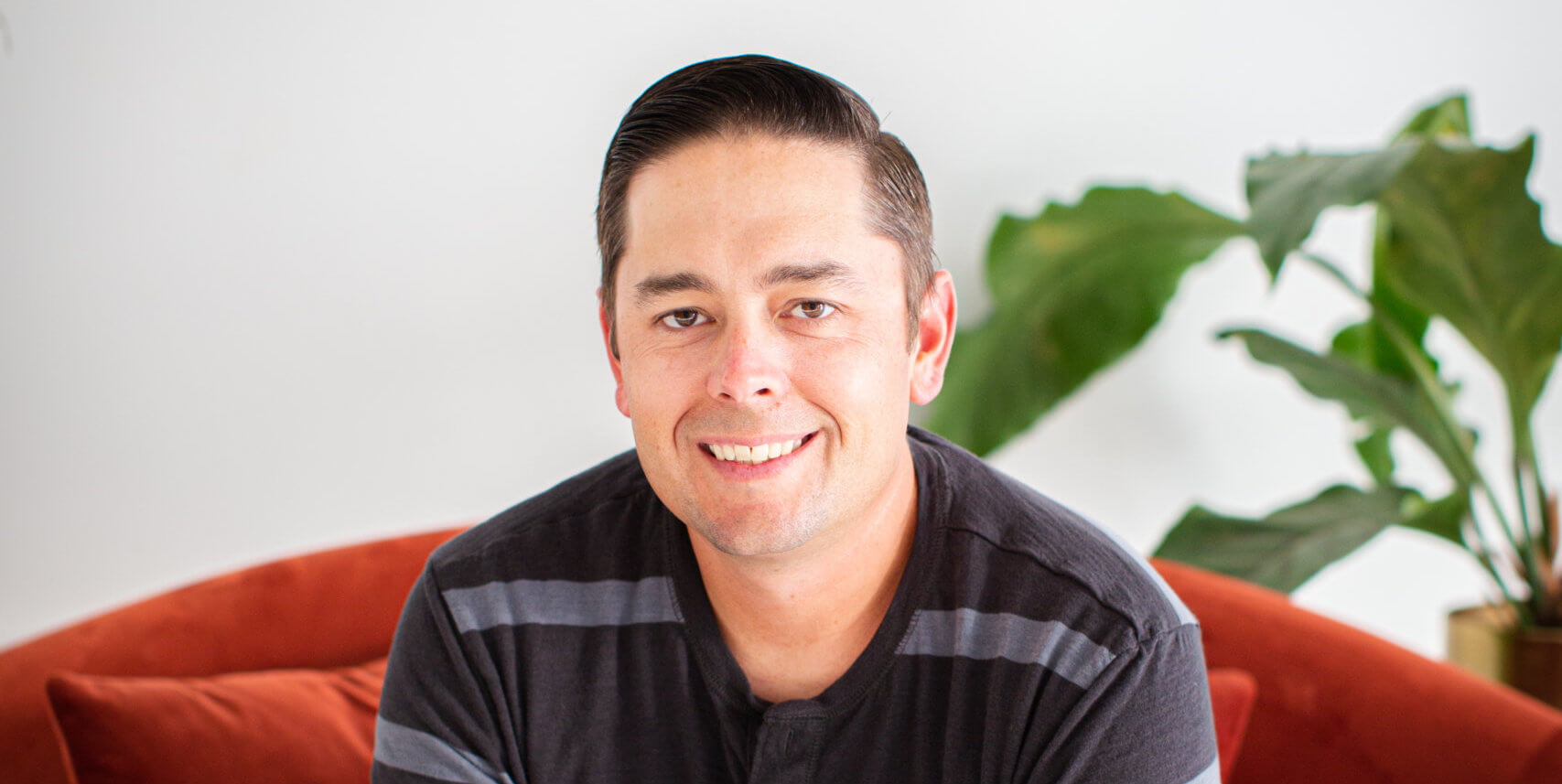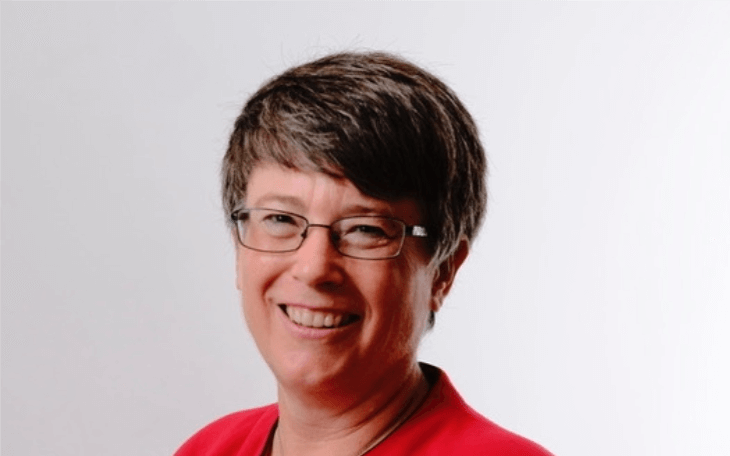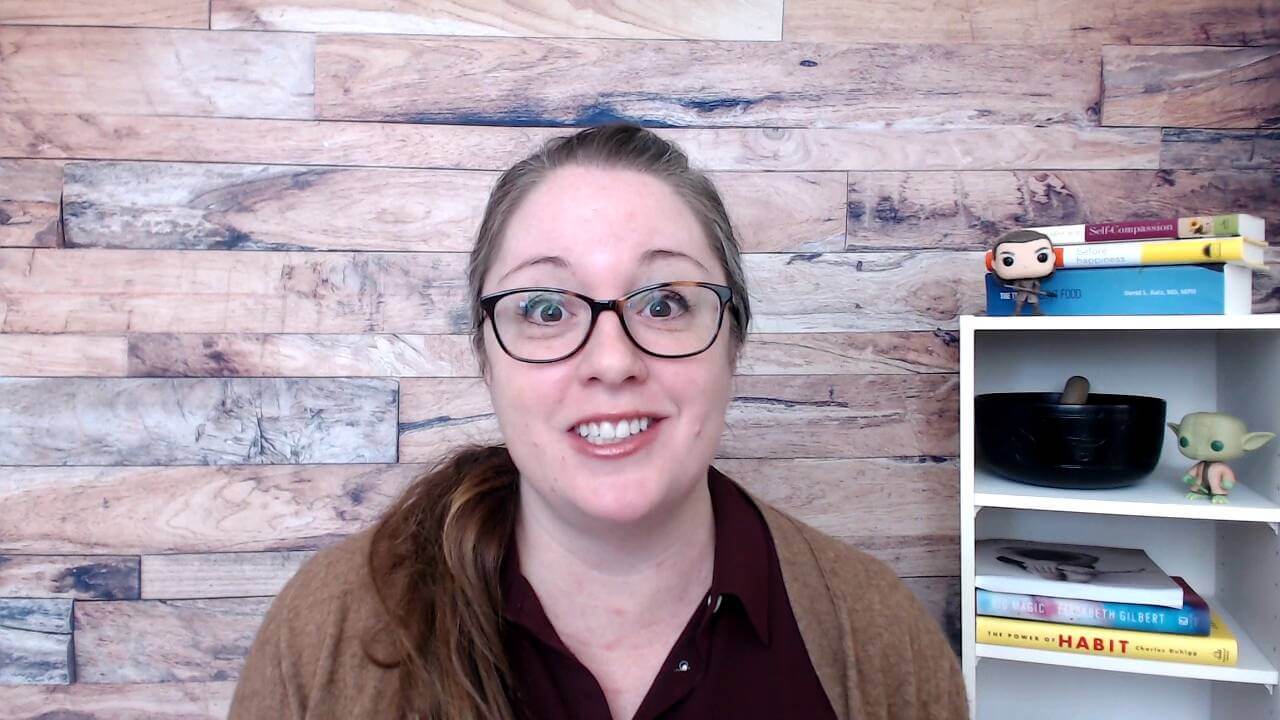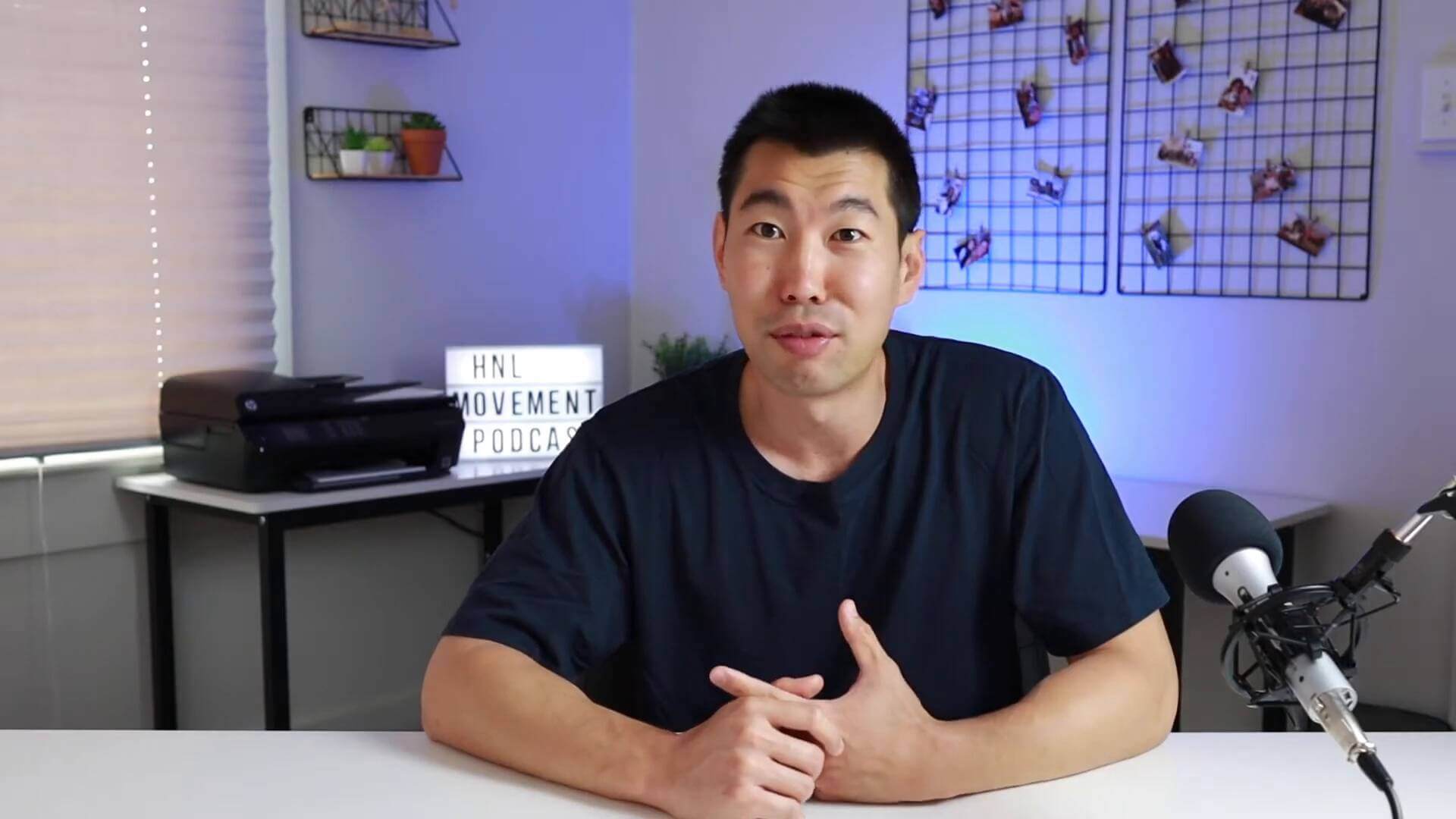Podcast Resource Pack Podcasting changed the trajectory of our business, which is why we're so passionate about helping you to start your own podcast. On this page, you'll find a […]
The post Podcast Resource Pack appeared first on Smart Passive Income.
]]>Podcast Resource Pack
Podcasting changed the trajectory of our business, which is why we're so passionate about helping you to start your own podcast. On this page, you'll find a collection of our best free podcasting resources.

Download your copy of the Podcast Cheat Sheet
Our checklist with every step you need to complete when you start your own podcast, from buying a microphone to your launch-day marketing. Download it now and refer to it as you set up your new show!
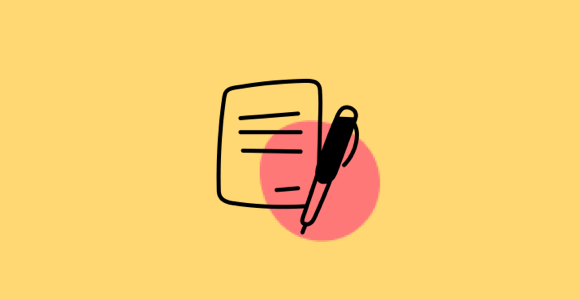
Podcast Cheat Sheet
Checklist; 8 pages
The ultimate checklist for launching your new podcast

Watch the replay of our podcasting webinar
In this replay of our most popular webinar, learn how to launch a successful podcast that boosts your brand and unlocks new opportunities. You'll learn:
- The essential equipment you need to sound like a pro.
- Strategies for conducting standout podcast interviews.
- How to choose the right podcast topic and avoid wasting time.
- The #1 element all episodes must begin with to avoid losing your listeners permanently.
- How to get your podcast noticed, especially on launch day.
- Insider secrets about the “podcasting algorithm” for effective show ranking.
Podcasting the Smart Way
Webinar replay; 1 hour
Our popular webinar on podcasting opportunities
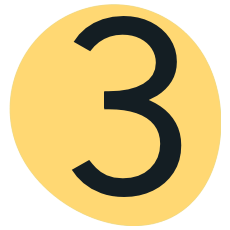
Choose the level of help you require
Do you thrive on the spirit of DIY? Or do you want some hand holding along the way?
If all you need are the instructions on how to get started, check out our complete (and free!) podcasting tutorial, How to Start a Podcast Step by Step. Using a mix of videos and written content, Pat Flynn walks you through the entire process of starting a podcast. It's one long epic guide designed to help you start your show as frugally as possible.
If you prefer the course format, where each step that you need to take is broken out into a bite-sized lesson, then our All-Access Pass community is for you. The All-Access Pass also takes you beyond setup, with course content on monetizing your show (beyond just ads), turning it into a video podcast, and amping it up once you've gotten into a publishing rhythm. This your ticket to all of our courses (including our start-your-podcast course, Power-Up Podcasting), as well as to weekly live events and asynchronous conversations where you can ask your questions and get support from the community.
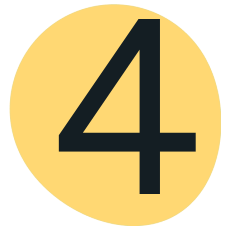
Order your gear
How do you know which microphone to buy? What else do you need to sound professional?
In this blog post, we take a deep dive into the audio gear you need to start a podcast and put together five different sets of recommendations based on your budget  and your goals, such as whether you plan to do your recording in person with a guest or cohost, take it on the go, or add in a video element.
and your goals, such as whether you plan to do your recording in person with a guest or cohost, take it on the go, or add in a video element.

5 Podcast Kits for Any Type of Podcaster
Blog post
Whether you’re a podcast audiophile, recording on the go, or filming your show for YouTube, these podcast kits are an excellent start.
Want to start your podcast faster?
The All-Access Pass has the courses, resources, support, and accountability you need to launch your podcast now.
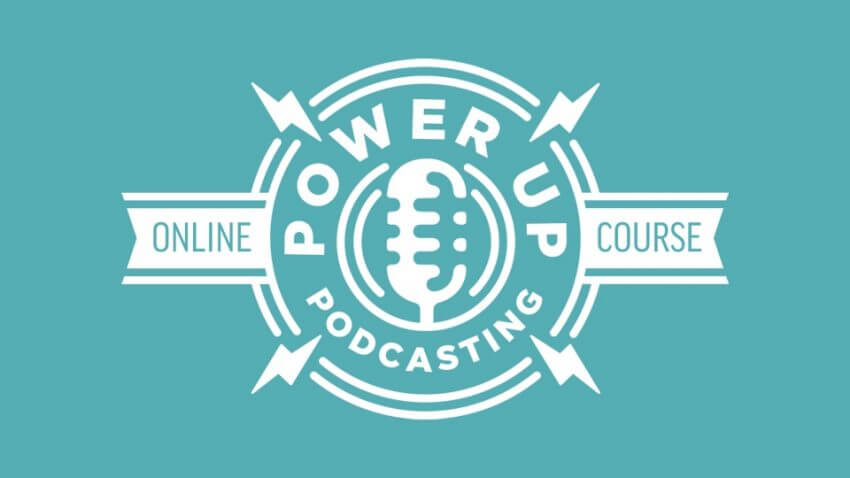
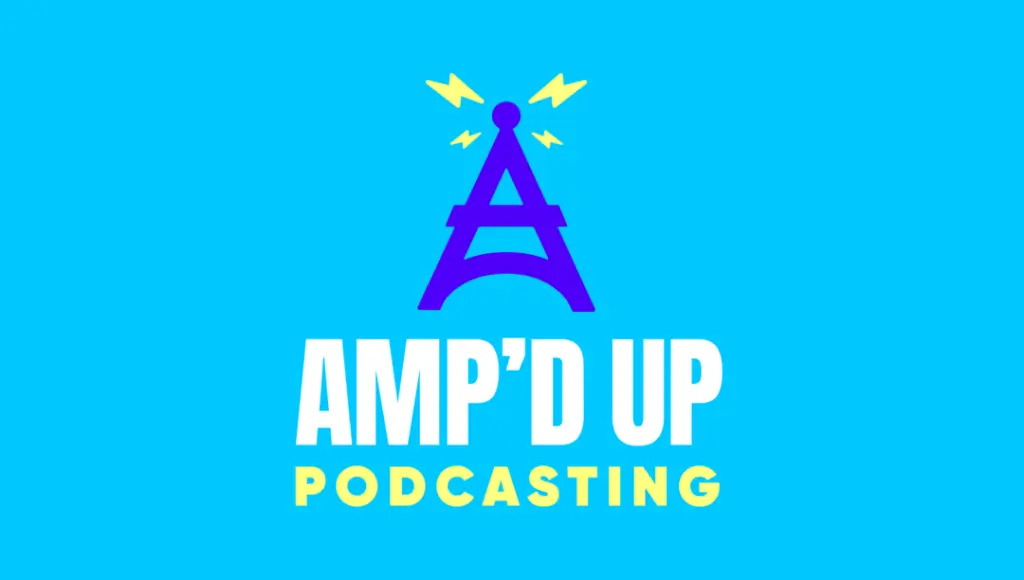
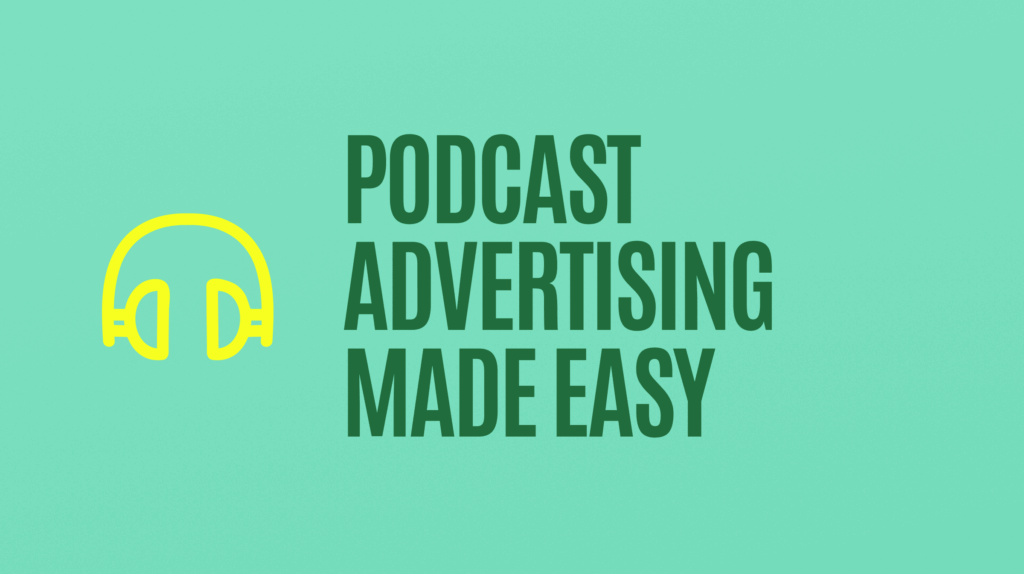
Our favorite podcasting equipment, tools, and services
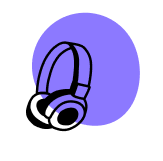
Podcasting Equipment
The gear lists referenced here come from this article on podcasting gear.
The Frugal Kit
This is an affiliate link
The Jetsetter Kit
This is an affiliate link
The Audiophile Kit
This is an affiliate link
The In-Person Kit
This is an affiliate link
The YouTuber Add-On Kit
This is an affiliate link

Podcasting Tools & Services
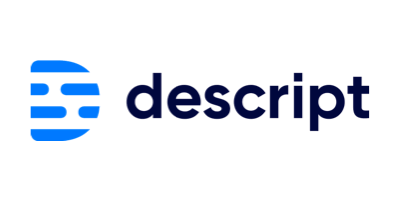
Descript
Descript offers simple and powerful collaborative tools to edit your audio and video just like a text document! Remove the tedious work that often stands between an idea and its expression and focus on developing your craft instead of getting side-tracked with platform fatigue.
This is an affiliate link
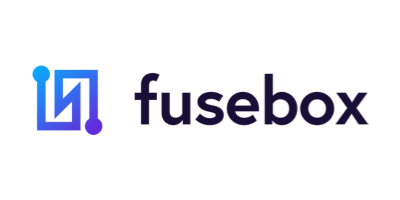
Fusebox
The official podcast player used by SPI! Fusebox provides your website visitors with a superior listening experience. From its powerful podcast hosting and analytics to the industry's most elegant and responsive web players, Fusebox is a must-have tool for starting a podcast. Get three months free when you join using our affiliate link.
This is an affiliate link

Podcast Hawk
Take the work out of getting booked and experience a smarter way to get exposure. Podcast Hawk is the smartest way to get booked, using time-saving and cost-effective software. Guest appearances on podcasts are a great way to promote your brand and grow your business, but you don't have to do it alone.
This is an affiliate link
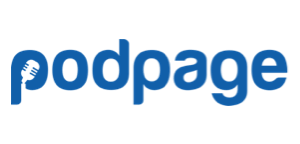
Podpage
The easiest way to create a turnkey website for your podcast, no coding knowledge required—and it automatically updates every time you publish a new episode. Upgrade to their Pro plan to add on even more features, like email address collection, voicemails, and importing reviews.
This is an affiliate link
More free podcasting content
-
What Is a Podcast? How Podcasts Work and How to Get Started
What is a podcast? Read on to learn what podcasts are used for, how to get started as a podcast listener or podcast creator, and more!
-
5 Podcast Kits for Any Type of Podcaster
Whether you're a podcast audiophile, recording on the go, or filming your show for YouTube, these podcast kits are an excellent start.
-
Top 10 Tips for Conducting an Exceptional Interview—UPDATED 2023!
Conducting a good interview is a great skill to have as an entrepreneur — for your website, for your blog, for your podcast, and so much more. Find out why!
-
Podcast Topics: 101 Ideas for Things to Talk About
Starting a podcast and looking for ideas and topics? You're in the right spot.
-
5 Steps to Protect Your Podcast
The recommended legal steps to protect your podcast and ultimately stay out of trouble by using trademarks, contracts, LLC's, and staying compliant with the FTC.
-
How to Record a Podcast While Traveling
Some of the best conversations you’ll ever have are while you’re on the road and in person with people. These are golden opportunities that don't have to be wasted if you are prepared.
-
How the Best Podcasters Do Their Work Faster
Best practices to help you create the highest quality podcasts in the least possible time.
-
How to Be a Guest on a Podcast
One of the best strategies to build your audience and business could be hiding in plain sight: podcast guesting.
-
3 Podcasting Mistakes You Need to Avoid
Let's talk about three of the biggest podcasting myths and mishaps you can encounter when you're starting your show, and how to avoid them.
-
The Keys to Podcasting Success in 2022
Is 2022 the year you’ll finally start your podcast? Or start taking your existing podcast more seriously? Here are some of the keys to creating and growing a successful podcast in 2022—plus an opportunity to turn your podcast dream into a reality!
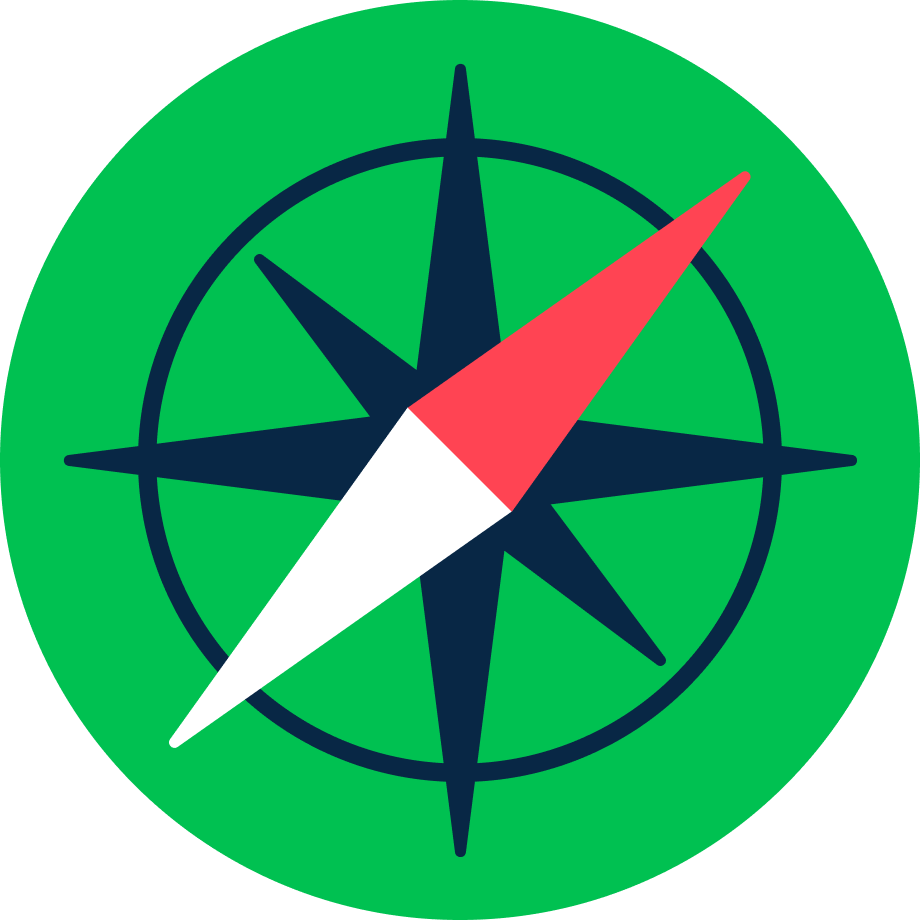
Vital skills, trailblazing resources, and a motivating community.
Your business growth starts now.
The post Podcast Resource Pack appeared first on Smart Passive Income.
]]>Master Workshop: Podcasting the Smart Way Join Pat Flynn for a live webinar and learn how to launch a successful podcast that boosts your brand and unlocks new opportunities. You […]
The post Master Workshop: Podcasting the Smart Way appeared first on Smart Passive Income.
]]>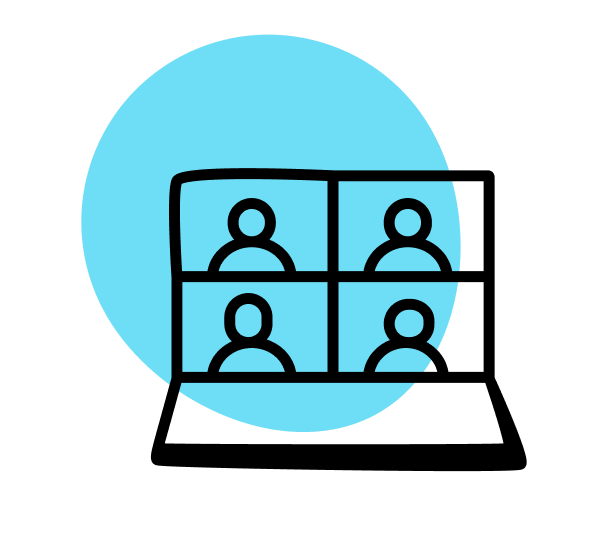
Master Workshop: Podcasting the Smart Way
August 22 @ 11:00 am – 12:00 pm PDT
Join Pat Flynn for a live webinar and learn how to launch a successful podcast that boosts your brand and unlocks new opportunities.
You can succeed in podcasting, and we're here to help — here's how!
Having a podcast is one of the most effective ways to build a highly devoted audience and grow your business — even if you’re starting from scratch! But where do you begin?
There's a lot that goes into creating a podcast: selecting a topic, setting up the right equipment, interviewing guests, reaching the right audience, editing, and monetizing. It can often feel overwhelming and discouraging. But taking a step back to break up the overwhelm into manageable steps will set you up for success.
Pat Flynn — creator of Power-Up Podcasting® 3.0 and host of The Smart Passive Income Podcast— has taught tens of thousands the right approach to creating a podcast. Join Pat in this live one-hour training session where he’ll explain why now is the perfect time to start a podcast and guide you through the steps to get started.
Pat will also share insights about SPI’s course, Power-Up Podcasting® 3.0 — a comprehensive guide and the perfect next step toward creating a flourishing podcast. Students will be guided through the curriculum in our special course accelerator starting on Thursday, August 29th, within the All-Access Pass community!
During this live training, you'll discover:
Don’t miss this chance to revolutionize your podcasting potential!
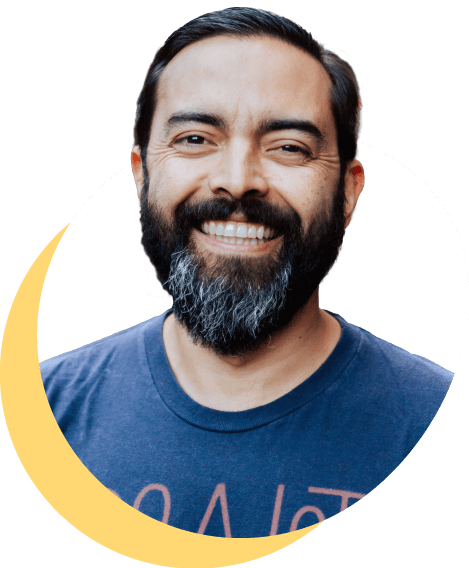
About Pat Flynn
Pat Flynn is an author, speaker, serial entrepreneur, creator of SPI, and co-founder of SPI Media. He is here to serve, inspire, and support entrepreneurs with their business goals.
In addition to co-founding SPI Media, Pat is part of the SPI Experts In Residence program, bringing his extensive knowledge of podcasting, YouTube, marketing, and live events to the members of the SPI Pro and All-Access Pass communities.
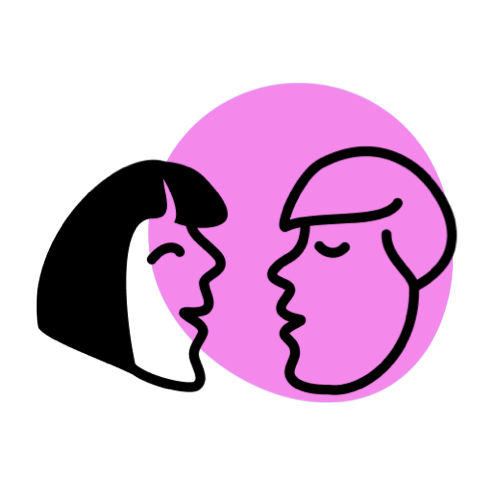
Who can attend
This event is free and open to the public! You will be a good fit for this training if you are interested in starting a podcast or if you have an existing podcast.
The post Master Workshop: Podcasting the Smart Way appeared first on Smart Passive Income.
]]>Selling your business can be a once-in-a-lifetime moment that creates generational wealth for you and your family. But how do you build a brand that attracts potential buyers? Also, if […]
The post SPI 789: The World of High-Value Business Exits with Nick Bradley appeared first on Smart Passive Income.
]]>Selling your business can be a once-in-a-lifetime moment that creates generational wealth for you and your family. But how do you build a brand that attracts potential buyers? Also, if you're inexperienced, how do you avoid being taken advantage of and leaving money on the table?
To help us level the playing field, I'm interviewing Nick Bradley from High-Value Exit and the Scale Up With Nick Bradley podcast. Nick has spent a decade in private equity and has been involved in over one hundred acquisitions. His expertise helps people build their businesses to sell and avoid falling easy prey to sophisticated buyers.
So, what are the fifteen areas to focus on to increase your chances of creating a big exit? What about the minimum requirements your business should meet before you consider selling? Also, how are you going to handle receiving a life-changing payout?
We explore all of these questions in today's session while getting a fascinating look at how money and power affect us. Listen in, and download Nick's free Exit for Millions blueprint for more!
Today's Guest
Nick Bradley
Nick Bradley is a world-renowned author, speaker, and business growth expert who works with entrepreneurs, business leaders, and investors to build, scale, and sell high-value companies.
Over the last decade, he has built, bought, and sold 26 businesses with a combined valuation of 5.2 billion dollars. He also works with private equity and venture capital firms across the UK and the US, leading turnarounds, mergers, acquisitions, and scale-ups.
His Scale Up With Nick Bradley podcast, which ranked #1 in the UK on iTunes’ Business charts, has more than 1 million downloads in over 130 countries and has featured thought leaders such as Seth Godin, Amy Porterfield, Evan Carmichael, Neil Patel, Jay Abraham, Patrick Bet-David, and more.
- Find out more at HighValueExit.com
- Get Nick's free Exit for Millions blueprint
- Connect with Nick on LinkedIn
You'll Learn
- How dealing with money and power can change people
- Tips for building a business with the intent of selling
- Negotiating an acquisition without leaving money on the table
- Minimum requirements before you should consider selling
- Three areas that can prepare your business for a big sale
- Creating your exit story and the next steps after selling
- Why some businesses are prizes and others are prey
- The fifteen items sophisticated buyers look for in a business
Resources
- Subscribe to Unstuck — my weekly newsletter on what's working in business right now, delivered free, straight to your inbox
- Connect with Pat on Twitter and Instagram
SPI 789: The World of High-Value Business Exits with Nick Bradley
Nick Bradley: When you go into a sales process, the thing to understand, is that you're dealing with people who do this every single day. Most people will never even do an exit, but you've got people doing it all the time, they're pros. And what we often say is, in private equity terms, if someone doesn't know what they're doing when we acquire them and we can manipulate the situation to our benefit, we call them the prey. I often articulate it like going into the gladiator's arena. There's a person there that's done the reps for years, and you're turning up there doing it once. Not a smart move.
Pat Flynn: Selling your business can be an incredible moment, a once in a lifetime moment, a moment that can help generate generational wealth for you and your family. But when you look a little bit deeper into this world, there's a lot of layers to how this all happens, the world of mergers and acquisitions the world of exits. And today we have Nick Bradley who is an expert who has had his hand in over five billion dollars worth of exits with 26 different companies He has effectively helped over a hundred different mergers and acquisitions across his clients and today we're going to talk about this world and what it's like because I mean, it's ruthless.
And we use those words. He uses words like prey, because private equity groups sometimes consider their potential sellers as prey. But how do we position ourselves if we were to sell our business as not the prey, but rather the prize? And how do we position ourselves so we're not being taken advantage of? How do we set up our businesses for success, for an exit?
And we talk about all of those things and more and the things to look out for the 15 things that we talk about at the end that if you have in your business would make it very difficult to sell. So make sure you stick around for that and more. And I got to thank my coach, James Schramko for introducing me to Nick.
Cause Nick is just a wealth of knowledge in this world. And it's again, some you'll hear in my questions, just, I have no idea what's going on. So I just dig deeper and I ask more Nick delivers for sure. So enjoy this episode with Nick Bradley from High Value, Exit or his podcast Scale Up.
Announcer: You're listening to the Smart Passive Income Podcast, a proud member of the Entrepreneur Podcast Network, a show that's all about working hard now, so you can sit back and reap the benefits later. And now your host, after coming home from Japan for the first time, he was quick to install a bidet in his bathroom. Pat Flynn.
Pat Flynn: Nick, welcome to the SPI podcast. Thanks for being here.
Nick Bradley: Hey, it is great to be here, Pat. Thank you very much for having me.
Pat Flynn: We are talking about selling companies exits, something that you are very familiar with. I see here that you have sold 26 plus companies for over 5 billion. That's with a B. It's a B. That's, that's crazy. Is that all companies that you have owned or you've helped through this process?
Nick Bradley: I would love to say that I've owned all of those companies and you know, I'm sitting here about to buy a sporting team. I'd love to say that. The truth of the matter is I sold my first company when I was 21 years of age for 3000 Australian dollars. So that was my first exit, the last business that I was involved in selling sold for 2.3 billion in 2018. So I always, I like to say I redeemed myself through the years, but to answer your question, some of those are my companies. Some of those are businesses that I've been brought into by investors to turn around. Others are bigger companies where I was on the senior leadership team, simply participating in the preparation and the exit.
And then some of them are people that I've worked with more recently as clients, helping them achieve a high value exit in their company.
Pat Flynn: What's the most exciting part of exits to you? I mean, you've built your whole brand around this. You have a book coming out in the future, you have programs and such.
I mean, highvalueexit.com, definitely check it out, everybody. But why the focus on this? What excites you about this kind of work?
Nick Bradley: I, I got kind of exposed to it sort of through my career, right? So I'll give you the short version of it. I was involved in kind of the corporate world for a long time and the obsession there was really growth, right?
Scales are more, scales are like a sexy word for growth that's predictable, right? But back then it was growth. You know, I'm a, I'm not a young guy. I may look young, but I'm almost 50 and I was involved in, in lots of growth. And then. I was involved in M&A sort of at the middle point of my corporate career.
And I didn't quite understand what that was about. I didn't understand that you could, you know, scale a business quickly by buying another business and bolting the whole thing together. And where it really came to sort of hit, if you like, it was a big exercise involved in in 2008, just before the market crash.
And it was the breakup of a big media company, a company called EMAP, East Midlands Allied Press in the UK, which was the second biggest consumer publishing group in the UK at the time. And it was one of those kind of corporate raider takeover things. where someone came in, broke the company up and it got sold to various components.
And I just kind of, I was involved in the whole process, but I watched what happened. And I saw two things. Firstly, I saw how ruthless the world can be when there's a lot of money at stake. But then I was also a bit younger and I was quite intoxicated by that thought as well. Not so much the money, but just the, the level of, of kind of activity that happens when you get to that outcome.
And that took me into the world of private equity for over a decade where I was involved in multiple acquisitions, effectively over a hundred. And that's when all the exits happened. And I just couldn't believe that you could create an asset, right, a business, and then sell it for millions, billions of dollars, and the whole thing was just crazy.
And then I realized the growing a business is great, you know, being an entrepreneur is great, but you have this ability to not only change your life, but change other people's lives by creating these big liquidity events. And I just became obsessed with that world, being really honest on this show, like self serving me to some extent for a number of years.
But then after a while, I realized that there was a bigger, bigger piece to this, which is kind of what I'm more focused on now, but it's still, it's still in this lane of how do you, how do you create this event?
Pat Flynn: And we're going to talk about that, what we can do to set up our businesses for a potential exit and maybe even a little bit about if you were to buy a company, what would you want to look out for?
And we're going to talk a lot about like the maybe not so great parts of this world. And you had mentioned ruthless earlier in some of these bigger deals. Like what does that mean? What is, what does ruthless mean in the world of mergers and acquisitions?
Nick Bradley: When we talk a little bit more about private equity specifically, you'll see exactly what I mean.
But it comes down to this. When there are such large sums of money, sitting on the table, you know, and, and to some extent it aligns with power as well, right? Wealth and power can be very addictive things. And if you put both of them together at the same time, it can conjure up all sorts of characters and it can change people.
And what I've seen is when there's a large check sitting on one side of the table that someone can take they may come across as the most integral person, like, you know, having the best ethics and character and values. But when there's a big check, hundreds of millions sitting on that side of the table, you start to see different behaviors, right?
And maybe it's being a little bit primitive, right? And going back to sort of caveman times, if you like. But people will literally kill people, right? Sometimes for that check. Or certainly do things which are crazily unethical, however you define that. And I saw all of it. I saw some pretty horrific things happen when there's a big check there.
Pat Flynn: Well, let's hope none of us get into that sort of situation. So maybe we could begin talking about our own businesses and what even would make our business a viable business to sell. Like, what is a company looking for or a private equity group looking for when it comes to the businesses that we're creating big or small?
Nick Bradley: I should contextualize this by saying I focus now on helping entrepreneurs create eight to nine figure exits to what I call sophisticated buyers. And the most sophisticated buyer is a private equity firm. And what you've got to understand first is. Anyone who's going to pay eight or nine figures or more for your company is buying an asset, basically a transferable asset that they can then grow into the future and get a return on.
So this is not you buying your mate's business down the road for a packet of chips or whatever it is. This is, this is seriously high stakes stuff. There are a number of things that are important there, right? And this is where a lot of business owners who have smaller businesses or businesses that are scaling, they don't appreciate the fact that they have to build the business a certain way.
You know, I call it being built to sell. Even if they have no immediate intentions of selling it, they have the option to have that event at any point in time. And what does that look like? Well, firstly, if you're the founder of a company and you know, most of the key operational activities rely on you, right?
You know, you're out there doing marketing, you're out there doing sales, you're doing delivery, you know, you're making the product. If that exists, even if you're like an eight figure company, if you're still the cog in the wheel, that business is very hard to sell. It could still be sold, but it's going to be a lower multiple valuation than if that business is a well oiled machine where it's not reliant on you or any one person to operate.
Right, that's what I mean, a transferable asset. The other thing that we do certainly from a private equity standpoint is we like to mitigate risk as much as possible. So if you take the concept of recurring revenue, subscriptions, long term contracts, things like that, if I'm going to buy a company that, you know, has to go out there and hunt for what it eats every single day, because it has to go out there and grow by one customer at a time.
That's risky, right? It's risky because I don't know where my next meal was going to come from, so to speak, right? But if I have a business that's, you know, repeatedly, predictably and sustainably driving revenue and growing that revenue every single month, I can then model that out for the next period of time, three years, five years, 10 years.
You know, I'm going to hold a business for about five years in private equity and try and sell it again. And I can see where I can pay more for that company because I have a very clear line of sight of how that's going to grow. And there's about 15 or so characteristics like that, that when I was in private equity doing acquisitions and things that I would be assessing when I'm literally sitting across the table from a founder asking them about their business.
And I'll talk more about that at the end, because I definitely have some resources that I can give to your listeners to let them understand this a bit more, but it's quite, it gets quite technical and complex, but you've got to think of it from the idea that the business has to exist without you. And it has to have a lot of characteristics which make it extremely valuable for that transaction to happen.
Pat Flynn: Is there a scenario where a solopreneur is able to sell their business and maybe they because they are still the center of the cog and then, you know, they're kind of necessary to still run the business, but they can still sell the business and kind of then work for the company that that buys them.
Is that a scenario?
Nick Bradley: Yeah, it happens. It happens a lot. But remember, if I put my private equity hat on, right, you know, when I was in that environment, I'm going to try and mitigate the risk of, you know, I've just given you a check of tens of millions, if not hundreds of millions of dollars. Right. Your life has just changed.
And I often say that, you know, selling your company is usually a once in a lifetime event, and it's probably the biggest financial transaction you'll ever experience unless you do it again. Right. But the point of that is that I'm going to get you there sticking around maybe for a couple of years. And I'm going to make sure that you're locked in to stick around to some handler transition, but I'm not expecting you to necessarily be that engaged.
At that point, the only time that changes Pat is if you have the ambition to sell your company again. And so sometimes there's a thing here where you can roll over equity. So let's say I buy your company. It's worth a hundred million dollars. You walk away with say 60 or 70 million once the transactions happen, but you've got that extra 30 million or so that's still owed to you.
You may decide to roll that investment into the new entity because remember, a private equity firm is going to grow and scale and want to exit again. We can get into what that looks like. In some cases, you could sell your company again through those shares and actually make more money than what you did on the initial sale.
So in that situation, you're incentivized because you're partnering with the sophisticated buyer for that outcome. That makes sense. It's very clever stuff when you get into it. And when people start to understand this, they can then start to make decisions about what sort of exit or what sort of transition works for them
Pat Flynn: On these deals that are done, how does the conversation even begin? Are you as an entrepreneur who has a business perhaps that is set up for sell it is built to sell It does have recurring revenue. For example, are you shopping around? Are there agencies are there? Is there like a shark tank situation?
Nick Bradley: Oh, it's it's it's full on. It's full on. One of the one of the businesses I'm working with at the moment that's very well, well, it's a great business and it's becoming a better business because of some of the stuff we're doing with it. We had 15 approaches last week from private equity firms literally cold calling outreach.
Pat Flynn: Cold calling. Wow.
Nick Bradley: Yeah, and what I often say there's there's two things I like to tell business owners is If that's happening to you, obviously you've created something that people are interested in, particularly that level, right? Private equity firms are always out there looking for deals because it's a competitive market.
There's something like 6,000 at last count private equity firms in North America. There's a lot of big ones. There's kind of league tables within that. Again, we can get into it. You're not going to sell your business on one of those outreach calls. That's the worst way you can do it. The other thing that lots of business owners do, which I advise against is they, they decide one day they want to sell for whatever reason and they go and hire a broker or an investment banker. And nothing wrong with, with those, those entities and particularly investment bankers can add a lot of value. But if you haven't prepared your business in advance to give yourself a high degree of certainty that you're going to get the number that you want, more often than not, those business owners are leaving money on the table.
And sometimes they're going into a situation with sophisticated buyers. They just don't know how to play the game. So if we want to go through how it works quickly, cause I think it's important to, so people understand this. I'll start with the tiers, right? And, and the levels where the game is played, and this is a really important thing for people to get.
So if you want to sell your business and let's say you're doing. seven figures of revenue. Now, not many businesses even get to that level. So congratulations to even get to that level, but your profit is probably going to be, if you're lucky, 1 million, 2 million, that sort of level. And that's, that's a great business.
You can get good income from that, all those things. The problem is it's too low, too small for most of the private equity firms to be interested in. The thinking behind that is it takes just as much effort to do a small deal as it does do a bigger one. So you have to have a certain amount of scale. And I say that the minimum threshold that you should be looking at is about four to 5 million of EBITDA net profit, because that opens up the world of what we call the lower mid market and the mid market private equity firms.
And that's where, if you think of a bell curve, the top of the bell curve is in the mid market. There's more private equity firms, but there's also a lot more capital. At last count, there's 2 trillion in North America sitting in the mid market of private equity undeployed. 2 trillion. We played around with a billion before and now we're getting into trillions.
Pat Flynn: Yeah. This is, this is unknown to me.
Nick Bradley: It's going to, well, it blows my mind too, but here's the thing. If you get to four to five million of EBITDA and you're in a, in a certain market, let's say it's an education market, right? In an education market, businesses there sell for anywhere from five times to 12 times EBITDA.
Okay. And we can talk about the difference of why a business would sell for five and 12 a bit later, but just think about this. Let's for round numbers sake, say you've got 5 million EBITDA and you sell at the bottom of that range in that market, you've got an enterprise value of 25 million you've created.
If the business is built a bit better and structured a bit better, let's say you get a 10 X or 10 times that EBITDA, you've got 50 million now that's life changing money for people. So what I say is, you know, if you've got a business that's doing 1 or 2 million of EBITDA, if you can grow it, you know, really intentionally scale it to getting into what I call those swim lanes of the mid market private equity, you've now created the option of a very significant capital event.
Pat Flynn: EBITDA being earnings before interest tax and amortization. I think.
Nick Bradley: Yeah. And it's, I always get it confused. It's debt. Exactly that. But it's the way to think of it is it's, it's your net profit, right? So it's the way that we calculate the net profit of the business.
Exactly. Right.
Pat Flynn: Get to five-ish, because that'll put you into this part of the private equity arena that, you know, the numbers really start to multiply and start to exponentially grow at that point. If you are in the one to two, better off trying to scale that to that point versus just selling at one or two.
Nick Bradley: Well, I'll give you the statistics on it, right? The broad statistics are that if you are in the seven figure revenue range or in that EBITDA range, which is lower than where the mid market opens up, you have like a two in 10 chance of selling your company successfully. And certainly to a number that you would be satisfied selling it for, right?
So therefore most founders say, well, I'm just going to keep the business and then they can't sell it. So they have to close it down or do something else later on. And that happens all the time. If you want to get to that point of significant, you know, potentially even generational wealth kind of creation, my advice is do some things to grow it a bit bigger and there's lots of clever things you can do, like you can buy other companies, you can do your own M&A to create, you know, these kind of groups and structures, but you're sitting on a very big windfall and the statistics, just to give you that it's something like 70 to 80 percent of businesses that get into that, that swim lane I mentioned before. So, so that's the difference between the delta.
Pat Flynn: Mm. That's huge.
Nick Bradley: Crazy, isn't it?
Pat Flynn: Yeah. But that's, that's good perspective though. And you're right. I mean, that's life changing money at that point. And I'm curious, like in what little I know about this world, I often hear about how important the story is, the story of your company.
Does that play a role in the selling and the multiples that, that occur in this? world? Incredibly so. It does.
Nick Bradley: And it's, it's a great question there. I look at when I left private equity sort of six years ago, I took away from that, what I call a playbook. And I thought about this and I thought, you know, what are the, what did we do?
So when we used to buy these companies, right, and the whole game of private equity is to buy low to sell high. And we want to take the company off you in very clever ways for the lowest price we can, but still keep you involved for long enough for us to not need you anymore. Part of the example of ruthlessness.
Yeah. Right. And after we get the company, we want to do certain things to it. But here's the three pillars that I took away from that experience of private equity. The first thing we always did was, was strengthen the foundations of the asset we acquired. And the way I kind of articulate that to people is most businesses, even if they're at sort of, you know, seven, eight figures, there's still, you know, what we would call good businesses.
They have what I call organized chaos going on. So it's not things happen and things, you know, create good results, but it's not usually very precise. And what we used to say in private equity is we need to go from this organized chaos to a well oiled machine. Right. And the way that we did that, the way we strengthen the foundations, three main things, Right people, right seats, right?
Really intentional organizational design. But not just the leadership. We would look at the key people in the business, driving the strategy, right? As I go through this, if any business owners are listening, you can do this now. Right? So the stuff I'm talking about now can actually apply this to your business.
It's, it's useful stuff. Second thing is systems automation, you know, making sure that everything is documented in processes and where we can take efficiencies out using technology, we do that. And then the third thing is data driven decision making. Now, what's interesting about all three of those when you put them together, and I, I impressed this off when I work with founders, I say.
If you're stuck in your business right now, and your ultimate goal is to create a bit more freedom from your business. If you go deep into those three areas, what you're really doing is creating your first exit. You're removing yourself from the important running of the company, the day to day operations.
And you know what? Sometimes people, when they work with us, they actually do that. And that's enough for that point in time. That's when we talk about creating the option because we're, we're reducing reliance on any one person. So that's the first piece, right? That strengthen foundations. The second part is around scale, but not just scale. We call it profitable scale. Most businesses, when we acquire them have inconsistent growth patterns. So they might be focusing too much on organic growth. They're too much, too much reliant on paid media for their marketing. For example, many of them don't have any recurring revenue in there. And I mentioned before how much of a risk that is.
Most businesses don't know how to scale properly through joint ventures, partnerships, and acquisitions. And most are very inefficient with how they manage margin. Give you an example of that. They won't know things like customer profitability or product profitability. They're not getting granular enough.
So the second thing we do is we start to change those areas and affect those areas. So we're driving as much profit as we grow as possible. And making the business like super efficient. Okay, the third part, and I'll just go through this is what we call the actual sales process, which comes to your exit story piece.
Every time a private equity firm buys a company, they already are reverse engineering the exit from day one. And sometimes they'll buy a company knowing that it's going to be disruptive enough in a market that it's going to get bought by a big public company or whatever else. And they, they do it for that reason.
But when you go into a sales sort of process, the thing to understand, and this is super important I think for people as well, is that you're dealing with people who do this every single day, like I've said I've done 100 acquisitions, 117 actually, most people will never even do an exit in their life, let alone do one, but you've got people doing it all the time, they're pros, right, there's a very clear game around that, and what we often say is, in private equity terms, if someone doesn't know what they're doing when we acquire them, right, and we can manipulate the situation to our benefit, we call them the prey.
Pat Flynn: The prey.
Nick Bradley: I'll get into this in a bit more detail.
Pat Flynn: So that makes you the predator.
Nick Bradley: It's, it's a game. It's, I often articulate it like going into the gladiator's arena. There's a person there that's done the reps for years, and you're turning up there doing it once. Not a smart move.
Right, you need to learn how to play the game, but there are times when, in my experience in private equity, where we would have businesses that would turn up, we'd find them, they were beautifully prepared, incredibly well positioned. The founder had educated themselves on the world of M&A. They had a compelling exit story and an exit story to come back to your question is, I have a growth plan for this company that is super exciting, super clear.
I'm not just selling my company to you. I'm bringing you in as a partner to take the vision that I've created to its next step. Now, as a private equity guy, I look at that and go, wow, this is great. I don't have to go and recreate the strategy. All I need to do is implement it. And in a situation like that, Pat, we would say that's a prize business.
So some businesses are a prey, a business like that is a prize. Equally as compelling for us. We're going to pay a lot more money for it, higher multiple, but we need to do less work. Both are good. I want to get across here that as an ex private equity guy, you know, I'd buy the prey business as much as I'd buy the prize business, but I'm just going to pay a lot less money for that prey business.
And if you're listening to this, you want to maximize your output your return by flexing that multiple in that way.
Pat Flynn: Be the prize,
Nick Bradley: Be the prize, and you can do it with enough runway and enough education, knowledge of how to do that.
Pat Flynn: About how long would it take a business that is set up to do something well in terms of an exit, perhaps, and become that prize?
What's the runway look like? What's the timeline look like to get things prepared, to get that story ready, to then get to the point of exit, or at least a pitch?
Nick Bradley: The maximum, I often say, it depends on the number you're going for, to some extent. Like, I often believe, well, I believe two things. Any business can be built to sell, right?
As long as you've got the runway to do it. And any number can be achieved if you've got enough, again, runway capital around it. And then there's plenty of examples of that. I often say it's between six and 36 months. Now, I'm working with a business right now that I recently started helping and I came and sort of kicked the tires on that business.
It's ready to go. It's ready to go. The number is clear that the founder wants to hit. The foundations are strong enough. It's got a very, very clear, profitable scale strategy. Ready to go. Other businesses, they've got more work to do. So that's where the 36 months comes in. But it doesn't take as long as you think it takes when you start to understand the different levers that you have to pull.
And a lot of those levers business owners don't know about, or they're not understanding enough about it to be able to execute like that.
Pat Flynn: To go back to my question earlier about story, in my mind, when I was asking that question, I was asking about the story of the brand, the sort of brand reputation, and sort of, here's how I got started, and here's where it's going, but that maybe plays a little bit of a role, and you can tell me yes or no.
Nick Bradley: But I think you're on the mark here, Pat.
I think you're on the mark. I mean, you're When I say exit story, we would never use that term when we're going through a process to sell a company or get positioned. What we're talking about is all of the things that make the business what it is. So brands, culture, those things come into it. The way to think about this is, and as I said, I'll, I'll, I'll share later on kind of the 15 different things and give that to your listeners.
But, you know, within that a unique and remarkable brand that is top three within its defined market is a hugely attractive thing. A defined culture where the behaviors are clear, not just the values and it's driving performance. And you can prove that hugely valuable thing. Referenceability of clients.
So some businesses work with blue chip clients as their businesses or customers. Hugely valuable thing because they're hard to get. All of that builds. So there's two parts of the exit story to use that term. It's everything that you've created that is a win theme that got you to where you are today to that point.
But it's everything that the business can continue to do because you've got it to that point in the future. Because the key thing is this, when someone puts a big multiple in front of you, remember they're paying somewhere between 10, 15, the highest multiple I've ever been involved in was a 36 times EBITDA.
That's 36 years of profit paid in one day. So for someone to be comfortable with that level, they have to see that compelling future and some certainty around that. And that all comes down to how you pitch it, how you prepare and how you position.
Pat Flynn: Yeah. And that sounds like why, if you already have a plan in place to scale that to go along with the pitch and it's like, Hey, this is how we can get to this next level.
We just want to bring you on as a partner. We need some resources. We need some connections, which you have let's get here together. Exactly.
Nick Bradley: That's the prize conversation, Pat. And I tell you, there's a couple of little tricks here that I sometimes employ. If you buy, let's say an acquisition, like the thesis in private equity is buy and build by, as I said, as cheap as you can, like we call it by intelligently, but whatever, and then buy other businesses and create a group.
Now, if you go and buy a business, let's say you buy a small supplier or a competitor, and you do that in the last, say, 12 to 18 months before you go to market, private equity guys are going to go, Hey, this business has the capability to do what we're about to do with it. If you're a bit more established, international expansion is another thing.
That last big exit that I was involved in, I mentioned in 2018, I was actually acquired into that business. I was in the UK and we were the only international acquisition. And I didn't realize at the time that we were going to sell the whole group so quickly. They didn't tell me that, which is great. But anyway, the point is they bought the business that I was running so that they could show they have a beachhead internationally.
So there's things like that, that if you know how the world plays, you can do things and it doesn't have to be as complex as maybe that sounds, but that's how the game is played in the sophisticated capital markets.
Pat Flynn: It's almost like playing 4D chess. You kind of have to think outside of the box and position things again for the cell, because ultimately the private equity group just wants to come in at the lowest cost possible and then build it out and sell it again at a much higher profit. Right. That, that's ultimately their goal.
Nick Bradley: And I'll give you the stats on this a little bit, cause I think it's interesting. And we, I joke about this sometimes. So, and the numbers will blow you away, but this is why there are more billionaires in private equity than real estate or anything like that.
Right. So there's a couple of metrics that private equity is measured on. Right. One is called IRR, which is internal rate of return. And that is effectively how long a private equity firm holds onto money from investors before the investors get a return. So that means that private equity have to buy and they have to scale and sell quickly.
You can't just hold onto an asset for 20 years. That's why the average hold time is, I think it's around five to seven years, but usually a private equity firm wants to get out in and out quickly. The second one's kind of where you were alluding to. It's called MOIC, and it means multiple of invested capital.
And the way to think of this is, let's say I buy your business for $50 million and then I put another $50 million in on a buy and build. So you've now got maybe three or four companies in a group now for me to get the return. You might think in a kind of normal world, well, you know, you've put a hundred million in, maybe you want to get a a 50% return, maybe a 20% return.
We want a 300% return as minimum. Geez. Now here's, here's, here's the funny bit. I was measured, my bonus, right was on at least a 300%, so a three times MOIC. But what they really wanted was closer to a five times MOIC. Now, just think about this for a second. It does. This is kind of the blow your mind thing, right?
I've put a hundred million dollars in. I expect to get at a minimum, 300 million bucks back, possibly 500 million bucks back within a three to five year window.
Pat Flynn: Yeah, you're not gonna get that in the S and P.
Nick Bradley: Isn't that crazy? Isn't it mental? I'll tell you the joke very quickly. There's some very expensive wine clubs in London and the sort of places that you would never have a sign on the door and it's like secret knock. In my book coming up later in the year, one of the chapters, I kind of expose what private equity is by saying, I'm going to take you into one of these clubs for a night. And you're going to sit there like a fly on the wall. And I'm not joking. Like if someone came in and everyone knows the deals that people are working on and transactions, it's not that discreet.
People know, like if someone's had a great win or they've had, you know, a poor performance and, and it was kind of a bit kindergarten at times. Like, you know, if someone came in and they'd had a fantastic exit, like they'd be cheering and all sorts of crazy stuff. Again, if someone came in, it was poor. Like, you know, there'd be a bit of a laughter in the room.
It's a bit horrific when you think about what's going on there, but that's, that's what the game was like, you know, crazy.
Pat Flynn: That is crazy before we get into the 15 things. And I know you have a, I definitely want to point people toward an episode that you had me listen to 15 reasons why your business won't sell to private over on your podcast Scale Up.
Well, we'll definitely link to that in the show notes, but I want to ask you about. After the sale, how often the seller business owner feels. I mean, it's a life changing amount of money, but does that do anything for those people? I mean, I've heard some stories of people who sell and they instantly regret it, or they start going into a spiral because they have all this money and it just money amplifies who they are.
And then they spend all this money on bad things. Do you get to hear the stories of what happens after the sale?
Nick Bradley: Yeah. More so now. Because I'm now working as I said, I work exclusively with business owners. Now I don't work with private equity more because my belief after going through some sort of personal things was that the people who created all that value need to realize that value.
They need to harvest that value because private equity is not structured for that to be the outcome. So it's about leveling the playing field, right? I see different patterns. One of the reasons why businesses don't sell. One of the big reasons is that the seller gets cold feet and that sounds crazy right when you think about life changing money, but one of the things I spend time with people I'm working with is about what we call the next act or again sort of compelling future and If you get someone who's you know, maybe a little bit older they might be in their sort of 60s or whatever else and they've had their business for 30 or 40 years, you can't disassociate their identity from it.
It's very hard. It's like losing someone in your family. And sometimes they don't even realize that they're sabotaging the transaction through the process, particularly when it heats up and it becomes stressful and emotional. And then private equity prey on that again, not, not, not a nice thing. So you get that situation where people just don't go through with it because it becomes too painful for them.
The antidote to that, as I said, is to create your next act, work out what you're going to do next. Not so much about the money. The money's part of it, but you know, you might want to go and do more philanthropic things, or you may want to kind of invest again. There's lots of different things, but that's important.
So you have that characteristic for sure. I've had situations where someone's gone and bought the Aston Martin before the transaction is actually completed. And then, yeah, I had a really bad situation once with a company where the guy thought he was going to sell out for 60 odd million pounds. He ended up selling the business for 150,000 pounds.
So was it two years later because he made some very critical errors in the business and, and there was some government changes around regulations. So there's all those things, but the ones that I like to work with and what I see the most of is people that they have a different perspective and a different level of kind of feeling once that financial piece is ticked off.
Most of them go off and do more impactful things. So when they invest, it's not just about making more money. A lot of it's about making a bigger difference. And you actually see that with some of the, the sort of deck of billionaires in the world too, you know, there's a balance between that. Others want to go out there and build empires.
They've had one big exit. They're now going to go out and have, you know, multiple ones. And I have people come to me and say, I want to sell my business for a hundred million dollars. And I'll often say to them, I'm not going to judge your ambition, but you know, if you haven't got 20 million in the bank right now, sell your business for a number, that's going to change your life first, because then you're going to be more expansive with your thinking.
And then maybe the second or third place to get into that nine figure threshold or more, but it's a big thing. And the other thing I'll say just to finish the point is sometimes people don't have any friends anymore, and this is going to sound bizarre, but not that they change, even though I'm sure they do change, but the perception of them changes and I get a lot of people have to find a new peer group, right?
And they're like, where do I go now? I can't hang out with my mates down the pub anymore because they just act differently around me.
Pat Flynn: Wow. That's crazy.
Nick Bradley: These are all important characteristics that can sometimes happen when you go through that event.
Pat Flynn: Yeah. Things to think about. I mean, we often fear success as much as we fear failure because of those changes, but I, I love the idea of thinking about your next act and some of the other things that you can do that maybe weren't even possible before, especially providing more value out there and the philanthropic stuff. That's really exciting to me.
Nick Bradley: I still believe, and I've had this belief for a long time that entrepreneurship is a force for good.
It has the power to change the world if pointed right in the right direction. And the more that entrepreneurs can be successful through what we do through exiting that option to exit my belief, maybe it's a little bit kind of rose tinted glasses at times, but. I do believe that the people do go on and do great things and make bigger change.
Pat Flynn: For sure. And much of our audience here are those kinds of people who would do that. So again, I appreciate you for sharing the insider scoop on what happens in this world. And before we get into some of those points that we want to make sure we get the reasons to sell or things why it wouldn't sell. I know that you, in terms of helping people who want to get to work with you a little bit more closely, can you explain a little bit more about what that might look like? And perhaps where people can go get access to that or see what you got going on.
Nick Bradley: Yeah. So to give you a little bit more context, I left private equity during that last transaction.
I had a bit of an epiphany really about, I was a guy that was, well, hunting businesses for a living is probably the nice way to say it. Right. You know, I was, Kind of out there trying to buy these business in and exploiting the people who created them and I had a situation where I realized that that was firstly I was gonna go to hell. But I wasn't showing up as who I wanted to be.
I wasn't particularly well health wise and I made this big change I made that big change actually because I ended up going to a Tony Robbins Unleash the Power Within. And I sat there for four days. And if anyone's ever experienced anything like that, I remember crying my eyes out actually, and seeing the world very differently.
But he put up a, a quote, which was from Zig Ziglar, which was, you know, if you can help enough people in the world, get what they want, then you'll have everything you want. And it sounds like a very simplistic quote, but really it smacked me in the face because I, my whole system, if you like my programming up to that was, I'm just going to take from you.
And the more I take from you, the more I have, it sounds very primitive, but that's, that's what it was. Anyway. I share that because I jumped on that other side of the table and I didn't know what I was doing right in terms of what am I going to do now? Right? I mean, private equity, I made some money and I, and I have these, you know, I have an income through private equity.
How do you replace that? And I started doing one on one consulting and coaching. And over the last six years, that's become full. I can't do it anymore. And, and that's a great thing to, to be, but I, you know, my mission is to help a million business owners create high value exitable companies in the next decade.
And so as a result of that, we've just launched what we're calling the High Value Exit accelerator. And it's our first, I'm calling it a group coaching membership, because as you asked the question, how long does it take? Well, you know, people can be in our coaching membership for as long as it takes. And we coach around those three areas that I spoke about previously, you know, the strengthening foundations, the scaling value and the selling smart, the selling intelligently, all with the premise of making sure that we can guide and support people who have the intention and want to create the option to exit, to be able to learn from someone, you know, who's been on that side of the table, ultimately the person who is going to buy your company, so you have that support before you go through that process. So very excited about it. And it's taken a bit of time for me to get it to what I want it to be, but we've just launched that.
Pat Flynn: Well, congrats on that. If I don't know if when people listen to this, they'll be open spots available or, you know, whenever the next cohort is or whatnot.
Nick Bradley: We run cohorts every two months. So there will be that, but definitely reach out. I mean, our website has details on that. So, you know, as you, as you mentioned before, highvalueexit.com. Plus what we talk about next in terms of the blueprint, as I call it, the Exit for Millions Blueprint. I'll, I'll put a link here for anyone listening to the show to get access to that because it's, it's a bit of a mini diagnostic on the 15 things that make it very challenging to sell your business to sophisticated buyers. And I think if people can assess their business in advance, they know the gaps, then there'll be primed perfectly for a conversation about how we can obviously support them.
Pat Flynn: Amazing. We'll put all the links in the show notes for everybody, but let's finish strong with, with these 15 things, the blueprint.
Nick Bradley: Sure. We've touched on some of them and I'll go through them quickly because you know, once you start going through them, you can dive deeper into each of them. But the first thing, these are the things that make your business unsellable to a sophisticated buyer like private equity. And as I'm going through them, what I'd like your listeners to do is maybe give a scoring, like a red, amber, green around where they're at.
And what you want to get to, you know, to create the option of a high value exit is you want to get to about 80 percent of them being green. They don't all have to be green, but if you've got like that 70 or 80 percent of green, your business is going to be at the point where the multiple can be maximized within your market.
Okay. So the first one is your business is generating low profit or minimal growth. So some people get a bit funny about this. I'm going to just a bit of explanation because you see businesses that don't make any profit being sold on things called revenue multiples, right? It doesn't happen as much as people think.
And the times when it does happen is when it gets slammed into another business and someone's always thinking about where the profit's going to come from. Okay. So, you know, at the end of the day, if you, if you're not growing or you're going backwards or you're not very profitable, you're not going to be very valuable.
Okay. The second one, which we touched on. Is that your brand or your offering is commoditized, right? You don't stand out in your market. You're in what we call the red ocean. Anytime where you have to compete fully on price, not good. Okay. Third one is your leadership team is either non existent or has gaps in key functional areas.
Okay. It comes back to my point beforehand. You're buying a transferable asset, so you have to have the right capability in the right areas. Aligned with that, you have talent gaps across and through your organization. So what I like to say here is that you've got a strategy, right? But if you've got key roles that are not aligned to the strategy and you can't demonstrate that again, I'm going to assess that as risk.
Fifth one is your culture is not driving the right levels of performance. Okay. And you see examples of that with businesses that look impressive from the outside, but they have a cultural issue. I think Uber had that recently, a few years back, things like that, but you have to define your culture. It's a really powerful thing, particularly now that we operate more remotely.
Right, so people are not always in the same space, so it has to be through principles and behaviors. The sixth one is your business is too reliant on the founder. We touched that. And sometimes that's because the founder is a micromanager as well, right? But what I do here, and you'll laugh at this, is when I work with businesses and I get to a certain stage, I say to the founder, you now have to go away for six weeks.
Right. And I go, what? And we do this towards the end, by the way. And they're quite appreciative of the fact that when I say that in the beginning of working together, and that might be, you know, 12 to 18 months before they're ready, they can't even realize how that's possible. But it's a testing. It's a pressure testing the business.
The seventh one is your business relies on one to two main channels for acquiring customers. So we like to have at least three to four customer acquisition channels or lead generation ways in your business. And you don't want to be kind of relying on referrals, obviously, right? You know, you want to have something that's predictable, repeatable, sustainable, like I mentioned.
Number eight is your business has no recurring revenue. Okay. We went through that in quite a bit of detail. Nine is your business relies on only a few customers driving the majority of your revenue. This is a huge one. So if you have a business that say has 10 customers, And 80 percent of your revenue comes from three or four of them and they go, or they're not locked into long term contracts or whatever. Of course, I'm not going to pay you the value of the company because again, there's too much risk.
Pat Flynn: Yeah. Super risky.
Nick Bradley: Okay. Number 10 is your business lacks documented systems and processes. Comes back to that sort of automated processes piece we talked about in the Strengthened Foundations. 11 is your business is not tracking or measuring performance effectively across and through the organization again, so it doesn't have this bias towards data and metrics.
The best businesses I work with have very simple dashboards that clearly articulate the key things that make the business operate. 12 is your financial accounts are not audit ready. Again, a big one. When you sell a company, particularly an eight or nine figure exit, the private equity firm is going to do what's called a quality of earnings analysis.
They're going to look at how the business makes money. And if you can't demonstrate that that's independently validated, A, it takes longer to sell a business because it makes the due diligence process longer. But remember, the majority of the value is still going to be in the financials. About 40 percent of the value of your company is in the numbers and about 60 percent is in these intangible areas.
So you still have to show that they are as beautifully put together as possible. 13 is your business has no established board or external advisory team in place. The first thing a private equity firm is going to do as soon as they acquire your company is put a board around it. Right. You'll be on the board as the founder, but there'll be an operating partner.
There'll be a couple of people from the private equity firm themselves. And the reason this is here is that if you can show that you can operate with a level of governance, professionalism in the business, it proves firstly, that that's going to be easy to transition to the private equity firm equally.
If let's say you're a founder, that's never had a boss for years. You've suddenly got a boss. So you want to demonstrate that you're mature enough to be able to deal with that situation as well.
Pat Flynn: That makes sense.
Nick Bradley: Last couple 14, your business has subscale profitability to be attractive. Now we talked about the four to 5 million threshold.
So, you know, if you're not really at that level, You can still be acquired, but it's a much tougher game to play. So you want to get to that four to 5 million that I mentioned previously. And then the last one is your business is not ready for strategic scale. Now strategic scale is either it can do acquisitions or it can do international expansion.
It can do partnerships. So again, as a business owner, listening to this, these are things that you can put in place well and truly before you start a sales process. And they're all kind of little tricks, if you like, that as soon as you start talking to private equity or those sophisticated buyers, you know, their eyes are going to be lighting up as you go through answering these types of questions, because you're literally singing to the choir in terms of what they want to see.
Pat Flynn: Amazing. Thank you for that rundown. I'll get the link on the show notes page for where you can get that.
Nick Bradley: And ExitForMillionsBlueprint.com, but we'll give you a link for that as well. But yeah, the PDF on that goes through all of those with a bit more explanation. It also has the ability to do the scoring that I mentioned beforehand and people find it very valuable just to kind of do a temperature Check of where they are in their business.
Pat Flynn: Yeah, what was that link one more time?
Nick Bradley: It's ExitForMillionsBlueprint.com.
Pat Flynn: Thank you The the last question i'll ask is and this is something that just came to mind when you were talking was You You know, in terms of the seller being able to choose the buyer, if there is an opportunity for a seller to understand like, yes, this buyer, this private equity group, they're going to take care of my customers.
Like I've built this business. I care about my audience. I care about the perception of the brand. How can I be sure that a private equity group or any buyer would do right by what I've created or whoever is selling?
Nick Bradley: Yeah, very good, important question, because if you go through some of the stuff that I've covered today around making your business, the prize, people want the prize, multiple people want the prize, right?
So, you know, you are a unique thing. And in that situation, you, you create what I call sell side control. So, whereas you're going up against these sophisticated buyers, they know how to play the game. You stand out as something unique. You then flip the script to some extent on that whole thing, and you start to, to some extent, earn the right to select who you want to partner with, and you get to interview them.
Now, that does happen all the way through the process, but you've suddenly turned, as I said, the tide on kind of the whole thing. What does that look like? Well, let's say you hire an investment banker, a good one, and they run a process. I won't go through the process cause it's a whole nother probably conversation, but you're going to get to the end where there's going to be, let's say, anywhere between probably five, I had seven in the last transaction I was involved in, suitors. And at that point in time, they all want your business and they're going to put a price in front of you. But what I always encourage business owners to do at that point is don't just go by the highest price. There's a thing called terms as well.
Price and terms. Terms is how they're going to pay you the money and all the other things they're going to do as part of the transaction. And when you're negotiating the terms, you can start to be a bit more explicit about what you want things to be going forward, because you've earned the right to do that because you're the price.
So my advice here, just to finish this is pick the partner. That's going to give you the best balance of those things. Pick the partner. Who's going to do the right thing by your people, pick the partner. Who's going to take the vision that you've created and really scale it into the future. If all of those characteristics are important to you.
And one thing I fully believe is, you know, I hate it when business owners, they get to this part of the process, and I won't work with them, I'll be really clear on this. And they're like, I don't really care about all the people that got me here, I just want to get the money. That's the worst situation.
And I know people listening to this are probably not those people, but you want to very much remember how you got to this place because you're about to create this event and it's a super important thing to make sure you protect everyone and reward and incentivize everyone who's got you there.
Pat Flynn: Yeah. A hundred percent.
Nick, this has been an incredible conversation. Thank you for the deep dive and helping us get into the rabbit hole a little bit here with this world and everybody should definitely check up Scale Up on your favorite podcast app. There's so much gold there. Nick, this has been an absolute pleasure. Thank you so much for this.
One more time. Where can people go to follow along and get all the good things?
Nick Bradley: Yeah, absolutely. Well, I just want to say thank you very much. I've enjoyed the conversation. We've gone down a little bit of the rabbit hole.
Pat Flynn: Oh, I'm sure
Nick Bradley: There's more to go back. But I said, my main thing now is just making sure people are aware of their options and their opportunities around this sort of stuff.
So I'm grateful for the opportunity. So I just want to say thank you, but yeah, people can reach out to me. So firstly, my practice, if you like, my consultancy is High Value Exit and it's highvalueexit.com. You can also reach out to me on LinkedIn. I'm on LinkedIn all the time. So it's real Nick Bradley, I think is the URL there, something like that anyway, but you'll find me.
And then, as I said, the, the blueprint, as I said, will be very valuable to people listening is ExitForMillionsBlueprint.com.
Pat Flynn: Amazing. Thank you, Nick. We appreciate you and all the best.
Nick Bradley: Thank you.
Pat Flynn: All right. I hope you enjoy that episode with Nick Bradley, founder and CEO of High Value Exit. And man, this is a, this is a crazy world, but when you compare the possibilities of what a business could turn into in terms of the revenue that you could generate from just a single day's exit, which of course will take years to get there and perhaps a 36 month runway to get there from where you're at now.
I mean, there's, there's a lot of, this isn't an overnight thing obviously, but compare that to a lot of investments that we normally think about that help us generate wealth from real estate to investing in the market, retirement plans, et cetera. I mean, building a business to scale and to sell seems like it would be worth it.
And if this episode interests you at all, and you want to see how to take the business that you have or an idea that you have and get it to that point, well, Nick is definitely the person to follow. Again, you can follow him and find them at High Value Exit. On LinkedIn, Nick Bradley. And we'll have all the resources and links mentioned in this episode on the show notes page at smartpassiveincome.com/session789, again, smartpassiveincome.com/session789.
Thank you, Nick. Thank you for listening all the way through. I hope this was a interesting dive into a world that we don't talk often about, but it's there and man, we're talking billions and trillions of dollars available, amazing opportunities.
Best of luck to you and I look forward to serving you in next week's episode.
Thank you so much for listening to the Smart Passive Income podcast at SmartPassiveIncome.com. I'm your host, Pat Flynn. Sound editing by Duncan Brown. Our senior producer is David Grabowski, and our executive producer is Matt Gartland. The Smart Passive Income Podcast is a production of SPI Media, and a proud member of the Entrepreneur Podcast Network. Catch you next week!
The post SPI 789: The World of High-Value Business Exits with Nick Bradley appeared first on Smart Passive Income.
]]>Starting a YouTube channel can be an amazing way to share your passion, build a brand, or even earn money. However, it’s important to approach it strategically and with a plan, especially in 2024.
The post How to Start a YouTube Channel in 2024 appeared first on Smart Passive Income.
]]>I’ve built two successful YouTube channels, one in the area of business and entrepreneurship, and the other related to my passion for collecting Pokémon cards. Over time, each has earned hundreds of thousands of dollars.
It didn’t happen overnight, but it wouldn’t have happened at all if I hadn’t started somewhere (learning a lot of lessons on the way!).
And creating your own YouTube channel is definitely not just about the money. In addition to the income potential, a YouTube channel can help you:
- Find a global audience and grow your reach and influence
- Build your brand and establish your credibility as an authority in your niche
- Network and collaborate with other creators, brands, and businesses
- Provide a creative outlet for your ideas, skills, and passions
If that has your interest piqued about how to start and grow a successful YouTube channel of your own, you’re in the right place!
What to expect in this guide to starting your own YouTube channel
I’m about to share a detailed, step-by-step approach to starting your YouTube channel in 2024—one that’s designed to help you reap all the benefits of a YouTube channel mentioned above.
By the end of this guide, you’ll have the info you need to start a channel from scratch in the right niche, one you can grow and eventually monetize.
The guide is structured into three parts:
Laying the Groundwork: Choose a niche and define your brand
1. Choose your YouTube channel’s niche
2. Research your YouTube niche’s competitors
3. Develop your brand on your YouTube channel
Setting Up Your YouTube Channel: Create your account and publish your first video
4. Create your YouTube account
5. Set up your YouTube channel
6. Verify your YouTube channel
7. Record your first YouTube video
8. Create a great title and thumbnail for your YouTube video
9. Publish your first YouTube video
Creating a System for YouTube Success: Measure, schedule, monetize, promote, engage, and collaborate
10. Pay attention to your YouTube channel’s analytics
11. Create a trailer for your YouTube channel
12. Come up with a list of video ideas
13. Create a content calendar for your YouTube channel
14. Promote your YouTube videos
15. Improve your YouTube channel’s SEO
16. Engage with your YouTube channel’s audience
17. Monetize your YouTube channel
18. Upgrade your equipment
19. Organize your videos into playlists and sections
20. Take advantage of other YouTube video formats
21. Collaborate with other YouTube creators
22. Stay up-to-date with YouTube trends and algorithm changes
23. More resources for starting your YouTube channel
24. Conclusion and FAQ
Let’s dive in!
Laying the Groundwork
Before you create a YouTube channel and start publishing videos, you’ll need to get clear on your channel’s purpose, as well as its look and feel.
1. Choose your YouTube channel’s niche
Choosing your niche is the first and most important step in starting a successful YouTube channel.
As I often say: the riches are in the niches.
Your niche is the topic or category that your channel will focus on.
You can build a YouTube channel that supports your existing business, or if you’re starting from scratch, choose a niche based on an interest, passion, or area of expertise.
It’s important to narrow your YouTube channel’s focus down. Going too broad at the start means more competition and a much harder time getting seen. In fact, this was a problem my initial YouTube channel had and why it didn’t grow for years. People were confused: was it for podcasters or for affiliate marketers? Was it for people learning video or learning how to speak on stage?
Once I got clear on who the channel was for, growth happened much faster. For more about the trial and error of finding a niche on YouTube, check out these episodes of the SPI Podcast:
- 621 with superstar creator Emily Baker
- 595 with Matt Giovanisci of Swim University
- 730 with yours truly on how I picked a niche for my Deep Pocket Monster YouTube channel
2. Research your YouTube niche’s competitors
Once you’ve chosen your niche, it’s important to research your competitors. This means looking at other channels that create similar content. By analyzing competitors, you can see what’s working well and what you can do better. You can also use this information to create a unique value proposition for your channel that sets you apart (see #3 below)
Here are a few tips to help research your YouTube competition:
- Search for relevant keywords and topics in your niche and explore the channels that rank high in search results.
- Check out the videos YouTube suggests on the home page, as well as on the right-side column when you’re on a video’s watch page
- Look at the channels your target audience is subscribed to by checking their subscription feeds
- Use (paid) third-party tools like vidIQ or TubeBuddy to get insights into channel stats, viewer demographics, and top videos
- Attend industry events or conferences to learn about popular creators in your niche
- Look for channel mentions and recommendations in your niche from blogs, email newsletters, social media, and online communities
A simple competitive analysis trick: Not all videos on YouTube have this, but many have a graph located above the timeline. This is a retention graph and shows you what parts of a video were the most replayed. Paying attention to this retention graph is a great way to learn what a particular audience already likes and enjoys on other channels.
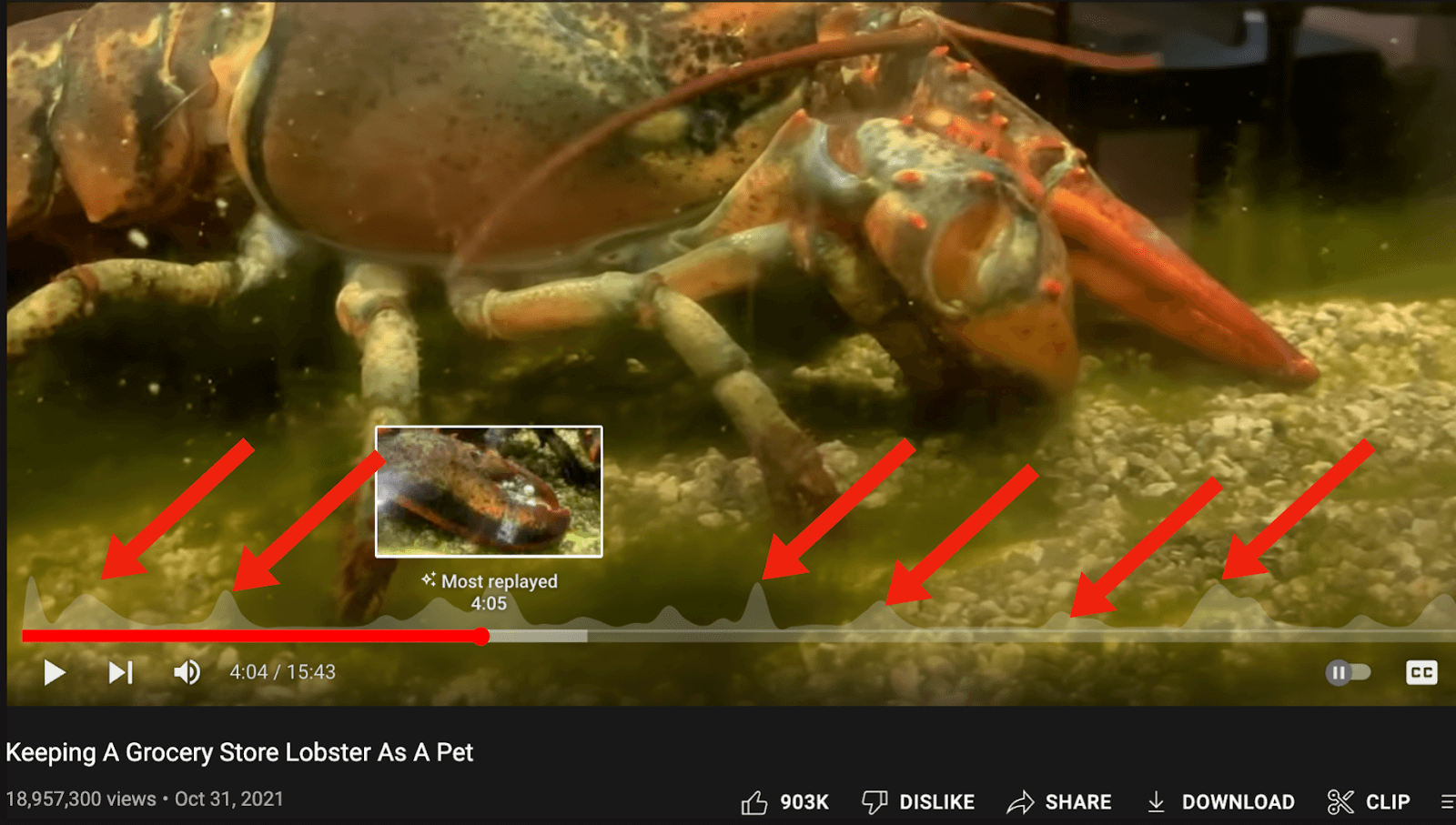
3. Develop your brand on your YouTube channel
Your brand is what sets you apart from your competitors. It includes your channel name, logo, and overall style. Take some time to develop a brand that reflects your niche and personality. This will help you build a consistent image across all of your videos and make it easier for viewers to recognize your channel.
The name and appearance of your channel encompass your brand, and in the beginning, you’ll have to make some choices (that are not permanent and can be changed later). Over time, your brand also becomes your voice, and the types of videos you create for your specific audience.
Speaking of the look of your brand, your brand styling may include things like fonts or the colors you use. Check out the Charli Marie logo in the below example and the purple motif that repeats throughout her channel and videos:
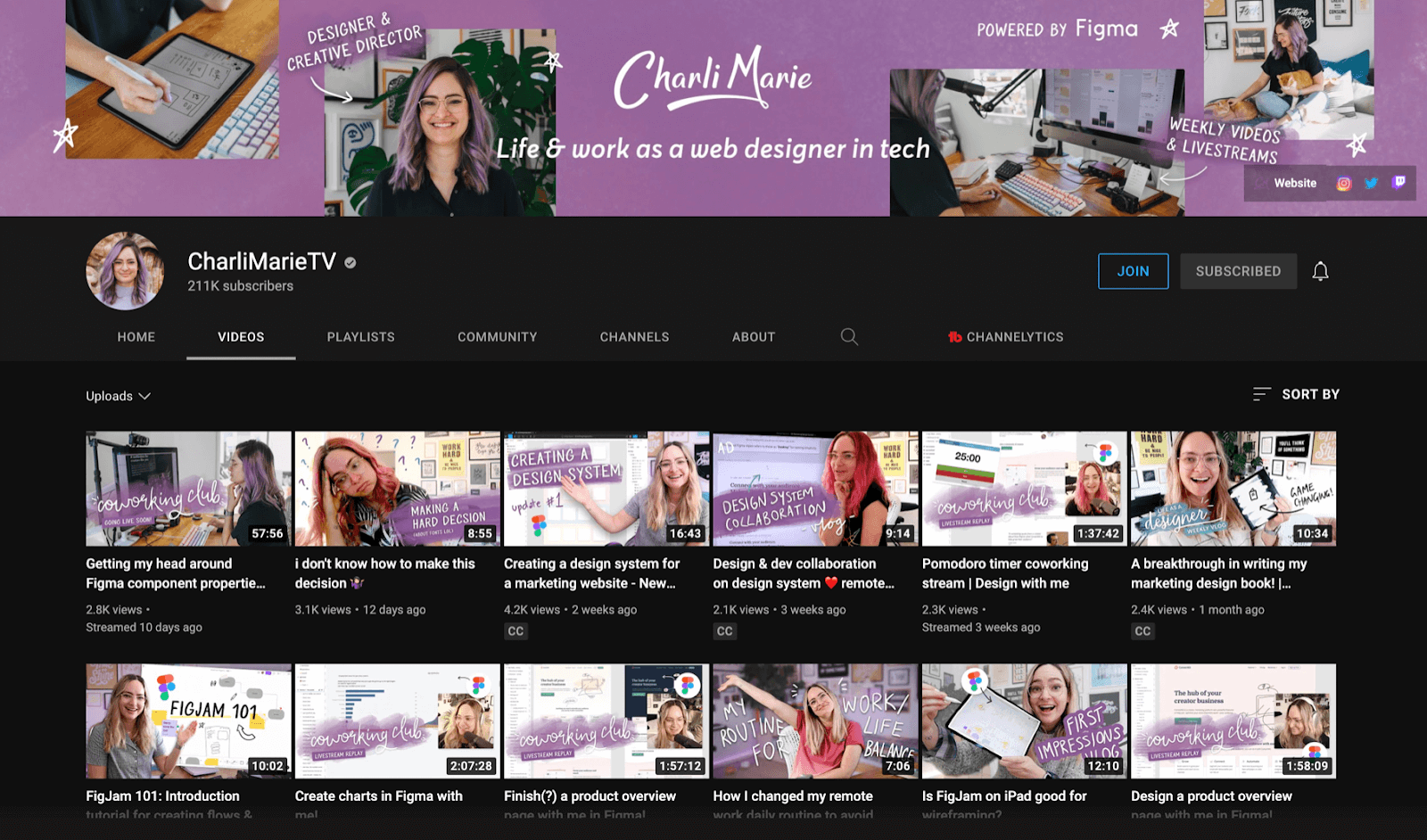
Your brand can be based on your theme, and your channel artwork can be based on the advice that you know you’ll be offering, like the Dad, How Do I? channel.
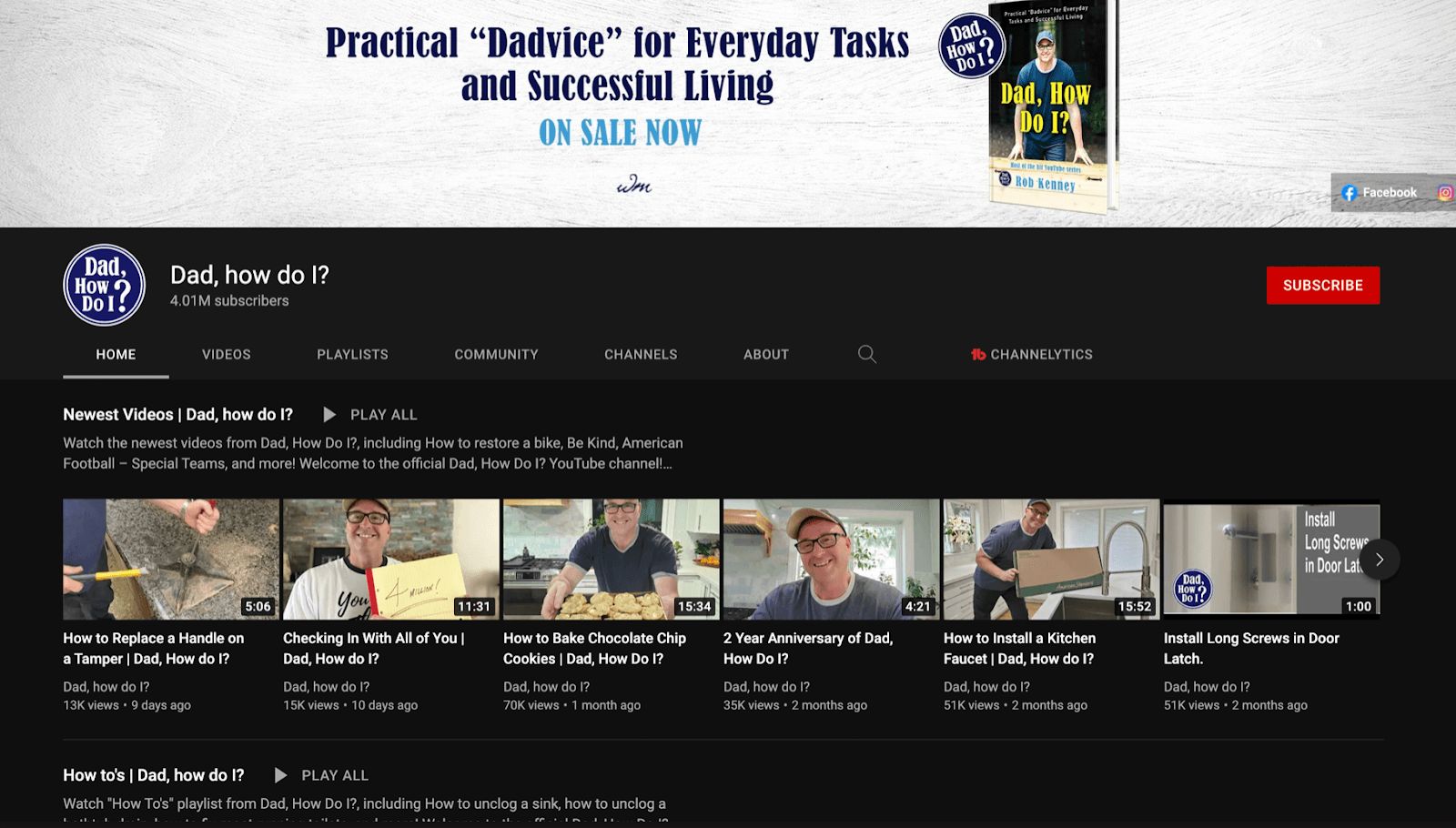
You’re also going to want to come up with a slogan for your channel. You can think of this as your channel’s value proposition — a concise statement of the benefits people will get from your content. The slogan for my YouTube channel is “Make more money. Save more time. Help more people.” It’s what all of my content on that channel is geared around.
Similar to step #2, research other channels (not just those in your own niche) to get inspiration for how brands look and feel on YouTube.
Here are a few more resources on branding:
- What Is Branding: Definitions and Why It’s Important
- Branding and Marketing: What’s the Difference?
- The SPI Beginner’s Guide to Branding
Setting Up Your YouTube Channel
Now that you’ve laid the groundwork, it’s time to create your YouTube account and publish your first video!
4. Create your YouTube account
To create a YouTube channel, you’ll first need a Google account. If you don’t have one already, create one now by going to the Google Account sign-in page at Accounts.Google.com/signin.
Click Create account, and you’ll be prompted to enter your name and create a username and password for the account.
Once you have a Google account, go to YouTube and sign in with your new account credentials.
It’s as simple as that!
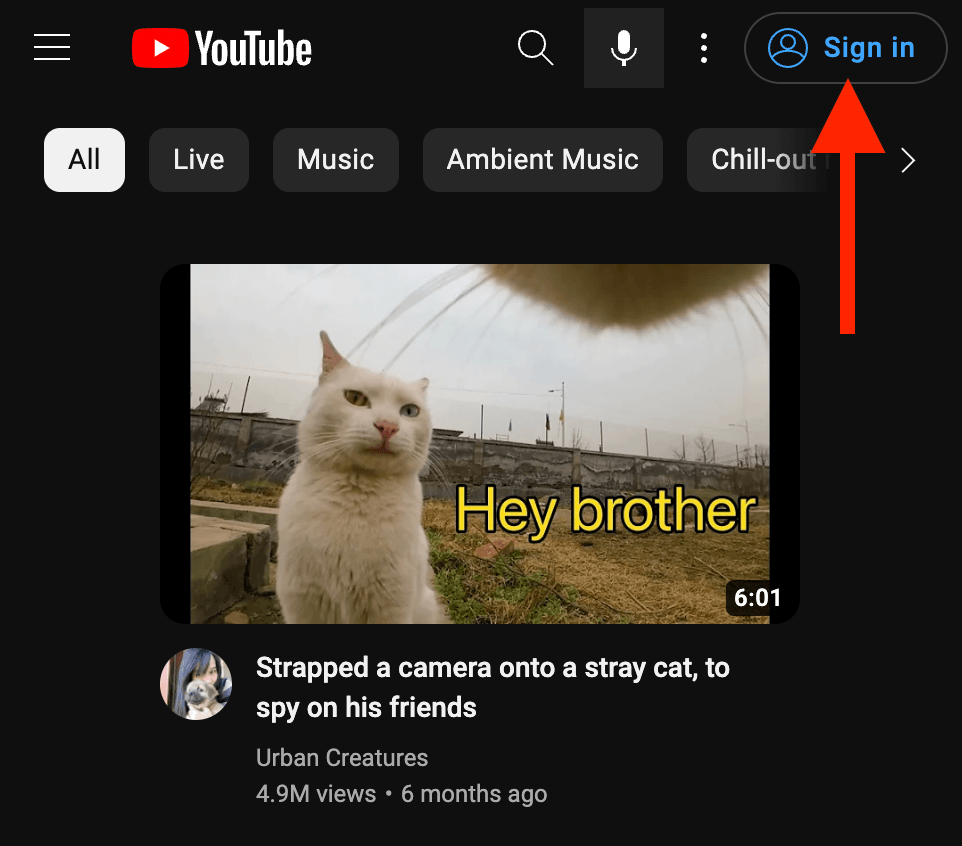
5. Set up your YouTube channel
Setting up your channel is also easy. Here are instructions for creating your channel on the YouTube website; the steps are similar on the YouTube mobile app.
Once you’re logged in, click on your profile icon in the top right of the page and select Create a channel.Add your name and handle, then click Create channel.
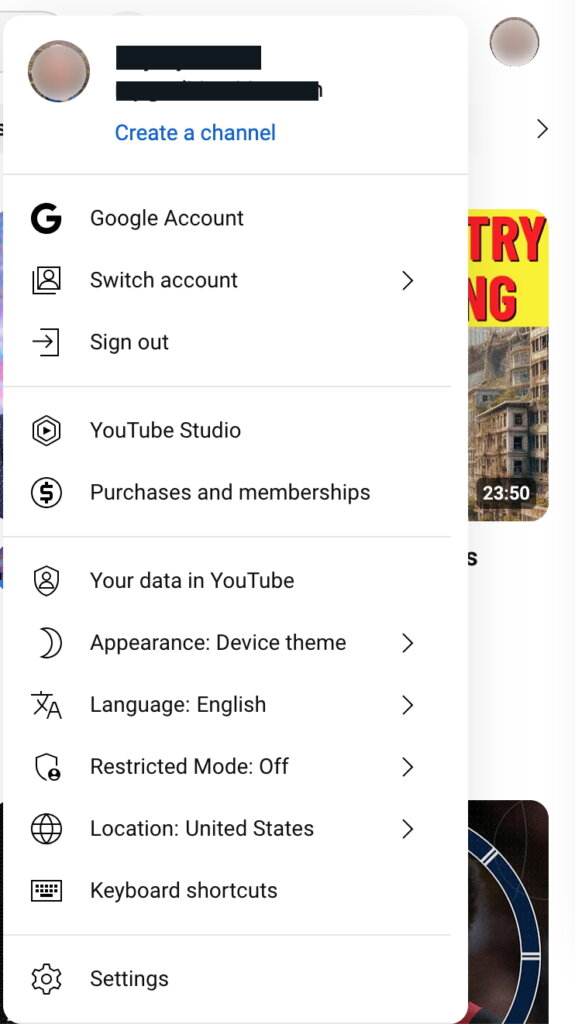
Follow the prompts to set up your channel name, description, and profile picture. Be sure to fill out all of this information accurately and completely. This will help your channel appear more professional and attract more viewers.
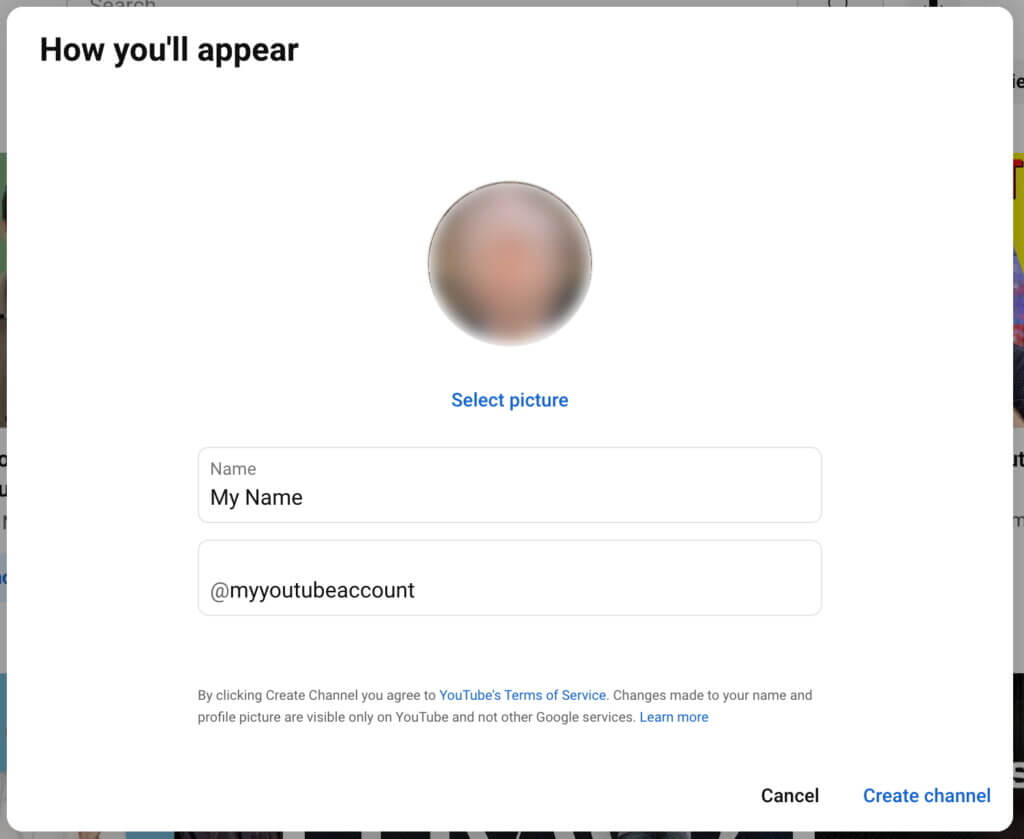
Want to customize your channel branding? Go to Channel customization and click on the Branding tab, where you can:
- Update your profile picture if you haven’t already (needs to be at least 98 pixels square).
- Add a banner, the image that appears at the top of your channel page (at least 2,048 x 1,152 pixels).
- Add a video watermark (150 x 150 pixels) that will show up in the right-hand corner of all your videos.
6. Verify your YouTube channel
This step is quick but very important if you want to upload videos that are more than 15 minutes long, add custom thumbnails, or use live streams on YouTube!To verify your channel, go to Youtube.com/verify. You’ll be asked to enter a phone number, and YouTube will send you a verification code via text or phone call. Note that your phone number can be linked to no more than two YouTube channels per year.
7. Record your first YouTube video
Now it’s time to create your first video. You don’t need expensive equipment to get started. Your smartphone camera or laptop camera will do just fine.
Choose a topic that you’re passionate about and start recording. Don’t worry too much about making it perfect — your first video is just a starting point.
It’s going to take time to see results. When YouTube megastar MKBHD was on the SPI Podcast, he said that his first 100 videos were for less than 100 subscribers. Today, he has over 18.9 million subscribers and counting.
Filming and editing videos can often derail the excited first-timer, but I definitely recommend you push through and learn as you go. If you’d like some direct help and to join a community while building a YouTube channel with others, I recommend checking out the SPI All-Access Pass, which gives you access to all of our courses (including YouTube from Scratch) as well as access to a community and my team to guide you along the way! For even more support, membership in our SPI Pro community gives you access to Experts in Residence like video wiz Caleb Wojcik.

Start your YouTube channel the smart way.
The All-Access Pass community has the courses, resources, support, and accountability you need.
8. Create a great title and thumbnail for your YouTube video
Titles and thumbnails are incredibly important: they’re the first things people see before they watch any part of your video!
Choose a title that captures attention, but don’t get over-the-top and clickbaity. Some “bait” is important, but whatever you choose for both your title and thumbnail, make sure you deliver on the promise.
There are a lot of resources for creating great thumbnails. I recommend checking out my video on quickly creating thumbnails as a starting point.

As a reminder, it’s not going to be perfect, and you can always change your title and thumbnail later. Do your best, then move on to the next step.
Tip: a great tool for creating thumbnails is Canva! Canva has a lot of templates specific to YouTube thumbnails that you can choose from.
9. Publish your first YouTube video
Hitting publish can be scary, but it’s the only way to learn what works and what doesn’t. Hit publish and be proud of the fact that you created something and shared it with the world! It’s like planting a seed: it’s now where it needs to be to have a chance to grow and thrive.
In most cases, you’re not going to get a flood of views right away, and sometimes YouTube needs time to find the right audience for your videos. That’s why the next phase is important—creating a system that helps you consistently create great video content your audience will enjoy and takes the guesswork out of growing your channel.
Creating a System for YouTube Success
If you want to grow your YouTube channel, you’re going to need to create a system. The steps below will help take the guesswork out of what to create and when to publish it, monetizing your channel, engaging with your audience, and the other keys to sustainable success on YouTube.
10. Pay attention to your YouTube channel’s analytics
Paying attention to your analytics helps you improve over time and understand exactly what’s happening with your videos, good and bad. You can find this info by going to the Engagement tab and clicking on Analytics.
Here are the two most important metrics you want to pay attention to:
- Click-through rate: This is an indicator of how many people click to watch your video compared to the number of impressions (people who saw your video title and thumbnail) your video had. In other words, are people liking the title and thumbnail enough to click through? Shoot for a 5 percent or more click-through rate. Anything below that, you can always make improvements over time.
Average view duration: This is how long a person watches an individual video. The longer you can keep people watching, the more likely YouTube will serve your videos to more people. Pay attention to your retention graph, which can show you how sticky your video is. This can be found in the engagement tab in your analytics.
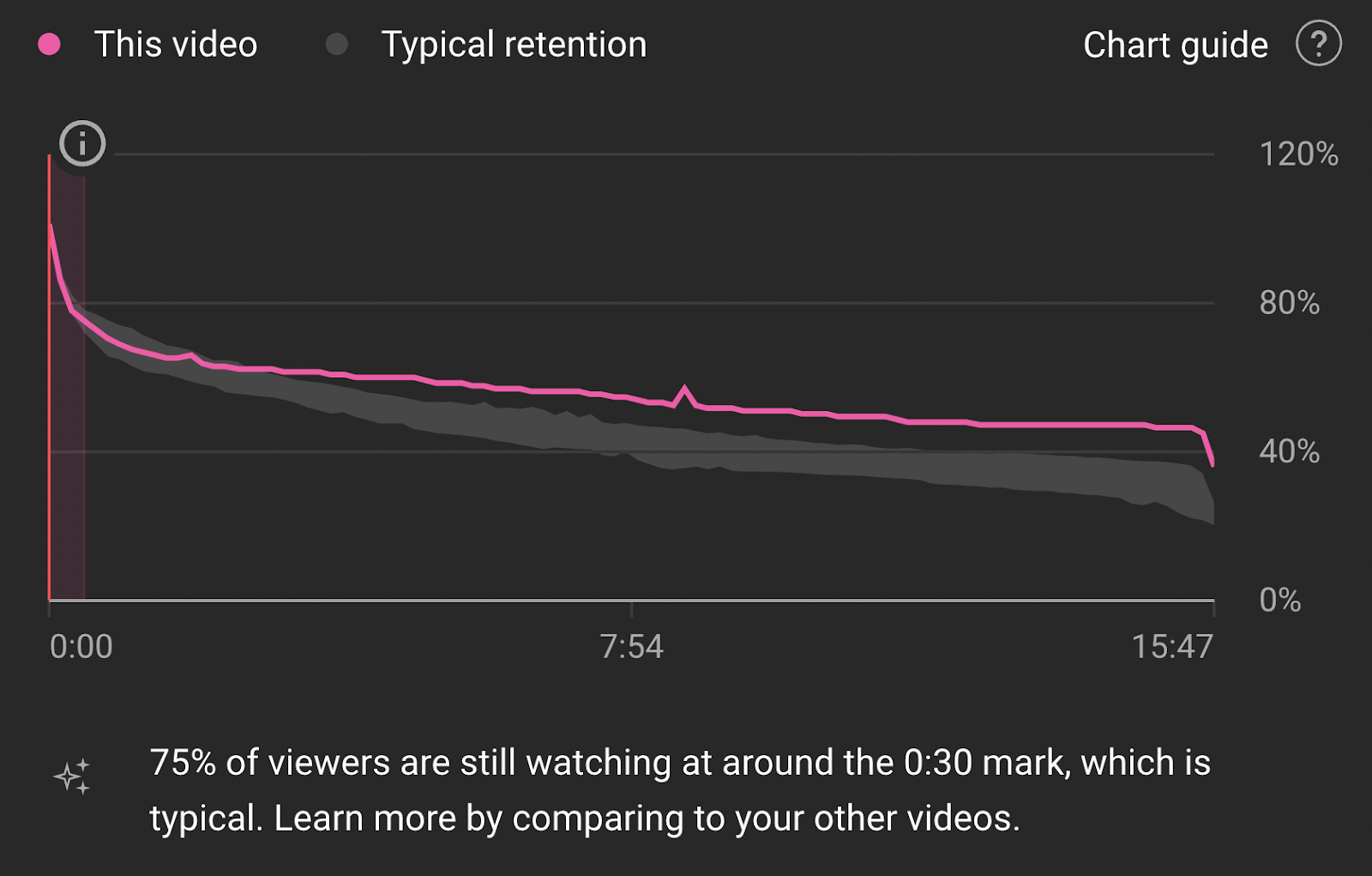
Holding the attention of your audience is a huge factor in the success of your videos and your channel.
Your analytics will also tell you what days and times people are most engaged with your videos. You can use this data to determine the best times to publish new content.
11. Create a trailer for your YouTube channel
A trailer is a short (usually less than two minutes) video that gives people a taste of your channel before they dive into your content.
Your trailer doesn’t have to be fancy—it can simply be you introducing yourself and your channel, explaining what your channel is about, what kinds of content you create, and why viewers should subscribe. (Remember your value proposition!)
Once the trailer is ready, upload it to your channel as an unlisted video. Here’s how to specify it as your trailer:
- Sign in to YouTube Studio.
- From the left menu, select Customization and then Layout.
- Under Video spotlight, click ADD next to Channel trailer for people who haven't subscribed, and select a video for your channel trailer.
- Click Publish.
12. Come up with a list of video ideas
To maintain consistency with your new YouTube channel, you’re going to need a pipeline of great content. Here are some tips to help you come up with ideas for new videos so you never run out of inspiration.
- First and foremost, focus on ideas that fit your niche—use your slogan or value proposition as a guide to make sure your video ideas match your channel’s purpose.
- Take inspiration from frequently asked questions in your niche or field of expertise.
- Cover trending topics or news related to your niche.
- Share personal stories, experiences, or behind-the-scenes looks into your life/work.
- Analyze or react to other popular videos in your niche.
- Interview or collaborate with other creators or influencers (see #21).
- Repurpose existing content like blog posts and podcasts into videos.
- Poll your audience directly and review comments on your existing videos (see #16) to learn what people want to see.
- Look at search data (like Google Trends) to find popular keywords and topics, and review your channel analytics (see #10) to identify video types that perform well with your audience.
- Create tutorials, how-to guides, or product reviews or comparisons related to your niche.
13. Create a content calendar for your YouTube channel
Consistency is important on YouTube. As best as possible, you’ll want to publish videos on a regular schedule.
Create a content calendar to plan out your videos in advance. This can help you stay organized and ensure that you’re uploading new content on a regular basis. Your content calendar can include the topics of upcoming videos, the date you plan to upload and publish them, and any other relevant information. Pay attention to your analytics (see #10) to determine the best days and times to publish new content.
Choose a frequency that works for you and the time you have available to create and upload videos. If you have the ability to create more, especially early on, that will help you more quickly refine your workflow and what works and what doesn’t for your particular audience. But be careful about overextending yourself and burning out to the point where you no longer come out with videos on a regular basis. It happens more often than not.
14. Promote your YouTube videos
Promoting your videos is an important part of growing your YouTube channel. Share your videos on social media, embed them on your website or blog, and collaborate with other creators to reach a wider audience. You can also use YouTube’s built-in promotion tools, like paid ads and featured videos.
The YouTube Community tab is a useful tool (previously only available to creators with large followers, but now open to all) that lets you engage with your subscribers outside of video uploads. You can post updates, polls, and other content directly to help foster a closer community, build brand awareness, and promote your YouTube content.
And of course, don’t forget to encourage viewers to like your videos and subscribe to the channel!
15. Improve your YouTube channel’s SEO
Did you know that YouTube is the world’s second-largest search engine? If you want to grow your channel, making sure your content shows up in search results is going to pay dividends.
Here are the biggest keys to improving your videos’ search rankings—many of which are covered in this guide!:
- Do keyword research (using a tool like Ahrefs’ YouTube Keyword Tool) to choose keywords relevant to your video topic and incorporate them into your titles, descriptions, and tags.
- Write compelling titles and descriptions that accurately reflect each video’s content.
- Include closed captions and transcripts to improve accessibility.
- Maintain consistent branding with channel art and thumbnails that grab viewers' attention.
- Engage with your audience by responding to comments and encouraging shares.
- Promote your videos on other platforms like social media.
- Analyze your video analytics to identify high-performing content and optimize your strategy accordingly.
Consistently publishing high-quality video content that’s targeted to your niche is crucial for YouTube SEO success.
16. Engage with your YouTube channel’s audience
Engaging with your audience is crucial for building a community around your channel. Respond to comments, ask for feedback, and create videos based on your audience’s interests and requests. This can help you build a loyal fanbase and keep them coming back for more.
A question lots of first-time YouTubers face is whether to leave comments on or off on their videos. The benefit of turning them off is that you’ll save time not having to moderate or respond, as well as avoid potential spam comments. But in my opinion, you’re missing out on a lot of potential benefits if you do this! By allowing viewers to comment on videos, you’ll have a chance to learn from your audience about what they’re looking for, as well as establish a direct rapport with them. It’s a little more work for you, but it’s definitely worth it!
17. Monetize your YouTube channel
Once your channel has grown, you may be eligible to monetize your videos. This can include earning money from ads, sponsorships, and merchandise sales. To monetize your channel, you’ll need to meet YouTube’s Partner Program requirements. This includes having at least 1,000 subscribers and 4,000 watch hours in the past 12 months. Once you meet these requirements, you can apply to join the Partner Program and start earning money from your videos!
There are a few more things to keep in mind as you dive into monetizing your YouTube channel:
- Meeting YouTube's monetization criteria (1,000 subscribers and 4,000 watch hours in the past 12 months) to be eligible for ads.
- YouTube offers a number of ad formats (skippable, non-skippable, overlay, etc.), and you’ll need to choose the optimal one for your video types.
- Your content will need to follow YouTube's advertiser-friendly guidelines—or you’ll risk demonetization.
- If you’re planning on doing paid promotions, you’ll need to make sure you’re complying with laws on disclosures for these kinds of promotions.
- You’ll need a solid understanding of your audience demographics so you can target relevant advertisers or sponsorships.
18. Upgrade your equipment
Although you can definitely get started with just your smartphone or computer camera, once your channel starts to take off and generate some income, consider upping the ante on your video tech.
- Camera: A new camera is probably the first thing that comes to mind when you’re looking to upgrade your YouTube setup. Thankfully, there are lots of options to suit any budget. Here are two recommendations:
- Budget: Sony Alpha ZV-E10
- Better: Canon EOS R5
- Microphone: Just as important as a camera is a microphone, and you can make a big difference in your viewers’ experience by dropping some coin on a decent mic.
- Budget: Audio-Technica ATR2100x-USB
- Better: Shure SM7B
- Tripod: A tripod can help you stabilize and position your camera whether you’re recording in your home studio or vlogging on the go. I’m biased, but my favorite option here is the Switchpod, which I co-created with Caleb Wojcik.
- Budget: Switchpod
- Better: Also the Switchpod, although the Manfrotto Befree is an excellent option too.
- Lighting: Great lighting can make the difference between a run-of-the-mill video experience and a truly engaging, immersive one. To be honest, picking the right lighting gear can be a little complicated. I suggest checking out Caleb Wojcik’s lighting guide for some recommendations that’ll work for your budget and lighting needs.
- Editing software: The free iMovie software that comes with every Mac is a great option for most of your editing needs. But as you look to incorporate fancier edits and effects into your videos, you’ll want to upgrade to paid software like Final Cut Pro or Premiere.
- Budget: iMovie
- Better: Final Cut Pro X or Adobe Premiere
19. Organize your videos into playlists and sections
As your channel grows and you start producing more videos, you’re going to want to organize your content so your visitors can easily navigate your channel and find what they’re looking for.YouTube’s Featured sections allow you to categorize videos into different buckets that show up on your channel’s home page. On my Deep Pocket Monster channel, I’ve helpfully sorted my videos into categories.
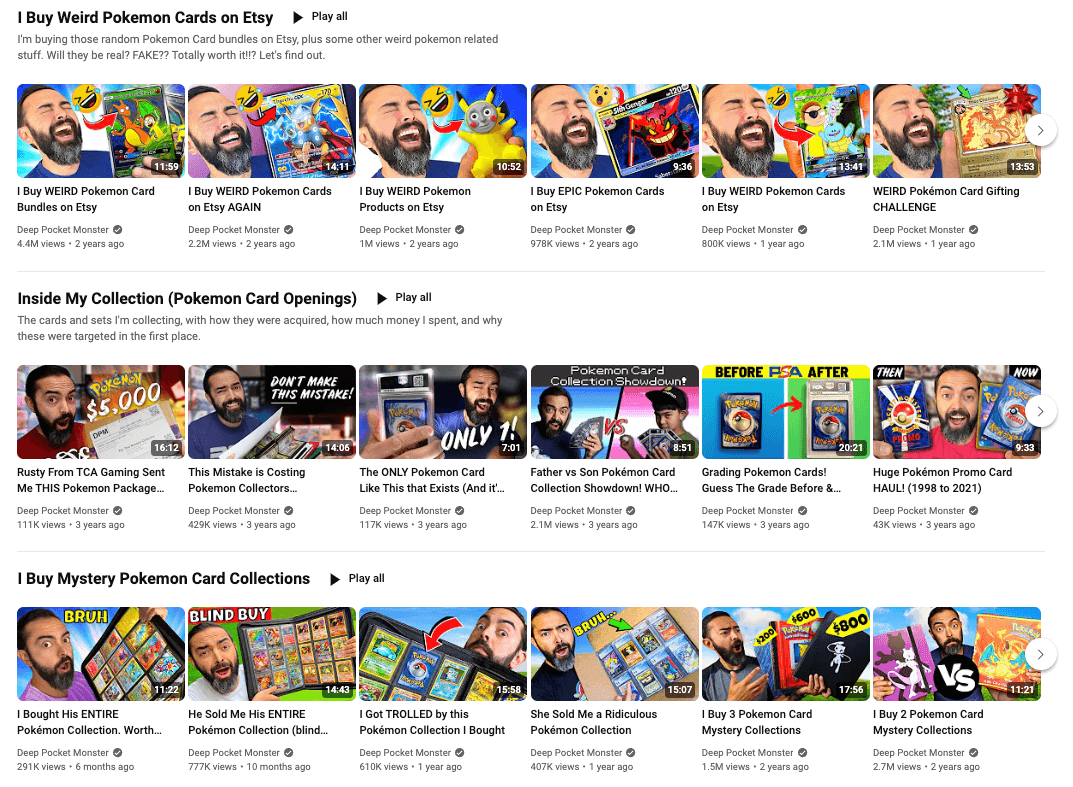
Here’s how to sort your videos in YouTube Studio:
- From the left menu, select Customization and then Layout.
- Under Featured sections, click ADD SECTION. From here, you can add a new section to display videos in a given category, such as popular videos, live streams, and playlists.
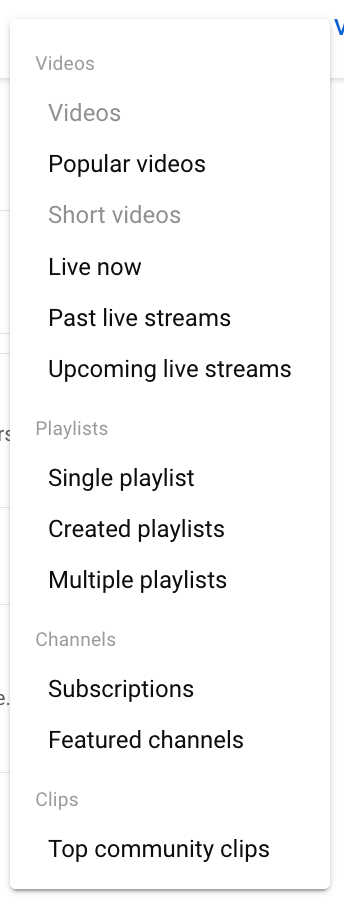
Speaking of playlists, they’re an especially useful way to group your video content according to different criteria. Here’s how to create one:
- Go to the watch page of a video that you want in the playlist.
- Click More, then Save, then Create new playlist. Enter a name for the playlist.
- Select your playlist's privacy setting (if it's private, only you can view it).
- Click Create.
Do this for each category of video you’d like to create. You can then add each playlist to a section on your channel’s home page so viewers can see your videos, neatly sorted for their convenience!
20. Take advantage of other YouTube video formats (live streaming, Shorts)
In addition to the regular “bread and butter” videos YouTube is known for, you can also create live streams and Shorts. I definitely recommend you acquaint yourself with these formats and consider incorporating them into your workflow.
- YouTube live streams: Live streaming is a great way to connect and interact with your audience in real-time, build trust by presenting an unfiltered view of you and your brand, and collaborate with other YouTubers and experts (see #21). You can also save live streams as regular videos on your channel for viewers to access later. Check out SPI Podcast episodes 502 and 704 to learn more about going live on YouTube.
- YouTube Shorts: As you probably guessed, these are shorter (less than 60 seconds) videos. These bite-size videos can help spur excitement about your channel and drive more views of your longer content. Because of the length constraints, Shorts are typically quicker to create and edit, making them a great option for commenting on trends and newsworthy topics. You can even repurpose bits of your longer content into Shorts.
21. Collaborate with other YouTube creators
Collaborating with other creators can be a great way to reach new audiences and create high-quality content. Reach out to other creators in your niche and propose collaboration ideas. This can help you build relationships and grow your channel. You can also participate in YouTube collaborations like tags and challenges to reach a wider audience.
22. Stay up-to-date with YouTube trends and algorithm changes
YouTube’s algorithm is constantly changing, so it’s important to stay up-to-date with the latest trends and updates. Follow industry blogs, attend conferences, and engage with other creators to stay informed. This can help you stay ahead of the curve and create content that performs well on the platform.
My favorite channel for this is YouTube Creators, which is run by the YouTube team itself. I also enjoy Sean Cannell, Roberto Blake, and ChannelMakers for updates, too!
23. More resources for starting your YouTube channel
Before we sign off, I wanted to share a few more resources to help you in your YouTube journey:
- My How to Create YouTube Videos playlist has advice on things like having great camera presence, improving your video production workflow, and other tips for starting off your YouTube adventure on the right foot.
- Our YouTube From Scratch course shows you how to start a YouTube channel and create valuable video content that attracts the right audience and generates revenue (even if you’re scared of video). It can be accessed as part of the All-Access Pass
- In SPI Podcast episode 771, I chat with video professional (and SPI Expert in Residence) Caleb Wojcik about how to consistently create videos to grow your business.
Ready to find join your people and level up?
Like you, we're online entrepreneurs who crave connection, direction, and support from people like us.
24. Conclusion and FAQ
Starting a YouTube channel can be a fun and rewarding experience. By following these steps, you can create a successful channel that reflects your passion and personality. Remember to stay consistent, engage with your audience, and always strive to improve. Happy YouTubing!
FAQs:
- Do I need expensive equipment to start a YouTube channel?
- No, you can start with just your smartphone camera or your laptop’s built-in camera. As your channel grows, you can invest in more equipment.
- Can I monetize my channel right away?
- No, you’ll need to meet YouTube’s Partner Program requirements before you can monetize your videos, which includes having at least 1,000 subscribers and 4,000 watch hours in the past 12 months
- How often should I upload new videos?
- Consistency is key on YouTube, so aim to upload new videos on a regular schedule that works for you. Quality is important, however, so do your best to create great videos that your audience can enjoy.
- Can I collaborate with other creators outside of my niche?
- While it’s possible, collaborating with creators within your niche can be more effective for reaching your target audience.
- How long does it take to grow a successful YouTube channel?
- There’s no set timeline for success on YouTube. It can take months or even years to build a loyal audience and monetize your videos. Keep working hard and stay committed to your channel!
The post How to Start a YouTube Channel in 2024 appeared first on Smart Passive Income.
]]>Some of my favorite success stories are ones where someone achieves their dream, only to realize their true passion lies elsewhere. Not giving up or settling, these people often redirect […]
The post SPI 787: The Secrets of Creating (and Joining) a Podcast Network with Hala Taha appeared first on Smart Passive Income.
]]>Some of my favorite success stories are ones where someone achieves their dream, only to realize their true passion lies elsewhere. Not giving up or settling, these people often redirect their skills into something greater for themselves and others. And that's exactly what today's guest is doing!
Hala Taha, host of Young and Profiting and CEO of YAP Media, is applying everything her successes and failures have taught her to bring people together. She now runs one of the top podcast networks and leverages her knowledge and platform to generate millions of dollars.
In today's episode, Hala shares the ups and downs of her inspiring journey. Listen in because we get an inside look at how her network operates and dive into the pros and cons of joining forces with other creators!
How do you attract volunteers and superfans to help grow your brand? What are the things sponsors look for, and how do your podcast art and reviews affect the offers you get? What are the minimum requirements to join a network, and how do you avoid signing a bad deal?
These are just a few of the questions we explore today. Join us to learn from Hala's incredible expertise!
Today's Guest
Hala Taha
Hala Taha, dubbed the “The Podcast Princess,” is the Global 100 host of Young and Profiting (YAP), frequently ranked as a #1 Business and Entrepreneurship podcast across all apps. She is also the founder and CEO of YAP Media, a business podcast network with a full-service social media and podcast marketing agency for top podcasters, celebrities, and CEOs. Hala is well-known for her engaged following and influence on Linkedin.
Young and Profiting is a Top 100 podcast globally, and Hala has interviewed star-studded guests from the likes of Matthew McConaughey, Alex Hormozi, Deepak Chopra, Daymond John, Seth Godin, Robert Kiyosaki and countless others. Her show was recognized as a 2022 Webby Honoree. With the success in growing and monetizing her own show, Hala launched YAP Media Network in January 2022.
Hala is an expert on networking, marketing, social media, personal branding, side hustles, entrepreneurship, and podcasting.
- Connect with Hala on LinkedIn and Instagram
- Find out more at YAPMedia.io
You'll Learn
- Turning your failures into million-dollar skills
- Finding volunteers to help your brand grow
- The ins and outs of running a podcast network
- The requirements and benefits of joining a network
- Why sponsors want your face on your podcast's artwork
- How reviews affect your odds of attracting sponsors
- The standard revenue split in a podcast network
- How to avoid signing a deal that hurts your show
Resources
- Subscribe to Unstuck—my weekly newsletter on what's working in business right now, delivered free, straight to your inbox
- Connect with Pat on Twitter and Instagram
SPI 787: The Secrets of Creating (and Joining) a Podcast Network with Hala Taha
Hala Taha: I'm thankful for all my failures. I'm thankful for all my experiences because it's those skills that I learned back then that I'm now making millions of dollars off of. So even though I got rejected, and even though people hurt me, and the gatekeepers told me no, and everything like that, I still gained so much out of those experiences. Even though I didn't make a dollar back then, I'm literally making millions of dollars a year now with those same skills that I learned back then.
Pat Flynn: Some of my favorite success stories are the ones that follow a journey to somebody's dream. They actually reach that point of achieving their goals and then realize that maybe that wasn't the right path for them. Either that or they get kicked out like I did in the world of architecture and then discovering a new version of themselves, a better version, and using a lot of those talents and things that were learned into something new that can help not just themselves live a better life, but several other people too.
And that's exactly what our guest has done today. She was in the entertainment industry. She had actually been on the radio, been on television and realized that, well, that's not the path that she was going to go down in the future.
Because she had bigger dreams, in fact, and she's realized those dreams today. You could find her at Young And Profiting, which is another podcast hosted by Hala Taha. She is an incredible force. She has interviewed so many incredible people and she's created one of the top podcasting networks that is out there.
We're going to talk a little bit more about networks today. In fact, that's what we're going to focus on because whether you want to start a network of your own, something that combines forces inside of the space that you're in, bringing together people, partners to reach a bigger goal to combine forces and reach bigger advertisers to quite honestly make more money together.
Either that or how might you approach becoming a part of an existing network and what qualifications do you need? What do you need to bring to the table? And how might you position yourself in a way that would get a person who owns a network or who is starting one to say, absolutely, yes, I want you to be a part of this.
There's a lot of pros. There's a lot of cons. Hala is going to break it down for us today. So I hope you enjoy this session. And this is session 787 of the SPI podcast. Here she is, Hala Taha from Young And Profiting.
Announcer: You're listening to the Smart Passive Income Podcast, a proud member of the Entrepreneur Podcast Network, a show that's all about working hard now, so you can sit back and reap the benefits later. And now your host, he thinks the name microphone isn't a good name. Because it's not actually that small. Pat Flynn.
Pat Flynn: Hello, welcome to the SPI podcast. Thank you so much for being here.
Hala Taha: I am so excited.
Pat Flynn: I was grateful to have been a guest on your show, and I wanted to return the favor as quickly as possible because you have so much knowledge.
You have a vast number of experiences that have led you to where you're at today, and especially your podcast network, your successful business, your team of 40, and all the amazing things you're doing. Plus you are a rock star on LinkedIn. I mean, we could go anywhere. Stick around because we have a very particular place we're going to go.
But I do want to start with your story. I know you were in the entertainment business for a while. Tell me about what that was like and why you're out of it.
Hala Taha: Sure. So I actually started my career in radio. I dropped out of college for an internship at Hot 97, which was the number one hip hop and R& B station at the time.
This was over 10 years ago. And I was actually Angie Martinez's assistant for three years. And I didn't get paid a dime. And I did this for three years because in the radio world, you really got to pay your dues. And my goal was to be the next Angie Martinez. And they were basically priming me for that.
So I actually dropped out of school to take this internship full time, whatever that means in terms of a free paid internship. And once a paying job opened up, I really wanted to start getting paid to be the producer. Unfortunately, I didn't get the job at Hot 97 and I got pretty upset and I got fired from my unpaid internship.
So that was like my first like big rejection and that one really hurt because I had like really identified myself with Hot 97. My social media handles had Hot 97 and so that was super devastating. Once I got let go from Hot 97, I didn't let failure kind of keep me down. And I decided that I was going to start this female movement called The Sorority of Hip Hop.
And I decided that I was going to launch a blog. And so I went back to school to graduate. I started recruiting girls on Twitter and Craigslist, and I started this website and I figured out how to hack Twitter where whenever we'd put out like a blog post about like a rapper or whatever it was, we would add their name and I connected all of the girls profiles, and I had 150 girls in and out of this organization over three years who blogged for me for free. And we would go viral because like Drake would see like a hundred pretty girls tweeting him and he'd retweet one of us and then we started to go viral and we were the first ones to do that. Now everybody does that, but I was the first one to do that on Twitter.
So we caught notice from MTV. They wanted to shoot a pilot with us, a reality TV show just three months into me creating this website. Like we were already one of the biggest entertainment news sites just three months into me creating this blog. So suddenly the same DJs like Angie Martinez and Funkmaster Flex and Saifah Sounds, all the same DJs that didn't give me a job at Hot 97 started calling me up and asking me to host parties with them.
So my blog started to turn into this like event business and we were like hosting all the coolest parties in the city and getting paid for it. And like, it just like started to blow up into this whole movement. And then about three years into or two and a half years into it, MTV reached back out to us and they're like, okay, like, we really want to do a show this time.
They signed six of the main girls. They got us a studio on Broadway and they filmed us the entire summer. So here I was thinking, finally, six years into it, basically working for free, doing odd jobs in marketing and stuff to make money in these events and whatever, but didn't really have much security at this point or success.
I thought MTV was my golden ticket. Finally, I made it, right? They shot us all summer. I was the lead and I was so excited. And two weeks before they're supposed to air the show, I get a call from the producer. I still remember this conversation and she was like, hola, I'm so sorry. We're pulling the plug.
Pat Flynn: No.
Hala Taha: And I was like, Oh my God.
Pat Flynn: That was going to be your break.
Hala Taha: I know. And I also was co host on Sway in the Morning and Sirius XM. Angie got me that opportunity and Sway didn't like me. And so like two weeks into it, I was fired. So I got rejected from terrestrial Radio, satellite Radio, and TV. So at that point, I was like, all right, this is not for me, obviously.
Like, I'm never going to make it. All my siblings were in med school. I was like the black sheep of my family, like at one point living on my brother's couch, like trying to make it. And so I was like, okay, I'm just going to go back to school, be a normal person, go into corporate. I got my MBA, got a 4.0 that gave me my leg in the door at Hewlett Packard.
And then I just, went into corporate for four years. And when I was in corporate and I was getting bored and I was basically doing the same. I was doing really well in corporate. I was the same person, just this like intrapreneur within the corporate world. I was upset about an opportunity I didn't get.
And then I started my podcast and that's what set me back off. And this time around I struggled.
Pat Flynn: So, yeah, and the podcast has been incredible, Young and Profiting. Y'all got to listen to it and get on that. And it's on YouTube as well, which is really great. And it feels like now. I mean, where you're at now and what I know about you and your brand, you're using a lot of the same superpowers you had back then with networking and getting your foot in the door, but you're using that in a different space and now on your terms, tell me if you could go back and talk to your younger self, like what would you say in terms of like, Hey, maybe that's not the path.
Cause I mean, So many people get so into Hollywood and that path, and it's very attractive for obvious reasons. But if you can go back and tell yourself like what to avoid or what to look out for, what really means success to you, what would you say?
Hala Taha: Yeah, it's so interesting that you ask this because I've been thinking a lot differently about my past lately.
I used to get on these interviews and I used to actually feel really upset from Angie Martinez. Because I'm her age now when I was her intern. And I have Interns and young employees myself. And I know I pay them so well, they have benefits and all this stuff. And I used to get really resentful. Like, man, Angie never gave me a dollar.
She fired me from a job that I quit school for. You don't keep somebody around for three years if you don't like them. You know what I'm saying? And so I used to feel really resentful, but then I talked to Laila Hormozi on my show and she said something to me that really opened my eyes. She was like, you know, like there's research that goes on that like, 50 percent of what you remember of your past is like not accurate.
Like you just remember it from your perspective. Like you don't have the full picture of what happened. Right, so I look at my past more with more like empathy towards the people who didn't give me opportunities because I may have thought I was ready for the producer job, but looking back, I was 23 years old, like, you know, probably not ready for that opportunity.
And like, maybe I thought it was better than I was. Yeah. At the end of the day, I'm thankful for all my failures. I'm thankful for all my experiences because it's those skills that I learned back then that I'm now making millions of dollars off of. So even though I got rejected, and even though people hurt me, and the gatekeepers told me no, and everything like that, I still gained so much out of those experiences.
Even though I didn't make a dollar back then, I'm literally making millions of dollars a year now with those same skills that I learned back then. So, hopefully that helps answer your question in terms of like, if I was to look back and give myself advice, I wouldn't tell myself to not do those things. I think I did the right things.
I got experiences. I explored things. I figured out what I was good at, what I wasn't good at. And I really did lean into my strengths of like community building and being tech savvy and everything like that.
Pat Flynn: So you might say to yourself, hey, things may get rough in the future, but you're going to find yourself wherever you need to be is where you're going to need to be, but just keep going for it.
And versus like, don't do that because like you said, the experiences are important and it's like dating, right? Like you figure out what kind of person you don't want to be around, and then you can kind of use that knowledge for the next decision or the next person that you work with. It reminds me a lot about my story as an architect.
When I got laid off, I was so upset at my boss. I was like, how could you? And like you said, looking back now years later, a little bit wiser, I go, well, he had to fire me. Like there was no way he could keep me because of the recession. And like, he probably felt bad, right? Yeah. So you're absolutely right.
It's all about perspective. And that's the biggest thing here. You say now that you're making millions of dollars. What is the business model that you are working with? And then we'll dive into a particular component of that that I'm very, very curious about in just a moment. But millions of dollars coming from what?
Hala Taha: Yeah, so I have many different businesses. The first way that I started to monetize my brand was through my social media and podcast agency called Yap Media. So the guests who would come on my show at the time, I had a top 10 podcast two years into my podcast. The guests who would come on my show would always be like, who does your LinkedIn?
How'd you grow that? How did you create this podcast? Who does your videos? Your videos are awesome. And at the time I had a volunteer team. I had 20 people working for free for me while I was working full time at my corporate job, helping me run this top podcast.
Pat Flynn: Okay. For free?
Hala Taha: For free.
Pat Flynn: Okay. Hold up. How do you do that?
Like that's a dream to have people do a lot of that production work for you for free. They couldn't. Like what, what was in it for them?
Hala Taha: They learned, right? So I, I think one of my biggest superpowers, and again, why I don't regret all these crazy experiences that I had as a younger person, is that I'm really good at motivating people and bringing people towards a common cause and working for free.
Because almost all the organizations that I had in the past, this blog, I was also like, president of my alumni association and the young employee president at Hewlett Packard. It was all recruiting people for free, so I'm very used to doing that. Okay? So it was actually the super fans on LinkedIn who would reach out to me and they'd be like, Oh my God, your show changed my life.
There's nothing else like it. How can I help you? How can I get the word out? I just want to help. I just want to learn from you. Okay. And so I knew all the pieces to the puzzle. I could audio edit, video edit, create websites, blog, hack social media. So just teach people how to do each thing, and once they mastered it, I'd let them run with it and keep teaching them more stuff.
So as long as you keep teaching people, they're willing to work for free. Actually it's harder to motivate people once they start getting paid, I found. It was like very easy to motivate a volunteer team because I wasn't getting paid. So it's like everybody's just doing this for the, out of the goodness of their heart, you know, and that motivated us.
Pat Flynn: Wow. It's a little counterintuitive, but it makes sense when you understand that, okay, you are helping these people learn with you. And as you go along, there's a common goal here that we're working toward. I know that the audience is going to be like, like, let's talk to them right now. The audience is thinking there's no way, like you should pay people for that kind of work.
But what would you say to that person? Who's thinking that, how do you share the value of the education that a person would get working with you for free? Which I know can be more valuable than money, but what do you say to a person who is a little triggered by just wait, wait, hold up, you're like you're, you're taking advantage of somebody, you know?
Hala Taha: Yeah, and I knew that that might be a thought, but in my mind, I never wanted to monetize this podcast. I was putting out this podcast just to help people and that's why everybody wanted to help me. So I actually had no goals of monetizing. Everybody just thought I was this awesome, not just thought, like I was just trying to put out good content.
I had this other job and I was a failed entrepreneur and actually pretty scarred about all my failures in the past that it took me so long to actually quit my job, even when we were making over a hundred thousand dollars a month with our agency, because I was so scared of failing again, right? Really now I would never, because my company's making money, you've got to at least pay your interns a stipend. Yeah. Right? But we weren't monetizing, so that's why I was able to just have volunteers. Once we started monetizing, I started paying everybody. So that's the distinction there. It's like, if you're already monetizing, you've got to at least pay a stipend.
But we were, at this point, it was just a hobby that we all had. And we were just a group that motivated each other and taught each other stuff. So I put everybody in a Slack channel and I taught everybody different aspects of how to produce a podcast. So anyways, the first way that I monetized my show was the guests at the end of the show would always ask me the same question.
How did you do this? How can you grow your LinkedIn? How did you grow your podcast? Can you do this for me? And for the longest time I was like, no, I'm so sorry. This is just a hobby. This is just a passion project. I have a volunteer team. They can't help you. We're busy as it is. And then finally COVID hit and I found myself with no commute, all this free time, and pretty unmotivated. I was at Disney at the time and I felt pretty unmotivated at my job. And I just said, okay, let me give this a shot. And I turned my volunteer team into my agency. That's Yap Media. So my social media and podcast agency started there. And then I started hiring, right? So that, that's the first way I monetize.
Once we started to grow the social agency, all of a sudden I had this money to invest in growing my show. So I started to figure out media buying, and what does that mean? I was doing a lot of trades with different podcast players like Castbox and Player FM. They were sponsoring me because I'm one of the biggest influencers on LinkedIn, and I was doing all these trades with them, leveraging my LinkedIn audience.
Then I realized that you could pay for this. And I started just leaning into paying in media buying. Then I started to grow my show. Then I started to get sponsors. Okay. Then I started to grow other shows this way. And I grew three other podcasts my size and I started to get them sponsorships. Before I knew it, I figured out how to create a podcast network.
And I started recruiting big podcasters that already had a lot of downloads and started getting them sponsorships as well. So that was the birth of the Yap Media Network about two years ago, when we're the number one business and self improvement podcast network now.
Pat Flynn: Incredible. It's no wonder why podcasting is always something you speak highly of.
I mean, like your start was because of the podcast and it wasn't because you immediately had a ton of downloads, but you built these connections and relationships and literally the people you spoke to because they enjoyed the conversation so much, they wanted to work with you. I mean, that's clear to client from the podcast right there.
And then of course it just grew and expanded from there. So let's talk about podcast networks because this is something that we hear a lot about and it feels like it's something that's only available to the top 1% of 1%. It's like, Oh, you have to be in public radio or something to be a part of a network or the New York times or whatever.
But how could a regular person podcast or some brand recruit people, first of all, like how do we attract the right people? Who do we say yes to or no to? But even before that, like what is the podcast network exactly? Like in your words, like what does that even mean?
Hala Taha: Yeah. So podcast network, basically their primary job typically is to grow and monetize.
The podcast and their network. So typically you're reporting over podcasts to your hosting provider, like a network hosting provider, and you're actually flighting ads and doing all the reporting and the tracking with the advertisers. You're pitching the show to different brands, creating proposals and things like that, RFPs, and then you're communicating the information to the podcaster, giving them talk points, doing air checks, flooding the ad, reporting the impressions and results to the brands.
So it's basically facilitating ad flighting and booking sponsorships. And then all the podcast networks have varying degrees of this, but there's also like growth involved. So like cross promotion on other podcasts, getting you guest interviews on other podcasts. If the podcast network is also associated with radio, getting you like radio commercials.
So there's also growth aspects related to it.
Pat Flynn: It almost feels like you are in service to these other podcasts because, you know, you're helping them book ads, you're helping them with the ad reads, you're almost sort of like a middleman, but not really, it's like those opportunities wouldn't come their way if they weren't a part of this network, right?
You have the relationships, you have the connections. And in addition to that, like, do you pitch the network overall to advertisers versus the individual podcast. Cause it would make sense if you had 10 podcasts, each with a million downloads, you could easily pitch a bigger brand and say, Hey, we got 10 million downloads in our network.
For example, is that, is that kind of an advantage you have as a network as well to, to kind of attract bigger sponsors and advertisers?
Hala Taha: You can do that, but the advertisers are not really biting on that right now.
Pat Flynn: Okay.
Hala Taha: That's not really how it works right now.
Pat Flynn: How does it work then?
Hala Taha: So typically advertisers are working with agencies.
So there's like many different layers to this, right? So there's lots of different agencies, like for example, Ad Results, Veritone, Wine, Gumball, Advertise Cast, right? And these agencies work with brands and many of these brands give them like a monthly budget. In terms of the shows they want, then they give them like demographic information that they're targeting.
Any sort of criteria, like they're looking for women, audience, like with this household income or whatever it is. Then these agencies, because they know that we've got podcasts en masse, now they're not going to go to individual podcasters, to your point. They're only going to, they want to be time efficient, so they're going to work with networks who have a lot of podcasts.
And they'll say like, Hey, we've got this brand. They're looking for this. People send us the shows that fit. And they give us an RFP that we fill out and give them the shows that fit. Okay. So on the agency side, it's more of like them telling us this brand has this budget looking for this. And we have to give the information that we have with podcasts that are a fit.
Pat Flynn: Okay, that makes sense.
Hala Taha: But for direct. opportunities. So there's also like working directly with brands. These are typically people who are new to the podcast space, maybe slightly smaller companies or even super large companies that do a ton of podcast buying that have an internal team to do their podcast ads.
And so in this case, we might be more customized. Hey, you know, we've got these three podcasters that would be a perfect fit for your beauty brand. And we might pitch those three podcasters. So in that case, you can kind of do what you were saying before and sort of pitch in mass to a specific brand.
Pat Flynn: Got it.
When thinking about building the network, how do you determine what other shows should be a part of it? Do you have a filter system or some sort of application process? Like, how does it, how does that work exactly?
Hala Taha: Yeah. So for us, like there's minimum download requirements and this is pretty much across the board on the industry.
Now, the Apple iOS update happened in November and most podcasters lost 30 percent of their downloads or more. Especially the older the podcast and the more frequent their episodes per week, the more downloads they lost. So some people lost 50 percent of their downloads. So these numbers, I say this because things are changing now.
The numbers don't mean the same thing anymore because a lot of people's downloads decreased. Right now, our minimums at Yap Media is about 80,000 downloads per month. So 20,000 downloads per week and we sell dynamic ad insertion. So that means we, we monetize new episodes and back catalog episodes with new sponsors, if that makes sense.
So about 80,000 downloads a month would be the minimum. Now, if you are somebody who has a big social following or a big email newsletter list, you might be able to get in the door at a network because of your other channels because it's becoming more common to do these cross channel sponsorships where it's not just about your downloads, it's also monetizing your social and your email and your YouTube and all of that stuff.
So if you also have a big social presence, you might be able to join a network even with less numbers, but typically it's about 80,000 downloads a month is the minimum for most of the network.
Pat Flynn: Got it. That's super helpful. And thank you for the industry wide numbers too. That's, that's super valuable. So, you're also saying that, let's say you only get 40, 000 downloads a month, but you have an email list of over 100,000 or 80,000, like that's going to be attractive and could lend itself to still being in a network because it's the whole brand, not just the podcast download numbers.
Hala Taha: 100%. And I would say like, smaller networks that are not as established, not the Yap Medias and Wondereys of the world, or they might be willing to accept smaller podcasters because they've got more time on their hands. For a bigger network, it's kind of like the same amount of work for a million downloads per month podcast for, you know, some, somebody that gets 50,000 downloads. So it doesn't make sense to do that work.
Pat Flynn: If I'm a podcaster and I want to position myself in the best way possible, you know, I have decent numbers. I have decent, like everything's kind of mid and average across the board. You know, there's other podcasters trying to fight for the same spot. How can I best position myself, my podcast to be attractive to perhaps a network that I would love to be a part of?
Hala Taha: Great question. First of all, face on your podcast cover. What I've noticed with podcasters that join my network, if you don't have your face out there on social media, on your podcast cover, even if you do get signed to a network, brands don't want to bite on you.
They want to know what you look like. They want to know what you stand for. They're going to associate what you look like in terms of what your audience looks like. So I do find that when you don't have your face on your podcast cover, one of the first changes I do for people is put, I'm like, Hey, we got to put your face on your cover if you, if you want to get sponsors, because some sponsors are literally only looking at that. That and deciding if that's, if they're going to book your show. So you want that emotional connection with your face on your cover. The other thing I'd say is reviews. So one of the first things that I look for is I go on your Apple and if you've got, you haven't had a review in a year, that's a really bad sign.
I'm like, your audience is not engaged. You're not doing activities to try to get your audience to engage. It's like a real red flag, right? So proactively getting reviews and really striving to get recent reviews. That's going to really help the social proof of your show. So making sure that you got ample amount of reviews because these things are not a publicly visible, like your downloads are not publicly visible.
If somebody lands on your Apple page, the only way they can judge your podcast size is literally by the amount of reviews that you have. And like I said, if you've got a bunch of old reviews, then it means that your show's kind of stale and you don't really have an active following. So those are two big things as well as having an established social media presence, it's becoming more and more important.
It's. It's super rare for somebody to have especially a new podcast, right, to not have a social following. Some of the legacy podcasters like JLD, you know, those types of folks, he doesn't really have much of a social presence, but he's been doing it for 15 years, so he can get away with that.
But nowadays, you've got to have like, you've got to have your Instagram popping, you've got to have your LinkedIn, and at least those two. And YouTube is great, too.
Pat Flynn: Okay. That's really exciting. Does it get to the point where you ultimately want to be on a call with the network and try to get face to face?
Would that position yourself well and give yourself a good opportunity? Is that, is that pretty, Is that pretty, Normal for a network if they're going to have somebody in their network.
Hala Taha: Yeah, 100%. So it's like, usually there's like a pre vetting form and you probably have to send like screenshots of your monthly downloads to prove that you meet the minimum requirements.
You might have to give them links to your social platforms and tell them your impression counts for your posts and things like that. And then typically what would happen is that if they want you, they're going to the podcast network is going to try to sell you. They're going to have a discovery call with you.
Go over like the tech aspect, go over the rev share, go over the way that they work and communicate with you and they'll give you a contract and you've got to review it and sign it and then you're signed to the network. So that's, that's typically how it works. And something we didn't talk about is that this is all rev share based.
You don't pay to be a part of a network. It's just, you get a rev share based on the sponsorships that they book. So typically it's 70-30 is, is the industry standard. If there's no production work involved where the network is not doing any production work, it's a 70-30 split where the host gets 70 percent of the revenue.
Pat Flynn: Incredible insight. Thank you. What are the downsides. I mean, you have a network, you obviously believe in the, in the model, but you know, for a podcaster out there, who's like, Ooh, this sounds interesting. I know it's also not for everybody who is a, or what is the network not for? Who is it not for?
Hala Taha: Well, here's the thing it's hit or miss with these networks.
I have to say, like, I feel like we're doing so well at Yap Media because we're one of the only networks that has a podcaster as the CEO and I've been on other crappy networks, so I know what I don't want, you know what I'm saying? So one of the things is that. You're signing exclusively typically, which means that if they don't sell ads, you don't make any money and you can't do anything about it.
So I remember I signed to a network, my first network that I signed to, I signed my whole network to it. It was like we were doing so well and we were getting all this attention and I was like, well, I'm going to sign with this big brand because they're going to 10x everything we're doing. They've got a whole sales team.
We got on their network and they did nothing. And my hands were tied and I couldn't sell my show or the other shows and we lost all this money. I had to get out of it because they were tying my hands because they weren't doing the work. So it's like, first of all, you want to make sure that the network is actually going to sell because what these networks do is they get lazy and they just turn on programmatic ads.
So programmatic ads are these pre recorded canned ads that is more like automated. Whatever open inventory there is, if you're on like Megaphone, which is a hosting provider, there's Spotify Ad Network. Any open inventory Spotify puts it in, but it's really low CPM. So the industry standard CPM is like $30.
Spotify Ad Network is like a $5 CPM, sometimes $2. So it's like so bad for the podcast because it's like hurting the listener experience. You're getting these pre recorded ads, not making any money, and you can't do anything about it because you're signed to this contract. So that's a negative right there.
So it's like vetting the podcast network. If you can get like a test trial with them or put it in the contract that you want to have opt in or opt out of programmatic ads, that if they don't hit a certain amount of revenue that you can leave, like put things into protect yourself so you don't, what happened to me doesn't happen to you where you sign and you're doing so well.
And then suddenly you're not getting ads because they're not doing any selling. So that's number one. So be careful of that. In terms of that, there's no other cons because unless you are going to figure out the whole industry and you know, do direct selling and like go crazy with email campaigns, the other option for like independent podcasters might be to like sign up for Gumball and AdvertiseCast.
Then basically you're working with like a middleman who works with the other agencies. That's pretty accessible for independent podcasters. So you could do direct sponsorships and work with like a gumball or an advertised cast and you can manage it on your own, but a network is going to get you those other opportunities because typically the network is working with like all 40 agencies that are out there and getting you all those opportunities.
Pat Flynn: Got it. Biggest lesson there and I can speak from my own experience is to read the contract or have your lawyer read it, understand what the implications are, and there is room for negotiation.
I mean, we've had to negotiate as well because we didn't want to be locked into something or we wanted to make sure there was a way out if it wasn't working. That's probably the biggest thing. So I appreciate you plus wanting that.
Hala Taha: The other thing is asking other podcasters in the net. I think this is a big one.
Ask other podcasters in the network. You can see who's on the network and be like, how are they doing with the sales? How has it been for you? How many downloads are you getting? How much money? Just ask those questions because that's going to be your like foolproof way of knowing if it's a good network or not.
Pat Flynn: For sure. That is great advice. Wow. Let's go into owning a network. I'd love to listen and learn a little bit about what it's like to actually run a network. I know some people who have started some and failed, some who have done it, but are like a little overwhelmed with a lot of the. Ins and outs of that.
Like, what does it really take to own and create a successful network if they want it to?
Hala Taha: It's a lot. There's a lot going on. I would say, first of all, you need to have the right teams. So some of the teams that we have on our network is an ad operations team where they're responsible for all the tech. So flighting the ads, porting over RSS feeds to our hosting provider, coordinating and sending out talk points, sending out financial payout information, and keeping financial trackers updates, and things like that. So ad operations is like something that you'll need to stand up and standardize and create SOPs for when podcasts is ported over.
Also, like preparing the podcast. Most people are doing dynamic ad, so the podcasts that are coming over probably are not doing dynamic ad insertion. So that means cleaning up all the past episodes, taking out the embedded ads, inserting the insertion markers and getting that podcast ready to do dynamic ad insertion where the ad gets flighted across the entire catalog and you've got to like set it up.
So creating all those different processes are super important. Then you've got the sales side. Getting in contact with all the agencies, figuring out, like I would never give that secret away, all the different agencies that exist out there and all the different account reps and what brands they manage and getting all of that organized and making sure that you haven't like, the biggest thing is just being top of mind for them.
So having like upfront calls and quarterly calls with them and, and checking in and sending them gifts and wining and dining them. Right, so it's just like, Keeping those agency partner relationships super deep and fresh and understanding what brands they manage and who's buying when super important.
Right. And making sure you've got all the processes for those ad relationships. Then you've got the direct side because podcasting is super cyclical. Okay, so a lot of the ads happen during upfront season, which is around October, November, December, where people are doing annual buys. And then there's like a testing period throughout the year, but then there's dead points in the year.
And so you need to be really good at doing direct reach outs where you're reaching out to like new advertisers who have never done podcasts before who don't align to the cyclical aspect of podcasting and the agencies, right? So making sure you've got email campaigns and you have different tools to find brands like that and you're being creative.
Then you've got the recruitment side of everything. So you got the ads and the getting sponsors, but then you've also got to recruit podcasters. So what are all the processes with that? How are you going to find those podcasters? Are you going to have a niche podcast network? Or are you going to go broad?
Like who are you going to focus on and how are you going to recruit them and find that information and reach out to them? Right? So for us, actually, I think one of the best skills that we had as a team that enabled us to become a network is we did guest outreach services. As a podcast production agency.
And basically I've taken that skill of doing guest outreach, which is a lot of email campaigns and reaching out and finding information. We took that skill and we turned it into the network because it's the same skill that you need to get sponsors and get podcasters.
Pat Flynn: Right. That's super smart.
Hala Taha: Then it's like communication, right?
Communication to the brands. We have an industry newsletter. We have an internal network letter. We have a marketing ops performance communication update every month. We have a finance update every month. So getting all your communications together to be super transparent, the payout processes, the invoice processes with the brands.
Paying out the podcasters. So there's so many things going on. Also like the marketing materials, right? Creating a website, a catalog. So there's lots going on. You definitely need to like think through it. But what I would say is like, do it for yourself first. I would say figure it out for yourself first, get your feet wet, sign up to Gumball, sign up to AdvertiseCast, do some direct outreach, start to get your feet wet with yourself, maybe set up your own podcast for dynamic ad insertion on Art19 or Lispin or something that's accessible to an independent podcaster and try it out first for yourself.
Then you'll know all the aspects it takes to do one show. And then you'll be able to hopefully figure it out for other shows as well. I think the big thing would be agencies and getting networked with them once you actually have an established network with other shows.
Pat Flynn: That's perfect advice. You know, doing it yourself first is always best because then you understand what works and what doesn't and what your own style is like.
And I feel like if you're in a super niche, part of an industry, your ability to be the one to step up, to then bring everybody together, to be the hub is something that could work really well. However, if you feel like maybe you are in an industry that is maybe pretty saturated, or there's a lot of people out there and you want to be at the top connecting with an existing network is great because obviously you just heard all the ins and outs that go into that, and you might not have time for that.
And that's the benefit. That's the, that's the relationship that's created between network and podcaster. And I appreciate you coming on today. This was super informational. You went really quickly through a lot of stuff that I'd never heard of before. So I appreciate you. Why don't you do a little pitch for, for Yap and what people can discover over there and where you want people to go to, to find out more info from you.
Hala Taha: Pat, thank you so much for your time today. If you guys want to check out Young and Profiting podcast, it is my baby. I've been doing it for six years. I interviewed the brightest minds in the world. I've interviewed Pat on that show. Just check out Young and Profiting. You can find it everywhere. If you want to check out information about my network or my social agency, you can go to YapMedia.io. And if you want to follow me on social media, you can get me on Instagram at @YapWithHala or LinkedIn. You can search for my name. It's Hala Taha.
Pat Flynn: You are incredible. Thank you so much for coming on today. Appreciate you. And we'll put all the links in the show notes for everybody and all the best of luck.
Thank you again.
Hala Taha: Thank you.
Pat Flynn: All right. That was an incredible episode. I learned so much about podcast networks. And if you want to start a network of your own, whether it's a podcast network, a YouTube network, a blog network, a TikTok network, whatever it might be, this is an episode that can help you understand the ins and outs of that.
Or if you want to join a network, like we talked about, now, you know what it takes and what you can bring to the table. So it's not just about your numbers that you have on the platform. It might be all the other numbers that you have combined behind that as well. So keep that in mind. And Hala, thank you so much for coming on today.
Definitely check out and subscribe to the Young and Profiting podcast. You can check out Yap media as well, and the network over there and just. Man, she's got so many amazing things going on. I'm so grateful for her and I'm so grateful for you for listening all the way through. I appreciate you and be sure to subscribe so you don't miss out on the next episodes coming your way soon.
Cheers. Thanks so much. And all the best to you. See you in the next episode.
Thank you so much for listening to the Smart Passive Income podcast at SmartPassiveIncome.com. I'm your host, Pat Flynn. Sound editing by Duncan Brown. Our senior producer is David Grabowski, and our executive producer is Matt Gartland. The Smart Passive Income Podcast is a production of SPI Media, and a proud member of the Entrepreneur Podcast Network. Catch you next week!
The post SPI 787: The Secrets of Creating (and Joining) a Podcast Network with Hala Taha appeared first on Smart Passive Income.
]]>Next-level growth for next-level entrepreneurs Connect with established entrepreneurs for support, inspiration, and collaboration 10k+ Posts & Comments 450+ Active Members 9 Experts in Residence 100+ Private Events A supportive […]
The post SPI Pro Community appeared first on Smart Passive Income.
]]>Next-level growth for next-level entrepreneurs
Connect with established entrepreneurs for support, inspiration, and collaboration
10k+
Posts & Comments
450+
Active Members
9
Experts in Residence
100+
Private Events
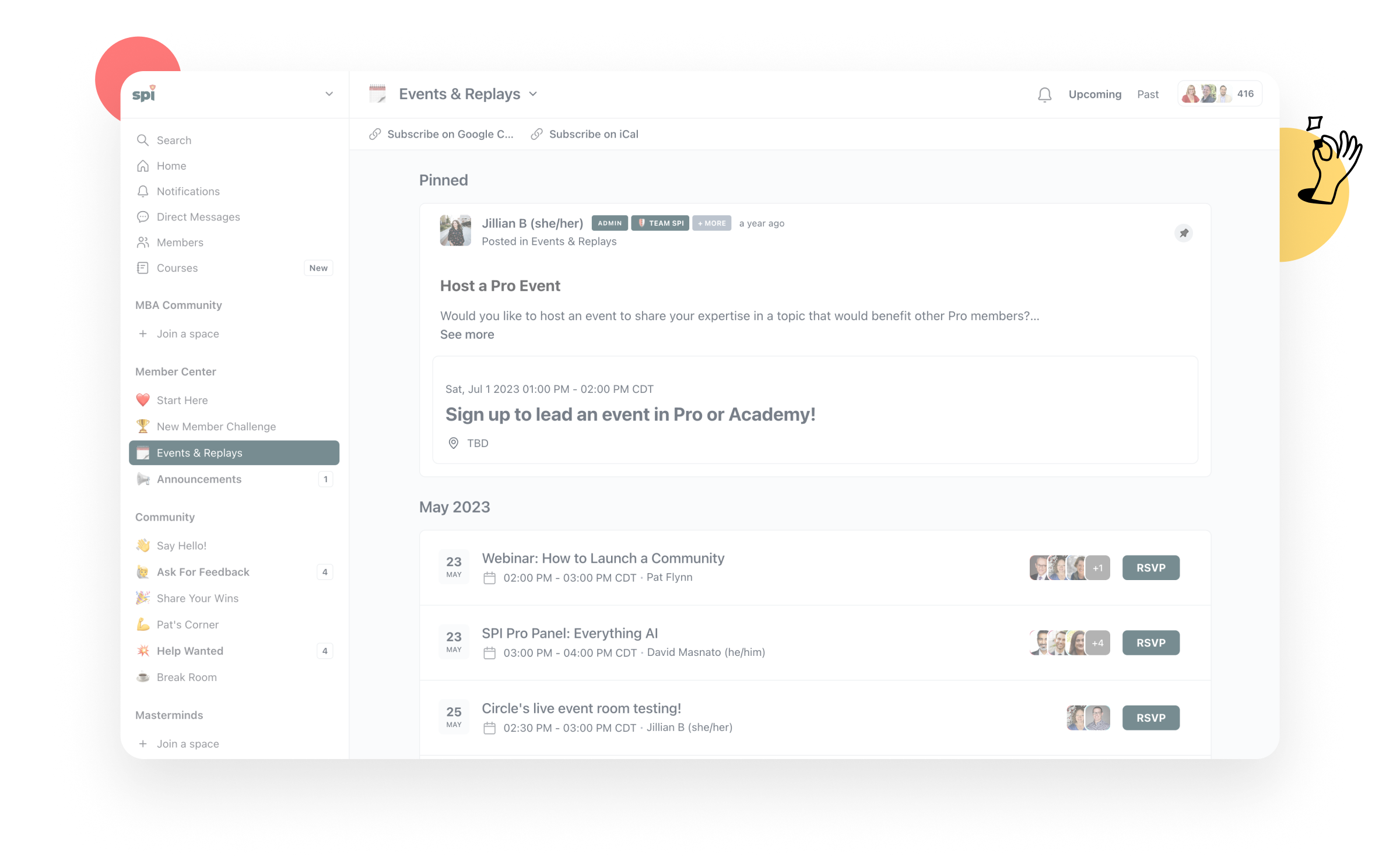
A supportive network of professionals
Watch the video to learn about why SPI Pro is the higher-level solution you need 
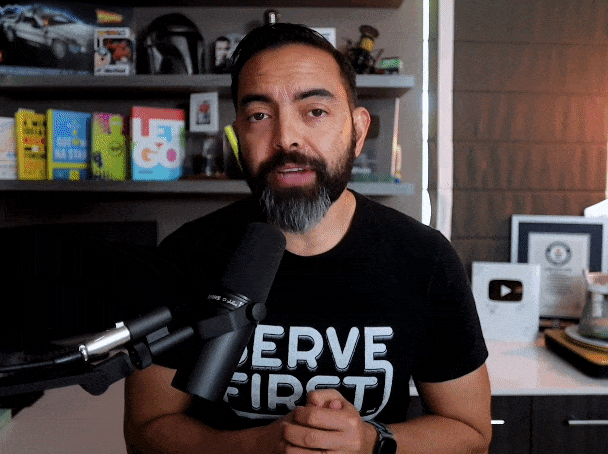
The journey is hard… it doesn’t have to be harder. Don’t do it alone.
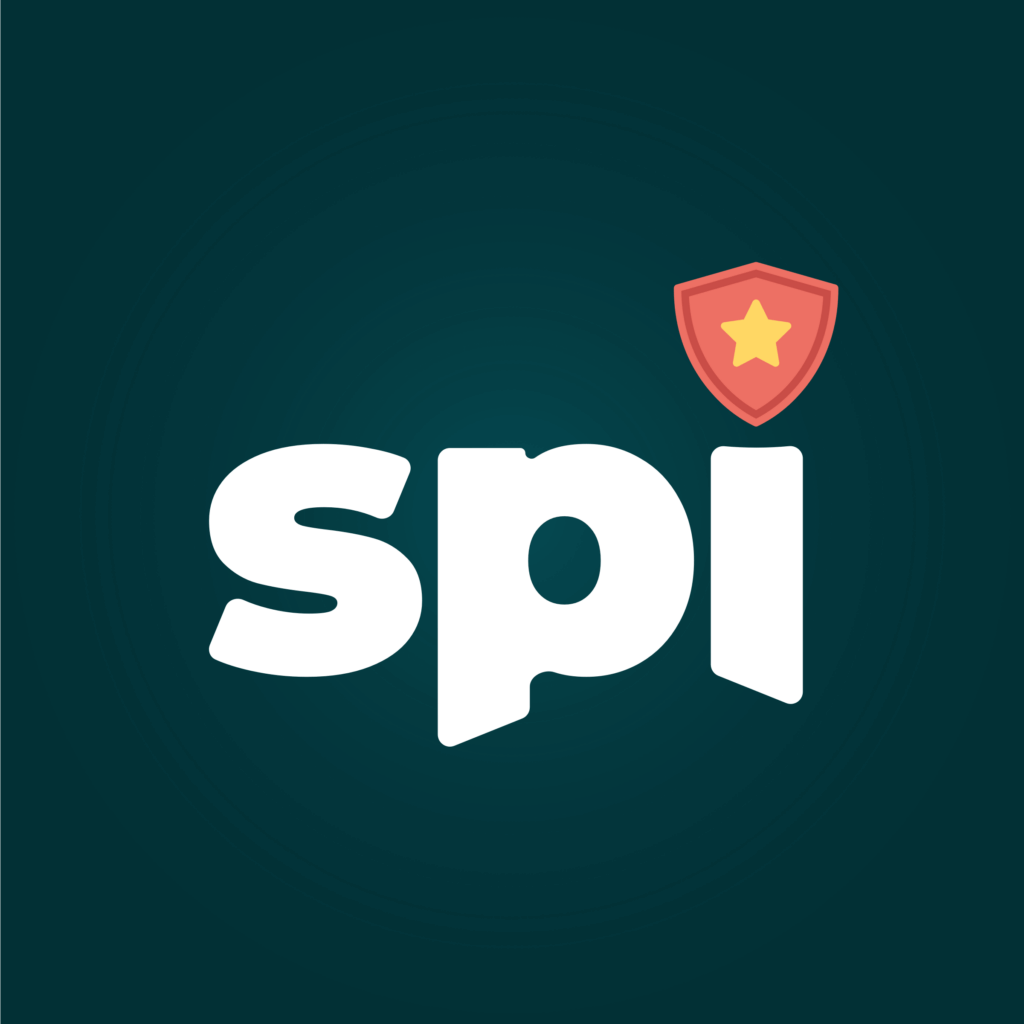
Loneliness. Doubt. Knowledge gaps. Distraction. Overwhelm.
Entrepreneurs battle these struggles every day, leading to unfocused action, wasted resources, poor decision-making, and overwhelm. Without the right support and resources, it's no wonder so many entrepreneurs burn out before achieving their dreams.
This difficult terrain is all part of the entrepreneurial journey, but the probability of success — building a profitable business on your own terms — is dramatically improved when you have a supportive, informed community behind you. When you have a cohort of experts you can lean on. When you have a place to get your questions answered. When you belong to a group of peers going through the same struggle alongside you.
Enter SPI Pro.
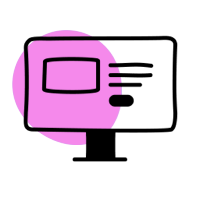
Cutting-edge education
Full access to SPI’s entire library of online courses, as well as accelerators — cohort-based course learning led by members of Team SPI.
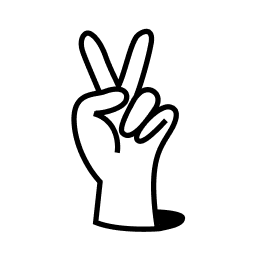
SPI Pro is a membership community for entrepreneurs who are ready to take what they’ve already built and 10, 20, or 100x its success and impact.
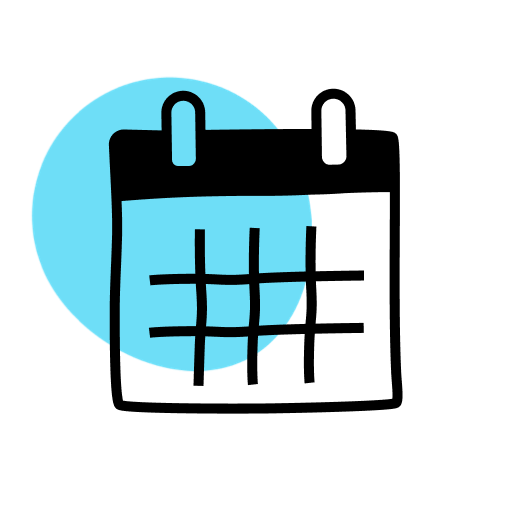
Immersive training
Monthly AMAs, workshops, expert-led events, and other inspiring, live opportunities for enhanced mastery of key skill sets.
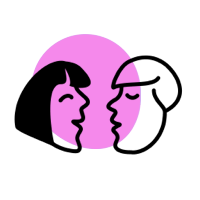
Professional networking
We’re the best community for online entrepreneurs because we have the best people. Our Pros care deeply and are unwaveringly passionate about helping each other succeed.
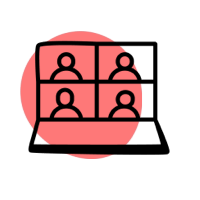
Interactive collaborations
One of the many perks of Pro includes access to masterminds: irreplaceable opportunities for accountability, direct feedback, and support for your next big move.
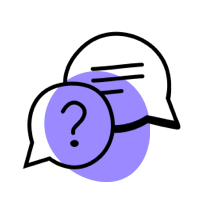
Proven, expert advice
Have questions? Pro has answers. Not only that, our expanding roster of Experts in Residence (see below) offers unparalleled opportunities to get answers from folks who have been in your shoes.
Best-in-class community programming — by design
The experts will see you now
Want some real talk? Our Experts in Residence (EIRs) have you covered. They’ve done the hard work. They’ve learned the ropes. And, lucky for you, they’re your exclusive in-house guides.
When you’re an entrepreneur, you’re responsible for everything. That’s why we’ve built our expert network to cover, well, everything:
Our Experts in Residence network covers the bases so you can focus on what matters most — your business.
Mastermind groups — opportunities for connection that are a cut above the rest
Exclusive only to our Pro community, you can join or even start a mastermind group.
These peer-to-peer mentoring opportunities help members solve their problems with input and advice from a tight-knit group. SPI Pro offers both peer-led and expert-led masterminds. Search for existing groups in the Mastermind Directory or form a new group with entrepreneurs in the Mastermind Connections space. Or, ask our team to hand-match you with the right group to push you forward.
Comprehensive education — access the entire SPI course library
Full access to SPI’s entire course library is included with a Pro membership, a value exceeding $199/quarter.
And we don’t just offer our courses without guidance — included with your Pro membership is the All-Access Pass, SPI’s educational membership community. Inside, you’ll find:
Ready to grow your online business?
Complete the application and we'll reply to your submission within a week.
We would never recommend a tool, product, or resource that we don’t truly believe will benefit you. If you’re not yet ready for Pro, not to worry! The All-Access Pass might be a better fit for the current stage of your business.
Inside SPI Pro
SPI Pro was created to meet the needs of entrepreneurs who want to take their businesses to the next level. We understand those needs because we’ve been there.
SPI Pro is made up of three pillars:

Connect & Grow
Connect with other entrepreneurs who “get it” and are truly invested in supporting each other on the same mission to grow their businesses. Allow our community managers to hand-match you to a mastermind group aligned to push you forward.
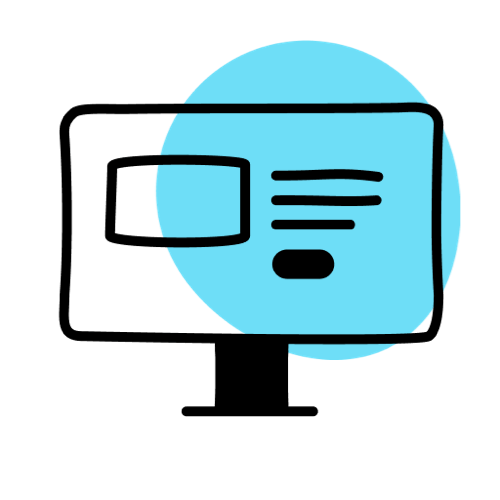
Learning
Access ongoing events exclusive to Pro members that address relevant needs for business growth. SPI's All-Access Pass is also included in your membership, which gives you access to our entire catalog of business courses and workshops.

Team SPI Support
SPI's team of experts are regular participants within Pro, whether it's an Ask Me Anything (AMA) hosted by Pat Flynn, a Social Media Strategy webinar hosted by SPI's Marketing team, or giving advice and answering questions within the community.
A safe place to learn and explore
SPI Pro is a nurturing ecosystem in a professional community void of hate, hype, distractions, tire-kickers, and non-starters. This is where serious entrepreneurs jumpstart their ventures, and it’s where they return time and again to stay sharp, make new discoveries, expand their networks, and elevate their potential.
“The riches are in the niches of the SPI Pro community. My most powerful interactions are definitely within masterminds! SPI did the heavy lifting of bringing the right people together so I could build community around business growth.”

Jette Stubbs
JetteStubbs.com
“The people are what I love most about the community! Everyone is willing to jump in and help and, most importantly, in a nice and caring way. In some other communities I’m a part of, the members talk down to those asking questions. The SPI community is welcoming which promotes more questions and collaboration.”
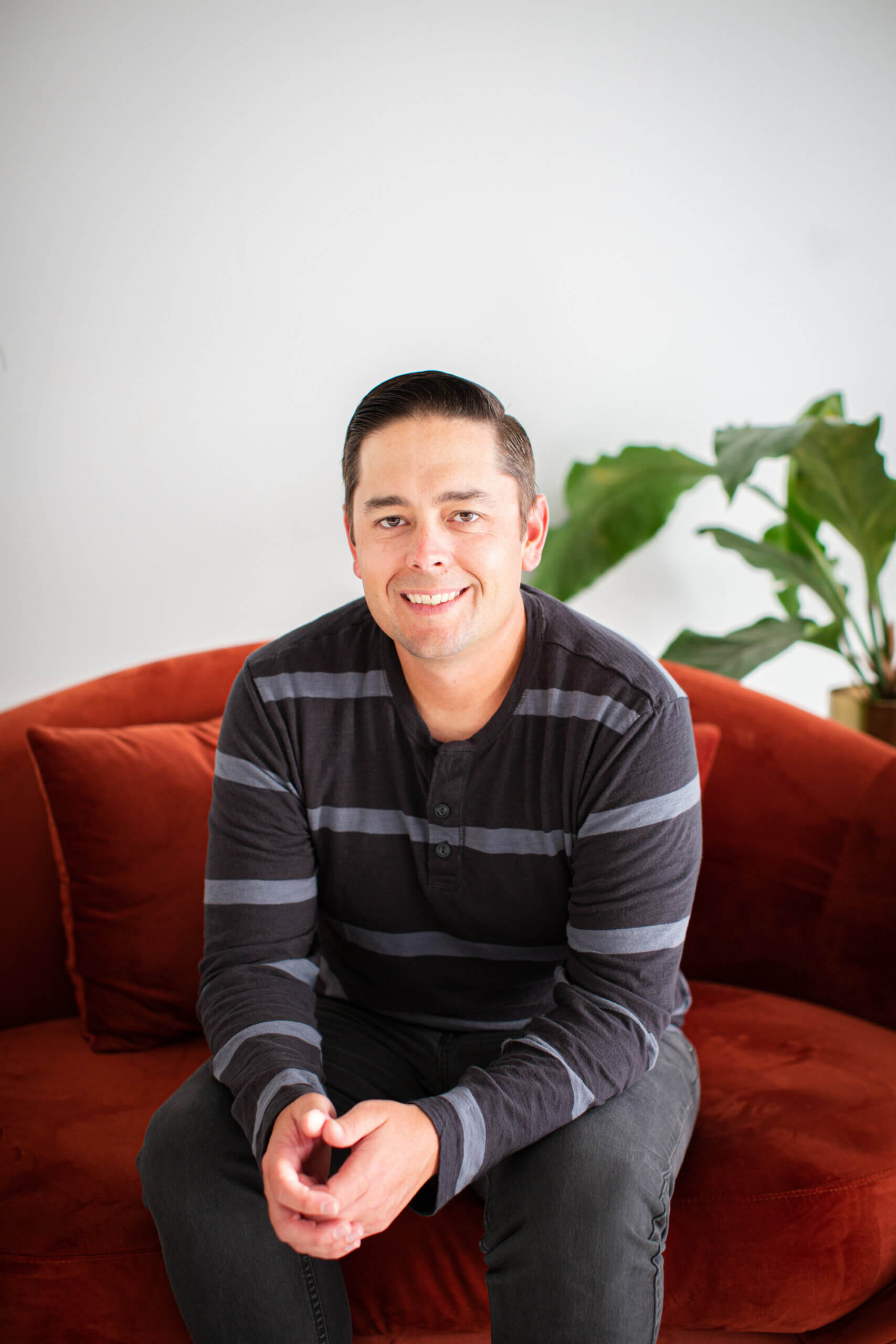
Jeremy Launder
JeremyLaunder.com
“I like the wide variety of businesses that SPI Pro members run and the depth of experience/breadth of knowledge they have on relevant topics. Other communities tend to focus on building a particular skill set, whereas SPI Pro takes a more rounded approach to the world of starting and scaling a business.”
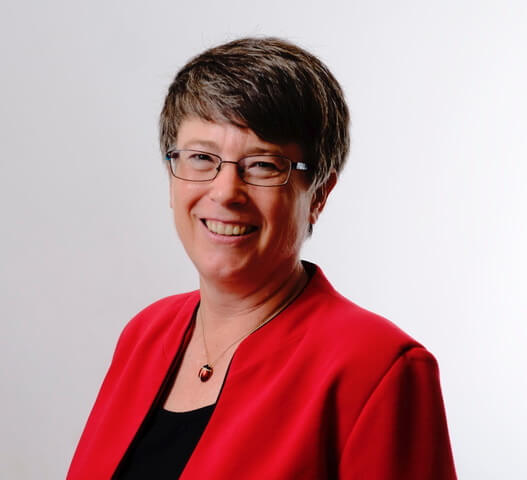
Trudy Rankin
OnlineBusinessLiftoff.com
“I love logging into Pro because I don’t feel like I’m alone anymore. To see so many other people out there working towards the same thing and supporting each other is amazing. And the community administration is amazing — the checking-in, the answers, the connecting — it’s brilliant. I hope that my community has some of the genie in the bottle that Pro has.”
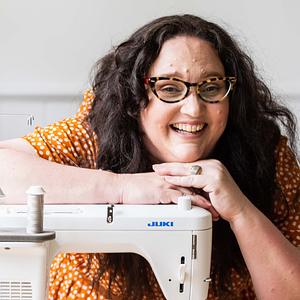
Ange Wilson
GnomeAngel.com
“The community is a really great group of people. I appreciate everything the team has done to create this space for us.”
—Margaret Campbell
Just a few of our incredible Pros (yes, we are bragging) 
Your professional network is waiting for you.
Save 16% with Annual billing


For established entrepreneurs
SPI Pro
$299
/ quarter
$999
/ year
You have an online business that’s up, running, and generating revenue. You’ve figured out a lot but are unsure where to focus next. And the growing pains are real.
Everything in the All-Access Pass community, plus:
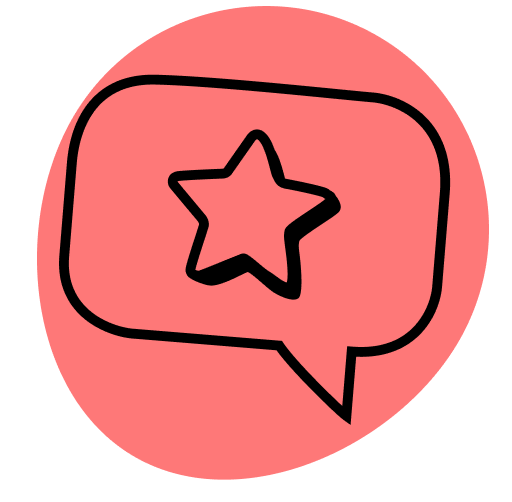
Vetted network of serious pros
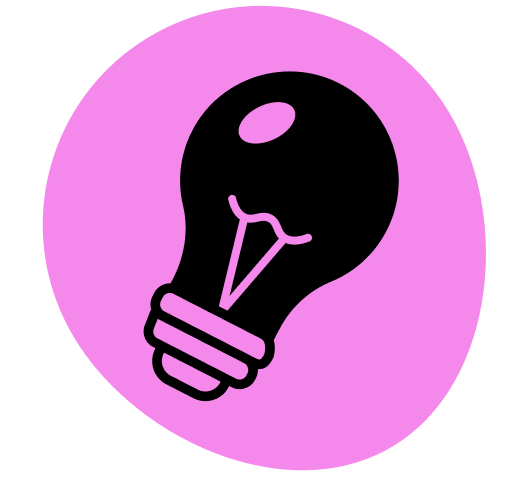
Curated member masterminds

Exclusive access to in-house experts

Strategic guidance & tools
“I love logging into Pro because I don’t feel like I’m alone anymore. To see so many other people out there working towards the same thing and supporting each other is amazing. And the community administration is amazing — the checking-in, the answers, the connecting — it’s brilliant. I hope that my community has some of the genie in the bottle that Pro has.”


Ange Wilson
Ready to take your business to the next level?
Complete the application and we'll reply to your submission within a week.
If you're not ready yet for Pro, the All-Access Pass community may be a great fit.
Important FAQs
That's a lot of information, but if you have questions, here are some important and common ones to know about as you consider applying:
Is there a cost to join SPI Pro?
Yes. Our member pricing is $299/quarter or $999/year (16 percent off — equal to 2 months free). Members can cancel their subscriptions at any time.
Am I obligated to join if I apply and receive an invite?
Nope! Your invite will be valid for a period of time once you receive it. If you don't wish to join, just ignore it. But we ask that you please only apply if you're very serious about it. Our team spends time reviewing each application.
I applied but did not receive an invite. What does that mean?
We send an immediate email confirmation to let you know we've received your application. You will receive a follow-up email indicating whether or not your application was accepted. If you didn’t, please check your Spam folder. Your acceptance email will include the invite and all the information you need to join. If you are not yet ready for Pro, we encourage you to check out the All-Access Pass.
What system is used for SPI Pro?
We did a ton of research on various membership platforms before making our choice. In the end, we selected an exciting up-and-comer in the market*: Circle. Think of Circle as a cross between Slack, Facebook Groups, and LinkedIn — which is to say, it's awesome!
* Circle was an up-and-comer at the time — they’ve now grown to be one of the most widely used and trusted community platforms out there.
How is SPI Pro different from SPI courses such as Power-Up Podcasting®?
SPI Pro is a bonafide private community with interactive discussions, exclusive content and events, direct access to Pat and other members of the SPI team, etc., and requires an application to join. In contrast, our courses like Power-Up Podcasting® are available exclusively through the All-Access Pass.
Will SPI courses ever be incorporated into SPI Pro?
Yes! The All-Access Pass is included with your SPI Pro membership. This gives you access to all of SPI's courses, like Power-Up Podcasting®, and all of our workshops, like Cash Flow Fundamentals.
What is the refund policy for SPI Pro?
We offer a 30-day money-back guarantee. If you are unhappy with your membership for any reason, let us know within the first 30 days of membership and we will refund your payment.
Still have questions? Contact us here.
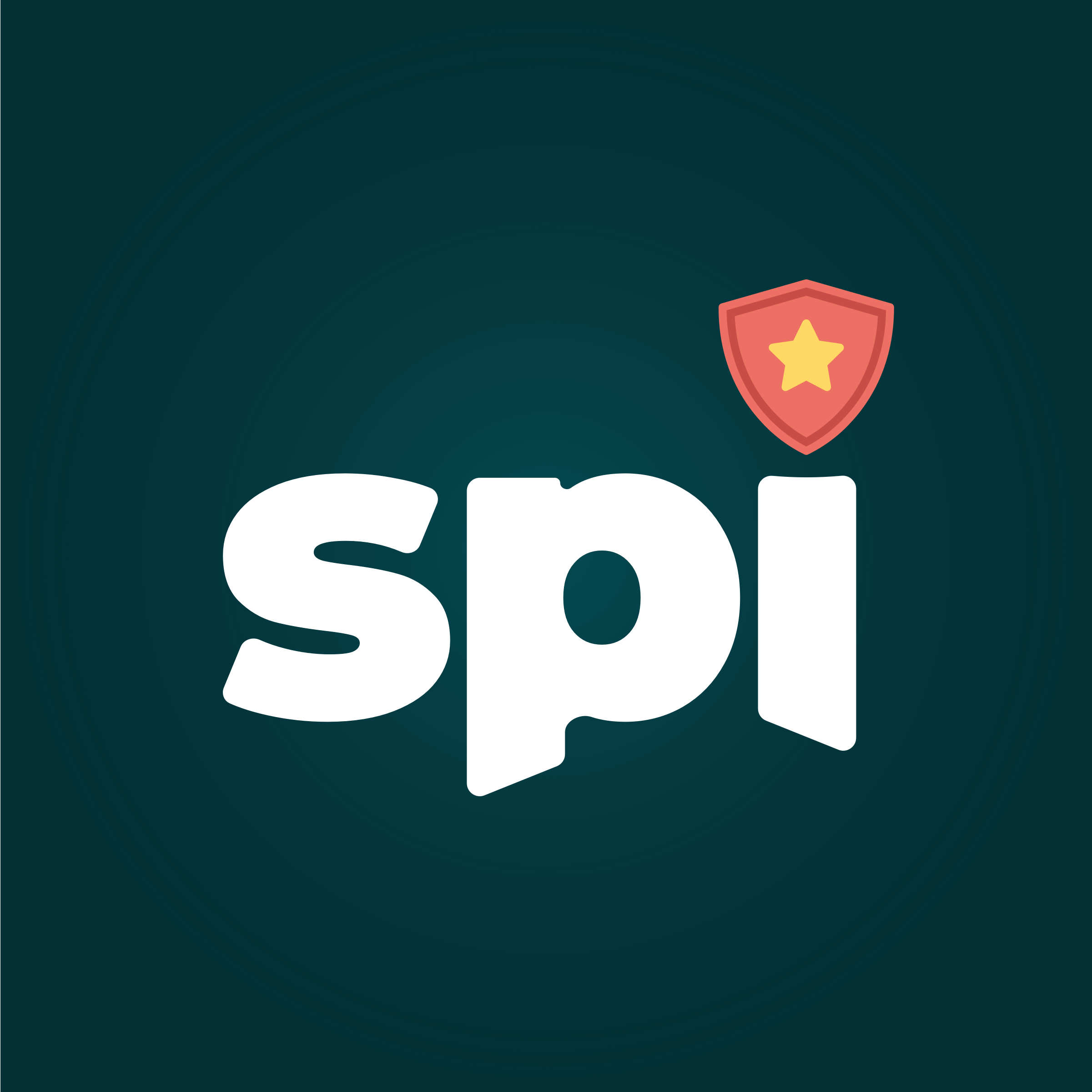
Accelerated growth is on the horizon. Apply now.
Applications are open.
Is your business still in the building phase? Join the All-Access Pass instead.
The post SPI Pro Community appeared first on Smart Passive Income.
]]>How effective is the marketing copy around your products? Many entrepreneurs struggle with this aspect of online business most. And the truth is, there are no shortcuts to great writing. […]
The post SPI 773: How to Write GREAT Copy in Today’s World with Ray Edwards appeared first on Smart Passive Income.
]]>How effective is the marketing copy around your products? Many entrepreneurs struggle with this aspect of online business most. And the truth is, there are no shortcuts to great writing. So, how do we generate compelling stories and sales pages?
There's no one better to answer this question for us than the godfather of modern copywriting himself, Ray Edwards. My interviews with him in previous episodes have always been game-changing, and this one is no different. Don't miss out on this chat, and check out episodes 182 and 327 if you haven't already!
Ray is the author of How to Write Copy That Sells, Permission to Prosper, and Read This or Die. His expertise is priceless, and today, he delivers an absolute masterclass on marketing communication in the age of AI. You'll hear us explore his PASTOR framework to guide you through every step, from positioning your products to making sales and getting incredible testimonials.
Listen in because Ray and I also share the most powerful ways to leverage tools like ChatGPT to take your marketing game to the next level fast. Enjoy!
Today's Guest
Ray Edwards
Ray Edwards is a communications strategist, copywriter, and author of
the Amazon Best-Sellers How to Write Copy That Sells, Permission to Prosper, and Read This or Die. He is also the host of the top-ranked podcast The Ray Edwards Show (it’s been downloaded over 1.5 million times).
Ray has worked on copy and marketing with some of the most powerful voices in leadership and business. Ray’s marketing expertise and persuasive writing has helped generate an estimated $500 million in revenue for clients like New York Times bestselling authors Tony Robbins, Michael Hyatt, Dan Miller, Jeff Goins, Jack Canfield, Mark Victor Hansen, Jeff Walker, and many more. He has been featured on Forbes.com, SocialMediaExaminer.com, and Entrepreneur.com.
- Find out more at RayEdwards.com
- Access Ray's marketing and copywriting coaching
You'll Learn
- Read This or Die, the sales letter that saved Ray
- The story behind Ray's viral TikTok that's changing lives
- The PASTOR framework for writing effective copy
- How to go from a rough draft to a finished sales page
- The questions that lead to incredible testimonials
- Getting more sales without feeling salesy
- How to leverage ChatGPT and stand out in the age of AI
Resources
- Watch Ray's viral TikTok video
- How to Write Copy That Sells by Ray Edwards [Amazon affiliate link]
- Bird by Bird by Anne Lamott [Amazon affiliate link]
- Leverage AI to create write copy that sells with ClarityScribe
- Subscribe to Unstuck — my weekly newsletter on what's working in business right now, delivered free, straight to your inbox
- Connect with Pat on Twitter and Instagram
SPI 773: How to Write GREAT Copy in Today's World with Ray Edwards
Ray Edwards: Even in the offer, don't just say you get eighteen lessons, there's a one-hundred-and-fifty-page workbook because people are not really buying the stuff you're giving them. They're buying the transformation. It should be something more along the lines of, you're going to go from total podcast newbie to actually knowing how to create a podcast your listeners are going to want to listen to, you're going to have their attention, which is the most important asset in this economy.
You're describing the benefits of not what they get with your training, or your book, or your course, or your coaching, you're describing what it does for them.
Pat Flynn: Copywriting and what is working today. That's exactly what we're going to talk about, especially because we're in this world now with AI. And I brought on an expert, the expert Ray Edwards, as we call him sometimes the Godfather of Modern Copywriting, for helping us share our message and help us to serve others more with the words that we choose to put on a sales page or in our emails or in our social posts.
And Ray's going to give us a framework, a framework that he's been on the show before to teach, but it's adjusted a little bit for the time. So we're going to go through his P.A.S.T.O.R. Framework and we talk about each little component of the P.A.S.T.O.R. Framework to help you with your copy and get into the weeds of it.
And this is going to be one of If not the most helpful workshop that you'll probably hear in a very long time here on the podcast with Ray. And we also talk and get some interesting insight from him as a professional copywriter, what it's like in the landscape of AI and how to use AI, not disuse it or just shy away from it, but actually use it to our advantage to create excellent copy, because a lot of us are using AI to generate copy.
But as he calls it, as you'll hear, we are just increasing the speed to mediocrity in our writing. But we need to take a couple more steps to take it to great. So this is session 773 with Ray Edwards from RayEdwards.com. Enjoy.
Announcer: You're listening to the Smart Passive Income Podcast, a proud member of the Entrepreneur Podcast Network, a show that's all about working hard now, so you can sit back and reap the benefits later. And now your host, his toxic trait is thinking he can hit a fastball from a major league pitcher, Pat Flynn.
Pat Flynn: Ray, welcome back to the SPI podcast, man. I'm so happy you're here. Thanks for taking the time today.
Ray Edwards: Thank you. I'm so thrilled to be back.
Pat Flynn: A lot has changed since you've come back on the show. I know things have happened personally, but also in the world of business. I mean, any quick updates on life and how things are going and what you're excited about these days?
Ray Edwards: Well, on life, I had brain surgery. So that was a big deal.
Yeah. Many people probably know I have, or maybe not. I have Parkinson's disease. And I had brain surgery, which turned the clock back about eight years on that. And I'm able to do things I couldn't do for the last seven or eight years. So that's exciting. I'm very excited about that. I'm excited about where technology is taking us.
AI played a part in my brain surgery. The device that helps stimulate my neurons is governed by AI.
Pat Flynn: Wow. That's actually really amazing because a lot of us hear about AI and in our industry, it's pretty scary and also exciting, but I think a lot of us forget about the actual life changing things that can happen with this technology.
And I was at social media marketing world in 2023, and I saw you give an incredible presentation on stage and not only did you give an incredible presentation, but you literally jumped off the stage in excitement, which wasn't even a thing you could even think about doing prior to your surgery.
Ray Edwards: That's exactly right. I think I, I know I panicked my assistant. She was, she had no idea I was going to do that, but it was, I was so overjoyed to be there to be serving people. Oh, it would have been more clear. on what I'm doing and why I'm doing it and what, why the things we all do in our businesses and our lives are important. And I don't, I don't want to take any of it for granted. I don't want other people to do that either.
Pat Flynn: Ray, you had mentioned on stage during that talk, you know, before we get into the tactics and strategies of, of copy about a letter. Can you tell us about this letter and the significance of it and the lessons we can learn from, from such an exercise?
Ray Edwards: Yeah, I wrote a letter to myself. I, as a copywriter, I've written lots of sales letters, designed and written and crafted to get people to do something, to get them to buy something, believe something, take some action. And I reached a point that the progression of my disease had gotten to a place where I was almost completely disabled and I was in lots of pain, physically and psychologically, and I actually considered not being on the planet anymore, taking an exit.
And I realized that was unacceptable that might have alleviated my pain, but it would have caused other people so much pain. I could not contemplate doing such a thing so I wrote myself a letter a sales letter to myself to demonstrate why I needed to change my life and my thinking and why I must do it and the headline of that letter was read this or die. And I borrowed that headline from the work of a dear friend of mine who's passed on now.
His name was Jim Rutz, one of the greatest copywriters who ever lived. He wrote a piece called Read This or Die. It was about a health newsletter. So my subject matter was different, but the point of the letter was the same. I was writing to me to get me to change my life. And I wrote it in a very blunt and very forceful way.
You might think that the headline itself sounds a little rough, but I know me, I knew what kind of talk I needed to hear for myself to get me to change the elements of my life that needed to change, which was basically everything. My relationships, the way I eat, the way I exercised or didn't exercise, the way I thought about things.
I had reached a point where I was out of get out of jail free cards and I had to realize there were more days behind me than there are ahead of me. Even in the most optimistic way of looking at things, I had to change or I was going to leave behind a string of broken promises to people I cared about.
I couldn't do that. So I wrote that letter and I did the things that I told myself I had to do and it changed my life and it ultimately led me to making the decision to get the surgery I had. And that was scary. It was the scariest thing I've ever done, to go in to have brain surgery. Because, think about it, I mean, your brain is who you are.
And I was going to let people inside there, and there was no predicting exactly what the outcome would be. We hoped it would be good, and it was fantastic. And had I not been through the writing of that book, and publishing the book, I don't think I would have been able to develop the courage to go ahead.
Pat Flynn: Wow. And the book Read This Or Die is available and you can go check it out and we'll link to it in the show notes. And since you have had that surgery, I remember you had documented some of the results of the surgery on your TikTok and your social media platforms. And some of those posts went absolutely wild.
I mean, can you give us a sense of how far reaching those posts had been and what happened since then are there opportunities that came about as a result of sharing?
Ray Edwards: Yeah, absolutely It was it was crazy and kooky because the book is a weird book the publisher was like this is the oddest book we've ever published because it was about how I used my copywriting framework the P.A.S.T.O.R. copywriting framework to write the letter to myself that leveraged me to change and make a decision like having the brain surgery So I, I did that, I went through the surgery and the video that posted on TikTok was shot on my wife's old iPhone 8 and I just clipped it together.
This goes to show I've spent thousands of dollars creating videos with a team and editors and the one I put together for my wife's iPhone on the spur of the moment after I left the doctor's office is the one that went viral. We had over a million views. Almost instantaneously. And it was a before and after.
It was me going into the clinic. I was barely able to walk. I could not get myself to go through the door. If you have Parkinson's, you often have freezing where you, you, in confined spaces or stressful situations, just freeze up. So I froze in the doorway going into the clinic. And I went in, I sat down, in the video I'm sitting, I'm vibrating like, like I'm on a bucking bronco. And the doctor turns on the neurostimulators that have been installed into my brain in surgery a month before that. He switches them on and instantly I stopped tremoring. I stand, he says, can you stand up? I not only stood up, I jumped up out of the chair and walked out of the room. And he's like, Whoa, hang on.
So the, his staff was amazed. The doctor was amazed. And then because of that video going viral, I was contacted by Boston Scientific. Who made the equipment that's been implanted inside my body. And they said, Hey, it seems like, you know, a little something about marketing, your video went viral. Can we talk to you about what we might do to get the word around about this surgery?
Cause so many people don't know about it. It's not experimental. It's proven it's been around for 30 years, but we'd like to get more people to consider having the procedure. And I'm like, I will, I'm already doing it. I've, I've talked to. Probably two dozen people as a result of that video who just contacted me out of the blue to say, I have my father or my grandfather or my husband or my wife has Parkinson's.
So I've talked to many people on the phone about the things that you consider and why they should go consider having the procedure. And I've talked to about 10 of those people so far who went and had the surgery and had similar results to me. And it's been the most gratifying thing I've ever done online.
To be able to see people's lives transformed by something like that procedure.
Pat Flynn: That is incredible. Ray, I want to talk to you. And we have spoken in our mastermind group for a very long time about your progress with that and where it could potentially even go, but that might be a great transition for us because a lot of the audience wants to change the lives of our members, our students and our customers, yet we don't know how to get the message from our brain or what we know can help out there into the world so that they can see it and they can understand what we have to offer them that they see the value and what it is we have to give.
Copy is the way to do that, but copy is scary. Copy is an art and it's something that you have mastered. And I'd love to dig into how we, those of us just starting out with copy can wrap our head around it. And you'd mentioned. Earlier, the P.A.S.T.O.R. model, and that is a model that you've come on the show to share before.
Perhaps a quick little overview of that would be great to start out with, and we can kind of dig into that a little bit, if, if indeed that is still the framework that is recommended today for, for how to get that message out there.
Ray Edwards: Yes, it is. And I'll go over that quickly. And then I'll have a few things to say about the context that we're in today, because it's the times have changed.
There's some things that are different. The human nervous system is not different. The way we are persuaded is not different, but the environmental changes we need to talk about. Let's go over the P.A.S.T.O.R. framework first. This is a framework, not just for writing sales copy. It's for influencing people to take any direction, making a decision.
If you're writing a blog post or you're trying to talk your wife into where you want to go have dinner, you can, you can use this framework. So P.A.S.T.O.R. P stands for person, problem, and pain. Those are the first three things you need to know everything about them you can. The person to whom you're writing, the problem you help them solve with your product or service, and the pain they feel in the way that they feel it.
And that's very important because we often think they should feel pain because of one thing, when the pain they feel is different. So, we find ourselves needing to understand how they feel it, like, if somebody wants to lose weight, lose fat off their body, we might think, if we're the expert, you need to do that because it's good for your cardiovascular health, it's good for your blood sugar levels, it prevents diabetes, it may help you avoid things like Alzheimer's or dementia.
But what they're thinking about is, the pain, the way they experience it is, I want to look good in a bathing suit. And we might think that's kind of shallow, or not, we might make a judgment about that. But we need to address the pain they're feeling, the way they're feeling it, and then we can help them understand why there's a deeper need for them to make the change we're seeking to get them to make.
So it's a case of selling to them based on what they want, but making sure they also get what they need. A is amplifying their pain and speaking to their aspirations.
And here's a shift I've made that I think is because of the shift we've seen in society since the unpleasant events of 2020 took place. That is, I'm putting more and more focus on the aspirations and less on amplifying pain. So I don't mean you shouldn't amplify the pain of not acting, not solving the problem.
So if the problem is I'm trying to quit vaping and I know it's not healthy, there is a place for us to amplify the consequences of not stopping vaping. The damage that can be done to your lungs, the bad things that can happen to you if you continue that habit over the long haul. But I don't spend as much time on that as I used to.
I focus more on the aspiration. The aspiration is, when you quit vaping, you're going to have more energy, you're going to have more cardiovascular health, you're going to be able to breathe deeper, you're going to stop. You're not going to be endangering your lungs. You're going to be living a healthier lifestyle, getting more oxygen to your brain.
There's all these good things it does for you. You're going to be able to live a life where you're healthier, feel younger, and you're able to do more for longer periods of time.
Pat Flynn: It's really interesting because for a while it felt like amplifying the fear, in fact, was what was going to work more. But can you speak to maybe why you made that transition to focusing more on aspiration?
I would rather focus on the positive. However, I know that people act because of what they're afraid of. However, that might be changing because I mean, this is just a hypothesis, but there's so much negativity in the world at this point. It almost all gets mixed in that we're looking for the small moments of joy.
Is that, is that true? Or do you, can you speak to that?
Ray Edwards: I think that is true. Now I mentioned earlier, the human nervous system doesn't change when we know through basic neurophysiology that we're wired, we're hardwired to avoid pain and to seek pleasure. However, that doesn't change. However, we've become so oversensitized to negative fear mongering and anger generating ideas and rhetoric that we now, we're turned off by it in a way we didn't used to be, we actually have the ability to turn off the pain signals and focus on something else. That's not new. That's why we eat chocolate cake in abundance when we shouldn't. Because it feels so good. However, what we've learned is that through all the negative stuff that's happened, we've become more sensitive to that.
And we all are seeking a more positive way of living and perceiving the world. And the little psychological trick, if you will, is this, aspiration contains within itself pain. Because if you aspire to something, why is it you aspire to it? You don't have it. So, when we speak to aspirations, we're focusing on the positive, but we want to focus on the positive in such a way that it makes it clear that the person reading our copy or watching our video realizes, well, I'm not experiencing that now.
That's not what's going on in my life now. I want that. So they're, they're experiencing the discomfort they want to move away from, which is, I want to stop vaping. I want to stop eating too much sugar. I want to be more fit. I want to have more financial resources. And they move toward their aspiration and away from the pain.
So it's the same maneuver with a different emphasis.
Pat Flynn: Yeah, that's a, that's a great nuance. It's as if like we're, if we're trying to help a person understand that a podcast is worth worth doing, it's not, Hey, if you don't have a podcast, you're going to be left behind, you're going to not get customers and your competitors are going to be much further ahead.
It's rather, you could be a celebrity in the space that you're in, and your audience can build a strong relationship with you by listening to your voice all from the comfort of your own home. And that makes a person go, wait, I don't have that right now. There's a, there's a delta between me and that status, the positive status that was shared.
Therefore, I want that, or you have my attention at least at this point, which is, as I know, the first part of this framework is, is we need to grab attention, right? And we can get more nuanced with the headlines and those things in a minute, but let's continue on with the model. So thank you for that deeper analysis of amplify and aspirations.
What comes next? The S, right?
Ray Edwards: The S, yes, is the story of your struggle, the solution and the systemization of the solution. So for many of us, there is a story about how we personally struggled with creating our podcast or building our online business or beginning to invest. And we went through a struggle and we maybe even had some failures and then we developed a solution.
And not only did the solution work for us, We found out we can help other people solve that same problem. And we developed a system because people not only want to know that you know how to solve the problem and that you solved it for other people, they want to know you can solve it for them and that they can achieve the same kinds of things you did.
If they do what you did in your own solution, that's the value of the system. So the story about how you struggle I think is important because it lets people know you're not some ivory tower guru saying, look, I'm perfect. You can be perfectly like me. You're saying I'm a human being. I understand how hard it is.
I've been through the struggle. I lost my job. I, I had business problems. I had relationship problems. I solved those problems, and here's the story of how to do it. And the story doesn't have to be long, it can be a couple of sentences, but it needs to be real and raw and true. And people sense, can sense the truth of these stories, but I think they're important to allowing them to relate to your, to your story, situation, your solution that you have in your product.
Pat Flynn: How do you tell the story well, right. We could easily say, Oh yeah, we went through this too, but is, is there a way to finesse that story or choose the right words to really make a connection? How, how does one go about choosing the right words? I guess, let's get a little into the, to the details now.
Ray Edwards: And a bit, I want to talk about AI, but for right now, I'm just going to pretend AI doesn't exist. Okay. I think the, the best way to tell a story, it's with meaningful specifics. So it's tempting to want to do what one of my colleagues, John Carlton, likes to call throat clearing copy, where you're just talking to get started.
You're like warming up. It's like clearing your throat before you do a speech. But you want to jump in with the details. Like on March 12th, 2013, I decided I was never going to be in want of money again. I was never going to be unable to pay my bills again. And so I made myself a promise. I was going to read every book on finances I could find.
I was going to find the answer to how to not only pay my bills, but amass a savings account and investments. So I had money earning money for me. And that's what I did. Here's the story of how it happened. So it's a meaningful specific in time and place and an event that happened. There's a, there's a maxim in writing that says, show, don't tell.
Because when you tell, you just talk about it in a passive, like, removed from the action sort of way. When you show it, people can picture you on March 12th, on that date, you sat down with books and a notepad and pen and started writing out your plan. So, keeping it brief, but keeping it narrative. Stories have a beginning, middle, and end.
Donald Miller, a mutual friend of both of ours, has a book called Building a Story Brand. And he gives a great definition of a story. And the story is, there's a hero who has a problem, faces a challenge, a guru or guide appears, offers him a path, he follows the path or she follows the path to either success or failure.
And we're, we're showing them the path to success, of course, but that's the shortest definition of the story I know. It's one of the best definitions I know, but details and careful crafting of the words are important. There's no fast track to great writing, but there is a quick path to writing a pretty good story.
And that's it.
Pat Flynn: Putting the words on paper or typing them out can feel very heavy. You know, as somebody who's written books and is in the middle of my fourth is, there's like always doubt that comes into, well, I don't know if that's the right word or, you know, maybe there's a better way to do this, or this doesn't sound good.
And, you know, the traditional, you know, we don't do this anymore, but you roll up the paper and you throw it into the bin and then the pile just gets bigger and bigger and bigger and bigger. Might you have any, strategies and tips for, I guess that's called writer's block, but you know, just that slog that we have to go through when we begin putting words to sales page, if you will.
Ray Edwards: I think the, the key is to get your inner editor to sit down and shut up while you're writing and just get that first draft out on paper or on the screen for your keyboard. There's a book by Anne Lamott called Bird by Bird, which is a great book. If you're aspiring to write better stories I recommend that book.
She refers to, you gotta be okay with writing, we'll call it, poopy first drafts. That's not what she said exactly, but something like that. We call it, in my company, we refer to it as, this is equally as gross. We call it the vomit draft. Just vomit it out onto the page. You know it's bad. It's okay. Get the bad draft out on the page.
Because you can always clean it up. But it's very hard to clean up a blank page. So, getting it out the first time, and then refining it, and being okay with rewriting it over and over again, especially the story part of your sales copy, is important because every word is important. And you want to craft it carefully, but Stephen King says, writing is rewriting.
And as Stephen King has to rewrite, so do you.
Pat Flynn: I love that. And a person I got to know quite well recently, Rory Vaden, said it in a different way, but it really stuck with me. And it was like, you gotta show you're ugly. Like, you just gotta show you're ugly first. And I love that. It just stuck with me. And it's also a little gross when you think about it, but it's true.
Okay, that's really helpful. And so I appreciate that. And the story, with a little bit of struggle, relatable, and then the systemization of a story. Solution. Is this at the point at which we're like, and this is how it's done. And this is my program. And this is where this solution exists,
Ray Edwards: Right. If you think about it, you've done this. I'm sure you're conscious of this with your podcasting course, your other courses, where you show people how to do things you've done, and you've been very personable in sharing your struggles in the beginning, as you learned. How to do it the right way. And that's what's powerful and gets people engaged in the idea of learning from us or working with us.
And then the T in P.A.S.T.O.R. Is for transformation and testimony. So here's where you're showing the transformation in your life and in the lives of your customers, your clients, how they change their lives by doing the thing you teach them how to do, or by taking your advice or following your system and the testimony is. It's them telling those stories in their own words. about how they found your instruction, how they found your course to be helpful to them, how they were able to change their own circumstances. Because there's a, there's an ancient book of wisdom that says, don't praise yourself, but let the list of others praise you and you'll be elevated.
This is what having other people give their testimony about how your stuff has worked for them does for you. We all tend to believe what comes from the lips of others about a person more than we believe what the person says about themselves.
Pat Flynn: Yeah, I mean, amen to that for sure. I mean, how often do we look at Amazon reviews before we purchase something?
It's the same kind of thing. We want validation that, okay, other people have done this too. I don't want to be the first, but that begs the question, what if you don't have any customers or students yet? It's the first time you're selling something, does that mean testimonials don't exist yet? What do you do in that situation?
Ray Edwards: I don't think you're, you're stuck at all in that situation because the presumption I have is if you're going to be teaching something, you've, you've helped other people with it before, even before you made a course or wrote a book, or had a coaching program you've helped people in your life. And so I just was talking with someone in our mastermind group about this yesterday. And she said I don't have any customers yet.
And I said, do you have people you've helped? She said well just with advice over the years. How many people are and she said probably a dozen and I said, well, there you go Just call those people and say do you remember when we worked together? Do you remember what that was like when I helped solve that problem?
Yes. Yes. What happened after that? Get them to tell you the story, get them reinvested in what happened, and then ask them is it okay if I summarize that and maybe use that to help people understand how I can help them with this problem. Almost always the answer will be yes. You get them to either write it out or you transcribe it and edit it and write it out for them, get their approval.
Now you've got a testimonial that's real, that's true. You don't say they bought something from you. You don't ever tell a lie. You simply say, these are some comments from people I've helped with this problem in the past, and this is what they have to say. It's as simple as that. And if you haven't helped people, go help them.
Go help some people.
Pat Flynn: That's so perfect. I mean, and I've shared this on the podcast before. It's like, go get one result, like the changes, everything. And you don't even need a website or a product yet to just help somebody that can then be used and utilized and showcased later.
I'm curious, Ray, your thoughts on, well, what makes a great testimonial? Because the generic Ray was amazing. I highly recommend this to everybody is what we're going to get. Typically when we just say, Hey, can you leave me a testimonial? How do we. A, what is a great testimonial look like, and how do we honestly have another person on the other end, a student or a person who we've once helped before, how do we get them to say those things?
We don't put words in their mouth, but there are, I assume, questions we can ask to set that up.
Ray Edwards: I would ask questions like, describe to me what your life was like in relation to this experience. Problem you're trying to solve. Like before you knew how to make a podcast, what was it like before that? Then how did you find out about my podcasting course?
And then what were any fears or hesitations you had before you signed up? And let them answer those questions. Then ask them, well, after you signed up, what was the experience of going through the course? Like, what'd you discover along the way? And then afterwards, what's it like now? And what you'll get is something like this.
It'll be some kind of edited together response to them saying, well, before I found Pat's podcasting course, I wanted to have a podcast, but I thought it's impossible. I don't know technology. I don't know anything about audio. I don't think I could sit and talk for an hour. I know how to do any of that stuff.
I found Pat's program. I was a little hesitant. I thought this is quite a bit of money for me to invest. I don't know if it'll work, but I trust Pat. He's got a guarantee. I'm going to, I'm going to give it a shot. I'm so glad I did. The course was fun. It was informative. It was in bite size, easy to understand bites.
And I didn't have to be a techno wizard. He had answers to all my questions. I put my podcast together. I published my first three episodes. I actually got people listening to the podcast now. I'm so glad I did this. This is where I'm getting all the new leads for my new business. So that's a podcast. It's not the typical.
It was amazing. Pat's the greatest. I mean you are the greatest but for your testimonials, you want more detail than that.
Pat Flynn: And don't worry, audience, I'm not, even though that was a perfect testimony, I'm not going to clip that and use that because it was just an example.
Ray Edwards: It's all true.
Pat Flynn: Ray said it, not out of nowhere.
I'm, I'm going to, I appreciate you, man. That's, that's really, first of all, kind, but also really, really helpful. And I really love those questions. I definitely want to encourage the audience to head over to the show notes page. We'll have the resources and we'll share some of these things so that you can kind of easily digest them.
Ray, let's continue on because there's still some letters left that we need to uncover. AI as well, which I'm also curious from my perspective, speaking to a copywriter and with the noise out there about AI replacing copywriting. And I'm curious your thoughts on that, but we'll get to that in a minute.
But for right now, let's talk about the next letters. So T O R.
Ray Edwards: So T is transformation and testimony. O is the offer. This is where you tell people, this is what I have for sale. This is what you get, how it helps you, and what it costs. And even in the offer, one thing you want to be careful of is don't just say you get 18 lessons and they're 20 minutes long each and there's a 150 page instruction manual or workbook because people are not really buying the stuff you're giving them.
They're buying the transformation you bring about. So, it should be something more along the lines of in this five module course, you're going to go from total podcast newbie to actually knowing how to create a podcast, you're going to want to listen to, they're going to eagerly anticipate each episode.
They're going to listen. They're going to comment. They're going to respond. They're going to engage. You're going to have their attention, which is the most important asset in this economy you could possibly get is the attention of other people. So even as you're giving them the details of the offer you're describing the benefits of not what's what they get with your training or your book or your course or your coaching you're describing what it does for them. That's what's so important.
Pat Flynn: Before we move on, Ray, there was a good analogy I, I once saw, and, and we teach this in our heroic online courses course, because we, we talk a little bit about sales pages and, and writing copy.
And you're so right. The transformation is what you're selling. People don't want to buy the course. They want to buy what ultimately the course can give them. And sharing that in the sales page has been so important. And there's a good analogy of your student is like, okay, Mario, like the original Mario game, 1985, right?
And let's say that you have a company that sells Mario's, these little power ups, right? That can make them grow bigger and, you know, shoot fire and stuff, right? What you're selling is not the flower, right? Oh, this is a flower. It makes you shoot fire and all this kind of stuff like that's that's the feature.
The benefit is this will allow you to go through the level much faster and kill any enemies without any worry. And then the ultimate dream is you'll get to rescue the princess at the end, right? And reminding them about that sort of bigger reason why this is important. And you just said it in the framework perfectly.
So, I mean, that doesn't mean we don't talk about, how many videos there are or what the lessons and modules are, right? We still, we still bring that up, but do you follow that up with, you know, module one, how to get your equipment for your podcast so that you'll sound better than everybody else in your space?
Like, is that so that like a good framework for bringing the benefit in?
Ray Edwards: So that is one of the things we actually teach in our copywriting course, because and not only gives the reason why you want to do the thing you're talking about, it gives the benefit. So you, you definitely want to talk about the modules, the workbooks, all the assets you have, they're going to help them. And you want to talk about the benefits and why they're important. That's all true. Very well said.
Pat Flynn: What I found is interesting when, when going through that exercise with some students, Ray is like, when we go, okay, well here you've shared the features of your course.
That's great. But can you write the benefit of each particular module and lesson and why it should, why it exists? And it's funny because almost every time there's a couple lessons in there that they just don't have a read, like there's no benefit. And then I go, well, then why is this in the course? And they go, well, I don't know.
Should we take it out? Yeah. Why is it like, yes.
Ray Edwards: If you have to ask the question when I was in the course, take it out for sure.
Pat Flynn: So that's a, that's a great exercise. I appreciate that. So that's the offer. And then R is for what?
Ray Edwards: Request a response, ask them to buy in the real world of selling. The number one reason salespeople don't get the sales because they don't ask for it.
It's the same thing online. If you're selling a product or a coaching program or whatever. If you believe it's really going to help people, you owe it to them to tell them with conviction why that's true, what they're going to get, and how they get it. You don't have to be salesy or pushy, you just have to be direct and clear.
So click on the button, fill in the info, And you'll be in the members area five minutes from now, ready to start your course or your training or whatever.
Pat Flynn: So when a person is maybe selling something for the first time, I know there are often a lot of icky feelings, right? The worry that you might upset your audience because you're now monetizing them as we say, or it's just, it feels slimy because you have to, you know, now there's money involved and there are tactics that are great to use.
It's like creating urgency and, you know, webinars and, you know, but it all sounds so, so slimy for people. How do we, in our mind, approach selling in a way that allows us to understand that this is actually a good thing? Like, it can be done in a, in a way with grace, but Still, with that ask, if you go through the entire P.A.S.T.O.R. framework, but you don't request that sale or the call to action at the end is missing, then it's all for nothing.
And this is the most important part of this to finish it off. Yeah, this is where we go. Okay, well, let's just hope that they'll click the button because I said everything else before this. How do you ask?
Ray Edwards: It has to come from a place of real belief on your part that you have an answer that will help the person who's considering making the purchase.
And you know that it'll help them. You more than likely have a money back guarantee, so you know they're not risking anything. And being able to look into their eyes and say, look, I want to help you. I can help you. If it doesn't work, I'll give you your money back. So you have nothing to lose. Let's go ahead and get started.
Let's do this and make it work for you. And if you can say that and mean it, it may feel a bit uncomfortable, but when you begin seeing people's lives transformed, I'm sure you can attest to this, Pat, when you start getting the feedback from people saying this changed my life, changed my business, helped my family have more time together, whatever the case may be for the transformation of that particular person, It really makes you understand what you're doing is important and meaningful.
And you don't have to be salesy to do that. You just have to believe. Zig Ziglar said that selling is really merely a transfer of enthusiasm. That doesn't sound pushy to me.
Pat Flynn: That's great. And you're not the first person to come on to say that is this. I mean, Michael Hyatt has come on here. Chalene Johnson has come on and have each said similar things that when you know that what you have to offer is helpful the selling just becomes so much easier. That's where I think a lot of the slimy feeling comes from is, is the lack of confidence in what you have to offer. And guess what? If you work a little bit upfront to get some results for people, that sliminess, that sense of, well, I don't know if this is actually going to help people goes away almost instantly.
And I remember a time when I started selling the podcasting course, Power Up Podcasting, And I saw the results come in from people. That it was a weight lifted off my shoulder in terms of putting myself out there. I mean, I scheduled like six months worth of webinars right after that because I was like, let's go.
This is working. So get to that point of clarification in your mind. And if you have to go out and get some results first, like, do that. It's similar to, I think it was Ben Franklin who said, like, if you don't have a good story to tell, like, go make the story happen. That's probably not the exact quote, but I love this.
Ray, you're simplifying a lot of things. of marketing and sales for us today. And the P.A.S.T.O.R. Framework is indeed the way that you would kind of craft a message on a sales page, is it not? Like it starts with the person and the problem and the, in the pain, and it goes through the rest of the, like, this is a sales page that we've built out essentially, right?
Ray Edwards: Yes, absolutely correct. And it can also be an email or a blog post, but in the simplest expression of why I created it. It was to help people write sales pages and take away. You can get very deep into the details. This there's lots of nuance. There's lots of expertise and things to learn, but for most of us, we're trying to sell a product that solves one particular distinct problem.
This is an easy and simple way to write a persuasive, it'll sell your product or service, and you can do it without feeling like you're being a pushy salesperson.
Pat Flynn: Let's progress into a conversation about AI. When ChatGPT came out a couple years ago, what were your initial thoughts as a copywriter on what this was going to do for the industry?
Ray Edwards: I've been through some cycles. I started with skepticism. Then I was, I had my oh crap moment. Where it was like, Oh, this is actually pretty good. And it's gotten better. What, what I held to from the beginning and hold to even more closely today is first of all, it's amazing. AI is amazing. It's already enabled us to do amazing things that are beneficial to people, to organizations and to the planet.
I've personally benefited from it. As I said, said earlier about my surgery. That's only going to get better. They're, they're doing research now with AI technologies that are going to help people use similar neural implants to the ones that I have that are helping people already to walk who were paralyzed with spinal cord injuries, help people to move their hands and fingers.
And they couldn't do so before we can all see that and say, yeah, it's a good thing when it comes to creators like videographers, photographers, copywriters, It's, it can be a little unsettling. What I've discovered is, this is how I put it. It's raised the floor on mediocrity. You can now be a mediocre copywriter faster and easier than ever before.
Because as the best AIs I've used, write pretty darn good copy, but if a human being who understands the nuances and the craft of copywriting, takes that copy and rewrites it, It's almost always better than once the AI generated. And I believe that will continue to be the case. Now, maybe I'm wrong. If I am, we'll have to adjust and move along, but I also write fiction as a hobby and I've used a bunch of different fiction writing AI tools and it's the same thing.
I see there's, there's a certain level of mediocre writing you can attain. And I think we're going to see is a lot of low effort, low quality or medium quality content generated over the next few years. And people can smell it. I mean, has your experience been that there's there's certain things you see people publish and you just think, Oh, that's AI.
I recognize the way that's phrased. It just feels like ChatGPT.
Pat Flynn: Yeah. I mean, absolutely. People are pretty perceptive of, of those kinds of things. And I remember it was the first episode of 2022, I believe Roberto Blake, great YouTuber came on the podcast and we were talking about this idea of saturation and he, he fired back with, well, is the market that seems saturated, saturated with amazing things with greatness. No, not at all.
Ray Edwards: I love that.
Pat Flynn: Yeah. I loved it too. I mean, that's stuck with me for sure. And it pertains to the conversation now, because like you said, and I love the way you phrase it, there's just like a plethora of pretty good stuff coming out now as a result of AI, but what makes something great are those little details and the human connections, and maybe AI one day could catch on and understand, but in current day, no. And this is why you can't just use a tool like ChatGPT to have it write something for you, and then you can just copy and paste it. But, in your words, is it still a tool we should be using?
And then how do we go from a mediocre draft from a tool like this to greatness?
Ray Edwards: Yes, I believe we should be using it. I saw an interview with Seth Godin yesterday and he was saying everybody should use AI at least 15 minutes a day, every day. To understand what it's really doing, what's possible. And I use it every day.
We created our own copywriting AI trained on a body of my copy and templates and things like that. And I use it every day, but I don't let it write the copy for me. I use it as a first draft tool. You can do this with any AI, you can use Chat GPT, you use Claude, Gemini, whatever you prefer to use. Use it as a first draft tool.
And the keys to me about for using it in the best way possible, it's good for speeding up the process. If you get into great, what I call breakthrough copy. Mediocre copy is pretty easy to generate. With or without AI. Breakthrough copy, copy that makes people's brains spin and makes them say, I've got to have this thing you're selling me.
I must have it and just order it like crazy. Breakthrough copy takes creativity and the human inspiration that makes those things happen. So here's how I use AI every day. Maybe that's a more useful way of saying this. I'll generate my first draft, and it starts with making the prompt better. If you write terrible, lazy prompts, you're going to get terrible, lazy copy out of whatever AI you're using.
If you write thoughtful, carefully constructed prompts, you'll get results from AI that are thoughtful and carefully assembled. And then you take it and you begin to customize it, and what I do is after I get a good draft in AI, I put the AI draft on the left. I put a blank document on the right hand screen.
I began rewriting every word of it from scratch myself. It all passes through my keyboard or through my lips if I'm dictating. And then I've got something that I wrote myself. I let AI write my first draft, my vomit draft, if you will. And now I can work from that. And I'm looking for those breakthrough ideas.
Plus, there's one other thing. That is, there are just moments of inspiration where you have these ideas and you realize AI could never come up with that idea like the book that I just published called Read This Or Die was originally entitled Your Beliefs Are Not Working. Your beliefs are not working. That doesn't sound like a very exciting book title. It's only through a lot of discussions with my collaborative writer that we came up with the Read This Or Die title and it was just one day in the conversation I was telling Jeff my co writer about My friend, Jim Rutz, who had written this thing, the headline was Read This Or Die.
And Jeff said, wait, that's the title of your book. Now, AI is not going to do that. Those, the serendipitous convergence of thought moments that only human beings can have, but AI is a useful tool. I recommend using it with caution and ethically and not using it as a shortcut, just copy and paste. Not the least reason of which I've seen several well known people, lately using AI to post their social content. How do I know? Because they posted along with the post something like this. Why yes, Ray, that's a great idea for a post. I'll be happy to write that for you. And I recognize the language from Chad GPT or Claude. And they posted that right along with their content and social media because they weren't paying attention.
Pat Flynn: Yeah, it's not worth the risk to kind of pretend or, you know, it just takes a moment to kind of lose trust with people. And so I love how you have this exercise of still using ChatGPT but you still have the screen on the right hand side and you're still writing, you're still allowing for those moments of serendipity to come through and the collaborative efforts on top of that just multiply that opportunity.
And I think that's really smart. As we finish up this conversation, Ray, you know, a lot of people in the audience don't have either the chops and therefore are going to use some of these tools and the advice that you've offered if it had been has been really great, or they don't have the time to do the copywriting themselves.
I know you have a solution on your end that you'd love to share in terms of if anybody in the audience is looking for some copywriting help. You have a number of different resources for people at different levels, but you just spend a moment to share where they can learn more and kind of discover what you have.
Ray Edwards: Sure. Thank you for that. I have a book. How to Write Copy that Sells. It's probably the lowest barrier to entry way of getting more information about writing copy. We have a copywriting AI called ClarityScribe. So if you go to ClarityScribe.com, you can check that out. There's no credit card required. Just try it out.
We've built wizards in there for writing different pieces of copy you need, like sales pages, landing pages, social posts. First drafts, not copy and paste. Pay attention. Do what I was just telling you about. And then we have a membership where you can get to copy, writing AI, and training and other things.
It's available at RayEdwards.com/copyai. Those are just a few of the resources that we can help you. I mean, this is my thing. Somebody asked me yesterday, what do you do? I said, I teach people how to write the words that sell their products, services, and ideas. That's what I do. And I love doing this.
So if nothing else, go to RayEdwards.com, RayEdwards.com. I have plenty of free resources that I'd love to share. If you wrote back to me and said, I didn't ever spend the time with you, but I made $100,000. That makes me happy too. So please do that.
Pat Flynn: This was an incredible workshop, honestly. Thank you so much for this.
And we'll be sure to share it out with as many people because there's so many amazing people in the audience who have these incredible things to share. And after today, they'll have had now a better opportunity to do that. So thank you so much for that. I appreciate you and your time and congrats on everything and looking forward to the next mastermind call with you.
Ray Edwards: Thank you, my friend. Appreciate it.
Pat Flynn: All right. I hope you enjoyed that interview and workshop with Ray Edwards. The P.A.S.T.O.R. framework is amazing. We'll have all the things on the show notes page, smartpassiveincome.com/session773. And be sure to check out Ray and rayedwards.com.
And you might stumble upon him on TikTok or Instagram. Find that video. It's so inspirational. The one we talked about in the beginning, where he's like, He stopped his shaking and walked through the doors and just surprised all the doctors. Just an incredible story and I'm so glad that the brain surgery went well so that we could have him on the show today and he can continue to help others and in his zone of genius of copy and the P.A.S.T.O.R. Framework.
I have it written right in front of me when I am working on sales pages and working on emails and such because it is so powerful. So great. Thank you so much for today. I appreciate you and thank you for listening in and we have more episodes coming your way and be sure not to miss them. In order to do that, just hit that subscribe button.
That's it. Look forward to serving you in the next episode. Cheers. Have a good one.
Thank you so much for listening to the Smart Passive Income podcast at SmartPassiveIncome.com. I'm your host, Pat Flynn. Sound editing by Duncan Brown. Our senior producer is David Grabowski, and our executive producer is Matt Gartland. The Smart Passive Income Podcast is a production of SPI Media, and a proud member of the Entrepreneur Podcast Network. Catch you next week!
The post SPI 773: How to Write GREAT Copy in Today’s World with Ray Edwards appeared first on Smart Passive Income.
]]>Power-Up Podcasting® Part of the SPI Community course library. A step-by-step course to launch a successful podcast that gets discovered and grows your online brand. Learn about the course Learn […]
The post Power-Up Podcasting appeared first on Smart Passive Income.
]]>Power-Up Podcasting®
Part of the SPI Community course library. A step-by-step course to launch a successful podcast that gets discovered and grows your online brand.
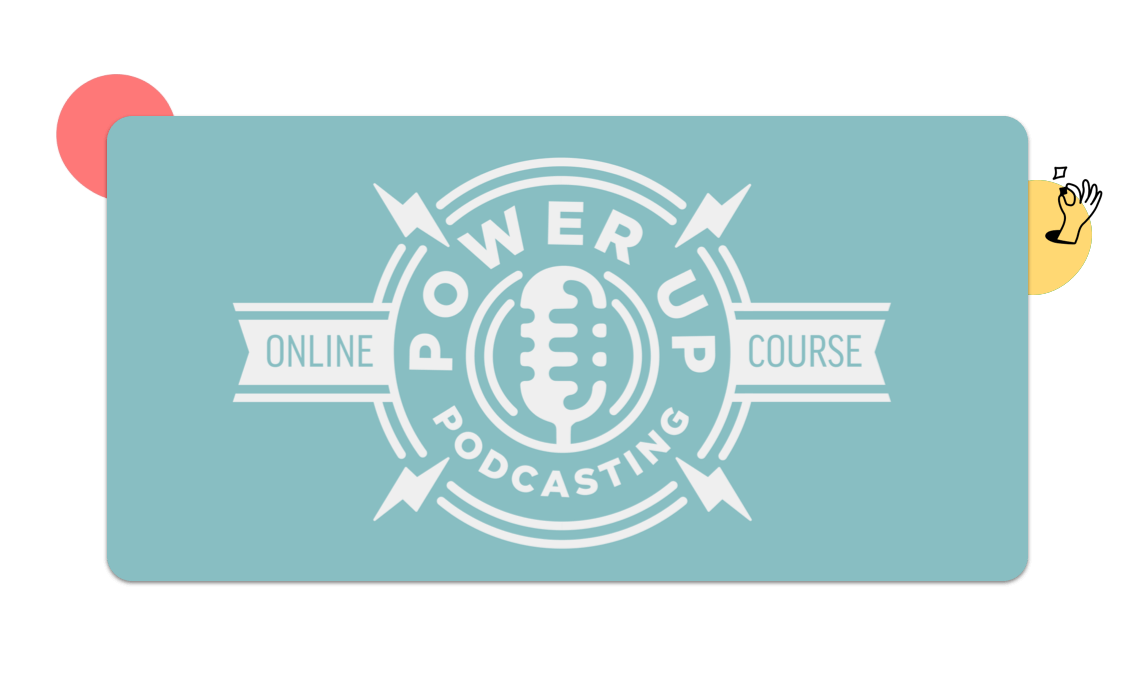
Learn to podcast the smart way
So, you’ve decided to start a podcast? Awesome! A podcast is one of the best ways to build a super-loyal audience and grow your business, even from scratch. But where do you start?
There’s a lot of planning that goes into creating a podcast and your head is probably full of questions like…
- How do I come up with episode content?
- What equipment and software should I use? Do I need to spend a fortune on my microphone?
- How do I get my show loaded into Apple Podcasts?
- How do I make sure people find my show?
With this course, you'll get a step-by-step walkthrough of the entire process of launching a great podcast. With high-quality videos (that aren't too long) and examples along the way, you'll have your new podcast up and running in no time so you can start growing and delighting your audience.
The course is designed to help you make steady, consistent progress as you work through the curriculum. Along the way you'll be given small, manageable assignments to complete — and before you know it, you're on your way!
Your audience is waiting to hear from you. Start creating your podcast today.
Updated with new content
Technology and trends affect podcasting, which is why we recently released version 3.0 so that our content reflects the current state of podcasting in 2024.
Power-Up Podcasting® teaches you…
The hows and whys of podcasting
Learn how and why podcasting is a great platform for both you and your listeners, and how to create engaging content that grows your audience and keeps them coming back.
Power-Up Podcasting® teaches you…
How to master the technical elements
Hit the airwaves like a professional with an in-depth understanding of podcasting equipment, voice recording, audio editing, interviewing, mp3 tagging, hosting, and publishing.
Power-Up Podcasting® teaches you…
How to set up your website, show notes, and more
Develop valuable show notes, find a website or blog for your podcast, submit your show to iTunes, and create accurate transcriptions of your episodes.
Power-Up Podcasting® teaches you…
How to launch your podcast with an unforgettable bang
Effectively promote and market your launch on social media, be a guest on other podcasts in similar niches, write amazing blog posts that draw in listeners, and maintain your podcasting brilliance for years to come.
More than just a single course
Power-Up Podcasting® is part of the SPI Community, a supportive community of learners designed to help you actually do the work. The community helps you make strides through a unique combination of exclusive live events designed to give you real-time help from and connection to other entrepreneurs, asynchronous messaging in the community, and access to our entire course library.
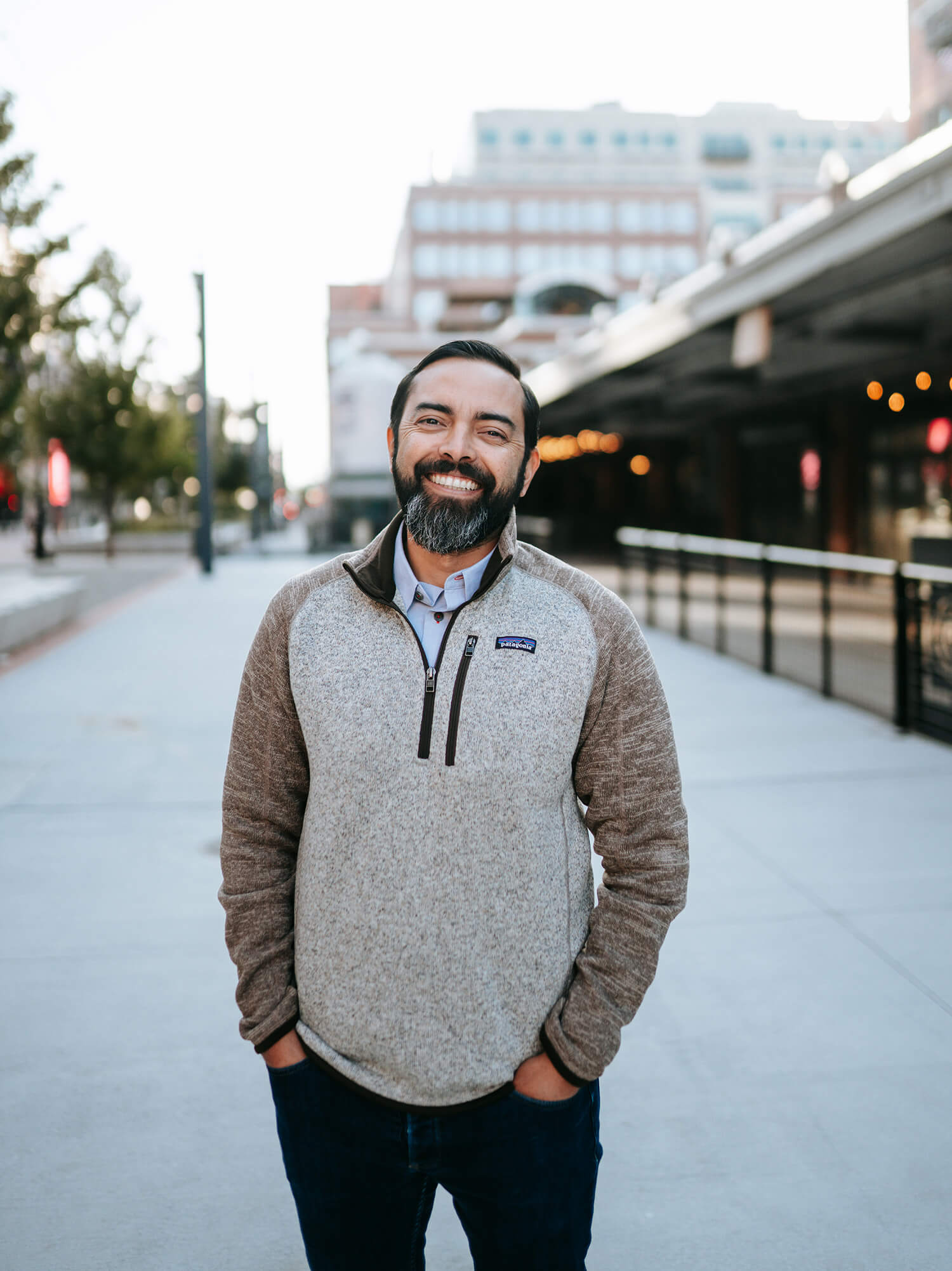
Meet your course instructor
Hey there, my name is Pat Flynn and I’m what you might call an “OG Podcaster.” All that means is that I’ve been doing this for a very long time, so if you’re looking for someone with the most experience, look no further.
Since 2010, I’ve recorded over 1,500 podcast episodes and my top-ranked and award-winning show, the Smart Passive Income Podcast, has over 80 million downloads.
But more importantly, I’ve taught tens of thousands of people just like you how to start, grow, and monetize their podcasts. I’ve even contributed to the start of some really big podcasts, like the Tim Ferriss Show.
I know what works and what doesn’t, because I’ve been there. It’s not just about how to start a podcast, but how to grow a podcast and turn it into something that could potentially generate an income for you.
That’s my specialty. I want to make sure that when you start your podcast you’ll have the best chance of attracting a strong listener base and turning it into something bigger.
There are many challenges in starting and growing a podcast, but my proven online course, Power-Up Podcasting®, has helped thousands of other students. Now it’s your turn to grab the mic, share your message, and build your loyal fan base.
“I know all too well how intimidating it can be to start a podcast. It took me 18 months from when I first announced that I was starting my podcast until I actually launched it.
I got stuck! Partly it was learning all the technical aspects (I didn’t have a course to help me get started), but mostly I was scared. I was so concerned with wanting to do it “right” that I blocked myself from the most important step, getting started.
That’s why I created this course! This is what I wish I had when I first started.”
—Pat Flynn
Power-Up Podcasting® Course Outline
Welcome, Students!
- Welcome! Watch This First
- Office Hours
- Course Downloads
PRE-LAUNCH // STEP 1: You and Your Future Podcast
- Lesson 01: Welcome to the Pre-Launch!
- Lesson 02: Your Podcast Equipment
- Lesson 03: How Podcasting Works
- Lesson 04: Common Roadblocks (and How to Stop Them)
- Lesson 05: What's Your Show About?
- Lesson 06: Your Show Details
- Lesson 07: Podcast Artwork
- Lesson 08: Voiceovers and Royalty-Free Music
- Lesson 09: Let's Recap Step 1
PRE-LAUNCH // STEP 2: Planning Your Podcast Episodes
- Lesson 01: Welcome to Step 2! Excited Yet?
- Lesson 02: Your Show's Introduction
- Lesson 03: What Should You Include in Your First Episode?
- Lesson 04: Content (What Do You Talk About?)
- Lesson 05: Guests and Interviews
- Lesson 06: Calls to Action
- Lesson 07: Recap of Step 2
PRE-LAUNCH // Step 3: Recording and Editing Your Show
- Lesson 01: Welcome to Step 3! Let's Do This!
- Lesson 02: Hooking Up Your Equipment
- Lesson 02.1 USB Microphone (Including ATR 2100 and Samson Q2U)
- Lesson 02.2 XLR Microphone with Scarlett 2i2
- Lesson 03: Setting Up Your Recording Software
- Lesson 03.1 Setting Up Garageband
- Lesson 03.2 Setting Up Audacity
- Lesson 03.3 Setting Up Adobe Audition
- Lesson 04: Master Files and Organization
- Lesson 04.1 Master Files for Garageband
- Lesson 04.2 Master Files for Audacity
- Lesson 04.3 Master Files for Adobe Audition
- Lesson 05: Recording an Interview (on the Internet)
- Lesson 05.1 Recording an Interview on Zoom
- Lesson 05.2 Recording an Interview on Squadcast
- Lesson 06: Recording an Interview (in Person)
- Lesson 07: Recording Tips
- Lesson 08: Interviewing Tips (Before and While You Record)
- Lesson 09: Putting Together Your Show
- Lesson 09.1: Putting Together Your Show in Garageband
- Lesson 09.2: Putting Together Your Show in Audacity
- Lesson 09.3: Putting Together Your Show in Adobe Audition
- Lesson 09.4: Putting Together Your Show In Descript
- Lesson 10: Recap of Step 3
PRE-LAUNCH // STEP 4: Preparing Your Audio File for the World
- Lesson 01: Welcome to Step 4!
- Lesson 02: Export Your First Episode
- Lesson 02.1: Garageband Export
- Lesson 02.2: Audacity Export
- Lesson 02.3: Adobe Audition Export
- Lesson 02.4: Descript Export
- Lesson 03: Auphonic (Optional, but Awesome!)
- Lesson 04: How to Title Your Podcast Episode
- Lesson 05: Your Podcast Hosting Company
- Lesson 05.1: Fusebox Overview
- Lesson 06: Understanding Your Podcast RSS Feed
- Lesson 07: Setting Up Your Apple Podcasts Account
- Lesson 08: Webpage Setup and Show Notes
- Lesson 09: Transcriptions
- Lesson 10: Podcast Trailers
- Lesson 11: You Made It through Step 4!
PRE-LAUNCH // STEP 5: The Launch Plan
- Lesson 01: Welcome to Step 5 — The Final Step of Pre-Launch!
- Lesson 02: Your Launch Plan (and How Rankings Work)
- Lesson 03: Make It an Event
- Lesson 04: Congratulations! You’ve Completed the Podcast Pre-Launch Module!
2.0 Launch Week
- Lesson 01: Welcome to Launch Week!
- Lesson 02: Submit Your Feed to Podcast Directories
- Lesson 02.1: Apple Submission
- Lesson 02.2: Google Podcast Submission
- Lesson 02.3: Spotify Submission
- Lesson 02.4: iHeartRadio Submission
- Lesson 03: Remind Your Network and Audience the Show Is Coming Soon
- Lesson 04: What to Do after Getting Approved by Apple Podcasts
- Lesson 05: The Day before Your Launch
- Lesson 06: Happy Launch Day!
After Launch
- Lesson 01: The Process for Publishing Future Episodes
- Lesson 02: Stats and What They Mean
- Lesson 02.1: Apple Stats
- Lesson 03: Podcast Reviews (and How to Get Them)
- Lesson 04: Getting Exposure on Directories
- Lesson 05: How to Remain Consistent and Keep Growing
- Lesson 06: Recommended Resources for Existing Podcasters
- Lesson 07: Growing Your Email List with Your Podcast
Podcast Monetization
- Lesson 01: An Introduction to Podcast Monetization
- Lesson 02: Advertising and Sponsorships
- Lesson 03: Selling Your Own Stuff
- Lesson 04: Affiliate Marketing
- Lesson 05: Patreon
Video Podcasting
- Intro to Video Podcasting
- Tips for Recording a Video Podcast
- Tips for Editing a Video Podcast
- Uploading Your Video Podcast to YouTube
You Did It!
- That's a Wrap!
BONUS VIDEOS: Growing Your Podcast Audience
- Scaling Your Podcast with a “HITT” Episode
- How to Convert Your Casual Listeners into Raving Fans
- How to Grow and Foster a Community with Your Podcast
BONUS: Podcast Recording Checklist
- 5 Tips for a Perfect Podcast Interview Recording
We believe in community-driven courses
Save 16% with annual billing

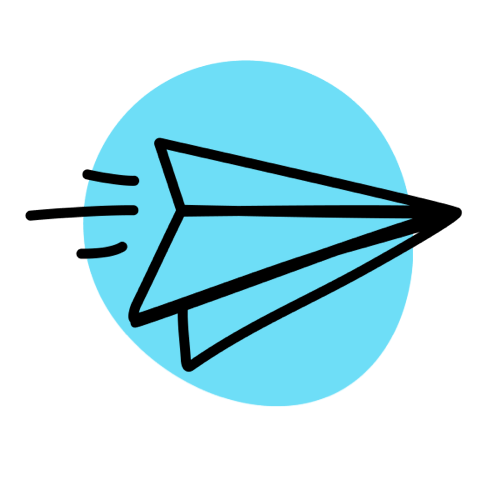
Start
Do It Yourself
$49
/ month
Billed quarterly for $147
$41
/ month
Billed annually for $490
As a Start member, you’ll have access to:
- A network of like-minded entrepreneurs through direct messaging and active community discussion channels
- SPI’s entire library of pre-recorded courses
- Live and recorded workshops
- Mini-courses
- Guided pathways
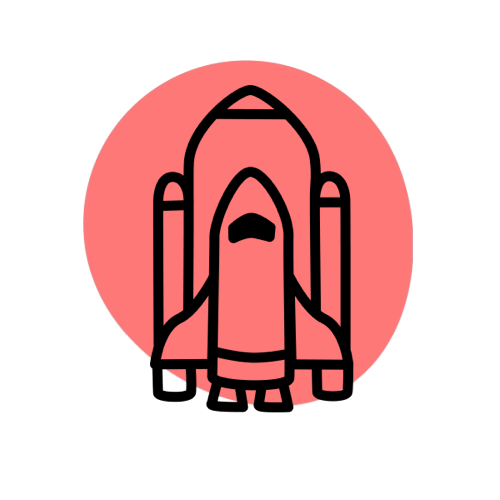
Thrive
Vetted Entrepreneurs
$149
/ month
Billed quarterly for $447
$125
/ month
Billed annually for $1490
Everything in Accelerate, plus:
- Full-Time Entrepreneur Playbook — filled with essential tools and templates for running a successful business
- Quarterly Sprints
- Vetted mastermind groups led by trained peer facilitators
- Expert feedback during live Ask-Me-Anything events hosted by our Experts in Residence
- Advanced live office hours with Pat Flynn twice a month
The Thrive tier is an application-based membership with quarterly enrollment. Doors are closed until February 10th, 2025.
Don't take our word for it
The post Power-Up Podcasting appeared first on Smart Passive Income.
]]>Amp'd Up Podcasting Part of the SPI Community course library. Get your time back, grow your listenership, and earn more money Learn about the course Do you have a podcast […]
The post Amp’d Up Podcasting appeared first on Smart Passive Income.
]]>Amp'd Up Podcasting
Part of the SPI Community course library. Get your time back, grow your listenership, and earn more money

Do you have a podcast but feel stuck?
Creating and launching a podcast is big accomplishment that deserves a big kudos! But if you’ve been podcasting for more than a few months, you may feel burned out and are struggling with how to move forward.
You need more than passion. You need a plan.
Why do podcasters burn out? Honestly, it’s because they didn’t have a plan in place to support the ongoing needs of their podcast.
Without a smart plan, podcasters risk wasting a lot of time, energy, and even dollars to keep their shows going. And many never enjoy a return on those investments.
That’s no fun, which is why it’s no surprise that many podcasters take breaks from making their shows or worse—kill them completely.
I know you don't want that to be you. I believe in you and your passion for podcasting! However, passion isn’t enough to sustain and grow your podcast. And it certainly isn’t enough to make money from your podcast.
You need a proven plan to help you structure and streamline your podcast production, elevate the quality of your show, and incorporate ways to make money that are consistent with your brand and values.
That’s why I created Amp’d Up Podcasting—to help committed podcasters like you avoid burnout, discover smarter ways to work, and incorporate authentic monetization strategies to transform your promising podcast into an sustainable and profitable one!
Amp'd Up Podcasting gives you…
A done-for-you production system
that you can implement to take the burden off of you.
Amp'd Up Podcasting gives you…
The knowledge to hire the right team
or service to edit, export, schedule, and publish podcast episodes.
Amp'd Up Podcasting gives you…
A comprehensive marketing plan
for getting more listeners, involving multiple strategies to help the right people find your show.
Amp'd Up Podcasting gives you…
A way to monetize your podcast
in a manner authentic to your show and audience and increase your earnings.
All-Access Pass gives you…
Ongoing help from Pat and the SPI community
Ask questions at Pat's weekly private Office Hours Zoom call, or post your question to other members of the All-Access Pass community. Get help with your questions and ask for feedback on your ideas.
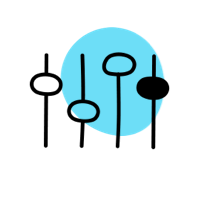
Automate
A is for Automate. You'll learn how to streamline your production process from start to finish, and how to work effectively with a team.
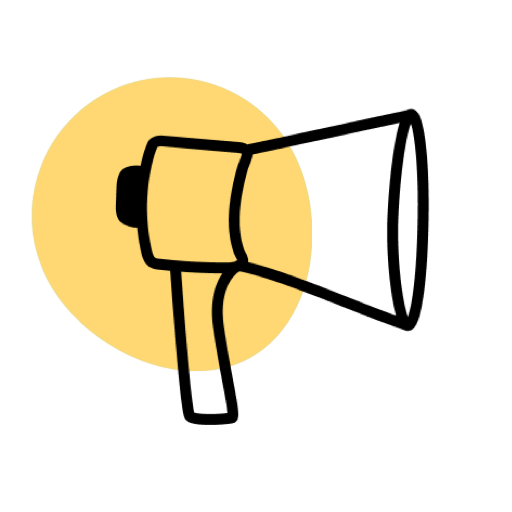
Market
M is for Market. You'll learn how to optimize your marketing, including landing guest spots on other shows, repurposing your content, and getting traditional media attention for your show.
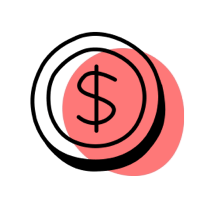
Profit
P is for Profit. You'll learn where to start with monetization, how to create a focus offer, use affiliate marketing, advertising, and/or Patreon to create income streams for your show.
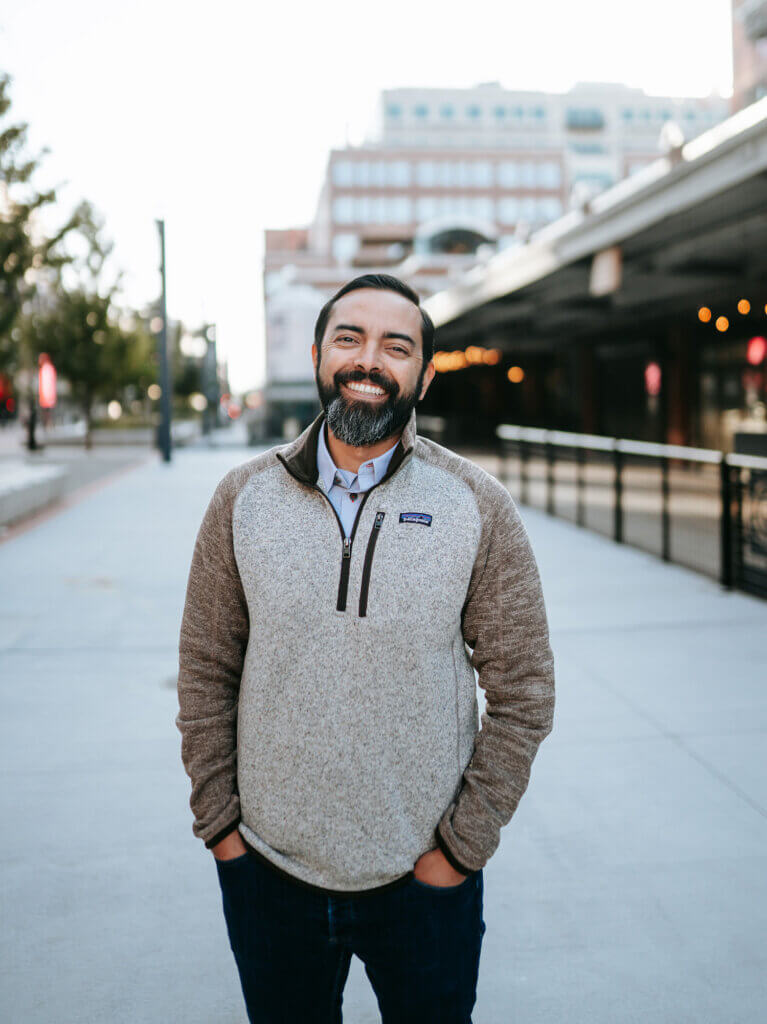
Meet Your Course Instructor
Hello, my name is Pat Flynn. I’ve been podcasting since 2010, beginning with the Smart Passive Income Podcast, my flagship show that’s consistently ranked in iTunes as a top business podcast. I’ve also created three other podcasts, including the AskPat Podcast, and the legacy shows: FoodTruckr Podcast and 1-Day Business Breakthrough (with my friend Chris Ducker).
I’ve published over 1,300 episodes across all of my podcasts, with more than 50 million downloads, and interviewed some amazing guests, including YouTuber Marques Brownlee (A.K.A. MKBHD), James Clear, Amy Porterfield, Chris Ducker, and Nicole Walters. In the past eight years, I’ve earned over $300k in sponsorship income from my podcasts.
I’m convinced: podcasting is one of the most valuable tools for growing a business. My podcast has helped me connect with and educate my listeners, launch products, and make the most of live, in-person events. More people find my business and stay connected to it because of my podcasts.
Throughout the course of creating, launching, and marketing these podcasts, I’ve learned what works and what doesn’t, how to grow a show, and which successes can and can’t be replicated. I’ve helped thousands of podcasters get up and running with the own podcasts through my free Podcasting Tutorial and my course Power-Up Podcasting®.
But I’ve heard from many of my students that they need to “amp up” their podcasts, but they don’t know how to go about doing that. They are wondering how to keep their podcast running without getting burned out. How can they develop a system that runs smoothly, hire a team they can trust, get more listeners, and make more money from their podcast?
If you’re wondering the same things, then my Amp’d Up Podcasting course is for you. I will give you everything you need to make your existing podcast the best it can be, and help you come up with a system so you can keep it going for the long haul.
Amp'd Up Podcasting Course Outline
Welcome, Students!
- Welcome! Watch This First
- Office Hours
- Course Downloads
A: Let's Automate
- Module 1: Overview
- Lesson 01: Your Content Calendar
- Lesson 02: Your Personal Production Schedule
- Lesson 03: Editing and Publishing Solutions
M: Marketing Levers
- Module 2: Overview
- Lesson 01: Podcasting Marketing Audit
- Lesson 02: Post-Publishing Protocol
- Lesson 03: Marketing Lever #1
- Lesson 04: Marketing Lever #2
- Lesson 05: Marketing Lever #3
P: Profit
- Module 3: Overview
- Lesson 01: Pro Affiliate Marketing for Podcasters
- Lesson 02: Back to Your Content Calendar
- Lesson 03: The #1 Way to Promote Your Own Product
- Lesson 04: Building Your Email List with Your Podcast
- Lesson 05: Building Your Podcast Funnel
- Lesson 06: One Final Note
We believe in community-driven courses
Save 16% with annual billing


Start
Do It Yourself
$49
/ month
Billed quarterly for $147
$41
/ month
Billed annually for $490
As a Start member, you’ll have access to:
- A network of like-minded entrepreneurs through direct messaging and active community discussion channels
- SPI’s entire library of pre-recorded courses
- Live and recorded workshops
- Mini-courses
- Guided pathways

Thrive
Vetted Entrepreneurs
$149
/ month
Billed quarterly for $447
$125
/ month
Billed annually for $1490
Everything in Accelerate, plus:
- Full-Time Entrepreneur Playbook — filled with essential tools and templates for running a successful business
- Quarterly Sprints
- Vetted mastermind groups led by trained peer facilitators
- Expert feedback during live Ask-Me-Anything events hosted by our Experts in Residence
- Advanced live office hours with Pat Flynn twice a month
The Thrive tier is an application-based membership with quarterly enrollment. Doors are closed until February 10th, 2025.
The post Amp’d Up Podcasting appeared first on Smart Passive Income.
]]>Affiliate Marketing — A Simple Step by Step Guide Everything you need to know about affiliate marketing, including how to get started, different methods, and things to watch out for are […]
The post Affiliate Marketing – A Simple Step by Step Guide appeared first on Smart Passive Income.
]]>
Affiliate Marketing — A Simple Step by Step Guide
Everything you need to know about affiliate marketing, including how to get started, different methods, and things to watch out for are all below. Let's get started!
Affiliate marketing is the easiest way to generate an income online. You don't need to create your own products (which takes a ton of time), and you don't even need to really sell anything.
All you need to know how to do is to recommend something, and if you've ever recommended anything to anyone before, then you already know how to do this.
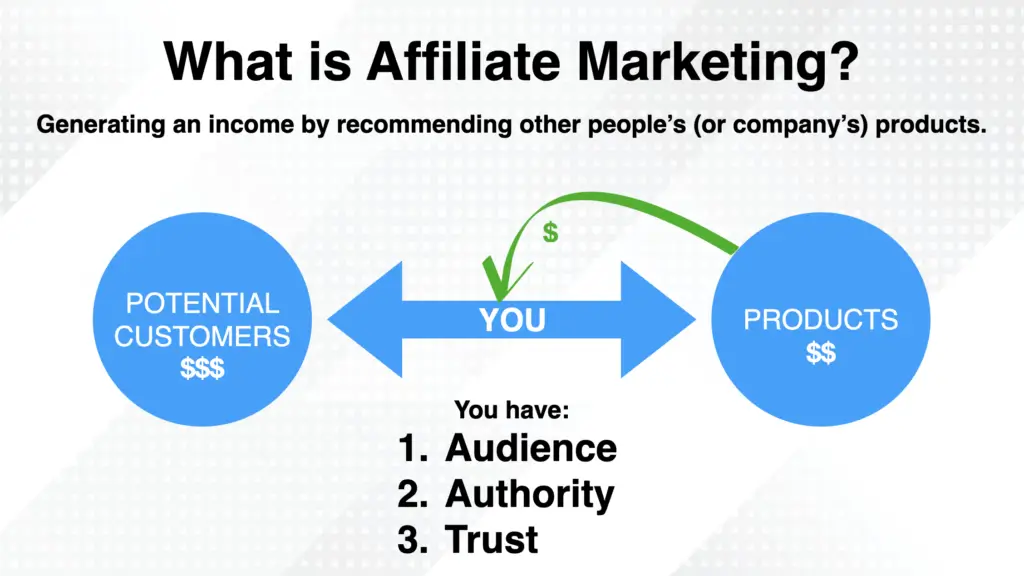
I’ve been affiliate marketing since 2009 on my very first website, GreenExamAcademy.com. On this architecture-education website I promoted an exam software that has generated more than $200,000 in commissions over the years.
And that's just one product out of dozens of products I've recommended across multiple businesses. All together, I've generated over 3 million dollars since 2009. That's not total sales, that's total commission that I got to keep.
I know, this sounds kind of wild, and almost too good to be true. You're not going to make millions of dollars overnight – this stuff takes time to learn what works, and what doesn't. But, I'm here to help you speed up the process and finally get the momentum going your way.
In this guide, I'll teach you how to get started and find the right products for your audience, even if you're just starting out.
Instead of worrying about upsetting and annoying your audience with your promotions, I'll show you how to gracefully promote products in a way that people will thank you for the time and effort you put in to help them make a buying decision.
I'll also teach you about the amazing opportunities you can have related to the companies you help promote, and the special kinds of deals and offers you can get for yourself, and your audience, through those relationships.
It’s the guide I wish I’d had when I started my affiliate marketing journey way back in 2009.
Excited? Here’s what’s in store:
Contents
- What is affiliate marketing?
- How does affiliate marketing work?
- Benefits of affiliate marketing (and drawbacks)
- How much do affiliate marketers make?
- What affiliate marketing strategies do marketers use to promote their partners?
- How to start affiliate marketing for beginners
- Affiliate marketing examples
- Affiliate marketing case study: SPI + Kit
- 8 best affiliate programs and networks
- Affiliate marketing tips for beginners (and experts)
- Affiliate marketing mistakes to avoid
- My best resource for beginner affiliate marketers: The Affiliate Marketing Cheat Sheet

Get Unstuck in just 5 minutes, for free
Our weekly Unstuck newsletter helps online entrepreneurs break through mental blocks, blind spots, and skill gaps. It’s the best 5-minute read you’ll find in your inbox.
Free newsletter. Unsubscribe anytime.

Join 100k+
Subscribers

What is affiliate marketing in simple terms?
Affiliate marketing is the process of earning a commission by promoting another person’s (or company’s) product. You find a product you like, promote it to your audience, and earn a piece of the profit for each sale that you make.
It’s similar to a salesperson earning a commission, except you don’t work for the company. Instead, it’s like earning a reward for sending a new customer to the company.
In other words, when you help another company generate sales, you get a cut!
The best part is that you don’t have to spend the time and money to create your own products, because someone else has already done the hard work.
You can begin making money as an affiliate as soon as you have a place to recommend products, whether that's a website you have, a podcast you've started, or even on social media.
So, all you have to do is send traffic through a link to that product, and everything after that is out of your hands . . . right?
Wrong.
There's so much more involved to make this work well, which is why most people who attempt affiliate marketing fail, or just see a few dollars coming in from their efforts.
I want you to see amazing, life-changing results from affiliate marketing, which is why I'm thankful you're here.
There are two ways to be involved in affiliate marketing—either as a product owner/affiliate marketing program creator or an affiliate marketer.
In this post, we’re going to focus on how to do online affiliate marketing from the affiliate marketer side.
Affiliate marketing is quite simply one of the most powerful ways to generate an income online. Regardless of your niche, the upside with affiliate marketing is nearly limitless if you go about it the right way!
Part of the beauty of affiliate marketing, especially for beginners, is you don’t have to invest time in creating the products that will be serving your audience—because, guess what?
Those products likely already exist.
Because of that, affiliate marketing is an opportunity anyone can take advantage of, and it’s easy to get started.
Affiliate marketing examples are all around us—and you’ve probably been involved in affiliate marketing without realizing it!
If you’ve ever clicked on a link in a blog post to a product or service being offered on another website, there’s a good chance the owner of the website where you originally clicked the link received a commission from your purchase.
Yes, affiliate marketing is everywhere—but here’s the thing: few people understand how to take full advantage of it.
In fact, I believe affiliate marketing is the world’s most untapped source for generating passive income!
It’s a beautiful process that’s completely underutilized, and I’m excited to share with you exactly how it all works.
Who is a good fit for affiliate marketing?
Affiliate marketing can be a great choice for online entrepreneurs, bloggers, and really anyone who has a website and is willing to build an audience they can serve authentically.
If this describes you, products exist right now that people in your target market are probably already buying, and if you can become the resource that recommends those products, you can generate a commission as a result.
Affiliate marketing can be an especially good option if you’re not ready to create your own product or service, but you want to serve your audience by recommending products that may be helpful to them.
Online affiliate marketing can also be a good fit for a wide range of people because you can apply a bunch of different marketing methods to promote affiliate products and services.
These include the same marketing methods you may already be using—things like search engine optimization (SEO), paid search engine marketing (SEM), email marketing, content marketing, and display ads.
You can even take advantage of other nifty ways to market products, like product reviews and unboxings.
Take for instance this YouTube video I did, where I review and demonstrate three USB podcasting microphones and include Amazon affiliate program links to purchase each one in the description.
Finally, it’s important to remember that affiliate marketing works best when you’re sincere and confident about the product you’re promoting.
You’d only sell your own product if you knew it could help people, and it’s the same with affiliate marketing. If you go in with a get-rich-quick mentality, you’re not going to be impressed with your results.
How does affiliate marketing work?
Let’s get into the details of how affiliate marketing works. There are three main players in an affiliate marketing arrangement:
- You and your website—the “affiliate.”
- The affiliate company (or network). In the simplest affiliate arrangements, you work directly with a single company to promote one or more of their products. There are more complex affiliate networks that provide an opportunity to earn affiliate revenue on a range of products, such as Amazon, Impact, and ShareASale.
- The customer. This is a member of your audience who uses your affiliate link to purchase a product from the affiliate company or network.
A company that offers an affiliate marketing program may call it by a different name—these programs are also commonly called partner programs or referral programs.
Here’s how each party benefits from affiliate marketing:
- From your recommendation, your audience learns about a product, course, or tool that may be useful to them;
- From your recommendation, the company selling the product, course, or tool gets new customers they may not have found otherwise;
- As a result of the sales to your audience, the company gives you a commission.
When done the right way, affiliate marketing can be a win–win–win.
But at the center of this is one thing: your audience’s trust.
When your audience believes you have their best interests at heart and trusts your recommendations, then all three parties in the affiliate marketing relationship ultimately benefit.
A lot of people worry about getting involved with affiliate marketing because it might make them look slimy or too salesy.
That’s why I’ve made it part of my mission to teach people how to do affiliate marketing in a way that makes it a win for everyone.
The biggest element to success with affiliate marketing?
Trust.
Earn trust from your audience first, and only recommend affiliate products that you’ve used yourself and know your audience will benefit from.
And you know what?
A lot of people do it the wrong way by taking an income-first rather than a serve-first approach.
These folks push random products and over-promote them without providing true value to their audience.
This has given affiliate marketing a really bad rap in some quarters, causing many ethically minded entrepreneurs to be wary of affiliate marketing.
But thankfully, you CAN do it right, maintaining your audience’s trust and having them thank you for your recommendations.
Benefits of affiliate marketing (and drawbacks)
As with anything, affiliate marketing has its upsides and its downsides.
Later in this guide, I’ll give you the guidance you need to go about affiliate marketing smartly so you can make the most of the opportunities out there and avoid the potential downsides.
Here are the main pros and cons of affiliate marketing.
Affiliate marketing pros
- Low barrier to entry. Affiliate marketing is easy to get started with, and costs little. Most affiliate programs are free to join, and you don’t have to create, stock, or ship products, which also means less hassle/responsibility.
- Low risk. You’re not the product owner, so you don’t lose anything if a customer doesn’t buy.
- Passive income potential. Affiliate marketing provides the potential for passive income.
- More freedom. When you start earning passive income, you can work anytime and from anywhere, as long as you have internet access.
Affiliate marketing cons
- Not a quick fix. It can take time to generate the amount of traffic needed to result in substantial income.
- Less control. You don’t own or control the product/service you’re recommending, so you can’t control the quality or customer experience.
- Competition and audience fatigue. An attractive affiliate program means you might be competing with others for customers.
- Offer fatigue. Audiences can also get “offer fatigue” if they see too much ongoing promotion from you.
- Not all affiliate programs are created equal. While most companies that offer affiliate commissions are stable and ethical, there are shady companies out there too, some of which may not pay what they say they will. It’s important to do your homework.
- Risk of link hijacking. Unscrupulous individuals may hijack your affiliate links, known as “clickjacking,” potentially stealing your commission in the process.
How much do affiliate marketers make?
The beauty of affiliate marketing is that you don't have to invest the time and effort to create a product to sell.
You can begin selling something as an affiliate as soon as you have a platform to sell it on. In this way, affiliate marketing can be a great way to earn some extra income without a lot of hassle or upfront cost.
That said, it’s not a way to get rich quick.
Like all passive income ideas, it takes time and effort to create a decent revenue stream.
Although affiliate marketing has been my number one source of income for a while, it took me a while to get to where I am, including building close relationships with the companies I’m an affiliate for.
In my very first month doing affiliate marketing (December 2008), I earned a whopping $163.16:
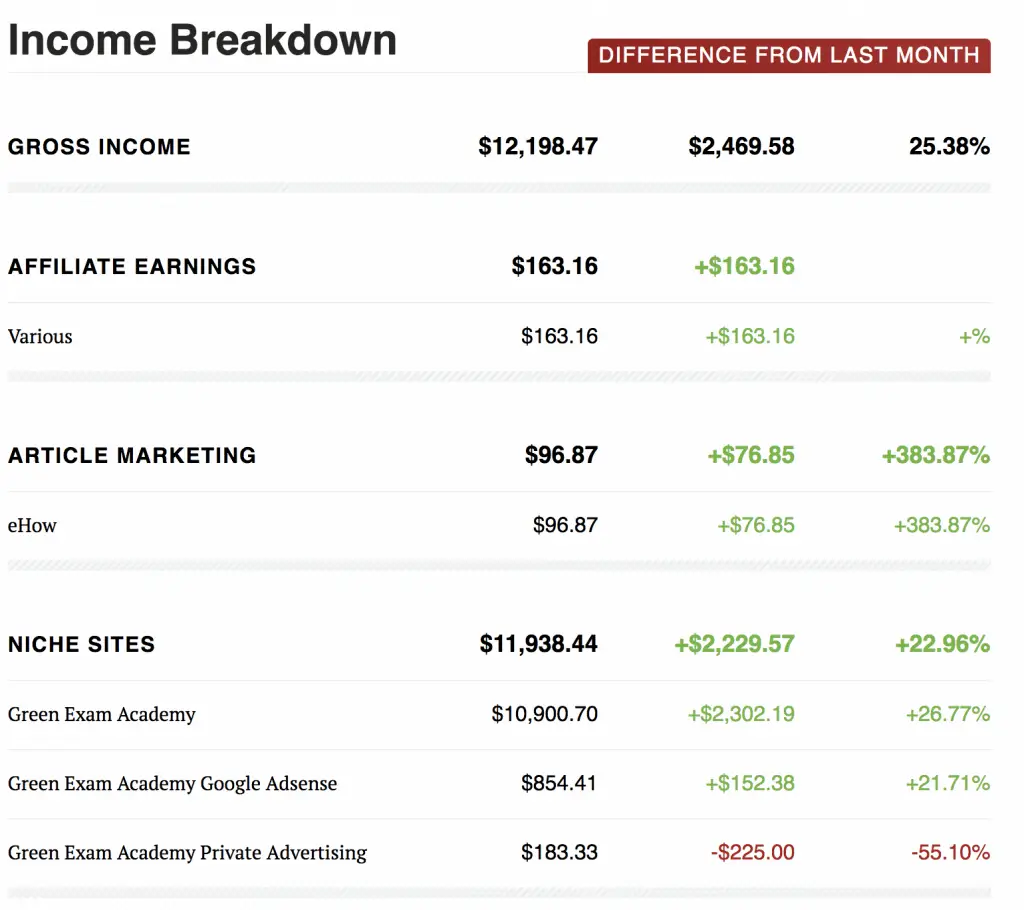
Here’s how I did in December 2009, the month that marked my first full year as an affiliate marketer:
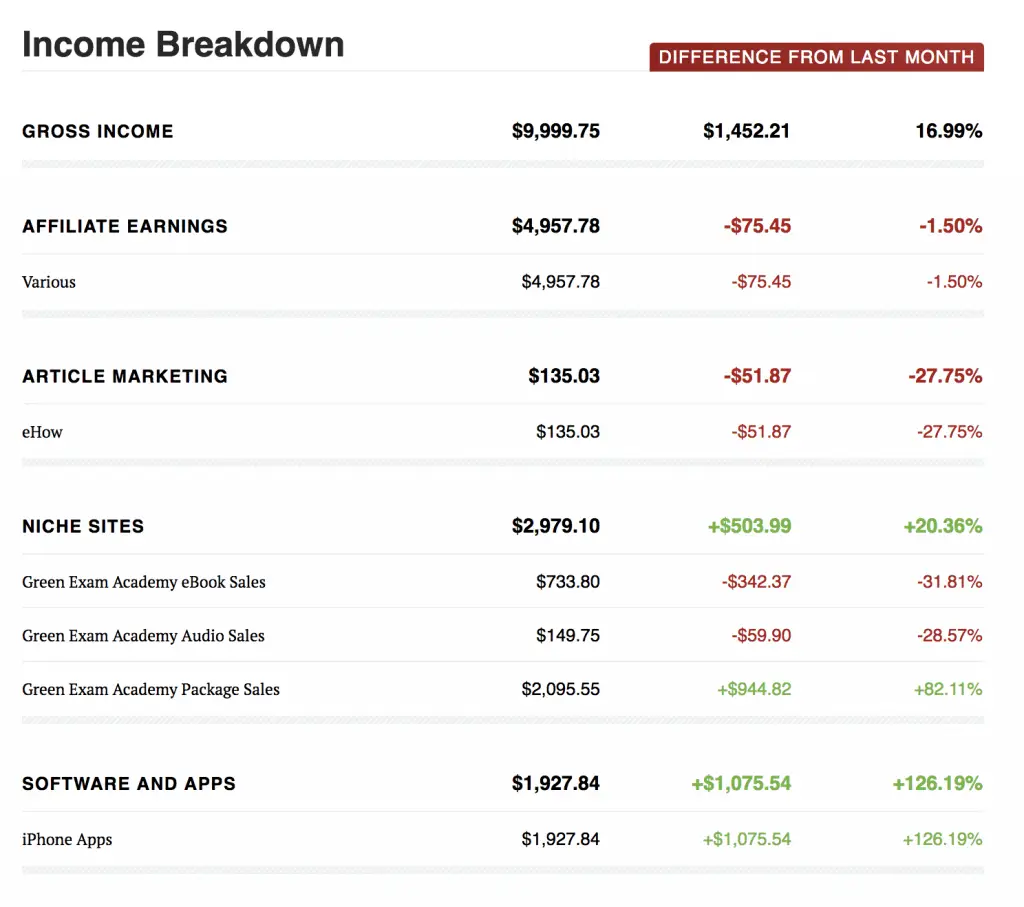
And here’s what my affiliate income looked like in December 2017, the last month I published an income report:
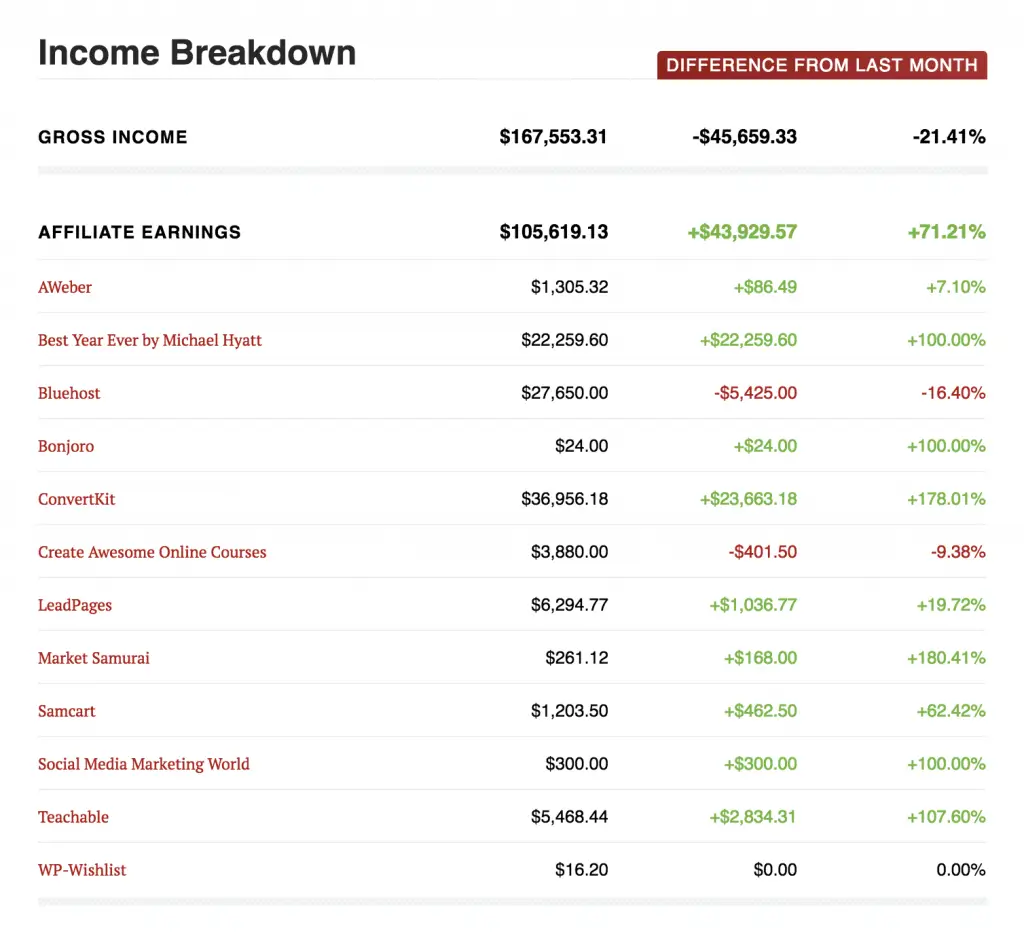
As you can see, I’ve done really well with affiliate marketing in the past 10 years—but it’s taken a lot of time and hard work to get to that point.
So, how much can you make once you’re up and running with affiliate marketing?
That depends primarily on how committed you are to making it work and how much time, energy, and focus you’re willing to put into it. It also hinges on a few other factors:
- The commission percentage you receive for each sale of an affiliate product or service.
- The size of your audience.
- How successful you are at promoting those products or services to your audience.
- Typical commission percentages vary depending on the affiliate company you partner with, and the types of products or services you’re promoting.
Digital products and services typically offer higher margins due to their lower costs of production and fulfillment—there are no raw materials, manufacturing, shelf space, shipping costs, etc.
These margins can be as high as 50 percent.
On the other hand, because of all the aforementioned costs, physical products tend to offer lower percentage margins, sometimes in the single digits.
Thankfully, there is no real limit on how much you can make as an affiliate marketer.
Affiliate marketing can be a great way to augment your existing income, or even become your main source of income if you’re willing to make the commitment.
But in either case, if you’re looking for long-term success with affiliate marketing, you have to be willing to do it the right way.
What affiliate marketing strategies do marketers use to promote their partners?
There are a ton of tactics you can use to promote your affiliate partner’s products online.
Here’s a starter list of 10 to get your affiliate marketer brain something to chew on and remix:
1. Create an epic post
One thing I like to do when promoting a product is create an Epic Post about it.
What’s an epic post?
Think of it as a potential one-stop-shop resource for this particular product—not just a review of it, but a full-fledged introduction, how-to, FAQ, best practices, and troubleshooting resource for anyone who purchases the product.
If you can show this much information to people before they make a purchase, they’ll be more likely to actually make a purchase.
At the same time, the epic post becomes an extremely shareable article, one with the potential to rank high for the particular product keyword in Google.
In this epic post, I’d go all out and . . .
2. Create multiple YouTube videos about the product
These videos should be embedded in the epic post.
This is an important affiliate marketing strategy because YouTube is the #2 search engine in the world. You can get a lot of traffic coming in through your affiliate link on YouTube, and the videos themselves can rank in Google too.
Plus, by shooting multiple videos about a particular product, you create even more SEO opportunities.
Make sure to include your affiliate link in the video description, ideally in the first part of the description, so people don’t have to click on “show more” or “read more” to see it.
What should you cover in these videos?
I recommend recording yourself from start to finish with it, then break it up into chunks. People like to watch shorter videos, so this works in your favor, and you get multiple opportunities to rank for various keywords related to that product.
If it’s a digital product, start at the moment of purchase and walk people through the entire process. And if you’re doing a physical product, consider an unboxing video.
3. Host a webinar
One way to take your affiliate product promotion to the next level is to host a webinar for it.
Webinars are an extremely powerful way to share a message with your audience. They’re personable, they’re live, and you can treat them like an actual event. That way, your promotion becomes a much bigger deal than just a regular affiliate link you dropped into a post.
Combine this with tip #15 in my list below, and have the owner of the product share high-value information, and even answer people’s questions directly on the webinar, and you’ve got yourself a winner.
4. Publish a webinar replay
Be sure to record your live webinar so that you can embed it on your website as a replay for those who didn’t watch it live, as well as those who did watch it live but want to review the information.
To be honest, more people will probably watch it as a replay than live, and that’s a good thing—you just have to give them the opportunity to do so.
I recommend recording using screen capture software like Camtasia Studio or Screenflow.
Here’s an example of a blog post on my site containing a webinar replay—one I recorded with Clay Collins of Leadpages, a company for which I’m an affiliate:
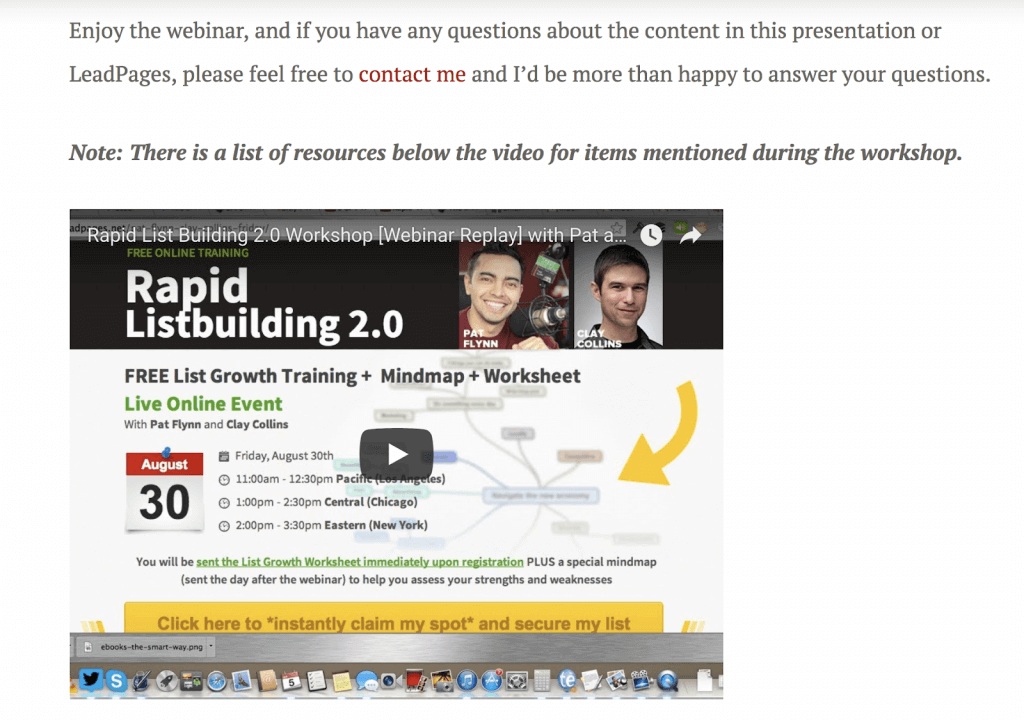
Finally, make sure that in the webinar and on the post where you embed the replay, you give people multiple opportunities to click on your affiliate link.
5. Give away a bonus
This is probably one of the more underutilized tips I have to share today—but probably one of the most powerful too.
In addition to promoting the affiliate product, give away a bonus to all of those who purchase the product through your link as a thank you.
Chances are, you’re not the only one promoting that product, so to get people to buy from you instead of the other guy, throw in a bonus that can only come with a purchase through your link.
Just have your audience members send you their receipt via email and then you can reply with the bonus, or information about how to access it.
So what could that bonus be?
Maybe it’s a special webinar that shows people how to use the product with a Q&A session at the end of it. Imagine being able to purchase a product, getting familiar with it, and then a couple of days later having access to a webinar that shows you exactly how to use the product, with an opportunity to ask questions about it. How awesome would that be?
Maybe the bonus is another product or piece of software that you have that complements the affiliate product.
Maybe it’s a discount you work out with the owner of the product, one that provides incentive to purchase from you.
Maybe it’s a coupon code or discount to another product you own or have ties to.
Maybe it’s a PDF quick-start guide with instructions and best practices for that product, or access to a website with videos with the same guidance.
You’re adding value to the purchase, making your buyers feel comfortable, and helping get those on the fence from “I’m not sure if this is right for me” to “This is exactly what I need, and more.”
6. Promote your products indirectly on social media
Although your website is the centerpiece of your affiliate marketing strategy, social media—Facebook, X, LinkedIn, Instagram, etc.—can play an important role in your affiliate marketing strategy too.
The thing about social media—at least in my experience and in the experience of many other people I know—is that if you directly promote on your social media platforms, you’re not going to get a good response.
People on social media are typically there to be social, not to be sold to.
But all is not lost in the affiliate marketing world, because you can do an indirect social media push, which means instead of directly linking to your affiliate links on Facebook or X or any other platform, you’re instead linking to something of value that includes the affiliate link, such as a video, an epic post on your blog, or a link to sign up for a webinar.
You’re not linking directly through your affiliate link, but a resource that will engage people beforehand, earn their trust, and show them what the product is about before clicking on your affiliate link.
Yes, one of the cardinal rules of online marketing has long been that the fewer gateways or clicks people have to go through before they get to the “buy” button, the better.
But I think that’s been changing, and now it’s closer to the less information you give away, the less you’re likely to make a sale.
The more trust you can earn beforehand, the greater the likelihood people will buy from you.
You don’t want someone to have to click 100 times before they get to where you want them to go, but a few clicks is okay, as long as you give them enough information beforehand to help them make their decision.
7. Run a giveaway to take advantage of “social proof”
Social proof is the idea that people will naturally gravitate toward what the masses are doing. As an example, say you’re at the mall, and you see a huge crowd gathering around one store.
You can’t help but want to know what’s going on—everyone else is there for some reason, and you want to know what that reason is.
Online, this translates to having other people do the marketing for you, except in this case it’s through metrics like numbers of subscribers, likes, comments, and things like that.
Here’s how this strategy can play out in the real world.
When you plan to promote a product as an affiliate, try to work with the owner to get a few copies to give away to your audience for free.
Maybe you can get a discounted price for a limited time only for your audience as well. This may not always be possible, but it never hurts to ask.
In a blog post, review this product—maybe it’s your epic post, or maybe you just mention it at the end of one of your regular posts.
Share that you have two or three copies of the product to give away for free, and that in order to be entered to win one of the copies, your audience members have to leave one comment about how they would use the product and why it would help them.
Have them go through an affiliate link of yours to see what the product is all about first, and then come back to your blog to leave their entry as a comment.
What happens here is that you get tons of people leaving comments that become social proof for the greatness of the product.
There’s nothing more powerful than someone else’s recommendation, and in this case, it’s other people’s recommendation for a product you’re promoting as an affiliate.
Plus, you can follow up with the people who leave a comment on the post but don’t win, to share a limited-time deal or an email saying thanks for the entry and giving them your affiliate link one more time.
I’ve used this strategy to great success promoting several products in the past, so I suggest you give it a shot.
8. Promote products indirectly via your email list
Your email list is an integral part of any affiliate marketing campaign—and if you don’t have one, you need to get started building one yesterday! Email is extremely powerful for marketing, which is why so many people say, “The money’s in the list.”
As with social media, I recommend indirectly promoting to your email list. I don’t directly promote anything on my email list. If there are any links in my emails they point back to other content, usually on my blog, such as epic posts, videos, webinars, and the like.
Email should be all about giving people as much high-value content as possible, not direct selling. In fact, certain affiliate programs such as Amazon’s don’t even allow you to include affiliate links in emails. For more on Amazon, check out my Amazon affiliate marketing guide here.
You need to take great care of your email list and not be too aggressive with it. Indirect promotion is a much better way to go about things, especially if you’re focused on building trust with your audience (and you should be!).
9. Promote products indirectly on other people’s sites
This is another instance in which indirect linking is your friend.
If you’re interviewed for another person’s blog, or asked to write a guest post, you can link back to a piece of content on your site that contains your affiliate link.
As with social media and email, you don’t want to hit people over the head with your links—and most of the time, if you try to link directly to an affiliate product through someone else’s site, they won’t allow it anyway.
10. Review and compare different products of the same type
Another strategy is to compare different products of the same type. Compare and contrast, and if you give them your recommendation, make sure that link is an affiliate link.
The reason this works is because people like to shop around, but they also like convenience. So instead of making them carry out their search all over the web, keep them on your site by reviewing each of the different products in one spot.
If you’ve done a good job building up audience trust, then a well-written comparison review of different products of the same type can be a great way to drive affiliate purchases.
This could potentially become an epic post as well, complete with videos and special deals just for your audience.
How to start: Affiliate marketing for beginners
Many how to start affiliate marketing posts suggest a series of steps similar to this:
- Find a company and product you want to promote.
- Sign up as an affiliate.
- Get your unique affiliate link and add it to your site.
- A visitor to your website clicks the link, which takes them to a third-party page.
- If the visitor makes a purchase, you receive a commission based on the value of the item purchased.
Now, these steps are definitely accurate—you can’t earn money with affiliate marketing without first finding a product to promote!
But more importantly, you shouldn’t be affiliate marketing without first establishing trust with your audience. Audience first, always.
That’s why my methodology for successful online affiliate marketing goes like this:
- First, build a relationship with your audience.
- Then, identify a product that might fit your audience’s needs.
- Next, use and test the product yourself, to ensure it’s truly something worth recommending to your audience, so you don’t risk taking advantage of their trust.
- Show your audience tangible proof that the product does what it promises via a blog post or case study on your website or YouTube channel.
- Then—and only then!—you can start to promote the product to your audience and hopefully start earning some affiliate revenue when they purchase it.
This approach puts your audience’s needs front and center, setting you up for success with affiliate marketing.
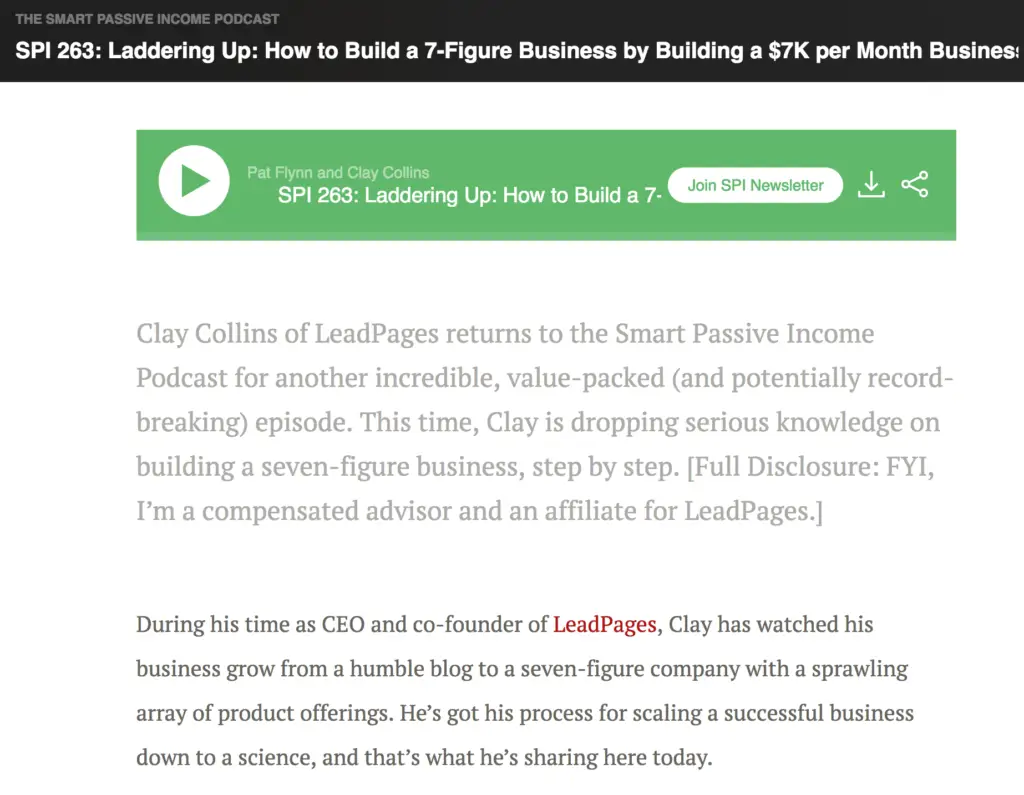
This YouTube video featured a panel discussion between me and several online course creators, hosted by Teachable, an online course creation platform for which I’m an affiliate.
Although I shared my Teachable affiliate link in the show notes, the primary purpose of the video was to deliver value to my audience, not promote the link.
Put your audience first (build trust)
Affiliate marketing helps me generate over $60,000 in affiliate commissions each month. My affiliate income has grown because I follow two major rules:
- I only recommend products that I’m very familiar with. Preferably, these are products I’ve used before and that have helped me achieve something. If I’m not confident in the product and I don’t feel it will help people, I will not promote it.
- I never directly tell anyone to buy a product. I always recommend products based on my experience and in the context of what I’ve done or what I’m doing with it.
What does following these two rules achieve?
Trust.
By doing these two things, my audience knows that I only want them to buy the tools that they need, at the time they need them. They know that I’ve used and believe in the products I recommend.
And they know there’s no pressure, because I’m only looking out for their best interests.
Many affiliate marketers choose not to follow these rules—and I think that’s why affiliate marketing has a bad reputation. We can do better, and so I hope you’ll join me in following these rules.
Every affiliate marketer needs to understand the importance of establishing and maintaining trust with their audience before they get started with affiliate marketing.
Thankfully, my system for getting started has trust baked into the entire process. Let’s dive into it now!
The Soft Pitch Pipeline
My approach to affiliate marketing is built around something I call the soft pitch pipeline.
This approach is designed to do two main things: build trust, and reduce the amount of “hard selling” needed to promote your affiliate products (hence the “soft pitch” part).
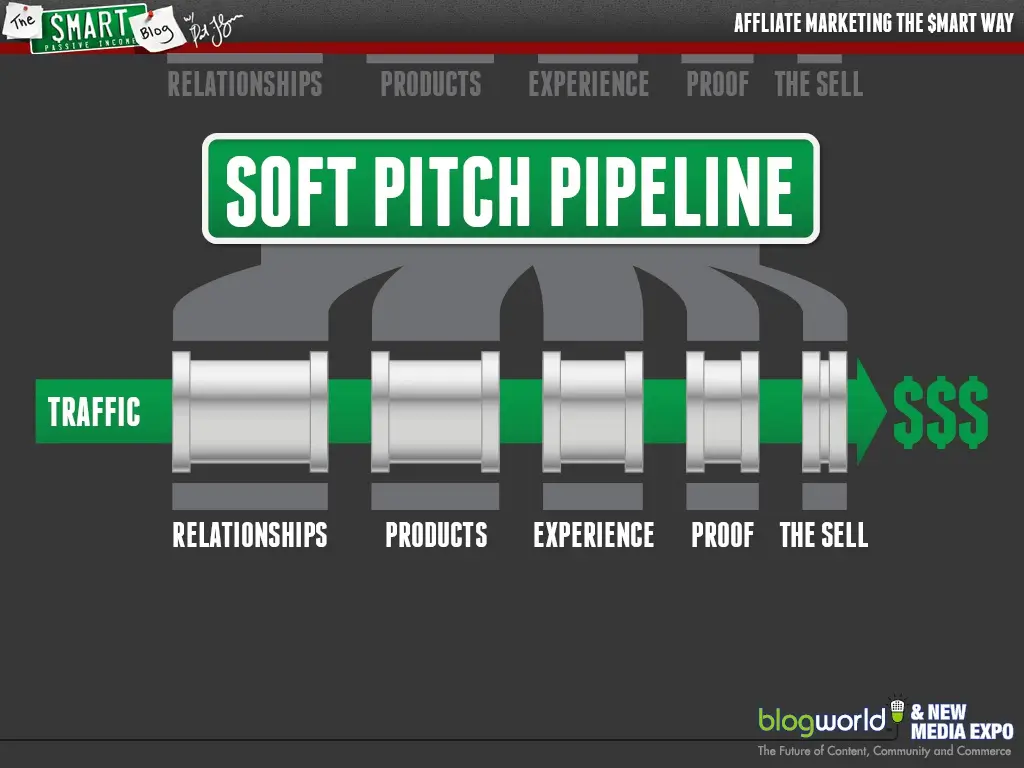
Imagine a series of pipes. These pipes represent the experience or “flow” people go through when they visit your site or are introduced to you and your brand.
On one end is traffic entering the pipeline, and on the other “exit” end of the pipeline is the sale or conversion.
Between these two points, there are five segments that combine to make up the total experience of your brand:
- The Relationships you cultivate with your audience
- The Products you decide to promote
- The Experience you have with those products
- The Proof you share that those products work
- The Pitch or “sell” of those products to your audience
These segments can vary in strength and size.
For example, if you have an amazing relationship with someone, it doesn’t take much to convince that person to do something for you.
In this case, the relationship segment is extremely long, so the pitch segment doesn’t have to be long at all.
For example, say your wife is pregnant. It’s two in the morning and she wants you to go to the store and buy a Little Debbie’s Fudge Brownie. Well, you’re probably off to the store to buy a Little Debbie’s Fudge Brownie—there’s not much pitch or convincing needed at all.
Now take the other extreme: a company you’ve never heard of before.
Since you hardly have any relationship with this company, they’re going to have to work a lot harder to pitch you—to convince you to try them out.
And many companies pitch really aggressively, which can backfire and make people uncomfortable or even annoyed.
That’s exactly what we try to avoid with the soft pitch pipeline.
By focusing on the first four segments of the pipeline—the relationships you cultivate with your audience, the products you promote, the experience you have with those products, and the proof you can share with your audience that the products work—you can make the pitch phase shorter and less aggressive.
If you set up the first four segments of the pipeline the right way, hardly any pitch will be needed to get your audience to click through your affiliate links and make a purchase.
Let’s go over each of those segments now!
Segment 1: Relationships
Relationships are everything.
Having a relationship with your audience is the foundation of trust. It also allows you to get to know your audience in depth, so you can understand their needs and pain points.
That way, you can identify potential products that can help meet those needs and pain points.
Not too long ago, a lot of people were trying to do affiliate marketing by finding a product that offered an attractive commission, then building a site around it and selling it by driving traffic using Facebook ads and Google Adwords.
That tactic used to work, but Google and Facebook have caught on and started clamping down on those ads, making it much harder to pull off.
But more importantly, on a strategic level, it’s just not the right way to do things if you’re interested in building a lasting business. Instead, you need to take a longer-term approach, one centered around relationship building.
What does that look like?
First, you need to identify a target audience that has a specific pain, issue, problem, or goal.
By homing in on that target market and understanding exactly what they’re going through, you can discover ways to help them achieve their goals and overcome their problems.
The key is to not go into it with the aim of finding an affiliate product, but to get to know your audience and find solutions they can use.
Start with the pain, not the product.
How do you learn what your audience needs?
You need to become friends with the people who visit your site and interact with you on social media. Without that relationship, it’s much less likely that meaningful transactions will ever occur.
By meaningful transactions, I’m not just talking sales transactions—I’m talking about email list subscriptions, comments, clicks, likes, follows, shares, and retweets.
The hard part is, a relationship takes time to build.
Thankfully, there are ways to speed up the process of building a relationship with your audience without compromising the quality of that relationship.
So how can you connect with your audience more quickly? Here are three ways:
1. Be Personable
What would make YOU buy something from someone you didn’t know, especially if they were selling a product they didn’t even make themselves?
In a lot of my content, be it blog posts, podcast episodes, and even in-person presentations at large conferences, I try to share aspects of my personality and my personal life.
As a result, most of my audience knows a lot about me—that I’m a family man, that I love Back to the Future, that I’m still working toward my goal to touch a regulation-height basketball rim…
The point is, they know me as a real person, someone just like them.
They can relate to me. And as a result, they’re much more connected to me than if I were to spend all my time telling them about the strategies and tactics that will help them build a successful online business.
What do my kids or my favorite movies have to do with affiliate marketing? Nothing, at least directly.
But what do those things have to do with my brand? Everything, because building a brand is the equivalent of building relationships.
People connect with people, and the more you can become a person in the eyes of your audience, the easier it is for them to connect with you—it’s as simple as that.
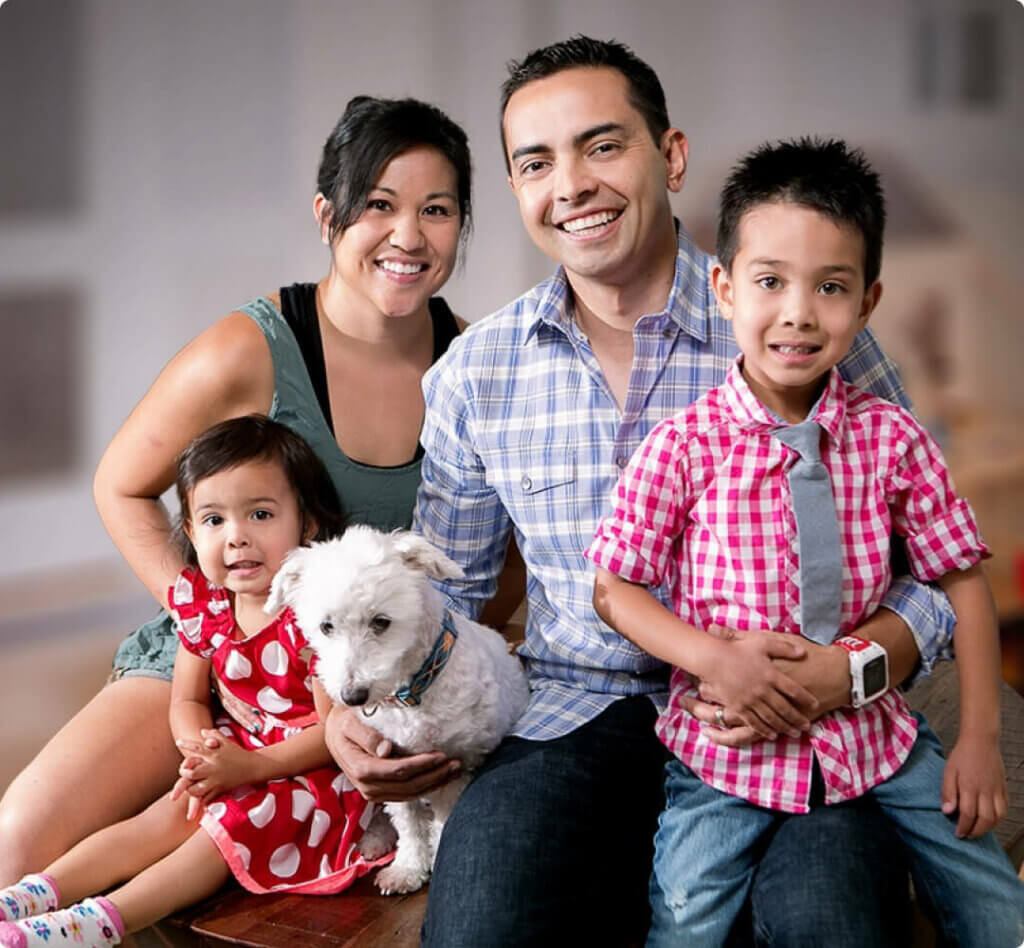
2. Tell Stories
People are programmed to love stories.
Think about the last time you were engrossed by someone’s tale around the dinner table, or just watched a movie or read a book.
When you tell a story, it’s easy for your audience to put themselves into that story; stories put things in context and make them relatable. Stories are an easy and personable way to relate to your audience.
Now, you don’t have to dedicate entire posts to stories about random things to create a meaningful connection.
Instead, be creative and share little anecdotes and examples here and there to illustrate concepts, honest stories that relate to the message you’re trying to get across.
Doing this helps you convey information and build those important relationships with your audience at the same time.
3. Practice ROAK
RAOK is short for “random acts of kindness,” and it’s one of my all-time favorite things to do.
Why?
Because when you do something unexpected and generous for someone, it leaves an amazing impression.
It can be as simple as replying to comments on your blog and social media. I do this, and it helps people see I’m a real person.
If someone has a question, I answer it. It saves them time, and helps them remember who I am.
Sometimes I even take it a step further and leave comments on the blogs of people who’ve left comments on my posts.
It’s small things like these that can help you quickly form a deeper relationship with your audience.
And you can do the same thing!
So ask yourself, what kinds of RAOK can I do for my audience? What unexpected favors can I perform that will help me build a positive, lasting relationship with them?
Segment 2: Products
Once you’ve started to build your audience and develop a relationship with them, you’ll start to learn what that audience needs.
The next step is to identify products you can recommend to meet your audience’s needs and help them in their journey.
First, keep in mind that sometimes the products will be ones that allow you to generate an affiliate income—and sometimes they won’t.
You never want to start with a product or commission in mind. You want to start with the problem, then find solutions for it.
And if the best solution for a particular problem is not an affiliate product, well, that’s what you should promote to your audience. Remember, trust and relationships come first, always.
With that in mind, once you’ve gotten to know your audience and its needs and pain points, how do you select a specific product?
To help you get in the right frame of mind here, think about a brand new visitor who comes to your site for the first time—what is it you want that person to ultimately achieve?
This might be a tough question to answer, but you need to know what you want your visitors to do, because if you don’t, then everything you recommend is going to seem random.
You need your recommendations to be precise and targeted, so your audience can get what they need from you to reach their goals.
Once you’ve identified what you want to help your new visitor to achieve, think about how they’re going to get there.
What’s their roadmap or path to success? Defining the steps on this path will help you determine exactly what kinds of products will help your audience at different points along the path.
Next, you need to think about the products that will help your audience along this path.
One of the best places to start identifying these products is through ones you’ve used yourself. Whatever niche you’re in, spend a little time making a list of the tools and services you use.
Those things that you used to help you achieve your goals can help your audience achieve their goals too. Just about any product or service can work, including:
- Courses
- Books
- Physical products
- Software
- Coaching services
Often, you’ll need to look beyond the products and services you already know and use to find things that will be a good fit for your audience—which means doing some research!
Thankfully, there are plenty of great places and resources to find new affiliate products, including:
- Word of mouth—your professional network, including masterminds, Facebook groups, etc.
- Amazon, to find books and products
Remember: don’t start with the products; start with your audience’s goals and pain points. Then find the products to help them get where they want to be.
It’s also important to realize that by not promoting products and services that will help your audience along their “success path,” you’ll actually be holding them back.
Remember, your knowledge and your relationship with your audience can help them filter through all the noise and find the right solutions, because you’ve put in the work to understand what’s best for them.
Finally, it should go without saying, but if a product doesn’t make sense to promote—if it’s not a part of the audience’s success path—then you shouldn’t promote it, no matter how generous the affiliate commissions may be.
Segment 3: Experience
Okay. You’ve found a product that will help your audience achieve their goals. Now what? Do you immediately start promoting it to them with your affiliate link?
Not yet. The next important element in decreasing how much you need to pitch is the experience YOU have with those products.
I have two words for you: Experience sells.
On Amazon, we read other people’s reviews—people we’ve never met!—to help us make a purchase decision.
That’s powerful stuff, so imagine how much more powerful your real-life experience with a particular product can be, combined with the relationship you have with someone in your audience already.
So, before you start promoting your product to your audience, you need to get to know it yourself, inside and out.
Affiliate marketing works best when you treat the products you’re promoting as your own. You need to know firsthand the experience your audience will have using this product.
Obviously, if you learn that the product is a dud, it’s not going to make sense to promote it to your audience!
And if it’s great, then you’ll be reassured that your audience is going to find it useful.
As a result, I really encourage you to use and test a product thoroughly before you promote it, for three main reasons:
1. For your protection
You have to understand what it’s like to use any product you promote, because your audience’s trust is the most important thing in the world.
Anything you promote directly reflects on you and your brand, whether it’s your product or somebody else’s. If you’re promoting it, your reputation is on the line.
2. To become a resource
By using and experiencing a product, you’ll be able to answer specific questions about it much better, and become a helpful resource for an interested person in your audience who could become a buyer.
3. (Most importantly) To get rid of the mystery
By showing your audience exactly how a product is used, they’ll be able to imagine themselves using it.
You make that product a known quantity, and make it easier for your audience to imagine buying it and benefiting from it.
So, how exactly do you show your audience how a product is used?
The key is to show the product in action—to show yourself physically using it.
Why is this important?
Science, and little things in our brains called mirror neurons.
Mirror neurons are a special set of brain cells that respond when we see other people do stuff; they let us understand what it feels like to do something by watching other people do it.
As an example, take all the “unboxing videos” on YouTube—the ones where someone buys something like an iPad and records themselves unwrapping the plastic and taking out all the parts and firing it up—those videos are extremely popular!
Check out this example, where I unbox three podcasting mic options for under $75:
People like to see exactly what they’re going to buy, so do yourself and your audience a favor and “unbox” the products you’re promoting as an affiliate.
Write extensive blog posts about products and everything there is to know about them. Record videos and podcast sessions with the products’ owners with questions to popular questions about the product.
You can even host live webinars with real questions from the audience about the product.
So, show them what it looks like, how to use it, and how not to use it. Share the good, the bad, the tips, the tricks, everything. Make it easy for them to picture themselves using it.
In every case, be honest and thorough. Give your audience enough accurate information to make a qualified decision about whether the product will work for them.
Segment 4: Proof
Next in the pipeline is proof.
People want to see how a product can help them be successful at achieving their goals. I’m talking about real, tangible proof—undeniable results you can feel, taste, smell, and touch.
You can’t just say something will help your audience—you have to show them.
Proof is similar to experience, but it’s about focusing on the positive outcomes of using a product. If experience is about seeing the product in action, proof is about seeing it work.
A few years ago, I watched a documentary called Fat, Sick & Nearly Dead. It’s about a man named Joe Cross who was going through a tough time: he was really overweight and had a lot of skin problems, things he attributed to the food he was eating.
The documentary covered his ninety-day juicing journey. That’s right—all he consumed for ninety days straight was juice.
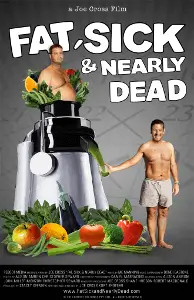
His transformation was remarkable, and you saw it happen over the course of the documentary. By the end of the ninety days, he was completely healthy—off his medication, no more skin rashes, happy and healthy and thin.
Only thirty minutes after watching that documentary, I had a receipt from Amazon in my inbox for my new Breville Juicer.
All thanks to Joe Cross, whose documentary showed his remarkable transformation in a bold, personal way.
This documentary is almost the perfect example of proof—showing your audience the remarkable outcomes that are possible for them.
After watching Fat, Sick & Nearly Dead, I didn’t need to hear a pitch. The proof of Joe Cross’s transformation did it all for me.
If there had been an affiliate link mentioned at the end of that documentary, I would have been more than happy to use it. I was on the fence initially, but showing that proof sealed the deal and moved me firmly into the “buyer” camp.
If you can show the success you’ve had with a product, your audience will be excited about the possibility of achieving the same success.
Joe’s platform for showing his proof was a documentary—maybe yours is your blog, or a podcast you're starting, or video, or all of the above.
Whatever it is, give your audience tangible proof—data and demonstration—that the products you’re promoting can change their lives for the better.
Segment 5: Pitch
The last part of the pipeline, before you get to a conversion or sale, is the actual pitch or sell.
There’s a reason this comes last—because, as I mention throughout this guide, trust is key. You shouldn’t start directly promoting a product until you’ve earned your audience’s trust and know the product is something they will benefit from.
Here’s the great part: If you’ve done things correctly to this point, the pitch phase should be the shortest and least aggressive part of the pipeline.
The more you focus on building a relationship with your audience, recommending products that align with their success path, sharing your experience using that product, and providing tangible proof of that product’s benefits, the less important it becomes to actually pitch the product directly.
So yes, you can reduce the amount of pitching you have to do by focusing on the first four stages of the pipeline.
But at a minimum, you’ll still need to enable the sale. You need to make sure people have a way to click on your affiliate link to buy the product!
This means creating a point of sale where you insert one or more calls to action (CTAs) to click on the affiliate link and purchase the product. You have lots of options in terms of where to put these links and CTAs:
- Emails
- Blog posts
- Landing pages
- Podcast show notes
- Webinars
- Social media messages
So is it as simple as just adding your link to an email or blog post and watching the commissions roll in?
Not so fast!
There are a few crucial tips to keep in mind when it comes to adding your affiliate links at the point of sale.
1. Be honest
When you provide a link, always be clear that it’s an affiliate link that will earn you a commission for each sale.
In fact, if you do everything in the pipeline leading up to this point, this will actually help you, because people will want to pay you back for everything you’re doing for them.
Some people may not know about affiliate links and commissions, and will sometimes open a new window to buy a product.
By being honest and upfront that you’re using affiliate links, you’ll help ensure you’re getting all the affiliate commissions you deserve.
2. Offer support
In addition to telling them it’s an affiliate link, offer to answer questions and provide support if needed.
This is a great way to show your audience, right at the point of sale, that there’s someone there to help them if they need it.
Yes, this also means someone to blame if things don’t go well—but since you’ve already vetted the product and learned how to use it, you shouldn’t have any problem taking on that responsibility.
3. Provide multiple opportunities
Give people more than one chance to click through your affiliate link.
Take blog posts, for instance, since they’re probably the most popular way to share affiliate links. A lot of times, business owners will just link the first mention of an affiliate product in a post.
If their reader misses it—or keeps scrolling, intends to return, then forgets to scroll back up—well, you’ve lost your potential commission.
Instead, add a link near the beginning, middle and end of a post.
Also remember that, beyond just blog posts, there are lots of ways and places to share your affiliate links, including:
- YouTube videos
- Emails
- Podcasts
- A “resources” or “tools” page—in fact, my tools page here on smartpassiveincome.com is my most profitable page.
4. Offer a bonus
Offering a bonus with an affiliate product is a great way to make sure your audience goes through your link and not someone else’s.
Lots of people use the bonus technique, but many don’t use it to its greatest potential.
They’ll throw in random things that aren’t something the potential buyer needs. If you really want to knock bonuses out of the park, create a bonus that truly complements the product you’re promoting.
This could be something like:
- A quick-start PDF guide on how to use the product
- Access to something you have that complements the product—if you’re selling a juicer, you can provide a recipe guide to go along with it
- A coupon code or discount on a related product or service
Get creative!
5. Remember why
Finally, remember why you got into affiliate marketing.
It’s not for the commissions. It’s for your audience—to help them achieve something.
It’s your responsibility, as someone with a platform and an audience that trusts you, to give them the products they need to achieve success.
Your commissions are ultimately a byproduct of how helpful you are to your audience. So aim to be incredibly helpful, and you will earn more in the long run.
When you approach affiliate marketing in a way that keeps people around and doesn’t rely on the pitch, but rather everything that happens before that—the relationship, the product, the experience, and the proof—you’ll set yourself up for maximum success.
Remember: Use affiliate marketing as a tool to help your audience, and the commissions will come!
Affiliate marketing examples
What does affiliate marketing look like? If you’ve visited my website, you may have come across my Tools page.
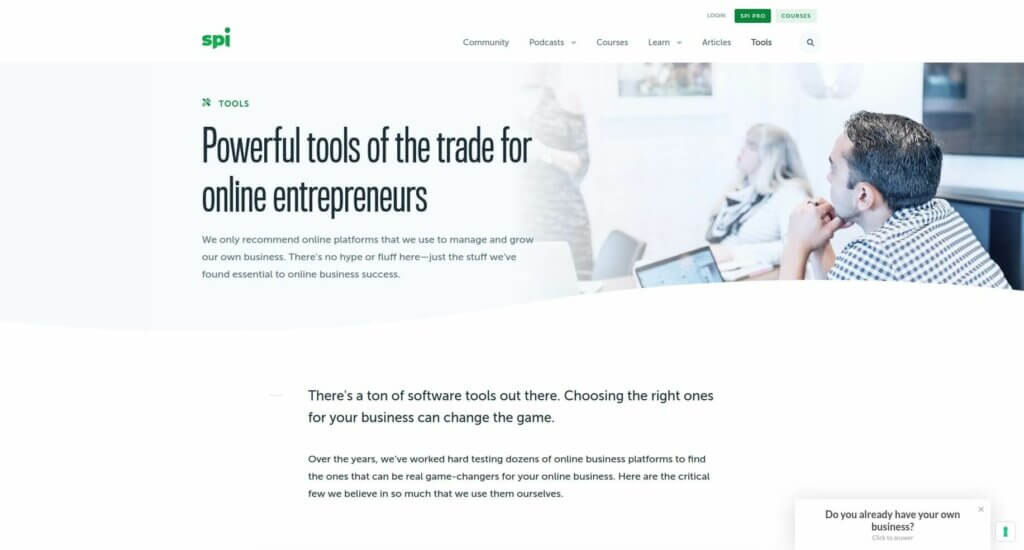
This page contains a list of recommended resources—products, services, apps, and more—to help my audience build their own online businesses.
Many of the links on this page are affiliate links, meaning I receive a commission if someone clicks on the link and purchases the product or service it links to.
Here’s what someone sees if they click on my affiliate link for Bluehost, the web hosting company I use and recommend:
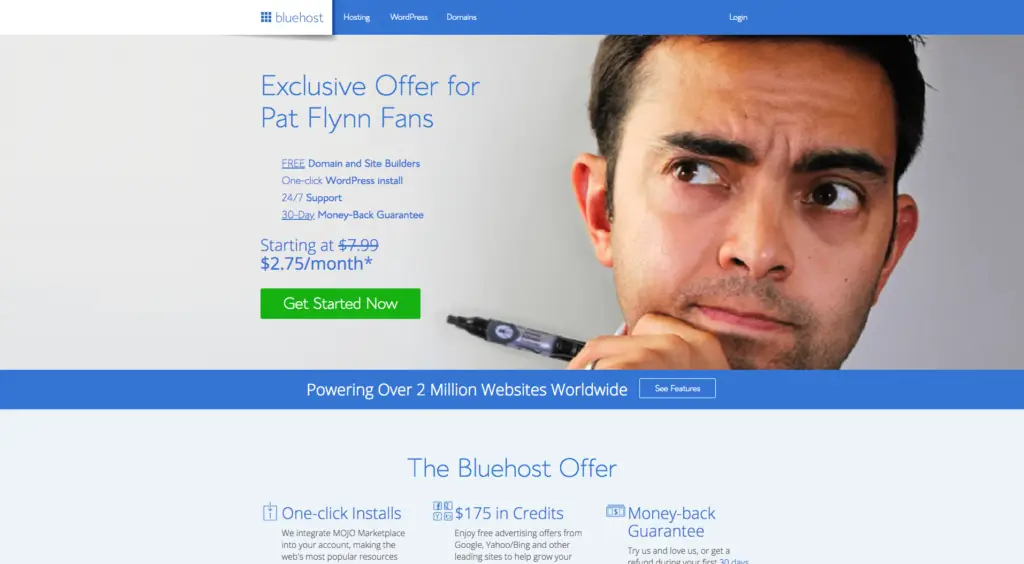
And here’s what they’ll see when they click on my affiliate link for Kit, the email service provider I’m happy to recommend:
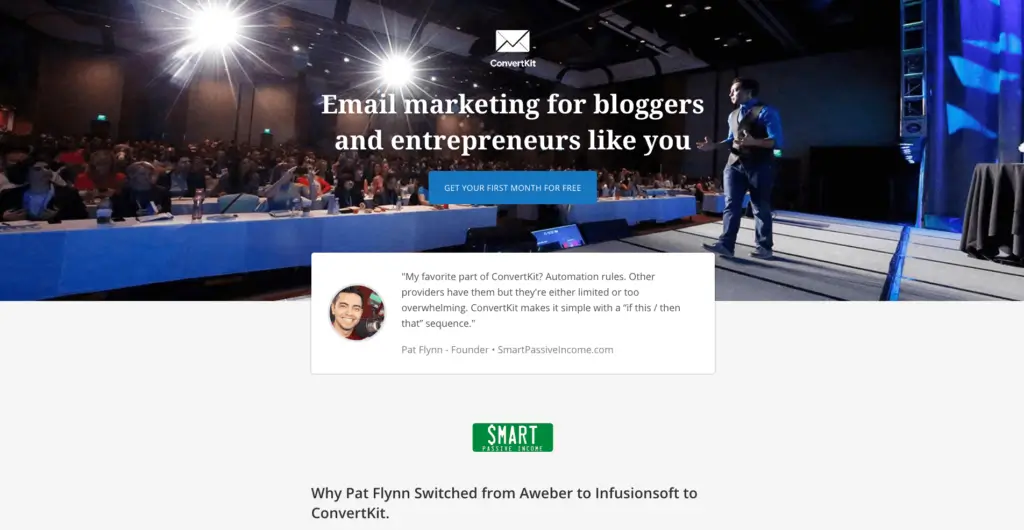
As we’ll further discuss below, you can also earn affiliate commissions by signing up with an affiliate network. One of the most popular is the Amazon Associates program which you can read more about here.
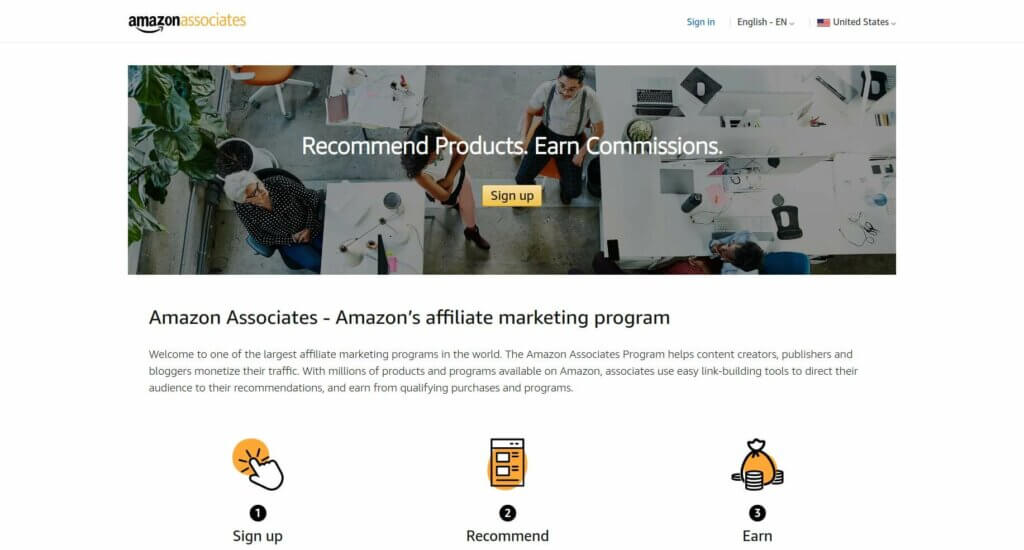
You can easily find tons of other examples of affiliate marketing “in the wild.”
For example, Create a Pro Website is an affiliate marketing website and YouTube channel that creates tutorials on anything and everything related to “how to create a website.”
They do a good job of offering value through demoing products (which we’ll see in the case study below is a great affiliate marketing strategy), while working in their affiliate links where it makes sense.
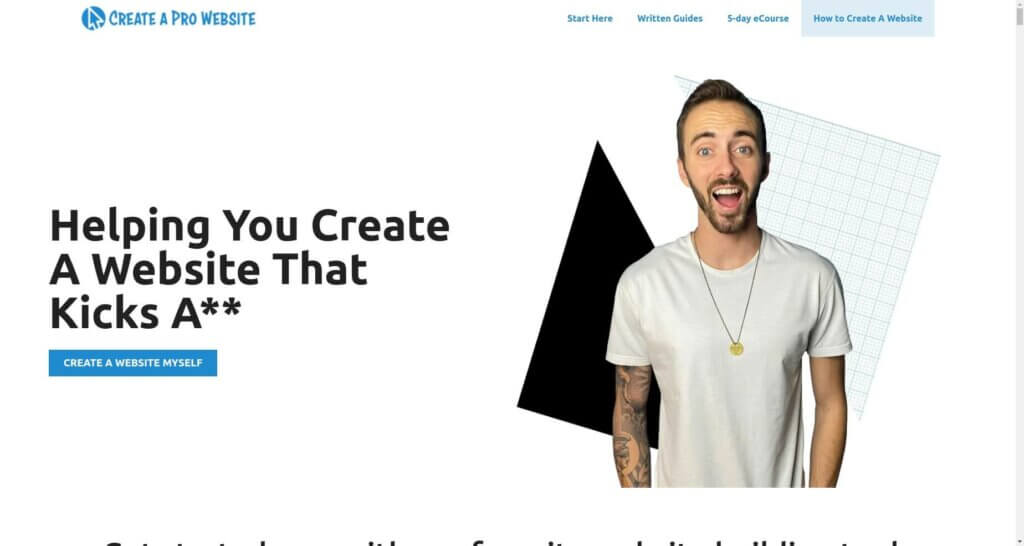
Freelancing.school is a particularly good example of focusing on building relationships with an audience first by offering extras like a community of like-minded individuals and a free course to help people find success with their freelancing careers.
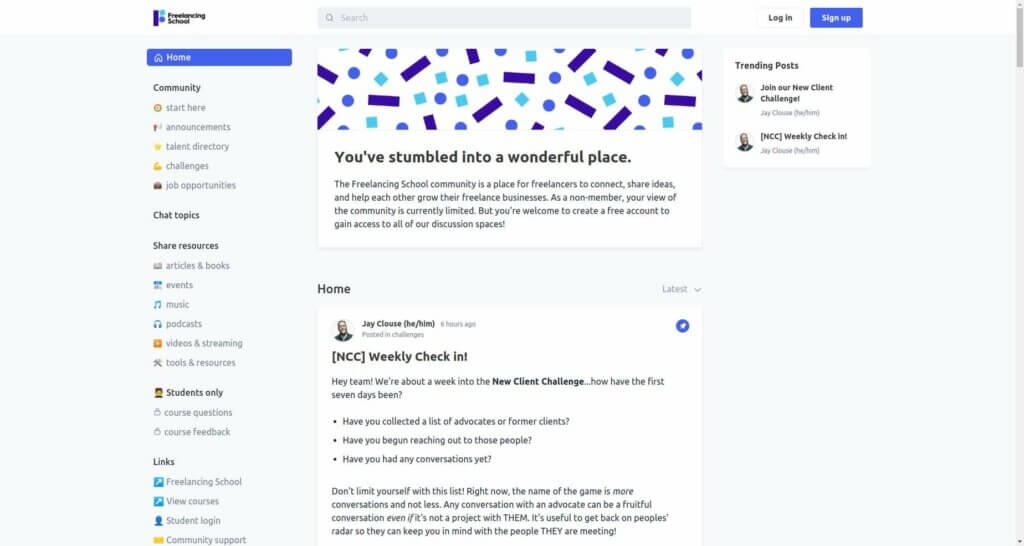
These days, even well-established news outlets like the New York Times are becoming affiliate marketing websites!
The example here is NYT’s Wirecutter section, which reviews products and offers tutorials on everything from How to Clean a Toilet the Right Way to Everything You Need to Make Hot Pot at Home.
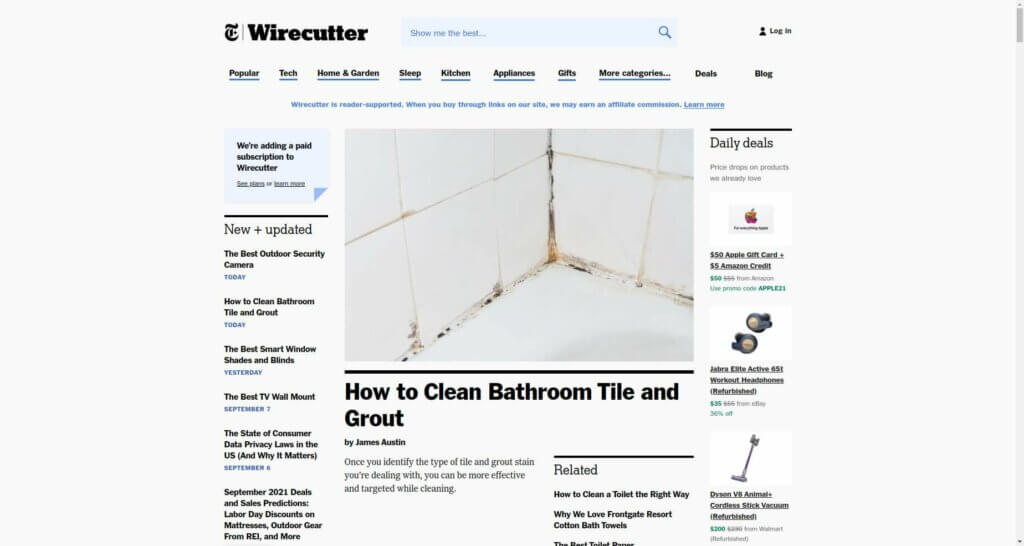
Affiliate marketing is essentially about sharing your affiliate links, so however you choose to share those links—whether on your website, on social media like X, Facebook, or YouTube, or via emails to your list—well, that’s affiliate marketing in action!
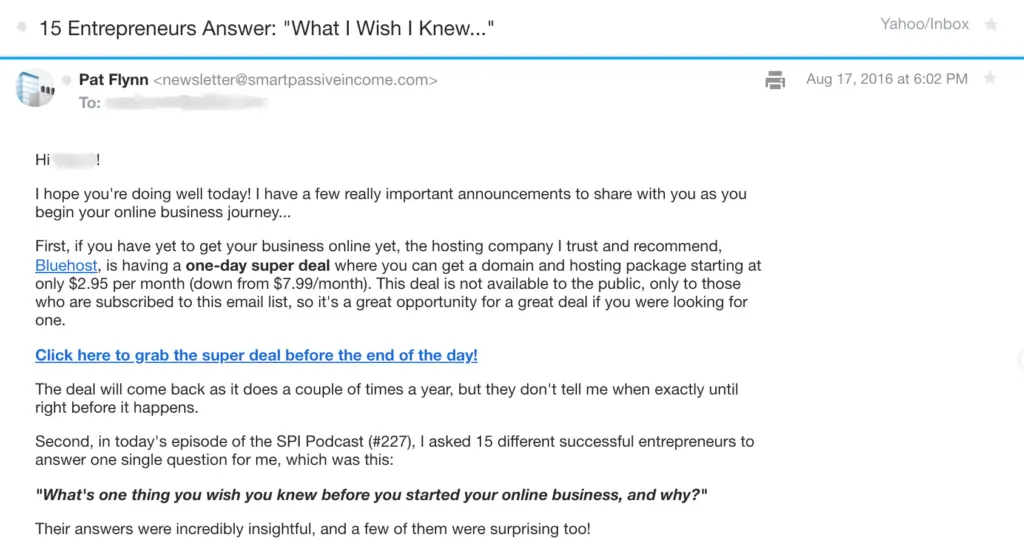
Affiliate marketing case study: SPI + Kit
Next up, I’m going to share a case study to show you what effective affiliate marketing looks like “on the ground.”
This case study is based on a product I’ve recommended for a long time that’s also become one of my biggest drivers of affiliate income.
From 2015 to 2017, it brought in a whopping $315,000 in affiliate revenue.
Kit (formerly known as ConvertKit) is an example of a product I promote as part of a long-term strategy.
It’s a great example of an affiliate resource I promote to my audience that can benefit and serve them over the long term and hopefully I earn a healthy affiliate income at the same time.
Although I love and use Kit myself (and the founder, Nathan Barry, is a good friend of mine), the point of this section is not to promote the product.
Instead, I’m here to show you how I’ve promoted Kit.
And I’ve done so in a very specific way: by D-O-I-N-G. This strategy has helped me be very successful in promoting Kit as an affiliate.
Those letters stand for:
- Demo the product
- Offer answers to your audience about the product
- Interview the founder of the product
- Never recommend more than one of the same kind of product
- Get the product in front of your people
Before we get into the details of the D-O-I-N-G approach, here’s a little background on how I got started promoting Kit as an affiliate.
ConvertKit (now Kit) wasn’t my first email service provider.
My first one, back in 2010, was AWeber.
AWeber was great as an entry-level email tool, and I also promoted it as an affiliate, making up to $2,000 a month at one point.
And that income still comes in each month, because I get paid a recurring commission for every month a person I refer stays on, even though I’m not actively promoting the product anymore.
Eventually, though, I needed an email service that was easier to use with more advanced features.
For a while, I turned to another tool called InfusionSoft, which was good, but still not exactly what I needed.
Shortly after I started using InfusionSoft, a friend of mine, Nathan Barry, reached out to me to ask how I was doing with the new tool.
Nathan had recently started a new email service provider, ConvertKit.
We met for coffee in downtown San Diego a couple weeks later.
After catching up about personal stuff, the conversation turned to business.
Nathan asked me a lot of questions about my needs, experiences, and desires as a blogger, podcaster, and digital marketer.
He didn’t try too hard to plug his new tool, except toward the end of our conversation when he said, “Hey, if Infusionsoft doesn’t work out for you, let me know, and we can see how you might be able to use ConvertKit.”
I didn’t think much of his offer for a little while.
But over time, I started growing more and more frustrated with Infusionsoft.
So I reached back out to Nathan to see how ConvertKit was doing.
I wasn’t surprised to hear that they were experiencing constant growth month after month.
New features were being added on a regular basis, and after a couple of side conversations with other users, I was happy to hear extremely positive reviews.
That’s when I asked Nathan to demo the current software for me over Skype—and I was blown away.
I loved the intuitive user interface, along with the tool’s segmentation and automation capabilities.
Seeing what the tool could do, it wasn’t long before I decided to switch from InfusionSoft, and Nathan’s team even helped me migrate my email list.
I’ve been using Kit very happily ever since.
That positive experience has shown up in terms of my affiliate revenue from Kit, too.
Although I was happy with my AWeber affiliate income, since shifting to Kit, I’ve broken into a new level of affiliate income and success.
Part of that is because Kit is an amazing tool—but a lot of it has to do with how I leveled up my promotional efforts with the D-O-I-N-G approach.
Let’s learn all about it now!
D: Demo the product
Affiliate marketing is technically easy to do.
All you have to do is get your affiliate link and start sharing it with your audience. It’s easy to stop there and think you’ve done enough.
But if you’ve been with us since the beginning of this post, you know that a crucial practice in affiliate marketing is to take products that are not your own and treat them as if they were your own.
If you were selling your own product, you’d show people what they were going to get before they got it, right?
But most people who do affiliate marketing just share a link and a couple of sentences and call it good.
Instead, as we talked about above, you need to show the product in action. That’s where the demo comes in.
People are more likely to buy when they know what they’re getting and exactly how it will help them.
The best way to do this is with a video demo that shows people two main things: 1) how they can benefit from the tool and 2) how to use it.
In 2015, I created a YouTube demo of ConvertKit.
In the video, I talk about the benefits and features that made me fall in love with ConvertKit: ease of use and setup, beautiful design, powerful statistical analysis, segmentation and tagging, and a lot more.
Along the way, I show screenshots of ConvertKit in action, so viewers can see exactly how to accomplish different things using the tool.
When you search “ConvertKit demo” or “ConvertKit tutorial” on YouTube or Google, my demo is typically one of the top results.
It’s been viewed 30,000+ times, and it’s driven a ton of traffic both back to my website and through the affiliate link mentioned in the video description.
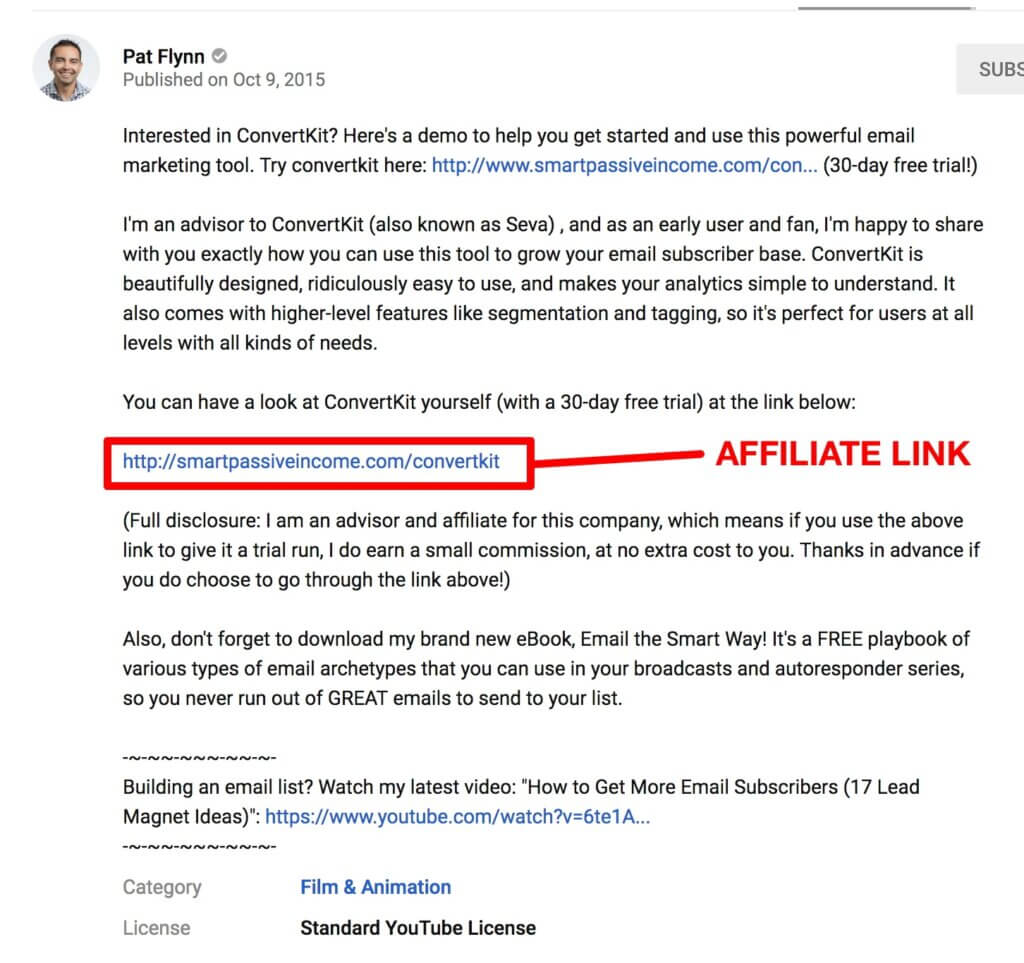
When you’re thinking about creating your own demos, you want to show not just the features and benefits of the tool, but also make it fun and show your personality.
In the ConvertKit demo video, although you don’t get to see much of me (it’s just my voice with a Screenflow video), I’m just being myself.
I could have made a stiff, mechanical demo that was all about just conveying the relevant information—and it would have been shorter too—but who wants to sit through that?
Instead, I’m relaxed and sharing my honest opinions, using words like “cool” and “powerful” (and yes, “nice”!) to convey my excitement about ConvertKit’s capabilities, in the hopes that excitement will be shared by my audience too.
You want to create a thoughtful demo that shows you care about creating informative content while also keeping your audience engaged and excited to try the tool.
And of course, make sure you include calls to action (CTAs) to go through your affiliate link, as well as disclosing your affiliate relationship with the company.
You don’t want to bombard your audience with these CTAs, though, and if you’ve provided enough valuable, engaging content in the demo, you shouldn’t have to include more than one or two CTAs.
In my ConvertKit demo video, I only mention my affiliate link and status twice very briefly, at the very end:
“Go ahead and check it out: smartpassiveincome.com/kit. And I look forward to seeing how you are able to use it. As I said, Kit is constantly releasing new features to make our lives even easier. Hopefully, this is helpful. Cheers. I appreciate you. That affiliate link one more time, which I do get a commission from if you do go through that link, is smartpassiveincome.com/kit. Thank you so much, and I’ll see you in the next video.” [Full Disclosure: I’m a compensated advisor and affiliate for Kit.]
In other types of content, such as blog posts, I might share my affiliate link a little more often, for instance at the beginning, middle, and end of a post.
But in either instance—whether a video demo or a blog post—the content itself does the “heavy lifting” of sparking someone’s interest in trying out the product, so I don’t have to hit my audience over the head with my affiliate link.
O: Offer answers
The next step is to offer answers to people’s questions.
This is huge, because if a person asks you a question about a product, they’re likely already interested in it.
They may just be on the fence, and if you can be the one to answer their questions, that may give them the final piece of the puzzle to go ahead and make a purchase, knowing there’s someone there to provide product support if they need it.
That’s why I always offer support for Kit and the other affiliate products I promote.
When questions come in, I’m quick to answer them because I want to make people feel comfortable with the idea of spending money on this thing I’m promoting.
The combination of the demo and offering answers is powerful.
If you put together a thorough and helpful demo, you’ll likely answer a lot of people’s questions in the demo itself.
But even if your demo covers all the bases you can think of, you should still offer to answer people’s questions.
Why?
Even if they don’t have any, just the fact that you’re offering this assistance will make people feel more comfortable and inclined to buy the product through your link. Remember, you want people to trust you and feel secure in their investment.
Want an example of how you could offer support in this way? Here’s what I say toward the end of the ConvertKit demo video I mentioned in the previous section:
“I’m here to answer your questions too. If you’re watching this on YouTube, ask your question below; I’ll do my best to answer it. If you’re watching this on the SPI blog, go ahead and leave your question in the comments section. Or, if you want to send me an email, that’s totally fine too. Happy to help, because I really believe in this product.”
I also offer to answer people’s questions about my affiliate products via other channels, including email and social media.
People often reach out to me on X, because X makes it easy for me to reply quickly.
It helps that there’s a character limit, too, because it forces both parties to get to the point.
Offering to answer questions also makes people feel secure about the fact that if they were to have questions later on, once they’re up and running with the product, you’ll be able to answer them.
This is especially important if the product you’re promoting is of a highly technical nature.
So, offer support and people will be more at ease about buying through your affiliate link.
I: Interview
When you’re promoting an affiliate product, having other people talk about the product, and the story behind it, can be a powerful way to get people excited about it.
A great way to do this is to start a podcast and interview the founder of the product on one of your episodes.
ConvertKit (Kit) founder Nathan Barry joined me on episode 244 of the Smart Passive Income podcast, titled “Bootstrapping a Business.”
But here’s the thing: we didn’t actually talk about the product itself much at all!
We talked about his story, and how he bootstrapped the company and grew it successfully.
We talked about how I met him and built a relationship with him and his company, eventually becoming an advisor to ConvertKit (Kit).
Because the product itself—as well as my affiliate relationship with Kit—was not the focus of the interview, listeners were able to focus on how much care and quality Nathan put into creating the product and cultivating the company’s culture.
As a result, in a way, they were able to start building a relationship with him too.
I only mentioned my affiliate link at the very end in a casual way, as almost a natural conclusion to the episode.
The ability to augment your affiliate marketing efforts by interviewing the founder of a product you’re promoting is a great reason—among many—to have a podcast.
Even though Nathan and I recorded the episode in 2016, people are still downloading and listening to it today.
I also reference the episode a lot when I mention ConvertKit (Kit), which helps make it an active resource in promoting my affiliate relationship.
So, if you’re planning to promote a new affiliate product, see if you can get the founder of that product on your podcast.
If you can’t get access to the founder for a podcast interview, consider an email interview or maybe a video interview over Skype or Zoom.
And if you can’t get the founder, try for somebody who represents that company at a high level.
If that’s not possible either, aim for somebody who’s used the product and knows it well, hopefully somebody your audience is already aware of and respects.
In the How to Start Affiliate Marketing above, we talked about the importance of promoting a product yourself, showing how much you know and love it and the great results you’ve gotten from using it—i.e., showing proof.
When you’re the only one doing the showing, there’s always the risk, however small, that your efforts may come off as too promotional.
On the other hand, as the Nathan Barry podcast episode showed, interviews are powerful because most of the selling that’s done is indirect—and often, you won’t have to talk about the product much at all.
N: Never recommend more than one of the same kind of product
Next up, you should never recommend more than one solution for a specific type of problem.
This is a really important rule, and one that generates a lot of debate.
And there are exceptions, which we’ll talk about in a second.
But first, what exactly do I mean by never recommending more than one of the same kind of product?
Well, if I were to recommend Kit, but also recommend other email solutions like AWeber or MailChimp, it would dilute the strength of my primary recommendation.
You need to pick one, because otherwise people are going to be confused.
I went the route of recommending multiple similar products once, and it didn’t go well.
People said, “Wait, I thought you were recommending this one. But now you’re talking about this one? What’s the difference? How is it better?”
You don’t want people asking themselves even more questions about which product makes sense for them.
That’s why they came to you in the first place!
So, yes, I’ve made my decision, and the only email service provider I recommend to people is Kit.
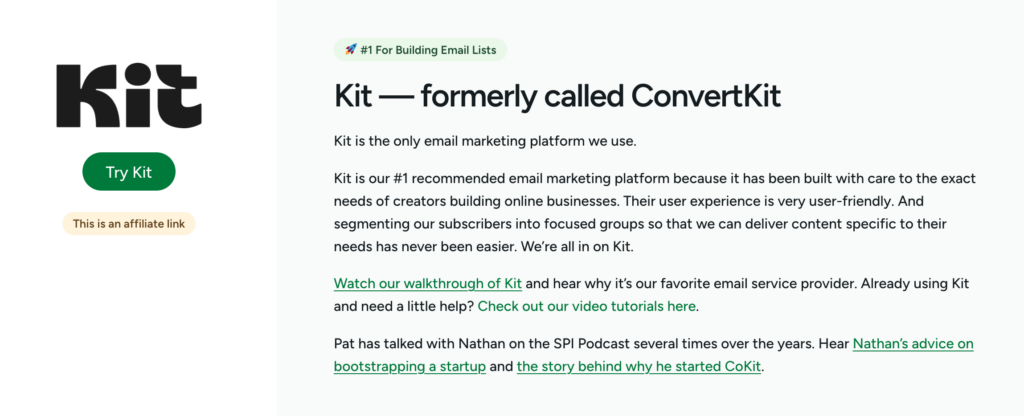
Are you recommending more than one product right now that’s essentially the same type of solution?
If so, you’re diluting your affiliate marketing efforts and reducing the amount of income you can make. Yes, sometimes it’s great to give people options, but it can also work against you.
Now, if someone were to say, “Hey, Pat. I know you recommend Kit, but what other solutions are out there?” then of course I’m going to be honest with them and tell them what other options they have.
I’m not going to say, “Sorry, Dave. There are no other great options out there.”
That would be lying. There are other great email service providers out there.
But the one I use, recommend, and trust will be there to help my audience is Kit.
Plus, as with everything, there are exceptions to the rule.
In this case, only having one recommendation doesn’t make sense for some types of sites.
For example, if you run a vacuum review site, you can’t get away with promoting just one product, as that would go against the entire aim of the site.
You can certainly highlight featured products and recommendations in different categories. But when people are searching for helpful comparisons of similar products, the N rule likely won’t apply.
Here’s another example from one of my own affiliate promotional materials that you might remember from above.
In one of my YouTube videos, I review three different podcasting microphones.
Here’s the key: Even though each of these products is very similar (they’re all microphones), I use the review as an opportunity to differentiate them according to their best uses, then make specific recommendations about which microphone should be used for different scenarios.
For instance, in the video, I end up recommending that you not use one of the microphones for podcasting at all—instead, I recommend another use case that makes more sense for this particular microphone. I’m comfortable including my affiliate link to each of the microphones because I’ve made the effort of differentiating them for my audience.
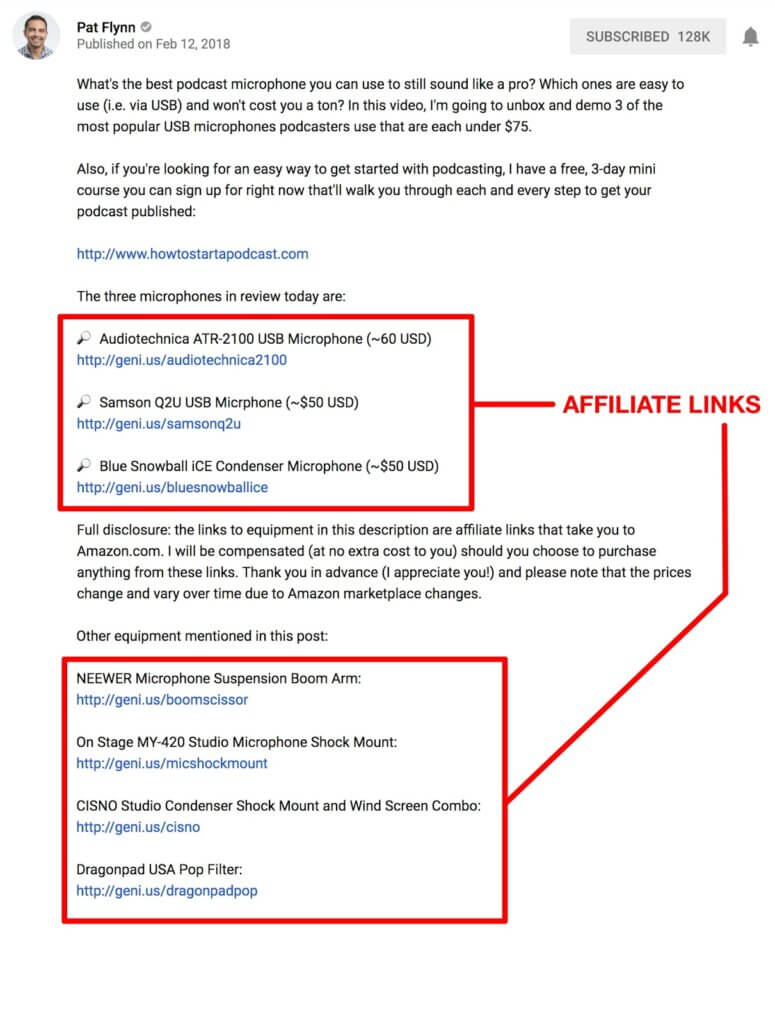
G: Get the product in front of your people
This final one is a big one, and it represents a mindset shift I’ve undergone over the past few years.
Often, people become timid when it comes time to put products in front of their audience.
If that describes you, whether it’s your own product or an affiliate product, then I want you to shift your mindset—to one of excitement about sharing something you know will help your audience.
In fact, it’s your obligation and your role to do that, and you should embrace it. Because if you don’t, you’re not serving your audience in the best way possible.
It’s not about being pushy or aggressive; it’s about being motivated to get the product in front of people.
You’ve done the research, you’ve used the product, you’re offering answers, you’ve created the video demo, you’ve recorded the interviews.
You know the product can help your audience, so get it in front of them!
Talk about it on your podcast, and on other people’s podcasts.
Share it in blog posts.
Create more videos about the benefits and capabilities of the product.
That’s exactly what I’ve done and continue to do with Kit.
I believe in the product, and the company, so it’s my responsibility to get it in front of my audience so they can benefit from it like I have.
I’ve used lots of methods and channels to get Kit in front of my audience, including:
- Blog posts
- Videos (like the product demo)
- Social media messages
- My Resources page
- Podcast episodes (like the interview with Nathan Barry)
When it comes to getting the product in front of your audience, it pays to be creative!
On that note, I wanted to share one more pretty novel way I’ve gotten Kit in front of my audience.
In a March 2018 video, I congratulated ConvertKit (Kit) for a huge milestone—hitting $1 million in monthly recurring revenue (MRR).
In the video, I also shared 8 important lessons for people looking to start and grow a business, ones that came directly from ConvertKit’s (Kit) example in becoming a $1 million MRR business.
The video was a response to a single tweet by ConvertKit’s (Kit) founder, Nathan Barry, about the company’s $1 million milestone.
But I built on that tweet to tell a much richer story about the company and how they were able to accomplish something so remarkable. You can see the whole thing below.
The key in this video is that I didn’t focus that much on the product itself—and especially not on my affiliate relationship with them—but on ConvertKit (Kit) the company, and how they used 8 powerful and ethically-minded principles to grow their business rapidly.
These are principles anyone who’s trying to grow their own business the right way can learn from and implement.
And you can do the same thing I did with this video.
Ask yourself, what can I learn from the success of a company I have an affiliate relationship with?
How can I use that company’s example, and the principles behind its success, to help my audience and deliver them value?
When you do that, you’re getting the product in front of people—but you’re also giving them so much more.
8 best affiliate programs and networks
Reminder: always start your affiliate marketing journey by building a relationship with your audience and never recommend products you haven’t used or don’t love.
That being said, I want to give you a starting point for finding affiliate marketing programs that might be a great fit for you and your business, and give you some insight into what you should consider when evaluating affiliate marketing websites and opportunities.
Note: I’ve used many but not all of the below networks and programs myself, but am familiar with the others from my research and recommendations from friends and colleagues.
So while I’m comfortable sharing them with you there isn’t any direct financial benefit to me for doing so.
For more useful affiliate marketing tools, check out this guide!
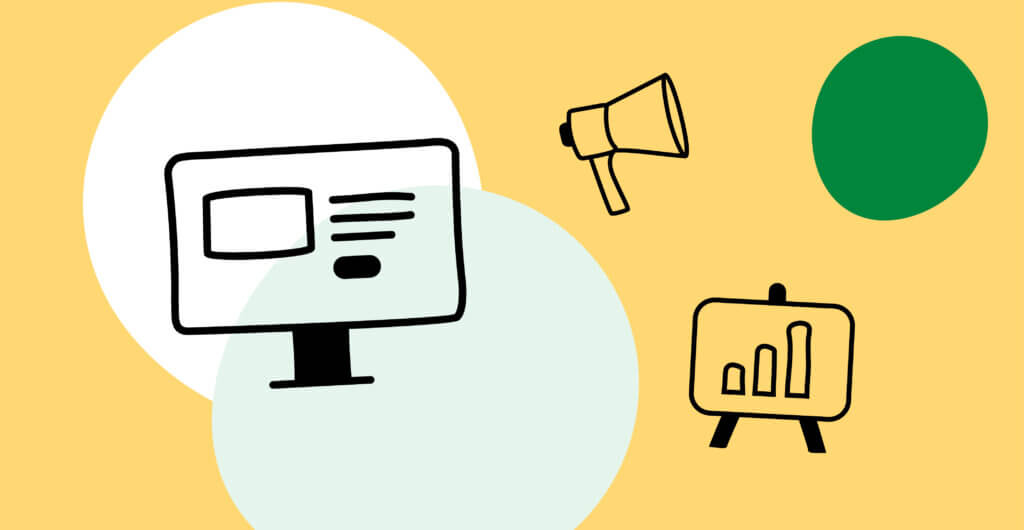
Affiliate Marketing
Monetization
12 Affiliate Marketing Tools to Take Your Business to the Next Level
Want to upgrade the affiliate income potential of your business? This list of 12 affiliate marketing tools features software to help you do just that!
Top affiliate marketing networks
Affiliate marketing networks are platforms you can join to get access to hundreds, sometimes thousands of affiliate marketing products and programs.
Let’s explore a few of the most popular:
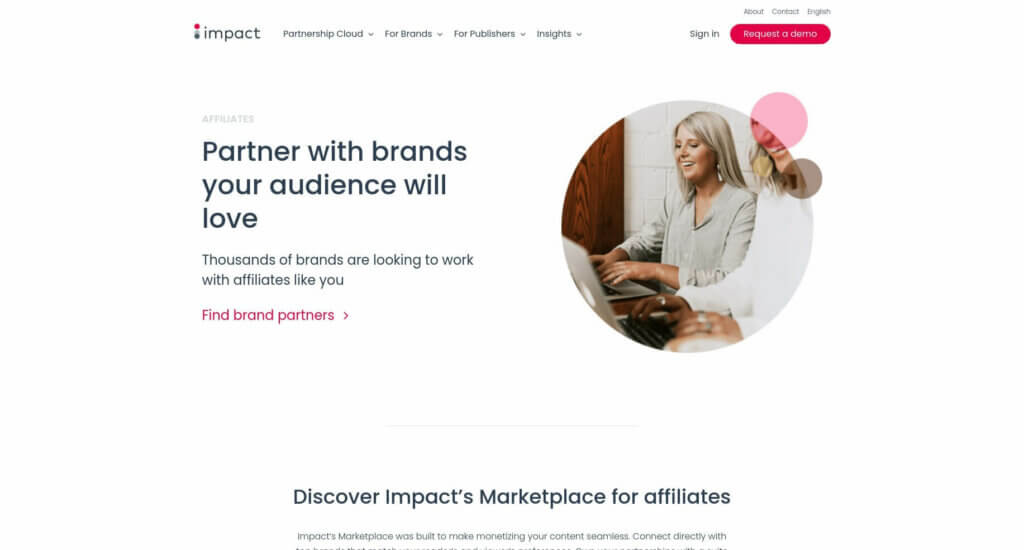
Impact
Formerly Impact Radius, their Marketplace was built to offer content creators a seamless way to monetize their work and offer their audiences a lot of value through a huge list of brands looking to advertise and a suite of tracking and automation tools.
With direct access to global brands like Airbnb, Adidas, and Allstate, flexible payment processing, and robust reporting and alerts, there’s a good chance you’ll find them a great fit for your audience and business.
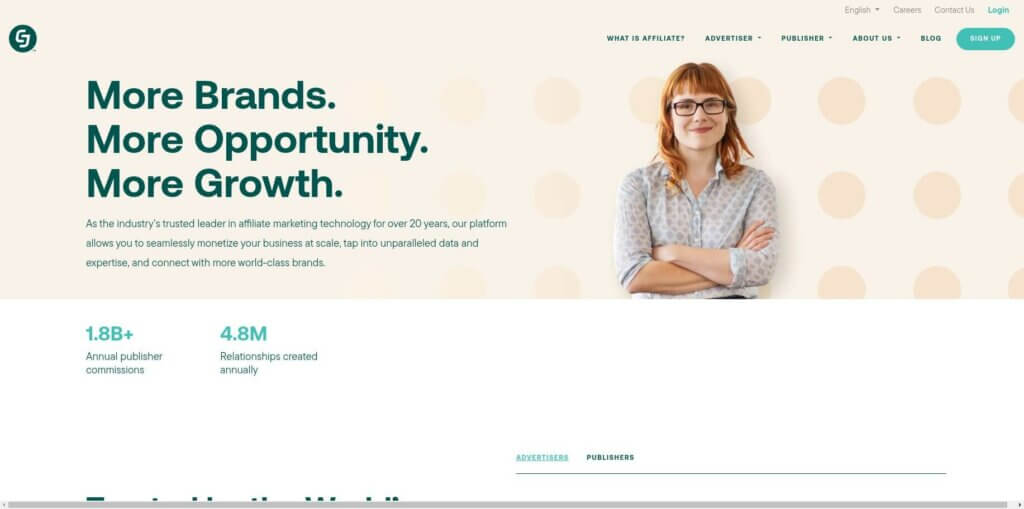
CJ
Formerly Commission Junction, CJ has spent the last 2 decades building relationships with brands and publishers to create an affiliate marketing platform worth exploring.
Advertisers you’ll find here include Priceline.com, Overstock.com, and J. Crew.
CJ also includes some one-click join affiliate programs to make it easy for beginner affiliate marketers to start their journey, while also offering omnichannel tracking (across browsers, devices, etc) and strategic recommendations based on business size, vertical, and region for when you’re more established.
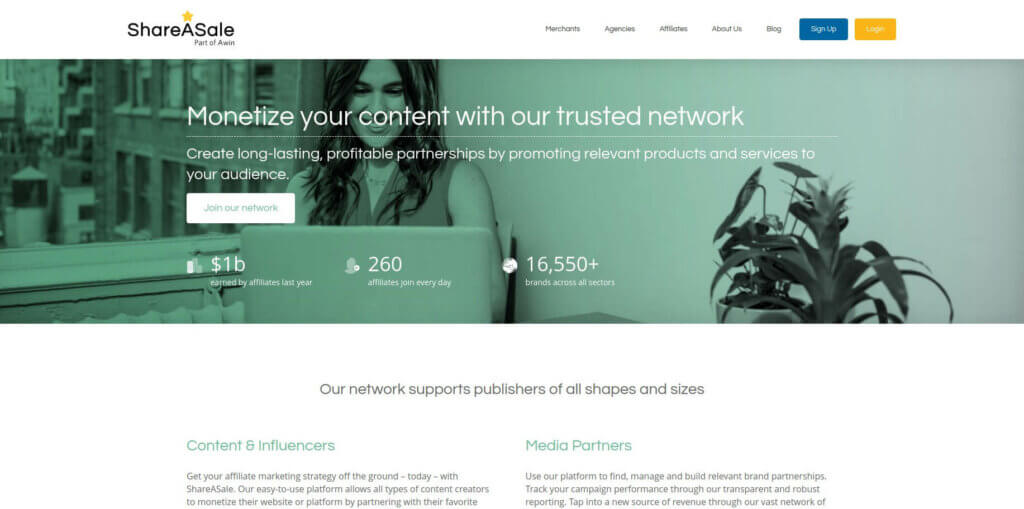
ShareASale
ShareASale helps beginner and expert affiliate marketers alike create profitable long-term partnerships with brands their audience will love.
With 260+ affiliate programs launched every month (businesses like Etsy and Rebook are already on board), a product discovery bookmarklet for quickly generating affiliate links, and a slew of analytics and reporting tools, if you find a product worth promoting to your audience here you won’t be going astray.
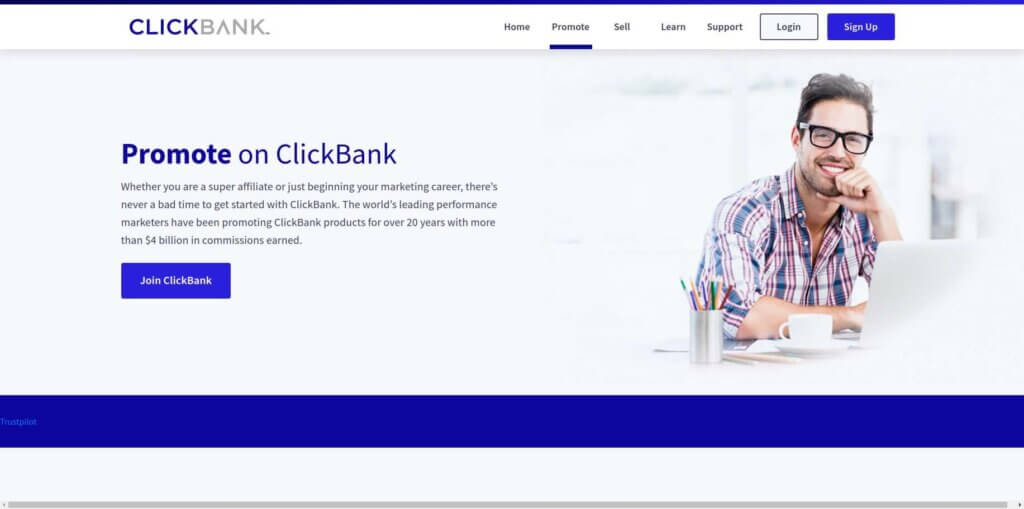
ClickBank
ClickBank has done a good job of owning the information product affiliate program space, offering products like online courses and ebooks that you won’t find as readily on other affiliate marketing platforms.
A word of caution: I’ve seen a lot of shoddy products that were created with an earn-a-dollar first approach on offer so be sure to do your due diligence before recommending what you find here.
If the affiliate product checks out, though, this is an affiliate marketing network you can rely on for ease-of-use and on-time payments.
Best affiliate marketing programs
What is an affiliate marketing program?
Beyond the products you can promote, affiliate programs include the commission rates, payment terms, marketing materials, and promotion rules a business with an affiliate product offers affiliate marketers like you.
Again, please do not start by seeing the financial opportunity in these programs and working backward from there to fit your business around them.
These affiliate marketing programs are great examples of what’s available to you as an affiliate marketer so use them, but only if they’re truly going to benefit the audience you’ve built a relationship with.
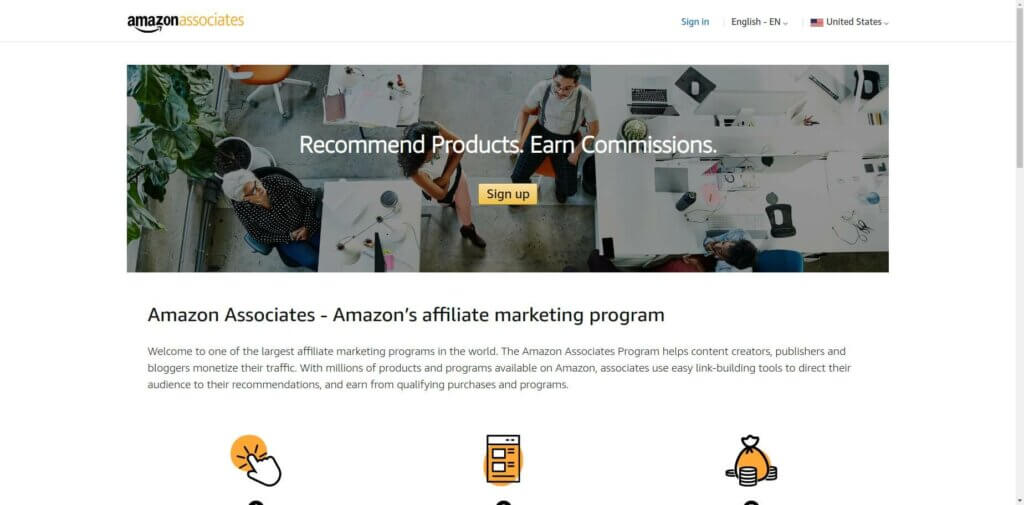
Amazon Associates
You know Amazon, now you know about their Amazon Associates affiliate program!
They’re the world’s largest retailer so if your business is related to any sort of physical product, you’ll find a quality option to offer here.
Worth noting, Amazon recently caused quite a stir by drastically lowering their commission rates (from 8% to 4% in many categories), which is a good example of why building relationships with your audience and eventually creating your own offerings is so important.
That being said, on top of having the world’s largest catalog, Amazon has poured billions into optimizing their site for conversions and you earn a commission for any product purchased visitors purchase within 48 hours of clicking your links, so they’re still a top recommendation for physical affiliate products.
Learn more about making Amazon Associates work for your audience and business in my Amazon Affiliate Marketing Program guide here.
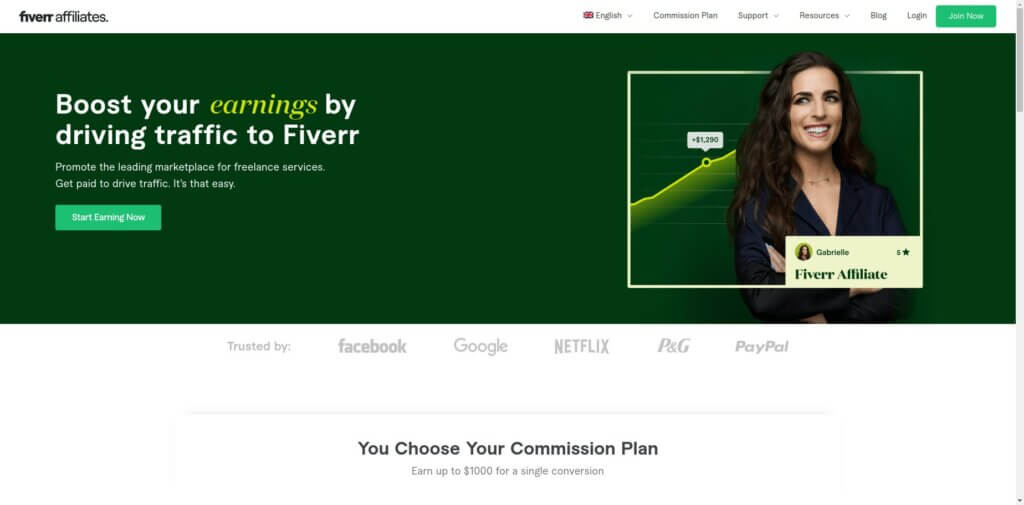
Fiverr Affiliates
Fiverr, the popular marketplace for freelance services, offers a few different affiliate products and services that might be a good fit for promoting to your audience.
These include:
- Fiverr, the freelance marketplace offering services for everything from graphics and copywriting to complete websites and custom apps.
- Fiverr Business, their suite of premium tools and vetted talent for business owners.
- Fiverr Learn, their online courses platform.
- Fiverr affiliates, their affiliate program (links to Fiverr on this page are NOT my affiliate links)
If you work with clients who might need support from freelancers available on Fiverr’s platform or have an audience of entrepreneurs, a partnership with Fiverr is worth considering.
In addition to being a good fit for a broad set of businesses, I decided to add Fiverr to my list of affiliate marketing programs because they introduce some interesting commission structures you can find in some other programs.
Many affiliate programs will offer flat commissions per sale.
In Fiverr’s case, this includes a $15-150 Cost Per Action (CPA), depending on the service the person you refer buys.
They also offer percentages of the sale price, 30% for Fiverr Learn courses as an example.
Something you don’t see as often but is very valuable as an affiliate marketer is a revenue share option.
In this case, Fiverr’s “Hybrid” payment structure lets you earn $10 for a first-time purchase and 10% of all further purchases made by someone you refer for 12 months.
The beauty of revenue share commission structures is twofold:
- You have the potential to earn a lot more than flat-rate plans
- Revenue share smooths out your earnings curves
For example, as people get outside during the summer months, you’ll sometimes see a natural dip in traffic and sales for software-based products as people are spending less time on their computers.
But, if you earn a piece of the monthly fees a person you refer pays for their software, you’re less likely to see a dip in your monthly revenues.
HostGator Affiliate Program
HostGator is a popular web hosting and domain registration company you’ve likely heard of because their affiliate program is so popular.
And because so many different audiences from entrepreneurs to crochet enthusiasts can benefit from having a website, chances are your audience may be interested in a web hosting service.
While I use and prefer Bluehost because I know them, trust them, and have a great relationship with their team, I mention HostGator here because it shows us another element of affiliate marketing commission structures: pay for performance.
What does this mean exactly?
HostGator offers a tiered payments structure based on how many monthly signups they receive from you:
- 1-5 signups per month: $65/signup
- 6-10 signups per month: $75/signup
- 11-20 signups per month: $100/signup
- 21+ signups per month: $125/signup
Again, please think about your audience’s needs and the quality of the product/service first, and commission rates and structures second.
But if all else is equal between two tools, it’s worth investing your time and effort in creating helpful content and building a partnership relationship with the company that helps you grow your commissions as you grow their sales.
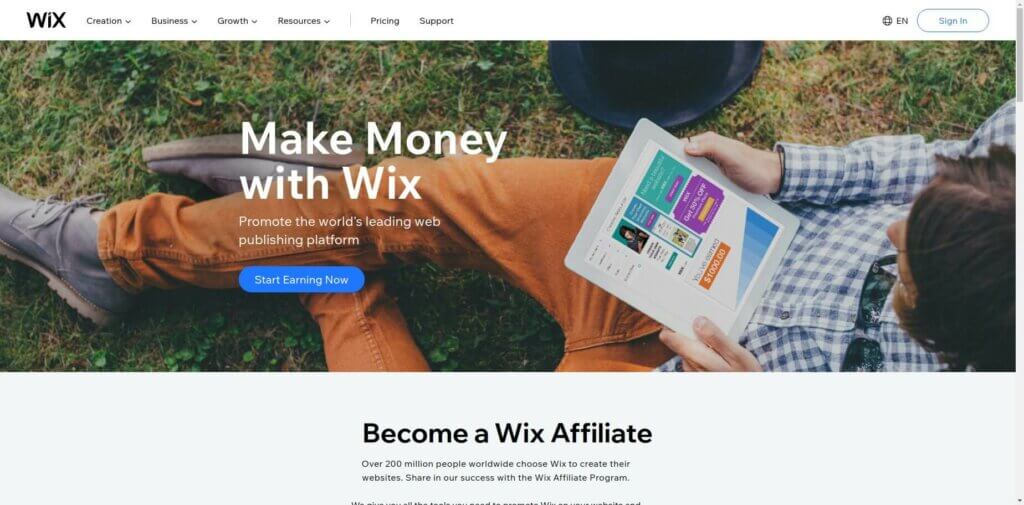
Wix Affiliate Program
Our last affiliate marketing program example is Wix, the popular website-building software.
I mention them here for two reasons:
- Again, website-related products and services are useful for a lot of audiences, so chances are Wix might be a good fit for you and yours.
- They’re an example of one other element of affiliate marketing program commission structures – minimum payouts.
To point 2, many affiliate programs have minimum earnings targets you have to hit to get paid. In Wix’s case, you have to generate at least $300 in commissions before they’ll send your earnings to your bank account.
This is a fairly common practice and thus a nice example of why I say affiliate marketing is not a get-rich-quick scheme.
Affiliate marketing tips for beginners (and experts)
Affiliate marketing is not a “push-button” solution. It takes focus and commitment, and a certain choreography to make it happen the way you want it to.
Thankfully, there are things you can do to increase the number of people clicking on your affiliate links and buying the affiliate products you’re promoting.
So below, let’s go over my 22 tips to help you succeed with affiliate marketing.
Some of these are things we’ve covered already but they’re definitely worth repeating!
Others will be new to you. But all of them are potentially important keys as you build your affiliate marketing business.
22 affiliate marketing tips for beginners
- Build trust first
- Know the product
- Ask yourself: Can I trust the product will be good for my audience?
- Show your own results (Proof)
- Help your audience learn as much as possible about the product (Evidence)
- Become a source of information and support for a product
- Use your website (or build one!)
- Give people multiple opportunities to click on your affiliate links
- Disclose that your links are affiliate links
- Keep track of your click-throughs
- Use your own language to promote your affiliate links
- Thank people in advance for going through your affiliate links
- Thank people afterward for going through your affiliate links
- Establish a relationship with the owner of the product
- Offer special deals just for your audience
- Ask for a landing page on the owner’s site
- Focus on how it will help your audience (not features, but benefits)
- Believe in your recommendation
- If it doesn’t work out, try another offer
- Test, test, test
- Make your own product instead
- Be patient
Laying the groundwork
A great affiliate marketing strategy starts with a solid foundation. Here are the fundamentals you need to keep in mind as you’re getting started.
1. Build trust first
Surprise, surprise! My number one tip is to build trust!
Trust takes time to build, and energy to maintain. This is why I wanted to give you this tip first because I want you to expect things to take a while, and to focus on building your community and the trust within that community first.
The recommendations for products and the affiliate love you’ll get from your community comes almost naturally after you EARN that trust from them.
Trust is earned through 2 things:
- Giving—and giving away as much as possible. Content, information, freebies, high-value stuff, and sometimes even your own time.
Online karma does exist, and the more you give away, the more you get back in return—and maybe not from the very same people you gave to, which is why the second piece of earning trust is . . .
- Recommendations from others. Get on other people’s radar and have them do the marketing for you. Not for the affiliate products that you’re promoting, but you, or your brand.
YOU.
Trust is earned faster through the friends and relationships people already have with each other.
That’s why it’s important to give to everyone, no matter how big or how small they may seem to your brand.
Because you never know—they may know somebody who knows somebody who will become your biggest client, or a multi-product customer, or maybe the window to an opportunity that would have never happened otherwise.
Relationships with other people are extremely important to your success, and you won’t have sustainable success with your affiliate marketing until you earn your audience’s trust.
2. Know the product
One of the biggest mistakes I see people make when attempting to sell a product as an affiliate is not knowing much about the product.
This usually stems from a desire to push a product for the primary purpose of earning money from it, which is a no-no.
Don’t get me wrong—it’s smart as a marketer to take into account what the commission is and how much money you might make per sale, but the commission shouldn’t drive the decision to promote a product.
It should be just one part of the entire decision to promote a product.
So, know the product.
Why?
Because if you really know the product, it will shape how you promote it, what you say to promote it, and the overall feeling people will get when you offer or recommend it.
So what’s the best way to get to know a product? Use it. Get to know it.
If you’re not extremely familiar with a product, don’t promote it.
It may not be a rule most affiliate marketers follow, but it’s one I’ve followed for years with great success, because it helps with tip #1, building that trust factor with my audience.
All of the products I promote on my Tools page, such as Kit for email marketing, Leadpages for landing pages, and Bluehost for web hosting, are ones I’ve used myself extensively.
I know all about them, and I’m very comfortable with how they work, so I’m happy to recommend them to my audience.
This goes along with tip #3, which is . . .
3. Ask yourself: Can I trust the product will be good for my audience?
This is crucial. It’s the idea that you should be sharing or recommending something that will actually help your audience.
Do you trust that after you send people through your link that the sales page for that product, the product itself, and the customer service for that product, if any, will be good to them?
This is important, because the dictionary definition of affiliate is:
Officially attach or connect to an organization.
The moment you decide to promote something as an affiliate, you attach yourself, your brand, and your business to that company and that product, and if that product isn’t going to be good for your audience, then it’s going to reflect ultimately on YOU.
If it’s an awesome product that totally helps them out?
Awesome! You’re going to look that much better and be thanked for it, and it’ll be a win–win–win for everyone.
If it’s bad? It’s a lose–lose–lose for everybody.
I was once approached to promote a product I knew would sell well and make me a lot of money.
But I didn’t end up promoting it, because I didn’t like the way the company managed the upsell process—it was very aggressive, and even ended with an automatic 30-day trial.
That didn’t sit right with me, so I didn’t promote it. I may have lost some money up front because of that decision, but in the long run, it was the right thing to do.
4. Show your own results (proof)
One of the biggest ways I’ve been able to take my affiliate income to the next level is by showing people what I’ve gained as a result of using those products.
For example, I use a tool called Kit to help me run my email campaigns to build an even bigger following. I then use these results as proof when I’m promoting Kit as an affiliate product to my audience.
By showing that I’ve actually used and succeeded with a product like Kit, it helps to build that trust and lessen the “I don’t know exactly what this product is about so I’m not going to buy it” mentality among my audience.
You want to show them as much as possible, which leads us to our next tip . . .
5. Help your audience learn as much as possible about the product (evidence)
So a person sees an affiliate link for a product you recommend on one of your sites. Big whoop!
Instead of just a paragraph or two explaining the product and what it can do for them, show them how it works.
Tell them what it’s like to sign up for the product, share some tips to make the experience of using that product even better, give answers to the most frequently asked questions about that product . . . show them everything.
The more you can show, the more comfortable people are going to be actually making a purchase.
Giving your audience thorough information about a product like this will help you to . . .
6. Become a source of information and support for a product
The next level is to make yourself available to your audience as a source of information and support for that product. To treat the product as your own.
This can help in the pre-purchase phase. If someone has any questions about a product before making a purchase, tell them to go through you (or maybe someone on your staff or a VA).
If a person is on the fence, it may just take an answer to a simple question to get that person to click through your link and make a purchase. Plus, they’ll feel more secure with their purchase, again, since they know if they have any questions they can come to you.
The next thing you can do is provide support for it too.
You don’t necessarily have to be available 24/7 for customer service questions.
But when you promote these products, you want to say, “Hey, if you have any questions about this, let me know. Because I know this product, and I want to show you how it can help you achieve your goals or address your pains and problems.”
And when you do that, your audience will automatically think, “This guy knows what he’s talking about, and if I ever have any questions, he’ll be there.”
Now, if you’re worried this means you’ll be deluged with support emails, don’t fear!
You’re not going to be buried with questions.
In all my years of offering support for my affiliate products, I’ve never had an issue with receiving too many questions.
But the value of offering this support is huge, and will help your audience trust your recommendations.
A lot of people think, “Oh, I don’t want emails from people about my affiliate products.”
You should!
Because the people who email you are the ones who are most interested in being successful with a product.
Must-Dos
These next 7 tips are things many affiliate marketers don’t realize when they get started—to their detriment.
7. Use your website (or build one!)
There are many ways to build an audience today: on social media like Facebook, X, or Instagram, or via your own website.
But when it comes to affiliate marketing, one of those is a must-have: a website.
I know a lot of people who are generating an income via Facebook, X, LinkedIn, and YouTube, without even having a website. Power to them—but if you want to set yourself up for success with affiliate marketing, you absolutely need a website.
What if Facebook or X were to shut down tomorrow?
That probably won’t happen, but these sites can still make changes that can greatly affect your business.
We’ve seen this time and time again, especially with Facebook. Facebook loves to make changes, especially since they went public and are trying to make money for their investors.
Affiliate marketing is your business, and so you need to take control of it, and if you put your business in the hands of something like Facebook, X, or even Google, you’re risking everything.
The smart approach is to create a website where you have full control over the experience of your audience and customers.
Platforms like Facebook are limited when it comes to delivering a custom experience to your audience.
X is extremely limited.
LinkedIn and YouTube are limited in customer experience, and you want those places to be the start of a conversation and always drive people back to your website.
The website is where all the action happens.
It’s where people buy stuff.
It’s where people click and share things mostly, and it’s where you can get the most leverage.
It’s where you can most easily build an email list.
Yes, there are affiliate marketing tools available that allow you to do everything without a website, but if you’re in it for the long haul and want to do affiliate marketing right, you need to have a website.
Why would you ever put your business in the hands of somebody else?
8. Give people multiple opportunities to click on your affiliate links
This next one is a pretty obvious tip that, sadly, many people fail to implement.
I say “sadly” because a lot of people are missing out on potential income as a result.
When you only give your audience one opportunity to click on your affiliate link—by adding a single link near the top of a blog post, for example—you’re losing out on potential income that could come with not much more work.
Of course, you should avoid the other extreme too.
You can definitely go overboard with stuffing affiliate links into your posts. The best thing to do is just naturally place links where it seems like they work.
For a blog post, this could be the first time you mention the product, somewhere in the middle of the post, and then again at the end.
You can catch the “low-hanging fruit” with that first link (since lots of people will click it just because it’s there).
But the people who continue to read the post are likely to be more engaged and take action.
That’s where adding links in the middle and at the end can come in handy, so these engaged readers don’t have to scroll all the way back up the page.
Another quick and easy tip is to link product images with your affiliate link.
Also consider adding affiliate links to other content, including YouTube videos, podcast show notes, and your Tools page.
Bottom line: make it as easy as possible for all of your visitors to use your affiliate links, without overdoing it.
9. Disclose that your links are affiliate links
Most of you know I’m all about transparency and authenticity—and it’s no different with affiliate links. So, I do my best to always reveal when links are affiliate links.
Why?
Well, for one, at least in the US, Federal Trade Commission (FTC) regulations require that if you’re receiving any compensation for promoting any other product or company, you have to disclose that relationship.
There’s a lot more to it than that, but the best thing you can do is just be honest and upfront with your links.
But more than that, people appreciate honesty.
Along with that, if you give away enough information and really help people out, some of those people will likely want to pay you back for your generosity.
If you disclose that you have an affiliate link they can click on, that right there is a good call to action for people to give back to you.
When you mention that you’re using affiliate links, you should also say you’re getting a commission, but at no extra cost to them, so if they are going to buy the product anyway they might as well buy it from you and help you make some cash too.
10. Keep track of your click-throughs
One thing you should always do with your affiliate links is keep track of them—where they’re located in your content, how many clicks are going through each one, and what your conversion rates are.
This takes time to set up, but you have to know what’s happening to each of your links in order to understand what works and what doesn’t.
If you have just one affiliate link for every location—your videos, podcasts, blog posts, webinars, etc.—then how do you know where you’re getting most of your sales from?
How do you know what campaigns aren’t working and which ones are?
You don’t, unless you track.
You can use a tool like Pretty Links, a WordPress plugin, to shorten your affiliate links into custom links that are trackable.
There is more on this in my affiliate marketing tools post, where I cover Pretty Links and other tools I recommend to augment your affiliate marketing efforts.
11. Use your own language to promote your affiliate links
When you sign up as an affiliate with a company, they’ll often send you marketing language to use in your emails, blog posts, and social media messages to help sell the product.
While this language can be helpful, I absolutely recommend not using it 100 percent verbatim. Instead, use it as inspiration to craft personalized language to sell the products.
Why?
Because of trust.
Your audience wants to hear from you in your voice. It’ll be obvious to them if you’re just copying and pasting from somewhere else.
12. Thank people in advance for going through your affiliate links
When I disclose affiliate links on my blog posts or videos, I will sometimes thank people in advance for going through them.
Is this a small thing that probably doesn’t make a drastic difference in sales?
Yes.
Is it something that’s easy to do and people will appreciate it?
Definitely.
With that in mind, here’s the next tip, which is . . .
13. Thank people afterward for going through your affiliate links
If the company you’re an affiliate with is able to provide you with the name and/or email of people who purchase through your link, you should definitely follow up with those people and thank them.
Maybe give them a surprise bonus if you want to, something you didn’t mention they’d get in the first place.
This will help make them want to make a purchase through one of your affiliate links again in the future.
Advanced tips
Here are 3 tips to consider once you’re up and running with affiliate marketing, to take your promotions to the next level.
14. Establish a relationship with the owner of the product
Imagine this: you’re promoting a product and you get the owner of the product to answer some questions about the product, which you post in a blog post, or a podcast episode, or maybe a video interview.
Or maybe you have that person on as a guest and he or she offers some really high-value content, with a small promo for the product at the end.
This does a couple of things.
One, it starts to foster the necessary relationship and trust between your audience and the owner of the product, if your audience is ever going to purchase that product.
Second, it helps the audience trust you even more, by showing them that you’ve established a relationship with the owner of the product— you’re not just messing around when it comes to recommending this product.
You’re familiar with the product and the people behind it, which will help your audience feel even more comfortable with their purchase.
I’ve done this a few times here on SPI, and it’s worked really well.
I have a great relationship with the team at Bluehost, even having gone to their offices to meet the team.
Not just to get to know them, but to ensure they’re A) on top of things and helping out my audience, B) learn about new product plans that might be coming up that I can help promote that could be a win for all, and C) see if there’s anything else they can do to help make my life easier, such as creating customized landing pages (as in tip #16 below).
I have a great relationship with the team at Kit as well.
Because I’ve cultivated this relationship, I’ve had the chance to speak at their event, and they’ve let me offer a longer free trial period that my audience seems to really appreciate.
One other advantage of developing a relationship with the product owners is you might even be able to negotiate higher commission rates.
It’s always worth making a connection!
15. Offer special deals just for your audience
This is the next step in building a relationship with the owner of a product you’re promoting.
If you can negotiate a special deal from the product owner just for your audience, that will give your audience an even better value and more of a reason to purchase from you.
Try to work out a deal with the owner before you have them as a guest on your podcast.
What’s the worst that could happen?
They’ll say no, and that’s it.
I’ve done special deals on several products here on SPI.com, and each time it has driven the affiliate sales through the roof.
You can do a limited-time deal, or one that is evergreen.
16. Ask for a landing page on the owner’s site
Most of the time, the actual sale of an affiliate item takes place on the website of the company that owns the product.
Unfortunately, it’s complicated to keep the entire sales process on your own site, so you’ll need to be willing to send people to the company’s site to complete their purchase.
By vetting the product and the company beforehand, you can help ensure that your audience will have a positive purchase experience.
But you’re still sending your audience into another company’s “territory” where you usually don’t have any control over their experience.
In some cases, you may be able to handle the purchase process on your own site, but that requires the company to agree to it, along with a lot of technical know-how.
But there’s another, easier option that can help increase your audience’s trust and comfort in purchasing: having your own branded landing page on the company’s site.
When people click on your affiliate link, they’re taken to a custom landing page on the company’s site that has some elements from your brand on it.
For an example of such a personalized landing page, see askpat.com/bluehost. [Full Disclosure: I’m a compensated advisor and affiliate for Bluehost.]
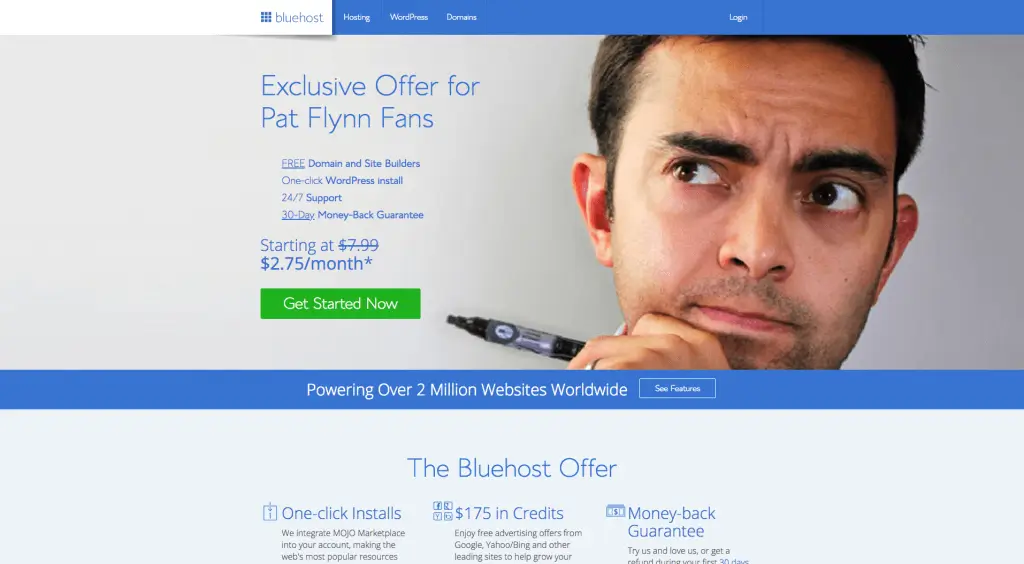
like you’re still there with them as they go through the purchase process.
The big caveat here is this will not always be possible, which is why it’s an advanced tip.
Some companies may not be open to creating a custom landing page for you, and even if they are, you may need to already be a successful affiliate with them before they’ll agree to it.
When the Going Gets Tough
As with anything in online business, affiliate marketing will throw up roadblocks along the way.
Here are 6 ideas to help you keep your head up when things get rough.
17. Focus on how it will help your audience (not features, but benefits)
When talking about the product to your audience, no matter what platform you’re using or methods you choose to deliver your content, always focus more on the benefits for your audience.
In other words, what’s in it for them?
In each section of your blog posts, in your videos, in podcast episodes, don’t forget to remind your audience exactly how the product will help them.
Features are good, but benefits are what people want.
“Sure, it’s cool that this link building tool helps you get links from high Page Ranked sites, but the benefit is that your site will have more authority, so you’ll rank higher in Google and get more traffic.”
“Sure, it’s cool that this in-ear headphone comes with a flat, tangle-free wire, but the benefit is so that you don’t get frustrated trying to untangle the darn thing every time you take it out of your backpack or pocket.”
If you’re having trouble with the whole feature vs. benefit thing, it’s okay—a lot of people get confused, but the simplest way to understand it is to think of a feature, then add the words “so that.”
“We have this feature, so that you can blah blah blah.”
It works every time.
18. Believe in your recommendation
If you really believe in the product, in your recommendation, then so will your audience. If you have motives other than trying to help people out or give them something they need—if it’s for the commission, or you’re just doing a favor for a friend who owns a product—then you’re not going to perform as well with your sales.
Believe in it, and your audience will believe in you.
19. If it doesn’t work out, try another offer
Let’s say you have an affiliate product you’d like to promote.
You’ve used the product, it’s great, and you know it will help your audience.
You set up a promotion with links in your posts, create an epic post with videos, the whole nine yards . . . and it doesn’t work out.
It’s not the end of the world.
Sometimes you think your audience will respond one way, but they surprise you and go the opposite way.
The campaign you thought was going to be a home run turns out to be a bust.
Why? Figure out why and evaluate the circumstances, and try again knowing what you now know from what you learned.
Then use what you learned and try another offer!
It’s all a learning process, one that happens through taking action, and trial and error.
That’s what affiliate marketing is all about.
In fact, the more things don’t work out, the better, because the more likely you’ll be to eventually get to something that does work.
And the more you’ll learn along the way.
Related to that . . .
20. Test, test, test
As in the previous tip, test your offers, yes, but more than that—test everything.
Test how you promote, to see what your audience responds best to.
Test the placements of your links, the number of links within posts, whether they’re bolded or italicized, whether images work better, whether interviewing the owner helps, whether Thursdays convert better than Tuesdays for webinars . . . test everything you can possibly think of.
Test, test, test.
21. Make your own product instead
If all else fails, but you know there’s a market out there for a particular product that’s perfect for your audience, and it doesn’t exist—create it yourself.
Yes, this isn’t affiliate marketing.
And when you create your own product, you waive the benefits of affiliate marketing, such as not having to create the product, dealing with customer service, and other aspects of being a product owner.
But affiliate marketing doesn’t always work out, and there are advantages to creating your own product.
You get to keep people in your own brand.
You get to keep all the profits.
You can even set up your own affiliate program for other people to sign up and promote your product.
And lastly . . .
22. Be patient
No matter how quickly people say you can make money online, realize that it’s going to take time.
Relatively speaking, yes, things can happen pretty fast—that’s the beauty of online business.
You can have a site up today and start sharing content with the world, but in order to make an impact and really make money online, you’re going to need to get your message out there, and build relationships with people.
In time, this will drive traffic to your site, and eventually clicks, sales, and affiliate commissions.
Learn, but take action and keep learning as you go.
Things take time, but by following these tips, and everything else you learn in this post, you’ll give yourself the best chance to make things happen as fast as possible for you with affiliate marketing.
Learn to choose the right affiliate products and services
Your affiliate marketing success depends on choosing the right product mix for your audience. The Affiliate Marketing Cheat Sheet will teach you how to find the products best aligned with the needs of your audience.
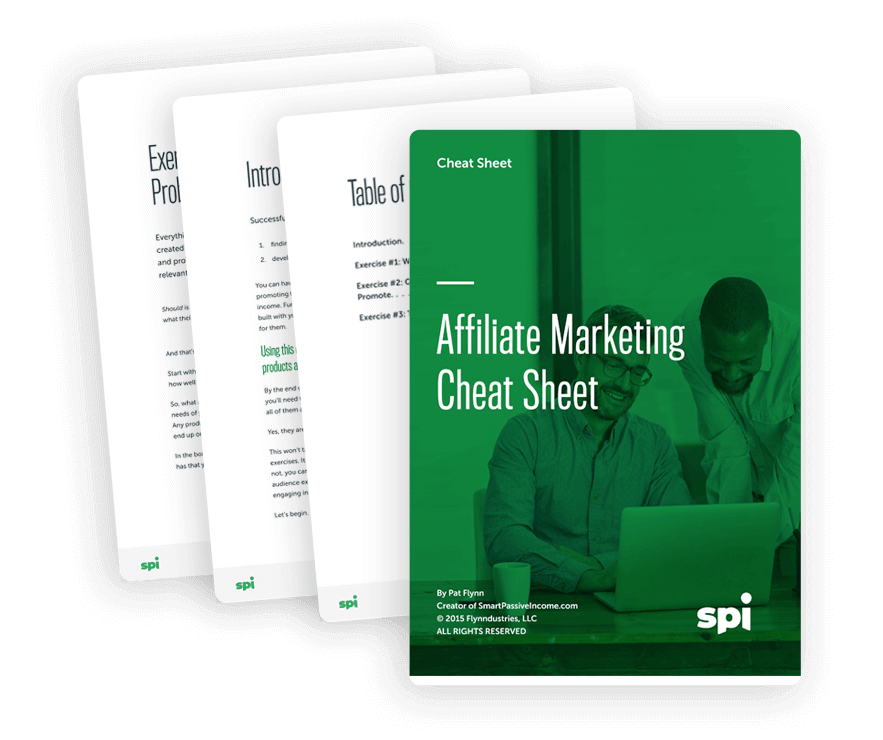
Affiliate marketing mistakes to avoid
Affiliate marketing: it’s easy to do—and easy to do wrong.
Anyone can grab a link and promote it from behind the scenes. But successful affiliate marketing that delivers value for you and your audience in the long term?
That takes work.
It also means knowing what not to do.
We’ve covered how affiliate marketing works, how to start affiliate marketing, my top tips for succeeding as an affiliate marketer, and a whole lot more.
Now, I’d like to give you some insight into what to avoid when it comes to affiliate marketing.
I’ll start by sharing with you what happened to me the first time I ever tried affiliate marketing—and what I learned when I fell flat on my face.
Then, I’ll give you the four main affiliate marketing mistakes and traps you need to look out for as you’re getting started on your journey.
My $300 affiliate marketing mistake
First, let me tell you the story of my $300 affiliate marketing mistake.
It was 2008. I had just been laid off from my job in the architecture industry. In the months leading up to my layoff, I had been experimenting in online business with my very first effort, GreenExamAcademy.com.
As I was building Green Exam Academy to help others in the architecture industry pass the LEED Exam, I discovered affiliate marketing and learned how others were making money with it.
So I signed up for an affiliate network and I picked a product I felt would be okay for my audience and got an affiliate link (I didn’t really know if it would be okay—unfortunately, that wouldn’t become clear until later).
I set up a Google AdWords account to start advertising it, and created my first ad. In the ad, I drove people to click on the affiliate link for the product I was advertising.
A couple hours after publishing the ad, I saw that it already had a few hundred impressions—i.e., views by a visitor.
Not bad! After a few more hours, it was over a thousand impressions.
But how many clicks had the ad gotten?
Zilch, nada, none.
I waited and waited until I finally got my first click, but that person didn’t end up buying the product.
I had spent $300 on a couple dozen clicks, and those clicks had amounted to zero sales.
I began thinking about those clicks, and the people on the other end of them.
Who were they? What compelled them to click?
At that time, I was a terrible marketer and copywriter—but that wasn’t the biggest issue. What I realized after a short while was that there was really no way for me to know the answer to those questions about who was clicking on my ad or why.
I had created an ad based on a product I didn’t understand inside and out.
I hadn’t spent the time getting to know the product and understanding how it could serve my audience.
And by failing to do that, I was failing myself and my audience (small, at the time) who counted on me.
I had left them behind while I panned for gold in the wrong place.
A wake-up call for doing affiliate marketing the right way
My $300 mistake was a wake-up call.
I decided right then and there I wasn’t going to do that ever again. I learned how integral relationship building is to effective affiliate marketing.
My learning process would continue from there, of course, but the building blocks were set.
Affiliate marketing isn’t a quick, impersonal thing.
It’s the exact opposite. You need to start from an authentic place.
Affiliate marketing is about fostering genuine long-term relationships with people you trust, products you love, and companies that align with you and your philosophies.
And unless you truly know the product, have used it successfully for yourself, and can prove that to your audience, you can’t expect others to just take your word for it.
Any healthy relationship takes time to build and a great deal of trust.
And that’s what we need to focus on in our affiliate marketing relationships.
Too often, I see people wasting time and energy promoting products under the guise of affiliate marketing while ignoring the relationship aspect of things.
But affiliate marketing should be a natural extension of your authentic efforts to build and serve an audience—not a tack-on just to make a little extra money.
The four biggest affiliate marketing mistakes
On the spectrum of affiliate marketing mistakes, my $300 mistake wasn’t too serious. You can chalk that one up to a beginner’s lack of good judgment or experience.
But there’s a bigger picture here we need to talk about too.
Like everything, affiliate marketing has its positive and negative sides. And in fact, for a long time—and especially when I first started out in online business back in 2008—affiliate marketing has had a negative connotation.
I’ve made it part of my mission to show that affiliate marketing can be done in a legit way, one where everybody can be a winner.
But at the same time, because affiliate marketing is technically easy to do, it’s easy to fall into an aggressive, income-first approach rather than one centered around serving your audience.
I want you to be aware of how affiliate marketing can be abused, or how your efforts can be derailed.
My intent isn’t to worry or scare you from going down the affiliate marketing route, because it can be a fantastic opportunity if done the right way—but I do want to arm you with knowledge about the traps to look out for as you build your affiliate marketing business.
I feel it’s my responsibility to show you how to do affiliate marketing right—and that includes knowing how not to do it.
Whether you’ve just started learning about affiliate marketing, or you’re already promoting other people’s products via affiliate links and want to make sure you’re going about it the right way, I’m going to share with you four rules to keep in mind in avoiding the dark side of affiliate marketing.
These are the four biggest traps to look out for, so that you have an even greater chance to succeed with this powerful tool that can help you better serve your audience, generate an income, and build relationships with the owners of the products you’re promoting.
The four biggest affiliate marketing mistakes:
- Promoting a product that doesn’t make sense for your audience
- Not keeping an eye on the quality of your audience’s experience
- Not being honest about a product or promotion
- Earning all of your income from affiliate marketing
Okay. Let’s talk about these four dangers you need to look out for on your affiliate marketing journey.
1. Promoting a product that doesn’t make sense for your audience
Perhaps the biggest affiliate marketing mistake people make is not promoting a product that actually makes sense for their audience.
This often happens when someone takes an income-first approach rather than a serving-first one.
You should look for solutions that can help your audience—whether there’s an affiliate opportunity there or not.
If there happens to be one, great. That’s a bonus.
If there isn’t, but you know the product could still be helpful to your audience, it’s your responsibility to share it with them.
Since my brand is focused on helping people build successful online businesses ethically, the products and services I promote are all things that support this focus: I recommend services that help people host their website (Bluehost), start an email list (Kit), plan their editorial calendar (CoSchedule); audio and video gear to create great content; and books and courses, both mine and others, to help people learn and improve their skills.
Most of these are things I recommend as an affiliate—but a good number of them are not.
Even if I can’t form an affiliate relationship with a company, if their product is the best one for my audience, I’m going to recommend it.
As your brand grows and you start to build an audience, you’re going to get noticed. The affiliate marketing opportunities will start to trickle in, as companies see the traffic you’re getting and the trust people are putting in your brand.
These companies will also know you’re a human being who can potentially be swayed by a commission.
Sometimes, they’ll offer you payments for simply sending them leads, because it’s basically easy advertising for them.
They know how much money they need to spend, and how many leads they need to collect, to convert a certain percentage of them to customers.
Either way, as you grow, you’re going to notice an increased number of those kinds of inquiries—many from companies you’ve never even heard of before.
At the start of my online business journey, every couple months I’d get an offer from a different company saying, “Hey, we have this new product. We think your audience would really like it. Promote it to your audience and we’ll give you $75 for every person you send our way.”
I implore you, please: do not be persuaded by the dollar value of the commissions you’ll be offered.
Sometimes when a new company reaches out to me with an affiliate offer, I’ll look at the product and realize it’s obviously not a fit for my audience.
In those cases, it’s easy to say, “No, thanks.”
But when you’re just starting out, the promise of a commission can make it hard to see things clearly.
You might think, “Wow, this opportunity is in front of me right now. Maybe I should say yes. What damage could it do?”
The damage it could do is potentially huge: the destruction of the trust you’ve worked hard to build with your audience.
That’s why my recommendation is to stay on the safe side by always offering and recommending products you’ve used before and understand, so you know exactly the kind of experience people will have with them.
You should also get to know the company itself, and ideally have a personal relationship with someone in a leadership role there.
That way, you can be certain that the company behind the product you’re promoting is one that will take care of your people.
Again, be careful.
Often companies will reach out to you based on a simple algorithm—if you’ve reached a certain threshold of social media followers, for instance, they’ll send you a message asking if they can pay to get in front of your audience.
You may have even heard of these products, and know they have a good reputation. Sometimes those products may actually be a great fit.
Still, don’t immediately say yes to the opportunity.
You need to be aware of this, because the vultures start to come out at a certain point once you start to gain some notoriety in a space.
In the early days, I’d get affiliate inquiries from companies every couple months.
Now, almost every day, I get emails from companies I’ve never heard of that want to get in front of my audience.
The nature of these offers also ranges more broadly now, probably because my audience is much larger.
For instance, I sometimes get offers from financial planning companies to get in front of my audience for tens of thousands of dollars.
But it’s not in my best interest to say yes, because even though those services might help my audience, financial planning isn’t what my brand is about.
Bombarding my audience and saturating my brand with stuff that doesn’t fit would dilute the brand and confuse people’s perception of what I stand for.
I don’t need to give my audience financial planning assistance to help them the best way I possibly can.
There are plenty of great brands out there that focus on financial planning, but it’s not my realm.
So, realize you have a choice, and that it’s okay to say no. Opportunities will come your way, but your priority should be to protect your brand and your reputation.
Choose wisely.
2. Not keeping your eye on the quality of your audience’s experience
This next one is similar to #1, but it has more to do with how things can change after you start promoting what seems to be a great product that you know is a good fit for your audience.
Let’s say you recently started promoting a new product, and it’s working out well. Everybody’s happy—you, your audience, and the company.
But then the company gets bought out, and new management takes over.
This creates a ripple through the entire company, affecting your audience’s customer support experience with the product.
Sound unlikely? It’s happened to me before, with the web hosting company Bluehost.
I still recommend Bluehost, and in fact, they’ve been one of my top affiliates over the years. But it hasn’t always been a smooth road.
I began recommending Bluehost in 2009, and was soon making a few thousand dollars a month from affiliate promotions. Even better, the company was taking great care of my audience.
Everyone was happy.
The next year, my monthly income continued to grow into the five-digit range. Things were looking good.
But then in 2013, I started getting a few emails from people who weren’t too happy with Bluehost’s customer support, especially when they had issues with the service.
The following year, things got a little better—the negative emails dropped off—but then they got worse again.
At that point, I started to really pay attention.
I decided to fly out to Utah to meet with the company and share my concerns with them directly. I met with the founders and told them, “Hey, this is not okay. This can’t happen.”
The Bluehost team told me they were aware of the issues, and that they were making changes to address them.
I said, “Okay, but these changes need to happen now.” Of course, with a big company like that, I understood changes can take time, but I wanted to do as much as I could to move them along.
Thankfully, the Bluehost team took my words to heart and put together an action plan to address the issues.
They also agreed to let me offer my audience a special connection to a customer support person who could take care of them more quickly than the company’s traditional support channel.
During my visit to Bluehost headquarters, I also kept in touch with my audience about how my meeting was going, and what the Bluehost team was doing to improve things.
I sent an email to my list about what was happening during my visit, and wrote about the experience in my May 2016 Income Report.
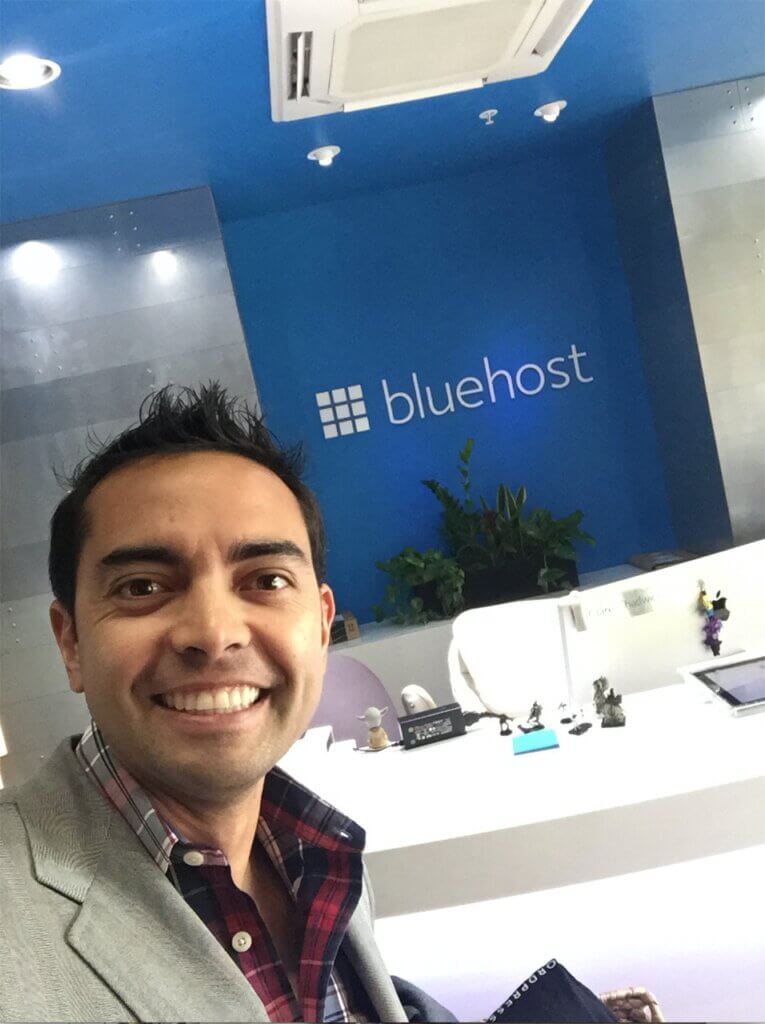
Although this kind of situation may not occur with every company you partner with as an affiliate, you have to be open to it.
Companies grow and evolve, and people come and go. You can’t assume that if things are going well, they always will.
The lesson here, especially for affiliate relationships you’d like to maintain for the long term, is to keep close tabs on your audience’s experience with the product.
In addition, you should cultivate relationships with the product owners, so they know how important your audience’s experience with the product is to everyone involved.
In an ideal world, your audience’s experience with a product should only improve over time—but if it’s going in the opposite direction, you’ll have to act to make things right, and having a direct line to the company leadership makes it easier to do that.
You also need to have a backup plan.
Right now, I’m really comfortable promoting Bluehost, especially knowing they have a customer support person I can send people to when things go wrong.
But there’s a point at which, if things were to go badly again, I’d consider promoting a different hosting provider.
Most of my audience is still having an amazing experience with Bluehost, but it’s important to stay aware and be prepared if things need to change.
3. Not being honest about a product or promotion
When I recommend products, I’m always very honest about what the product can and can’t do.
But I’ve been on the other end of this before—and not in a good way. I won’t name names or products, but let’s just say I’ve been recommended products that came with certain promises, promises that didn’t come to fruition.
These were products that, shortly after I started using them, I realized they weren’t at all what I‘d expected.
When you’re promoting your affiliate products, you need to make sure you set the right expectations for your audience.
Otherwise, what happens? You lose the trust of the person to whom you recommended that product.
In one case, someone I knew and looked up to recommended a software tool to me.
His recommendation also came with some lofty claims of how the tool could help me. I ended up buying the software based on his recommendation.
But what I quickly found was that in order to take advantage of the capabilities I was promised, I would have had to pay more—more than five times the price I was paying already.
Needless to say, I wasn’t happy about this.
I shared my frustration with the person who’d recommended the tool to me, and he apologized. It was an oversight on his part, and we’re still on good terms today.
Our story turned out okay—but this won’t always be the case if you’re not totally honest and upfront with your audience about the affiliate products you promote.
You have to be careful, because if you make a mistake that skews your audience’s expectations, you might lose them for good.
You need to be totally honest about what a product can and can’t do, and make sure you’re not recommending it to someone who’s not a good fit for it.
What if you find yourself in a tricky situation where you’ve promoted a product to your audience, then realized later that it wasn’t what you thought it was?
Thankfully, I have a special “rule” that comes in handy here. I call it the 8 Mile Rule.
[SPOILER ALERT] If you’ve never seen the movie 8 Mile, Marshall Mathers (aka Eminem), plays the main character, a rapper named B-Rabbit. In the finale, B-Rabbit faces off against another rapper in a huge rap battle.
B-Rabbit decides to rap about all the weird things about himself, things his opponent would likely call him out for in his rap.
Why does he do this?
By calling himself out first, he leaves his opponent without any ammunition to use against him.
Do you see where I’m going with this?
When you’re promoting an affiliate product, take the 8 Mile approach.
If something goes wrong, be the first one to say something.
If you make a mistake, own up to it.
Perhaps you recommended a product you realized wasn’t a good fit for your audience.
The quicker you can say, “I’m sorry.
That product wasn’t the right fit for you.
I hope you’ll give me the benefit of the doubt and stick around,” the more likely your audience will be to do that.
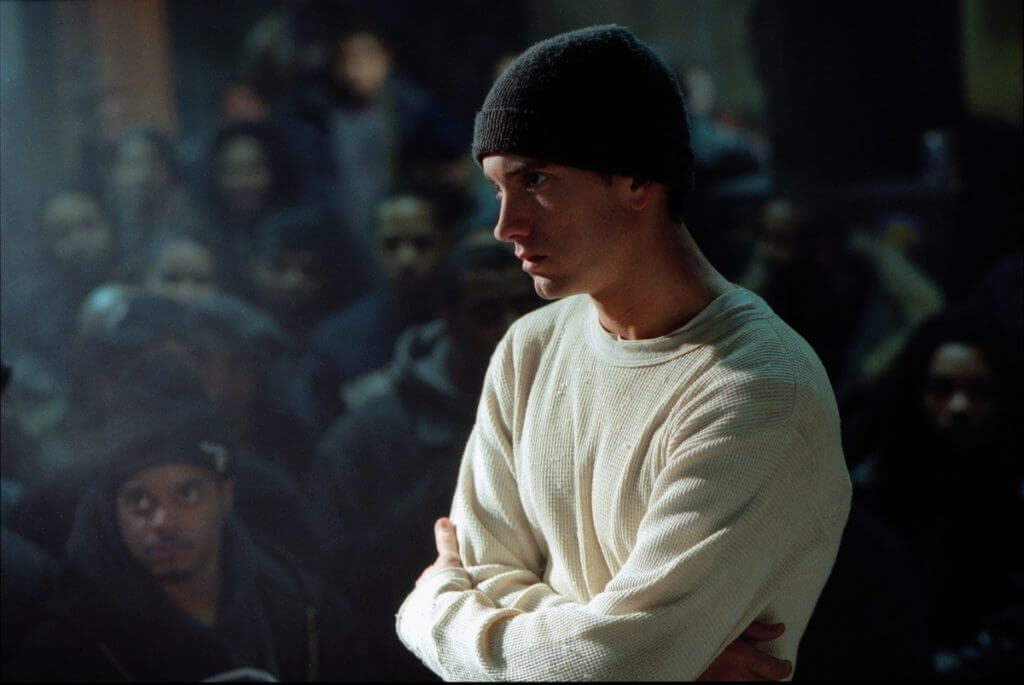
This rule is handy for a lot of other areas of your business, too. It’s all about taking ownership and being honest and forthright.
This is not always easy to do, but always the right thing to do.
Being honest fosters trust, even if the circumstances aren’t totally favorable.
And if you’re being honest and serving your audience in a way that’s valuable to them, they’ll often jump at the chance to help you back.
This is where the law of reciprocity comes in—when you do something helpful for someone, they often feel compelled to do something for you in return—and affiliate marketing can be an amazing way to give your audience a way to pay you back.
So when you tell people upfront, “Hey, you know what? This is a product I’m promoting as an affiliate, so I get a commission if you go through that link,” I guarantee some of those people will be excited by the opportunity to click on that link.
There are people out there you’ve served who are looking for ways to pay you back.
So make it easy for them.
4. Earning all of your income from affiliate marketing or treating it like a get-rich-quick scheme
This leads me to my final point related to the dark side of affiliate marketing.
That is, you don’t want all of your income to come from affiliate marketing.
Back when I started out—and this is still true today in some spaces—a lot of people were doing affiliate marketing by running promotions, not through a brand they’d created or trust they’d earned from an audience, but by using copywriting, targeting, and advertising techniques to get people to click on affiliate links.
Remember my $300 mistake?
Before I ran that fated ad, I signed up with an affiliate marketing network.
This is essentially a site that allows you to sign up and choose from a huge number of products you can promote.
Once you pick a product, you get a link you can share with as many people as possible.
Because most people who go this route don’t already have a brand established, they have to resort to advertising—things like Google Adwords—to get their link in front of people.
Unfortunately, there are several things wrong with this model.
As you learned from my $300 mistake, if you just throw a link up there hoping it’ll do all the work for you—well, it won’t.
That’s not to say that you can’t make money with this kind of affiliate marketing. You can, if you go about it smartly.
But there are still two main ways you can go wrong with this model.
First, as soon as you stop putting effort into it, the income stops flowing. It’s not passive.
Second, because it doesn’t require you to build a brand, it means it’s not unique to you. Just about anyone could leapfrog you if they master the copywriting and targeting required to be successful with it.
As a result, this kind of affiliate marketing can become a very scary game to play.
That’s why I recommend instead that you take the time to build your own brand and grow an audience you can serve.
Build that audience’s trust in you as the go-to resource in your area of expertise, not just someone they don’t know who’s only serving them ads.
This is at the heart of how I teach online business: to help people become recognized for their efforts in serving an audience, whether that’s through creating their own products, blogging, podcasting, building physical products, or affiliate marketing.
Focus on building your brand and serving an audience.
When you make this your primary aim, you’ll find you have plenty of options to make money—with affiliate marketing being just one of those options.
Think about it this way: With whatever path you choose to generate an income, make sure you give the people you serve a way to thank you.
If you’re not thanked for the products you’re promoting, you’re doing affiliate marketing wrong.
In episode 9 of the Smart Passive Income Podcast, author and online business consultant Nicole Dean shared one of the most memorable quotes from the hundreds of interviews I’ve done.
She told me the motto of her business was “to make the web and the world a better place.”
And when you approach your business like that, it trickles down to everything you do.
It affects how you advertise and promote.
It affects how you interact with people.
It helps you look beyond strategies and tactics, like affiliate marketing, and stay focused on the most important thing: making things better for others.
So give your audience a reason to thank you, and the (affiliate) income will flow in.
Serve first to succeed with affiliate marketing
As we’ve seen, there is a darker side to affiliate marketing.
But if you know what to look out for, you can avoid falling into the common traps and mistakes that befall so many aspiring affiliate marketers.
As a reminder, here are the four keys to staying in the “plus” column with your affiliate marketing:
- Being careful to promote only products that make sense for your audience
- Keeping tabs on your audience’s experience with your affiliate products
- Being honest and forthright about the products you promote
- Not relying solely on affiliate marketing or using it as an impersonal, get-rich-quick scheme
Use these four keys as your guiding light, and you’ll be able to make the most of this powerful tool that allows you to tap into the incredible array of products, services, and tools out there that can help your audience succeed.
My best resource for beginner affiliate marketers: The Affiliate Marketing Cheat Sheet
This guide was my first ebook on the topic of affiliate marketing.
I wrote it after lots of trial and error with affiliate marketing—starting, failing, and eventually succeeding.
I learned a lot, and I came to believe that there’s a “right” way to approach affiliate marketing.
That’s why I created my free ebook guide to doing affiliate marketing right, the Affiliate Marketing Cheat Sheet.
Sadly, there are a lot of misconceptions about affiliate marketing out there, which is what this guide specifically focuses on.
In the Affiliate Marketing Cheat Sheet, I address these misconceptions by tackling some of the most common questions about affiliate marketing rules and strategies, including:
- What specific mediums work well for affiliate product promotion?
- How do I find my number one affiliate product or service?
- How do I make my affiliate product stand out in a crowd?
- How can I improve the relationship I have with the product owner?
At just 11 jam-packed pages, the Affiliate Marketing Cheat Sheet is full of insights I’ve learned through years of real-world experience in affiliate marketing—insights I’m excited to pass on to you.
Here’s what a couple readers have to say about how the Affiliate Marketing Cheat Sheet (formerly called Affiliate Marketing the Smart Way) has helped them:
“Pat’s guide, Affiliate Marketing the Smart Way, really lives up to its name. Soon after implementing his tips, I saw a sudden $500/mo rise in my income. Reading it was enlightening!”
—Mike Martyns
“I gained a lot in the 30 minutes it took to absorb such valuable information. It was precise and to the point—a tool that is ready and available for any newcomer to GET STARTED.”
—Louisa Barzey
The Affiliate Marketing Cheat Sheet is filled with all of my best advice on the topic, and makes a fantastic free “pocket” companion to this article.

Make affiliate marketing part of your success.
Learn how to:
- Find products to promote
- Stand out from the crowd
- Find tools to help you with the setup and execution
The sky’s the limit with affiliate marketing
If you’ve stuck with me for this whole post, then you’ve taken an exciting journey into the heart of affiliate marketing!
And you’ve hopefully emerged from that journey armed with some serious knowledge, tools, strategies, and possibilities to take with you as you strike out into the wide, exciting world of affiliate marketing.
As with anything, what you get out of affiliate marketing is about how you approach it and what you put into it.
If you treat it as just another tactic, then you’re not going to be very successful with it.
But if you treat it as a way to build more trust with your audience and serve them better, then the sky’s the limit.
So now that you’ve made it this far, what’s next?
Hopefully this article has given you a great starting point, along with a wealth of resources to support you as you strive to become a pro at affiliate marketing.
It will always be here for you as a free affiliate marketing resource, along with the Affiliate Marketing Cheat Sheet.
And beyond those resources, I’d love for us to stay connected as you go down this exciting path.
I cover affiliate marketing-related topics often on my blog and in my podcast episodes, so stay tuned there. And if you ever want to send me a note, whether it’s a question about affiliate marketing, a success story you’d like to share, or anything else related to online business and entrepreneurship, you can reach me at [email protected]. I’m here to support you on your journey, so let me know how I can best do that!
Cheers,
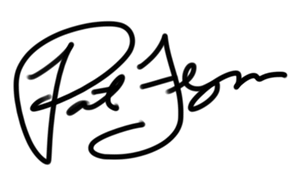
The post Affiliate Marketing – A Simple Step by Step Guide appeared first on Smart Passive Income.
]]>
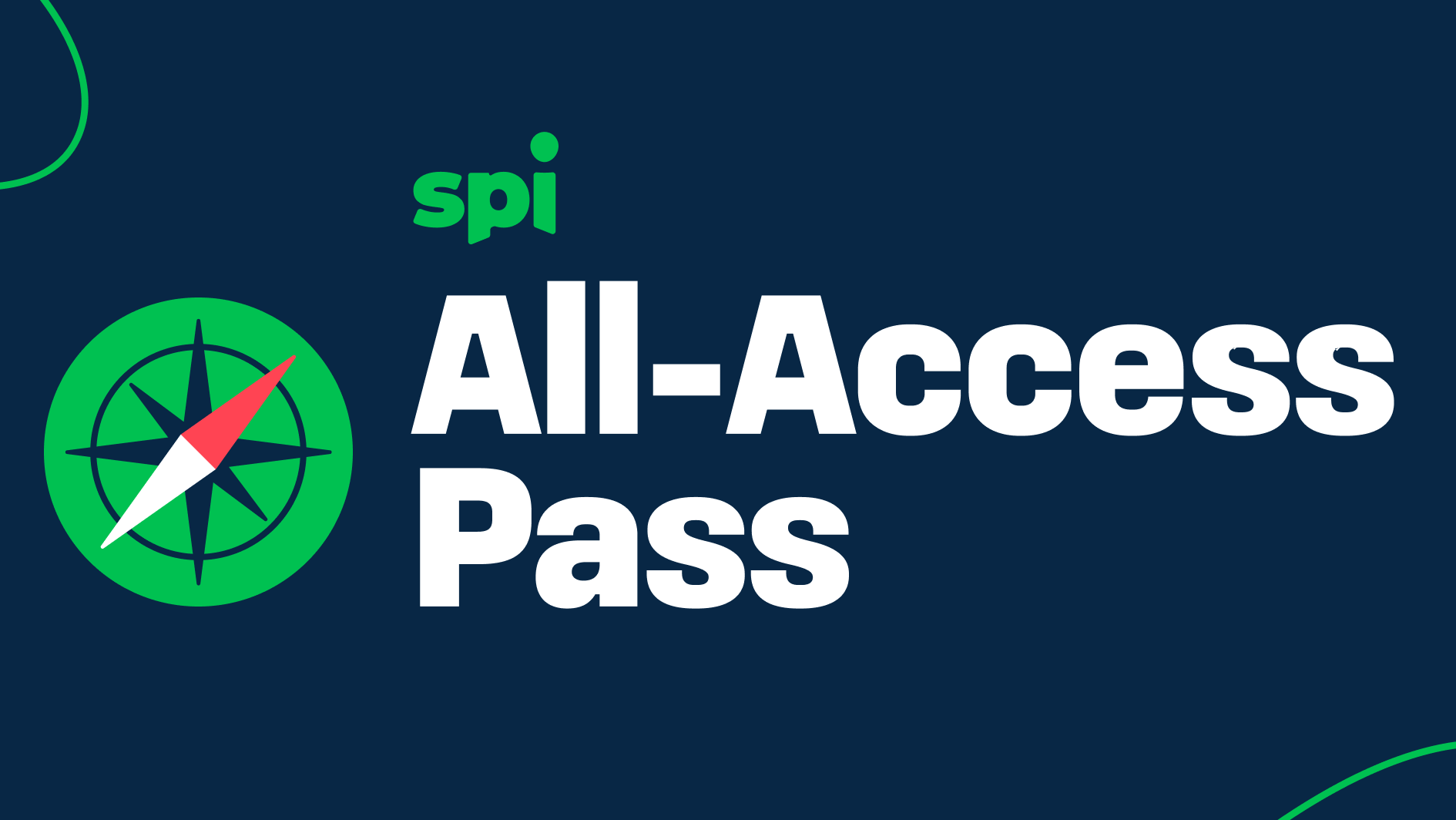

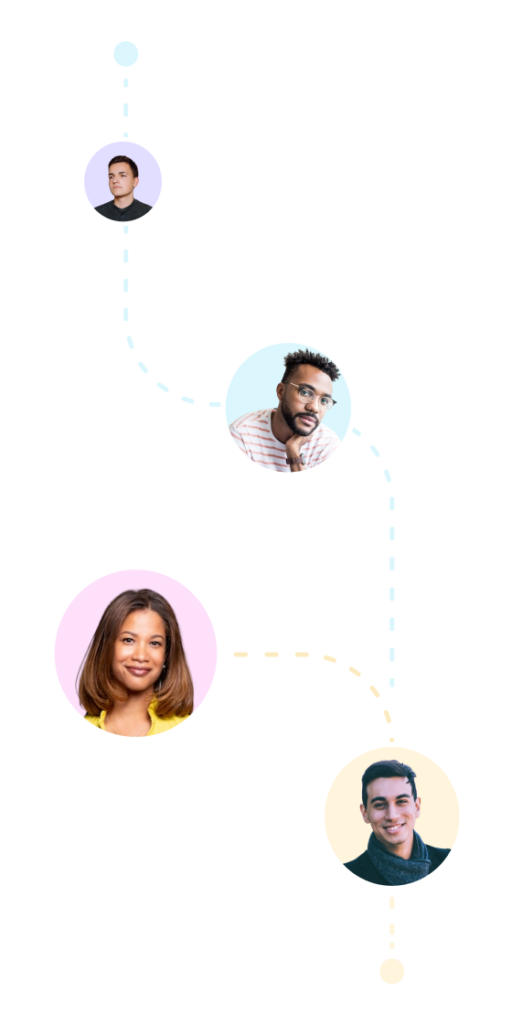
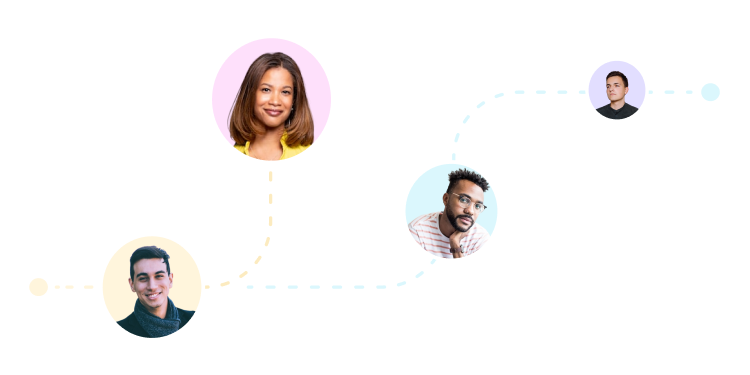
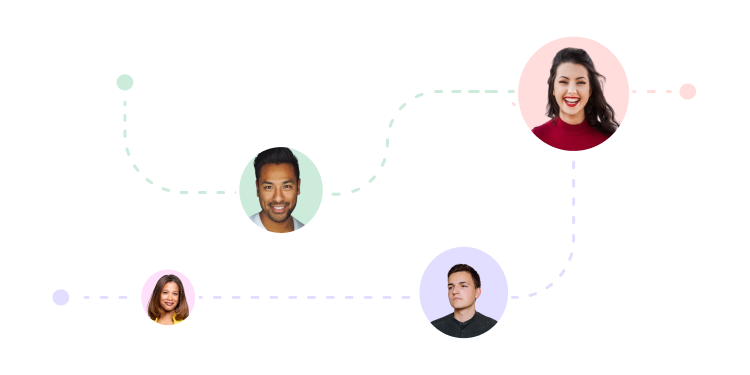
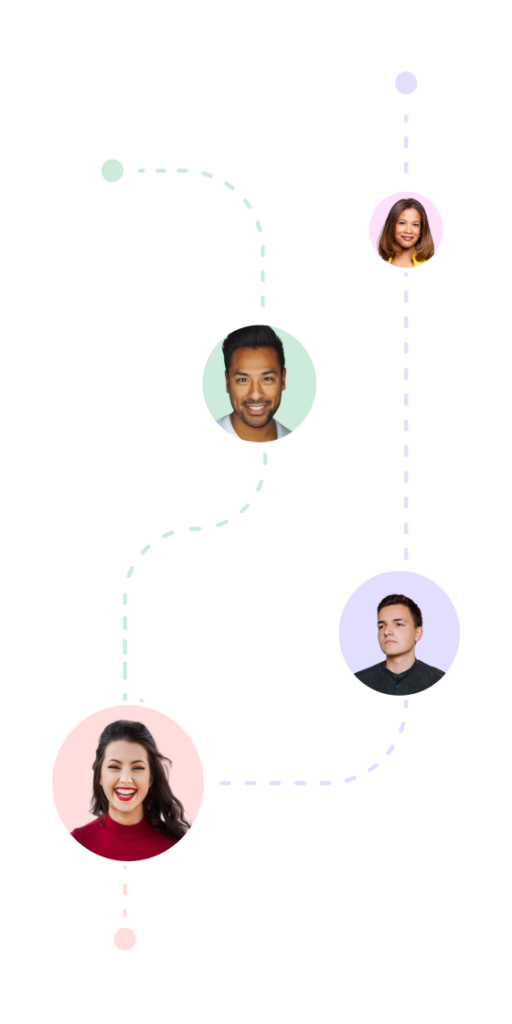
 ︎ Play
︎ Play